Sony 65365K GSM/WCDMA/LTE Phone with BT, DTS/UNII a/b/g/n/ac, GPS & NFC User Manual PY7 65365K UserGuide
Sony Mobile Communications Inc GSM/WCDMA/LTE Phone with BT, DTS/UNII a/b/g/n/ac, GPS & NFC PY7 65365K UserGuide
Sony >
Contents
- 1. PY7-65365K_UserGuide
- 2. PY7-65365K_SAR leaflet_US
PY7-65365K_UserGuide

’17.4
INSTRUCTION MANUAL
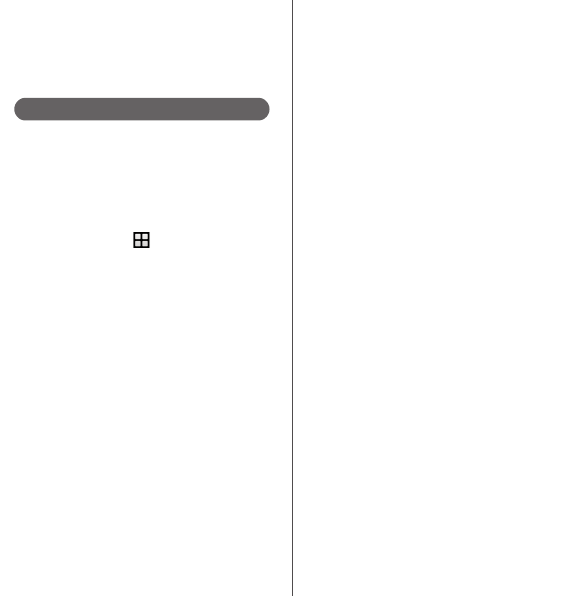
Introduction
Thank you for your purchase of "SO-01K".
For proper use, read this manual carefully before and
while you use the SO-01K.
About manuals of SO-01K
●
"
クイックスタートガイド
(Quick Start Guide)"
(Supplied accessories)
Part names and functions are explained.
●
"Instruction Manual" (Application of the terminal)
Operations and settings of each function are
explained. To use "Instruction Manual" application,
from the Home screen,
u
[Instruction Manual].
When using for the first time, download and install
the application according to the onscreen
instructions.
You can use the application as an electronic book.
You can also shift to actual operations by tapping the
description in the contents or view reference
contents.
If you uninstall "Instruction Manual" application,
access Google Play from Play Store for installing it
again. From the Home screen, tap [Play Store], search
"
取扱説明書
(Instruction Manual)" application to
select, then install it following the onscreen
instructions.
●
"Instruction Manual" (PDF file)
Operations and settings of each function are
explained. It can be downloaded from NTT DOCOMO
website.
https://www.nttdocomo.co.jp/english/support/
trouble/manual/download/so01k/index.html
* The latest information can be downloaded. The
URL and contents are subject to change
without prior notice.
❖
Note
・
Reproduction or reprint of all or part of this manual
without prior permission is prohibited.
・
Important information for SO-01K is posted in the
following website. Be sure to check before using.
http://www.sonymobile.co.jp/support/ (In Japanese
only)
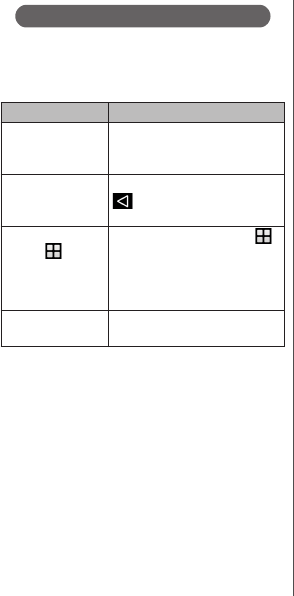
1
Operation descriptions
In this manual, keys (P.30) and key icons (P.45) are
described with
O
,
k
,
b
,
h
,
n
.
And operations for selecting icons or items in the key
operations on the screens are described as follows.
❖
Information
・
Display examples and illustrations used in this
manual are just images for explanations and may be
different from actual screens or products.
・
In this manual, the easier procedure is described for
the functions and settings which have multiple
operating procedures.
・
Please note that "SO-01K" is called "the terminal" in
this manual.
・
In this manual, explanations for the theme "Xperia
™
Loops" are provided.
・
In this manual, explanations for "docomo LIVE UX" as
Home application are provided (P.71). If you set the
other home application, the operations may differ
from the descriptions.
Description Operation
Press and hold
k
for at least 1
second.
Press and hold Camera key
(
k
) on the side of the
terminal for at least 1 second.
On the TV
watching screen,
b
.
On the TV watching screen, tap
.
From the Home
screen,
u
[Settings]
u
[About
phone].
From the Home screen, tap
(Apps button), and then tap
"Settings" on the next screen and
"About phone" on the following
screen.
Touch and hold an
icon.
Keep touching an icon longer (1-
2 seconds).
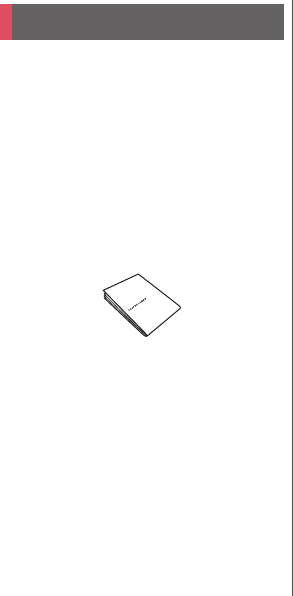
2
・
SO-01K (with warranty)
・
クイックスタートガイド
(Quick Start Guide)
(In Japanese only)
・
SO-01K
のご利用にあたっての注意事項
安全上/取り扱い上のご注意
(Notes on usage, Safety/Handling
precautions) (In Japanese only)
・
TV antenna cable SO01
You can check or purchase optional
accessories compatible with the terminal
(optional) in the DOCOMO online shop.
https://www.mydocomo.com/onlineshop/
options/index.html (In Japanese only)
Supplied accessories

Contents/Precautions
3
Contents
■
Supplied accessories. . . . . . . . . . . . . . . . . 2
■
About using the terminal . . . . . . . . . . . . 5
■
Safety Precautions (Always follow these
directions) . . . . . . . . . . . . . . . . . . . . . . . . . . 7
■
Handling precautions. . . . . . . . . . . . . . . 17
■
Waterproofness/Dustproofness . . . . . 24
Before Using the Terminal . . . 30
Part names and functions................................................30
docomo nano UIM card....................................................31
microSD card ...........................................................................33
CE mark and FCC ID.............................................................36
Charging.....................................................................................36
Turning power on/off.........................................................42
Initial settings...........................................................................43
Basic operations.....................................................................44
Notification LED .....................................................................50
Status bar ...................................................................................50
Notification panel .................................................................53
Quick settings panel............................................................54
Home screen............................................................................55
Xperia
™
Application screen ..........................................62
Task manager...........................................................................70
Split screen................................................................................70
Switching Home application......................................... 71
Searching information in the terminal and web
pages ............................................................................................72
Character entry.......................................................................73
Setting the character entry .............................................79
docomo LIVE UX . . . . . . . . . . . . . 80
Home screen ........................................................................... 80
Managing the Home screen.......................................... 80
Application screen ............................................................... 83
Display all apps....................................................................... 85
Backing up and restoring the Home screen........ 85
Using My Magazine............................................................. 86
Checking Home application information.............. 87
Phone . . . . . . . . . . . . . . . . . . . . . . 88
Making/Receiving a call.................................................... 88
Operations during a call ................................................... 93
Call history................................................................................. 95
Call settings .............................................................................. 97
Phonebook ............................................................................ 102
Mail/Web browser . . . . . . . . . .107
docomo mail ........................................................................ 107
Message (SMS)..................................................................... 107
Email........................................................................................... 110
Gmail.......................................................................................... 114
Early Warning "Area Mail".............................................. 115
Chrome .................................................................................... 117

4
Contents/Precautions
Apps . . . . . . . . . . . . . . . . . . . . . . 120
d
メニュー
(dmenu)............................................................ 120
dmarket .................................................................................... 120
Play Store................................................................................. 121
Osaifu-Keitai........................................................................... 122
TV.................................................................................................. 127
Camera...................................................................................... 133
Album........................................................................................ 145
Media Player.......................................................................... 147
Location services................................................................ 149
Schedule.................................................................................. 152
Clock........................................................................................... 153
docomo Data Copy .......................................................... 154
Settings . . . . . . . . . . . . . . . . . . . 158
Viewing the setting menu............................................158
Wireless & networks.......................................................... 158
Themes & wallpaper......................................................... 168
Device........................................................................................ 168
Accounts & services.......................................................... 186
System....................................................................................... 190
File management . . . . . . . . . . 195
Storage structure................................................................ 195
File operations......................................................................195
Data communication . . . . . . . 197
Bluetooth function............................................................197
NFC communication........................................................ 199
External device connection. .202
Connecting to PC .............................................................. 202
Connecting DLNA device............................................. 203
International roaming . . . . . .204
Overview of International roaming (WORLD
WING) ........................................................................................ 204
Available overseas service ............................................ 204
Before using overseas ..................................................... 205
Making/Receiving a call in the country you stay
....................................................................................................... 208
International roaming settings.................................. 210
After returning to Japan ................................................ 212
Appendix/Index . . . . . . . . . . . .213
Troubleshooting................................................................. 213
あんしん遠隔サポート
(Anshin Enkaku Support)
....................................................................................................... 221
Warranty and After Sales Services ........................... 222
Software Update ................................................................ 226
Connecting to a PC to update................................... 229
Main specification ............................................................. 229
Certificate and compliance ......................................... 234
End User Licence Agreement .................................... 234
Export Controls and Regulations ............................. 235
Intellectual Property Right ........................................... 236
SIM unlock.............................................................................. 239
Index .......................................................................................... 240

5
Contents/Precautions
Contents/Pre cautions
・
The terminal supports LTE, W-CDMA, GSM/
GPRS and Wireless LAN Systems.
・
Because a terminal operates using radio
frequencies, it cannot be used inside a tunnel,
underground, in a building or other locations
where radio waves do not reach, in locations
with weak radio wave condition, or out of LTE/
FOMA service area. The services may not be
available on the upper floors of high-rise
apartments or buildings, even if there are no
obstructions around you. On occasion, your
calls may be disconnected even in areas with
strong radio wave condition, even if you are
not moving, or even if there are 4-signal icon
on the terminal's display.
・
Because the terminal uses radio waves to
communicate, it is possible that a third party
may attempt to tap your calls. However, the
LTE, W-CDMA, GSM/GPRS system
automatically scrambles all calls through a
private call feature. Therefore, even if the third
party successfully intercepts your call, they
will only hear noise.
・
The terminal operates on radio frequencies by
converting voice into digital signals. If the caller
moves into an area of adverse radio wave
condition, the digital signal may not be restored
accurately, and the voice received in the call may
differ slightly from the actual voice.
・
The terminal supports the function that can
be used by users and guests. Therefore some
services or applications recognize them as the
same user even after the user is switched.
DOCOMO shall have no liabilities for any
damage or troubles of customer or a third
party resulting from using the function
(P.185).
・
Note down the information saved in the
terminal in a separate note on a regular basis
or save to an external recording medium such
as a microSD card or PC. Note that DOCOMO
assumes no responsibility for any loss of saved
contents of data resulting from malfunction,
repair, changing of the model or other
handling of the terminal.
・
As with PCs, some user-installed applications
or accessed websites may disrupt the stability
of the terminal performance, or unexpectedly
transmit information via the Internet causing
improper use of your location information as
well as personal information recorded on the
terminal. Therefore, verify the supplier and
operating conditions of the applications or
websites before using them.
・
This terminal has FOMA Plus-Area and FOMA
HIGH-SPEED Area support.
・
The terminal does not support i-mode sites
(programs) or i-
D
ppli.
About using the terminal
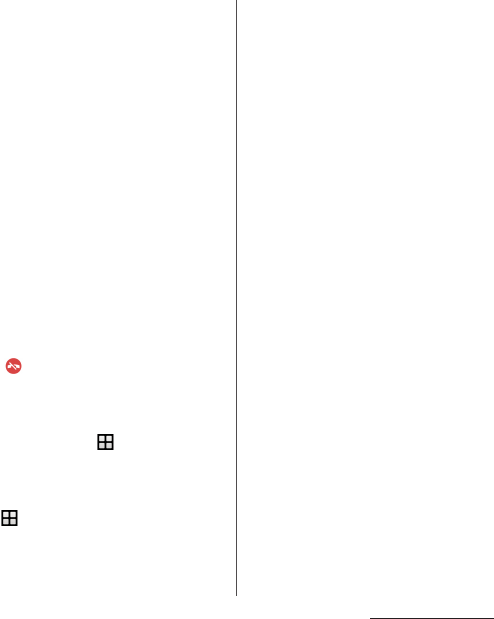
6
Contents/Precautions
・
The terminal automatically performs
communication for synchronizing data,
checking the latest software version, and
maintaining a connection with the server, and
for other purposes. If you transmit a large
amount of data, such as when downloading
applications or watching video, a packet
communication charge becomes high.
Subscription to Packet Pack/packet flat-rate
service is highly recommended.
・
Depending on the applications or service you
use, packet communication charge may be
applied even in Wi-Fi
®
communication.
・
Public mode (Driving mode) is not supported.
・
Even when silent mode is on, the following
sounds are not muted: the shutter sound; the
sounds produced when starting and ending
video recording; alarms; sounds from video
and music; and the sound produced when
you tap during a call.
・
The name of the operator is displayed on the
lock screen (P.43).
・
To check your phone number (own number),
from the Home screen,
u
[Settings]
u
[About phone]
u
[Status]
u
[SIM status] to see
"My phone number".
・
To check the software version, from the Home
screen,
u
[Settings]
u
[About phone].
・
If available memory in the microSD card or
the terminal is low, running applications may
not operate correctly. In that case, delete the
saved data.
・
You can update software on the terminal to
the latest one (P.226, P.229).
・
The operating system (OS) may be upgraded
via software updates to improve the quality of
the terminal. For this reason, you always need
to use the latest OS version. And some
applications that used in the previous OS
version may not be available or some
unintended bugs may occur.
・
You can use the terminal only with a docomo
nano UIM card. If you have a docomo mini
UIM card, UIM, or FOMA card, bring it to a
docomo Shop to replace it with a docomo
nano UIM card.
・
Set password etc. for screen lock to ensure the
security of your terminal for its loss (P.181).
・
If your terminal is lost, change your each
account password to invalidate
authentication using a PC to prevent other
persons from using Google services such as
Gmail or Google Play, or SNS, etc.
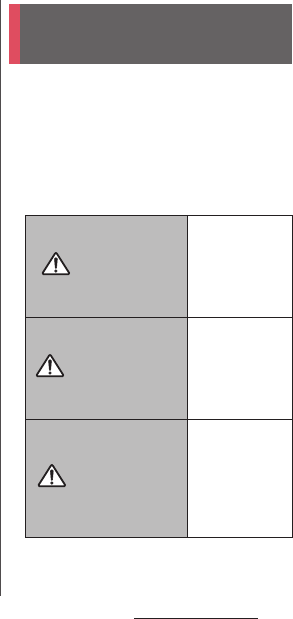
7
Contents/Precautions
・
For using services and applications provided
by the third party's including the applications
provided by Google Inc., confirm the terms
and conditions specified by Google or the
providers. DOCOMO assumes no
responsibility for any malfunctions resulting
from the services and applications.
・
When a license agreement screen etc.
appears, follow the onscreen instructions.
・
Applications and service contents are subject
to change without prior notice.
・
The terminal supports only sp-mode, mopera
U and Business mopera Internet. Other
providers are not supported.
・
If you want to use tethering, subscription to
Packet Pack/packet flat-rate service is strongly
recommended.
・
For details on usage charge, refer to NTT
DOCOMO website.
・
Display is manufactured by taking advantage
of highly advanced technology but some
dots may be always or never lit. Note that, this
shows characteristics of the display and not
defects in the terminals.
・
DOCOMO is not liable to any failures or
malfunctions for commercially available
optional equipment.
■
For safe and proper use of the terminal, please
read the "Safety Precautions" prior to use.
■
ALWAYS observe the safety precautions since
they intend to prevent personal injury or
property damage.
■
The following symbols indicate the different
levels of injury or damage that may result if
the guidelines are not observed and the
terminal is used improperly.
Safety Precautions (Always
follow these directions)
Failure to
observe these
guidelines may
"immediately
result in death or
serious injury
(*1)
".
Failure to
observe these
guidelines may
"result in death
or serious
injury
(*1)
".
Failure to
observe these
guidelines may
"result in minor
injury
(*2)
and
property
damage
(*3)
".
DANGER
WARNING
CAUTION
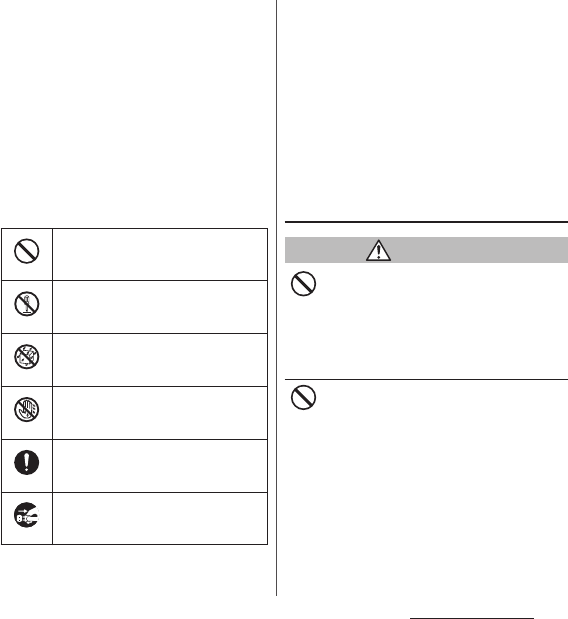
8
Contents/Precautions
*1 Serious injury: This refers to loss of sight, injury,
burns (high- and low temperature), electric shock,
broken bones, injuries with residual aftereffects
from poisoning, etc., and injuries requiring hospital
admission for treatment or long-term hospital
attendance as an outpatient.
*2 Minor injury: This refers to injuries, burns (high- and
low-temperature), electric shock, etc. that do not
require hospital admission for treatment or long-
term hospital attendance as an outpatient.
*3 Property damage: This refers to extended damage
to buildings, furniture, livestock, pets, etc.
■
The following symbols indicate specific
directions.
■
"Safety Precautions" are described in the
following categories:
1. Handling the terminal, adapter, docomo nano
UIM card, and TV antenna cable (common) . . .8
2. Handling the terminal. . . . . . . . . . . . . . . . . . . . . . 11
3. Handling the adapter . . . . . . . . . . . . . . . . . . . . . . 13
4. Handling the docomo nano UIM card . . . . . . . 15
5. Handling the terminal near electronic medical
equipment . . . . . . . . . . . . . . . . . . . . . . . . . . . . . . . . 15
6. Material list . . . . . . . . . . . . . . . . . . . . . . . . . . . . . . . . 16
1. Handling the terminal, adapter,
docomo nano UIM card, and TV
antenna cable (common)
DANGER
Do not use, store or leave the equipment in
locations subject to high temperature or
accumulation of heat (e.g. by the fire, near a
heater, under a kotatsu or bedding, in direct
sunlight, in a car in the hot sun).
Doing so may cause fire, burns, injury, electric
shock, etc.
Do not put the equipment in or place near
microwave ovens, cooking appliances such
as IH cooking heaters, or high pressure
containers such as pressure cookers.
Doing so may cause fire, burns, injury, electric
shock, etc.
Indicates prohibited actions.
Indicates not to disassemble.
Indicates not to use where it could get
wet.
Indicates not to handle with wet
hands.
Indicates compulsory actions in
accordance with instructions.
Indicates to remove the power plug
from the outlet.
Don’t
No disassembly
No liquids
No wet hands
Do
Unplug
Don’t
Don’t
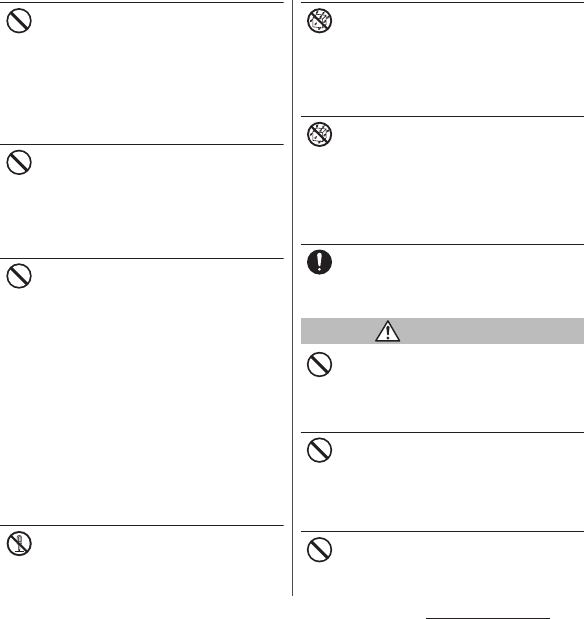
9
Contents/Precautions
Do not splash sand, soil or mud, or do not
directly place the equipment on them. Also,
do not touch the equipment with hands
with sand etc. adhered.
Doing so may cause fire, burns, injury, electric
shock, etc.
For waterproofness/dustproofness, see the
following.
⇒
P.24 "Waterproofness/Dustproofness"
Do not charge the terminal when it is wet
with liquids such as water (drinking water,
sweat, seawater, urine of pet animals, etc.).
Doing so may cause fire, burns, injury, electric
shock, etc.
For waterproofness, see the following.
⇒
P.24 "Waterproofness/Dustproofness"
Do not subject the terminal to strong
pressure or break the terminal. Especially
when bringing the terminal putting in a
pocket of clothes, do not let the terminal hit
against surroundings or being put between
the objects.
Doing so may cause fire, burns, injury, etc.
because of ignition, burst, heat or leaking of
the internal battery.
* The following are examples that you should
be careful of:
・
Sitting or squatting with the terminal put in
a pocket of trousers or skirt
・
Putting the terminal in a pocket of outer
wear and catching them in a door or a door
of car
・
Stepping on the terminal on a soft object
such as a sofa, bed, or bedding, or on a floor
Do not disassemble or modify the
equipment.
Doing so may cause fire, burns, injury, electric
shock, etc.
Do not let the equipment get wet with
liquids such as water (drinking water, sweat,
seawater, urine of pet animals, etc.).
Doing so may cause fire, burns, injury, electric
shock, etc.
For waterproofness, see the following.
⇒
P.24 "Waterproofness/Dustproofness"
Do not allow liquids such as water (drinking
water, sweat, seawater, urine of pet animals,
etc.) to get inside the charging jack or the
external connection jack.
Doing so may cause fire, burns, injury, electric
shock, etc.
For waterproofness, see the following.
⇒
P.24 "Waterproofness/Dustproofness"
Use optional devices specified by NTT
DOCOMO.
Failure to do so may cause fire, burns, injury,
electric shock, etc.
WARNING
Do not subject the equipment to strong
force, impacts, or vibration such as letting it
fail, stomping or throwing it.
Doing so may cause fire, burns, injury, electric
shock, etc.
Do not allow conductive materials (such as
metal objects and pencil lead) to come into
contact with the charging jack or external
connection jack or dust to get inside it.
Doing so may cause fire, burns, injury, electric
shock, etc.
Do not cover or wrap the equipment with a
cloth or bedding in use or while charging.
Doing so may cause fire, burns, etc.
Don’t
Don’t
Don’t
No disassembly
No liquids
No liquids
Do
Don’t
Don’t
Don’t
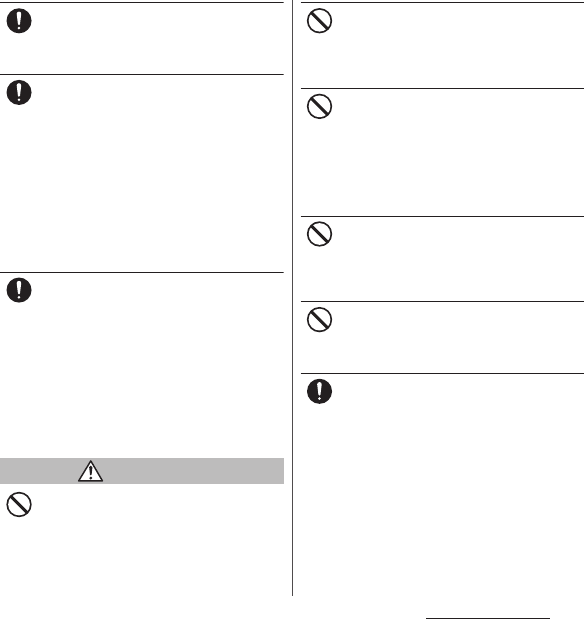
10
Contents/Precautions
If charging does not finish after specified
time, stop charging.
Failure to do so may cause fire, burns, injury,
etc. due to overcharge etc.
Power off the terminal before you step into a
place where flammable gas generates such
as gas stations, or a place where dusts are
generated. Stop charging if you charge the
battery.
Using the terminal in a place where
flammable gas generates may cause
explosion, fire, etc.
When using Osaifu-Keitai in a place such as a
gas station, power off the terminal before
using it. (If you set "NFC / Osaifu-Keitai lock",
cancel the lock and then power off the
terminal.)
If you notice anything unusual about the
equipment such as an unusual odor,
abnormal noise, smoke generation,
overheating, discoloration or deformation
while using or charging, or during storage,
perform the following measures.
・
Remove a power plug from a power outlet
or accessory socket.
・
Power off the terminal.
Failure to do so may cause fire, burns, injury,
electric shock, etc. if you do not follow the
instructions above.
CAUTION
Do not use damaged equipment.
Doing so may cause fire, burns, injury, etc.
Do not place on an unstable or inclined
platform. Be careful especially when vibrator
is set.
Doing so may cause the device to fall etc. and
cause injury.
Do not use or keep in a place that is very
humid, dusty, or subject to high
temperature.
Doing so may cause fire, burns, electric shock,
etc.
For waterproofness/dustproofness, see the
following.
⇒
P.24 "Waterproofness/Dustproofness"
If children use the terminal, parents or
guardians should give them the proper
instructions for use and do not allow them
to use the terminal in the wrong way.
Failure to do so may cause injury.
Keep the equipment out of the reach of
babies and infants.
Failure to do so may cause accidental
ingestion, injury, electric shock, etc.
Be careful when using the terminal
continuously for a long time or charging
because temperature of the terminal may
become warm. Also, be careful not to touch
it unintentionally for a long time when you
fall asleep etc.
The terminal or adapter may become warm
when using an application, a call, data
communication, watching TV or video, etc. for
a long time or charging.
If you are directly in contact with warmed part
for a long time, it may cause a redness of skin,
itch, rash, low-temperature burn etc.
depending on your physical condition.
Do
Do
Do
Don’t
Don’t
Don’t
Don’t
Don’t
Do
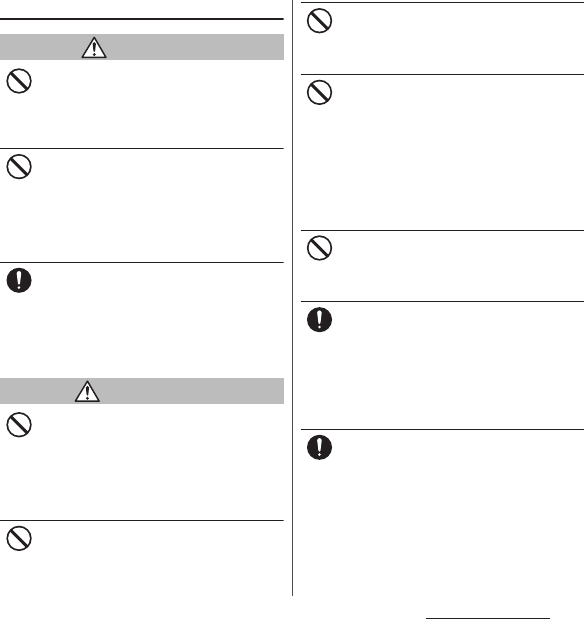
11
Contents/Precautions
2. Handling the terminal
DANGER
Do not throw the terminal into fire or apply
heat.
Doing so may cause fire, burns, injury, etc.
because of ignition, burst, heat or leaking of
the internal battery.
Do not put excessive force such as sticking a
nail (sharp object) into the terminal, hitting
it with a hammer (hard object), or stepping
on it.
Doing so may cause fire, burns, injury, etc.
because of ignition, burst, heat or leaking of
the internal battery.
If the internal substance etc. of the terminal
contacts your eyes, immediately rinse your
eyes with clean water and see a doctor right
away.
Failure to do so may cause blindness, medical
problem, etc. due to effects of the internal
substance of the terminal etc.
WARNING
Do not turn on the light or flash with the
lighting luminescence part close to the
other people's eyes. Keep enough distance
away especially from babies and infants.
Doing so may cause blurred vision etc. Or it
may dazzle his/her eyes or scare him/her
causing an accident such as injury.
Do not turn on or flash the light toward a
driver of a car etc.
Doing so may disturb driving and cause an
accident etc.
Do not watch a repeatedly-blinking screen
for a long time.
Doing so may cause cramp, loss of
consciousness, etc.
Do not allow a foreign substance such as
water (drinking water, sweat, seawater, urine
of pet animals, etc.) and other liquids, metal
parts, or flammables to get in the slot of the
docomo nano UIM card or microSD card on
the terminal. Do not insert the docomo
nano UIM card or a microSD card into wrong
slot, or insert it in wrong orientation.
Doing so may cause fire, burns, injury, electric
shock, etc.
Do not expose the camera lens to direct
sunlight for an extended period.
Doing so may cause fire, burns, injury, etc. by
the light-collecting mechanism of the lens.
Power off the terminal or put it in Airplane
mode before boarding an airplane.
Use of mobile phones on board is restricted.
Follow the instructions of each airline.
Failure to do so may adversely affect on-board
electronic equipment.
Prohibited acts related to mobile phone usage
on an airplane may be punished by law.
Follow the instructions of each medical
facility for the use of mobile phones on their
premises.
Power off the terminal in a place where the
use is prohibited.
Failure to do so may affect electronic
equipment and electronic medical
equipment.
Don’t
Don’t
Do
Don’t
Don’t
Don’t
Don’t
Don’t
Do
Do
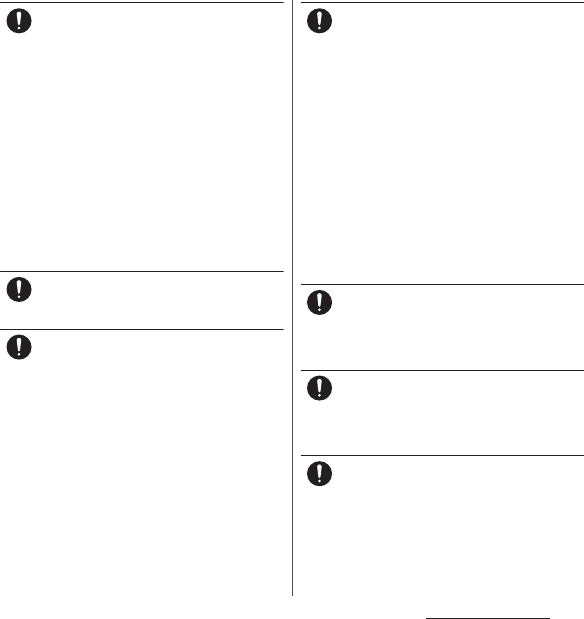
12
Contents/Precautions
Always keep the terminal away from your
ear when you talk with hands-free set, while
the ringtone is loudly sounding, or in stand-
by mode.
Also, when you play game, play back videos
or music, etc. connecting the earphone/
microphone, etc. to the terminal, adjust the
volume adequately.
Loud sound is emitted from the terminal
when calling with hands-free set.
Even in standby mode, a ringtone or an alarm
sound may sound suddenly.
Listening to loud sound for long hours
continuously may cause a disability of ears
such as deafness.
Moreover, too loud sound makes you to barely
hear the surrounding sounds and may cause
an accident.
If you have a weak heart, set the vibrator or
ringtone volume carefully.
Failure to do so may affect your heart.
If you are wearing any electronic medical
equipment, check with the relevant medical
electronic equipment manufacturer or
vendor whether the operation may be
affected by radio waves.
The radio waves from the terminal may affect
electronic medical equipment.
Power off the terminal near electronic
devices or equipment operating on high
precision control or weak signals.
Failure to do so may interfere with the
operation of electronic devices or equipment.
* The following are some electronic devices
or equipment that you should be careful of:
Hearing aids, implantable cardiac
pacemaker, implantable cardioverter
defibrillator, other electronic medical
equipment, and other automatically
controlled devices or equipment.
If you use an implantable cardiac
pacemaker, implantable cardioverter
defibrillator, or other electronic medical
equipment, check with the medical
electronic equipment manufacturer or
vendor whether the operation can be
affected by radio waves.
Be careful about broken glasses or exposed
internal part of the terminal if the display or
the camera lens is broken.
Touching damaged or exposed area may
cause burns, injury, electric shock, etc.
If the internal battery leaks or gives off a
strange smell, immediately remove it from
the vicinity of open flames.
The leaking liquid may ignite fire, catch fire,
explode etc.
Be careful not to allow a pet etc. to bite the
terminal.
Doing so may cause fire, burns, injury, etc.
because of ignition, burst, heat or leaking of
the internal battery.
Do
Do
Do
Do
Do
Do
Do
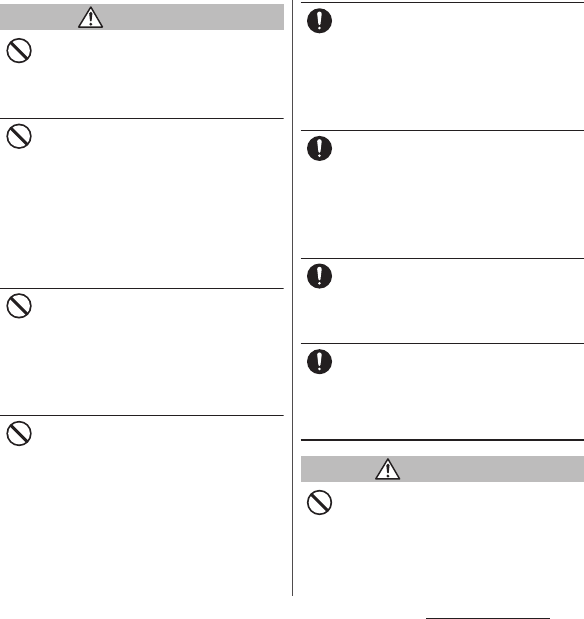
13
Contents/Precautions
CAUTION
When using the motion sensor, check the
safety around you, hold the terminal firmly,
and do not shake it unnecessarily.
Failure to do so may cause accident such as
injuries.
If the internal substance is leaked due to
damage of the display, do not get it on your
skin such as face, hands, or cloths etc.
Doing so may cause injury etc. on your eyes or
skin.
If the internal substance etc. gets into your
eyes or mouth, or contacts skin or clothes,
immediately rinse the contacted area with
clean water.
If the substance gets into the eyes or mouth,
immediately see a doctor after rinsing.
Do not dispose of the terminal together with
usual trash.
Doing so may ignite causing fire, burns, injury,
etc. Also, it may cause environmental
destruction. Bring the unnecessary terminal
into a sales outlet such as docomo Shop. If
your local municipality has a battery recycling
program, dispose of them as provided for.
If the substance etc. leaks out from the
internal battery, do not make it contact with
your skin of face or hands, cloths, etc.
Doing so may cause injury etc. on your eyes or
skin.
If the internal substance etc. gets into your
eyes or mouth, or contacts skin or clothes,
immediately rinse the contacted area with
clean water.
If the substance gets into your eyes or mouth,
immediately see a doctor after rinsing.
To use the terminal in car, check with
automobile manufacturer or dealer to
determine how the device is affected by
radio waves before using.
In rare cases, using the terminal in some
vehicle models can cause the vehicle's
electronic equipment to malfunction. In that
case, stop using the terminal immediately.
If abnormalities on skin are developed by
using the terminal, immediately stop using
and take medical treatment. The use of the
terminal may cause itching, rashes, eczema,
or other symptoms depending on the user's
physical condition.
For material of each part, see the following.
⇒
P. 1 6 " M a t e r i a l li s t "
Make sure not to get metal objects (blade of
cutter, staples, etc.) adhered because
magnetic parts are used on the earpiece/
speaker, or speaker of the terminal.
Such adhered objects may cause injury etc.
Watch the display in an adequately bright
place taking a certain distance from it.
Watching in a dark place or closely may
reduce visual acuity etc.
3. Handling the adapter
WARNING
Do not use the adapter cord if it gets
damaged.
Doing so may cause fire, burns, electric shock,
etc.
Don’t
Don’t
Don’t
Don’t
Do
Do
Do
Do
Don’t
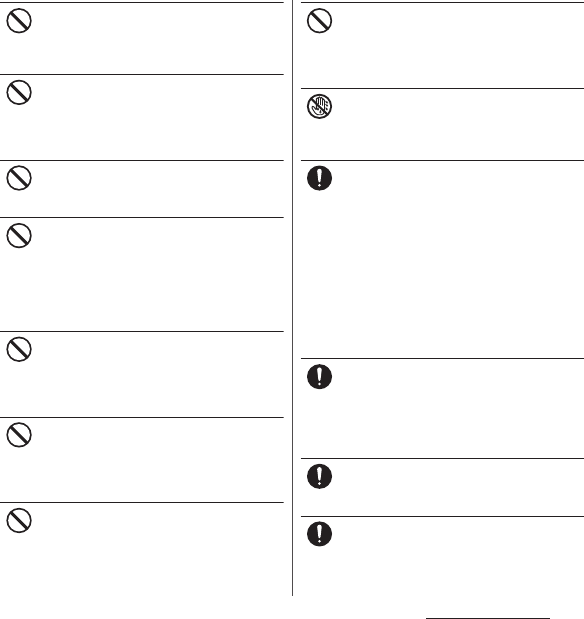
14
Contents/Precautions
Do not use the adapter in a humid place,
such as a bathroom.
Doing so may cause fire, burns, electric shock,
etc.
DC adapter is only for a negative ground
vehicle. Do not use DC adapter for a positive
ground vehicle.
Doing so may cause fire, burns, electric shock,
etc.
Do not touch the adapter if you hear
thunder.
Doing so may cause electric shock etc.
Do not short-circuit the charging jack while
it is connected to a power outlet or
accessory socket. Do not touch the charging
jack with your hands, fingers, or any part of
your body.
Doing so may cause fire, burns, electric shock,
etc.
Do not place heavy objects on the adapter
cord, or do not apply unnecessary force such
as pulling etc.
Doing so may cause fire, burns, electric shock,
etc.
When you insert/remove a plug of AC
adapter to/from power outlet, do not let it to
contact with metal objects.
Doing so may cause fire, burns, electric shock,
etc.
Do not connect the voltage converter for
overseas travel (travel converter) to the AC
adapter.
Doing so may cause ignition, overheating,
electric shock etc.
Do not put an excessive force to the
connection part with the adapter connected
to the terminal.
Doing so may cause fire, burns, injury, electric
shock, etc.
Do not touch the adapter cord, charging
jack or power plug with wet hands.
Doing so may cause fire, burns, electric shock,
etc.
Use the adapter only on the specified power
supply and voltage.
When charging the terminal overseas, use
AC adapter for global use.
Using the incorrect power supply and voltage
may cause fire, burns, electric shock, etc.
AC adapter : 100V AC (Make sure to connect
the adapter to a household AC power outlet.)
AC adapter for global use : 100V to 240V AC
(Make sure to connect the adapter to a
household AC power outlet.)
DC adapter : 12V or 24V DC (only for a
negative-ground vehicle)
When replacing a fuse in a DC adapter, make
sure to use the specified fuse.
Using a fuse other than specified may cause
fire, burns, electric shock, etc. For the specified
fuse, check a manual that comes with a DC
adapter.
Clean dust from the power plug.
Using it with dust adhering may cause fire,
burns or electric shock.
When you connect the adapter or accessory
socket to a power outlet, insert it firmly.
Insecure inserting may cause fire, burns,
electric shock, etc.
Don’t
Don’t
Don’t
Don’t
Don’t
Don’t
Don’t
Don’t
No wet hands
Do
Do
Do
Do
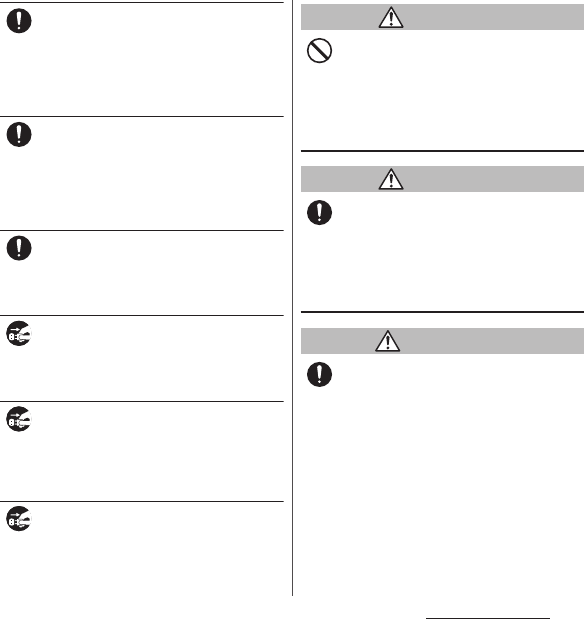
15
Contents/Precautions
When you disconnect the power plug from
an outlet or accessory socket, do not apply
excessive force it such as pulling the cord of
the adapter. Instead, hold the adapter to
disconnect.
Pulling the cord may damage the cord and it
may cause fire, burns, electric shock, etc.
When plugging/unplugging an adapter
into/from the terminal, plug/unplug the
adapter straightly toward the jack without
applying excessive force such as pulling the
cord etc.
Incorrect plugging/unplugging may cause
fire, burns, injury, electric shock, etc.
If the charging terminal is deformed such as
being bent etc., stop using immediately. Do
not use it with the deformation restored.
Doing so may cause fire, burns, injury, etc. due
to short-circuit of charging terminal.
Always remove the power plug of adapter
from an outlet or accessory socket when not
using it.
Keeping with connected to the power plug
may cause fire, burns, electric shock, etc.
Immediately remove the power plug from
an outlet or accessory socket if liquid such as
water (drinking water, sweat, seawater, urine
of pet animals, etc.) enters inside.
Failure to do so may cause fire, burns, electric
shock, etc.
Before cleaning, remove the power plug
from a power outlet or accessory socket.
Failure to do so may cause fire, burns, electric
shock, etc.
CAUTION
Do not touch the adapter for a long time
when it is connected to a power outlet or
accessory socket.
Doing so may cause a burn etc.
4. Handling the docomo nano UIM
card
CAUTION
Be careful of the cut surface not to hurt your
body parts such as fingers when handling
docomo nano UIM card.
Failure to do so may cause injury.
5. Handling the terminal near
electronic medical equipment
WARNING
If you use an implantable cardiac pacemaker
or implantable cardioverter defibrillator,
keep the terminal 15 cm or more away from
the implant at all times.
The radio waves from the terminal may affect
the performance of electronic medical
equipment.
Do
Do
Do
Unplug
Unplug
Unplug
Don’t
Do
Do
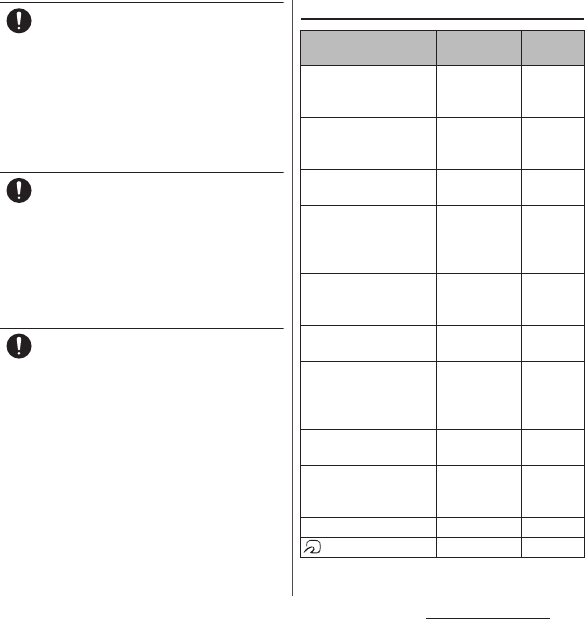
16
Contents/Precautions
If you need to use electronic medical
equipment other than implantable cardiac
pacemaker or implantable cardioverter
defibrillator outside medical facilities such
as treating at home, check with the relevant
medical electronic equipment manufacturer
whether the operation may be affected by
radio waves.
The radio waves from the terminal may affect
the performance of electronic medical
equipment.
When you get close to other people within
15 cm just like not having enough space to
turn around, set the radio wave of the
terminal to OFF beforehand (Airplane mode,
to Power off, etc.).
A person in close proximity may put on
implanted a medical electrical equipment
such as pacemakers and ICDs. The radio waves
from the terminal may affect the performance
of electronic medical equipment.
Follow the instructions of each medical
facility for the use of the terminal on their
premises.
Failure to do so may have effects on the
operation of the electronic medical
equipment.
6. Material list
Do
Do
Do
Part Material Surface
treatment
Exterior case (frame) Nylon resin
(with glass
fiber)
Coating
Exterior case (headset
jack)
Nylon resin
(with glass
fiber)
―
Exterior case (back),
Volume key, Camera key
Aluminum
alloy
Alumite
treatment
Exterior case (lower part
of back, cover of docomo
nano UIM card/microSD
card slot)
Polycarbonate
resin
Coating
Exterior panel (top
surface part, bottom
surface part)
PET resin UV
molded
Transparent plate
(Display, Camera lens)
Hardened glass AFP
treatment
Transparent plate (Flash/
Photo light, Laser AF
sensor, RGBC-IR sensor)
Polycarbonate
resin + Acrylic
resin combined
materials
Hard
coating
treatment
Power key IC + Epoxy
resin
Coating +
Printing
Earpiece/speaker (upper)
panel, speaker (lower)
panel
PET resin Coating
Camera ring (back side) Stainless steel PVD
mark sticker PET resin
―
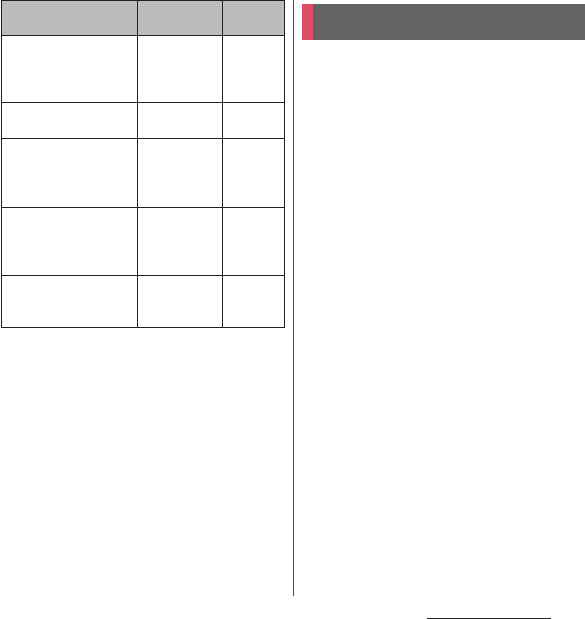
17
Contents/Precautions
■
Common precautions
・
SO-01K is waterproof/dustproof;
however, do not allow liquids such as
water (drinking water, sweat, seawater,
urine of pet animals, etc.) or foreign
objects such as dust to enter inside of
the terminal or adhere to accessories or
optional devices.
The adapter, the docomo nano UIM card, and the
TV antenna cable are not waterproof/dustproof.
Do not use in a bathroom or other highly humid
area or do not let rain touch. Or putting them on
your body, humidity of sweat may cause internal
corrosion and malfunction. Malfunctions which
are determined to be caused by water as result of
inspections are not covered by the warranty. For
repairs, contact "Repairs (Inquiries/Request)" on
the last page (in Japanese only) or DOCOMO-
specified repair office.
・
Waterproofness/dustproofness may not
be maintained if the terminal has
abnormity in appearance such as
damage or deformation. In this case,
contact "Repairs (Inquiries/Request)" on
the last page of this manual (in Japanese
only).
・
Clean the terminal with a dry soft cloth
(such as used for cleaning eyeglasses).
- Do not rub it roughly with a dry cloth. The
display may be damaged.
Waterproof rubber of the
cover of docomo nano
UIM card/microSD card
slot
Silicon rubber
―
docomo nano UIM card/
microSD card tray
Polyacetal resin
―
TV antenna cable :
headset jack (top
surface), connector plug
(top surface)
Polypropylene
resin
―
TV antenna cable :
headset jack (body),
connector plug (body),
cable
Elastomer resin
―
TV antenna cable :
connector plug (metal
part)
Brass Gold
plating
treatment
Part Material Surface
treatment
Handling precautions

18
Contents/Precautions
- Drops of water or dirt left on the display may
cause stains.
- Do not use alcohol, thinner, benzine, cleaning
detergent, etc. to clean the terminal. These
chemicals may erase the printing on the
terminal or cause discoloration.
・
Clean the jacks or the fingerprint sensor
occasionally and use the terminal in a
clean state.
If the jack etc. is dirt, you may not use the terminal
normally.
When cleaning, be careful not to damage the
jack etc.
・
Do not leave the terminal near the air
conditioning vent.
Extreme temperature changes may produce
condensation and corrode the internal parts of
the terminal, causing the terminal to
malfunction.
・
Make sure to use the terminal without
excessive force.
Putting the terminal in a bag full of items or
sitting down with the terminal in the pocket of
your cloth may damage the display, internal
circuit board, internal battery, etc. and cause a
malfunction.
Also, doing so while the external device is
connected to the external connection jack may
cause damage or a malfunction.
・
Use the optional devices specified by
NTT DOCOMO.
Failure to do so may cause a malfunction or
damage.
・
Read the user's manual supplied with
each optional device.
・
Do not drop the terminal or give a
strong impact to the terminal.
Doing so may cause a malfunction or damage.
■
The terminal precautions
・
Do not press the display strongly, or not
operate with a sharp-pointed objects.
The display may get scratched and it may cause
a malfunction or damage.
・
Do not use the terminal in extremely hot
or cold places.
Use the terminal where the temperature ranges
between 5
℃
and 40
℃
(limited to the temporary
use in a bathroom etc. when temperature is
above 36
℃
) and humidity ranges between 45%
and 85%.
・
Using the terminal near a land-line
phone, television or radio may cause
interference in such electric appliance.
・
Back up data that you saved to the
terminal to a microSD card, a PC, or
cloud, etc., or note down in a separate
note and keep it safely.
NTT DOCOMO is not liable for any loss of data
saved in the terminal.
・
Do not insert the plug of external device
to the external connection jack at a slant
when connecting. Or, do not pull the
plug when they are connected.
Doing so may cause a malfunction or damage.
・
The terminal could become warm while
in use and charging. You can continue
using the terminal.

19
Contents/Precautions
・
Do not expose the camera lens under
direct sunlight.
If you do so, some of the elements may melt or
become faded.
・
Usually, keep the cover of docomo nano
UIM card/microSD card slot closed
during use.
Failure to do so may allow liquids such as water
(drinking water, sweat, seawater, urine of pet
animals, etc.) or foreign objects such as dust to
enter inside and cause a malfunction.
・
Do not subject the fingerprint sensor to
strong impact or scratch it.
Doing so not only may cause a malfunction of
the fingerprint sensor, but authentication may
become unavailable.
・
While the microSD card is being used,
do not take the card out and do not turn
off the terminal.
Doing so may cause data loss or malfunction.
・
Keep off a magnetic card or a magnetic
object from the terminal.
The magnetic data in cash cards, credit cards,
telephone cards, floppy disks, etc. may be erased.
Also, strong magnetic objects may cause a
malfunction of the terminal.
・
Do not decorate the terminal with a film
or stickers.
Doing so may hinder the proper operations for
functions using the proximity/light sensor.
For a location of proximity/light sensor, see the
following.
⇒
P.30 "Part names and functions"
・
The internal battery is out of the
warranty due to a consumable part.
The internal battery may become swelled toward
the end of battery life depending on usage
condition of the internal battery.
Replace the internal battery if the usable time is
extremely shortened even in a full charge or
when the internal battery is swollen. For
replacing internal battery, contact "Repairs
(Inquiries/Request)" on the last page (in Japanese
only) or DOCOMO-specified repair office.
・
Charge the battery in an environment
with the proper ambient temperature
(5
℃
to 35
℃
).
・
The operating time of the internal
battery varies depending on the
operating environment and the
degradation level of the internal
battery.
・
To store the terminal, avoid the
following conditions so as not to
degrade the performance or the battery
life of the internal battery.
- The battery is fully charged (immediately after
the charging is complete)
- The battery has run out (the terminal cannot
power on)
An appropriate battery level for storing is about
40%.
・
Type of internal battery for the terminal
is as follows.
Display Type of Battery
Li-ion 00 Lithium Ion Battery

20
Contents/Precautions
■
Adapter precautions
・
Charge the battery in an environment
with the proper ambient temperature
(5
℃
to 35
℃
).
・
Do not charge in the following places.
- Places that are very humid, dusty or exposed to
strong vibrations
- Near land-line phone or TV/radio
・
The adapter may become hot during
charging. This condition is not
abnormal.
・
When using the DC adapter for
charging, do not turn off the vehicle
engine.
Doing so may cause the exhaustion of vehicle
battery.
・
When you use the power outlet with a
mechanism to prevent the plug from
being removed, follow the instructions
on the outlet's user's manual.
・
Do not subject the equipment to a
strong impact. Do not deform the
charging jack.
Doing so may cause malfunction.
■
docomo nano UIM card precautions
・
Do not use unnecessary force to insert/
remove the docomo nano UIM card.
・
Note that DOCOMO assumes no
responsibility for any malfunctions
resulting from inserting the docomo
nano UIM card into another IC card
reader/writer and using it.
・
Clean the IC part occasionally and use it
in a clean state.
If the IC is dirt, it may not be used properly.
・
Clean the terminal with a dry soft cloth
(such as used for cleaning eyeglasses).
・
Back up data that you saved to the
docomo nano UIM card to a microSD
card, a PC, or cloud, etc., or note down in
a separate note and keep it safely.
NTT DOCOMO is not liable for any loss of data
saved in the terminal.
・
Take an expended docomo nano UIM
card to a sales outlet such as docomo
Shop for proper disposal in order to
protect the environment.
・
Do not carelessly damage, contact, or
short-circuit an IC.
Doing so may cause data loss or malfunction.
・
Do not drop a docomo nano UIM card or
subject it to impact.
Doing so may cause malfunction.
・
Do not bend a docomo nano UIM card
or place a heavy object on it.
Doing so may cause malfunction.
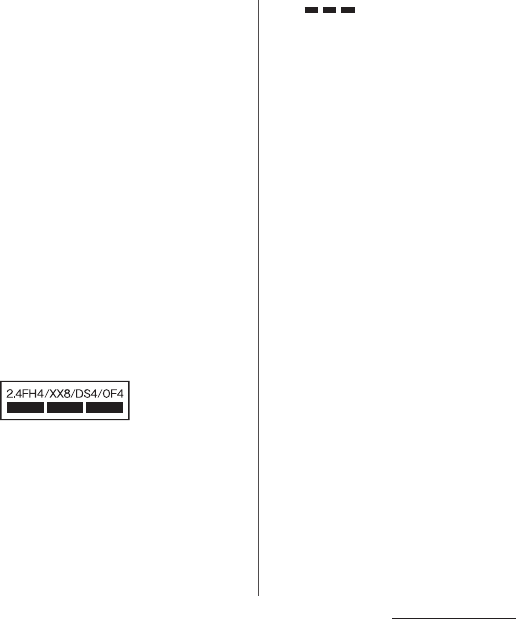
21
Contents/Precautions
・
Do not insert a docomo nano UIM card
into the terminal if a label or seal is
attached to the card.
Doing so may cause malfunction.
■
Bluetooth
®
function precautions
・
To secure the Bluetooth communication
security, the terminal supports the
security function compliant with
Bluetooth standards, but the security
may not be sufficient depending on the
setting. Be aware of security risks when
using Bluetooth.
・
Please be aware that DOCOMO is not
responsible for any data leakage that
might occur when communicating data
via Bluetooth.
・
Frequency band
The frequency band used by the terminals
Bluetooth/wireless LAN function is written as
follows:
・
Bluetooth cautions
The operating frequency band of the terminal is
used by industrial, scientific, consumer and
medical equipment including microwave ovens,
premises radio stations for identifying mobile
units used in the manufacturing lines of plants
(radio stations requiring a license), specified low
power radio stations (radio stations requiring no
license) and amateur radio stations (hereinafter
referred to as "another station").
- Before using this equipment, confirm that
"another station" is not being operated nearby.
- In the event of the terminal causing harmful
radio wave interference with "another station",
promptly change the operating frequency or
stop radio wave emission by turning off the
power, etc.
- If you have further questions, contact "General
Inquiries" on the last page.
2.4 : This radio equipment uses the 2400 MHz
band.
FH/XX/DS/OF
:
Modulation scheme is the
FH-SS, other system, DS-SS,
or OFDM system.
4 : The estimated interference distance is 40
m or less.
8 : The estimated interference distance is 80
m or less.
: The full band between 2400 MHz
and 2483.5 MHz is used and the
band of the mobile identification
device can be avoided.
Available channels vary depending on the
country.
For use in an aircraft, contact the airline
beforehand.

22
Contents/Precautions
■
Wireless LAN (WLAN) precautions
・
Wireless LAN (WLAN) exchanges
information using radio waves, and
allows you to freely establish LAN
connection if you are within an area
where radio waves reach. However,
without appropriate security settings,
communications may be intercepted or
hacked by malicious parties. It is
recommended to configure necessary
security settings on your own judgment
and responsibility.
・
Wireless LAN
Do not use wireless LAN near magnetic devices
such as electrical appliances or AV/OA devices, or
in radio waves.
- Magnetism or radio waves may increase noises
or disable communications (especially when
using a microwave oven).
- When used near TV, radio, etc., reception
interference may occur, or channels on the TV
screen may be disturbed.
- If there are multiple wireless LAN access points
nearby and the same channel is used, search
may not work correctly.
・
2.4GHz device cautions
The operating frequency band of the WLAN
device is used by industrial, scientific, consumer
and medical equipment including home electric
appliances such as microwave ovens, premises
radio stations for identifying mobile units used in
the manufacturing lines of plants (radio stations
requiring a license), specified low power radio
stations (radio stations requiring no license) and
amateur radio stations (radio stations requiring a
license).
- Before using the device, confirm that premises
radio stations for identifying mobile units,
specified low power radio stations and amateur
radio stations are not being operated nearby.
- If the device causes harmful radio interference
to premises radio stations for identifying
mobile units, immediately change the
frequency band or stop use, and contact
"General Inquiries" on the last page for crosstalk
avoidance, etc. (e.g. partition setup).
- If the device causes radio interference to
specified low power radio stations or amateur
radio stations, contact "General Inquiries" on
the last page.
・
5GHz device cautions
The terminal can use 3 frequency bands of
5.2GHz band (W52), 5.3GHz band (W53), 5.6 GHz
band (W56).
- 5.2GHz band (W52/36, 40, 44, 48 ch)
- 5.3GHz band (W53/52, 56, 60, 64 ch)
- 5.6GHz band (W56/100, 104, 108, 112, 116, 120,
124, 128, 132, 136, 140 ch)
Using wireless LAN built-into the terminal in 5.2/
5.3 GHz outside is prohibited by the Radio Law.

23
Contents/Precautions
■
FeliCa
®
and NFC reader/writer function
precautions
・
FeliCa and NFC reader/writer, P2P
function of the terminal use weak waves
requiring no licenses for radio stations.
・
They use 13.56 MHz frequency band.
When the other FeliCa or NFC reader/
writer, P2P function is used in the
surroundings, keep the terminal away
sufficiently from them.
Before using, confirm that there are no
radio stations using the same frequency
band nearby.
・
For use in an aircraft, contact the airline
beforehand. Some countries may
restrict the use of the function. Check
the regulations of the country/region
before using it.
■
Note
・
Do not use a remodeled terminal. Using
a remodeled terminal violates the Radio
Law/Telecommunications Business Act.
The terminal is compliant with rules on the
technical standard conformance of specified
wireless equipment based on the Radio Law/
Telecommunications Business Act, and as a proof
of it, the "Technical Compliance Mark " is
depicted on the electronic nameplate of the
terminal. To check the certificate, from the Home
screen,
u
[Settings]
u
[About phone]
u
[Certificates].
If you remove the screws and alter the inside of
the terminal, the technical regulations
conformity certification becomes invalid.
Do not use the terminal with the certification
invalid, as it is a violation of the Radio Law and
Telecommunications Business Act.
・
Be careful when using the terminal
while driving.
Use of the terminal holding with your hand while
driving will result in a penalty.
However, absolutely necessary cases such as
rescue of a sick person or maintaining public
safety are exempted.
・
The FeliCa and the NFC reader/writer
functions are compliant with the
wireless standards of Japan.
Check the regulations of the country/
region beforehand if you try to use the
function overseas.
・
Do not alter the basic software illegally.
It is regarded as the software modification and
Repairs may be refused.

24
Contents/Precautions
SO-01K provides waterproofness property of
IPX5
*1
, IPX8
*2
, and dustproofness property of
IP6X
*3
with the cover of docomo nano UIM
card/microSD card slot firmly attached.
*1 IPX5 means that a phone keeps functioning
after applying a jet flow of 12.5 L/min. from
every direction from a distance of
approximately 3 m for at least 3 minutes
using water nozzle in 6.3 mm inner
diameter.
*2 IPX8 means that a phone keeps functioning
after SO-01K is slowly submerged to depth
of 1.5 m in static tap water at room
temperature, left there for approximately 30
minutes and then taken out.
*3 IP6X indicates that a phone has the ability
to prevent dust from entering even when it
has been shaken for 8 hours in an apparatus
containing dust particles 75
μ
m or less in
diameter.
・
You can talk without an umbrella in the rain
(for rainfall of 20 mm or less per hour).
- Do not open or close the cover of docomo
nano UIM card/microSD card slot with wet
hands or with water droplets on the
terminal.
・
You can wash the terminal when it gets dirt or
stained with liquid other than tap water.
- Wash the terminal with tap water at normal
temperature (5
℃
-35
℃
) by weaker water
flow (less than 6 L/min.) at distance of
approximately 10 cm away from the tap or
shower.
- When washing the terminal, hold the cover
of docomo nano UIM card/microSD card
slot closed, and wash the terminal with your
hands, not using a brush or sponge. After
washing, drain the terminal before use
(P.28).
・
You can use at a poolside. Do not throw water
from the pool on the terminal, or soak it in
pool water.
Waterproofness/
Dustproofness
What you can do with
waterproofness/dustproofness
of SO-01K

25
Contents/Precautions
・
You can use the terminal in a bathroom.
- Do not immerse the terminal into a bathtub.
Also, do not use the terminal in hot water.
Doing so may cause malfunction. If you
should fall the terminal into the bathtub,
immediately pick it up to drain water in
specified procedure (P.28).
- Never put the terminal in hot spring water or
water containing soap, detergent or bath
powder. In case the terminal gets wet with
water other than tap water, wash it in the
procedure above.
- You can use the terminal within 2 hours in a
bathroom where the temperature ranges
between 5 and 45
℃
and humidity ranges
between 45 and 99%.
- Rapid temperature change may cause
condensation. In case of bringing the
terminal from a cold place to warm place
such as a bathroom, wait until the terminal
reaches the room temperature.
- Do not put hot water from a faucet or
shower.
To avoid water ingress, be sure to observe the
following points.
・
Do not throw any liquid other than room
temperature tap water on the terminal, or
soak it in such liquid.
・
Firmly close the cover of docomo nano UIM
card/microSD card slot. Even a fine obstacle
(one hair, one grain of sand, tiny fiber, etc.) put
between contact surfaces may allow water to
enter.
・
Do not poke the earpiece/speaker,
microphone/speaker, speaker, second
microphone, headset jack, or USB Type-C
™
jack with a sharp object.
・
Do not let the terminal fall. It may become
scratched causing the waterproof/dustproof
performance to degrade.
・
The rubber gasket on the inner side of the
cover of docomo nano UIM card/microSD
card slot plays an important role in keeping
waterproof/dustproof performance. Do not
remove or damage them. Also, prevent dust
from adhering to them.
To ensure waterproofness/
dustproofness

26
Contents/Precautions
■
Opening the cover of docomo nano
UIM card/microSD card slot
Put your tip of finger (fingernail) into the
groove and draw the cover out in the arrow
direction.
If the cover of docomo nano UIM card/
microSD card slot is opened and closed, the
terminal restarts.
■
Closing the cover of docomo nano UIM
card/microSD card slot
Push the tray all the way in the arrow
direction and firmly press parts and
make sure that there are no gaps between
the terminal and the cover.
It is recommended to replace the parts for
maintaining waterproof/dustproof property once
every two years regardless of whether any
abnormality is present. DOCOMO replaces the
parts as a chargeable service. Bring the terminal to
a sales outlet such as a DOCOMO-specified repair
office.
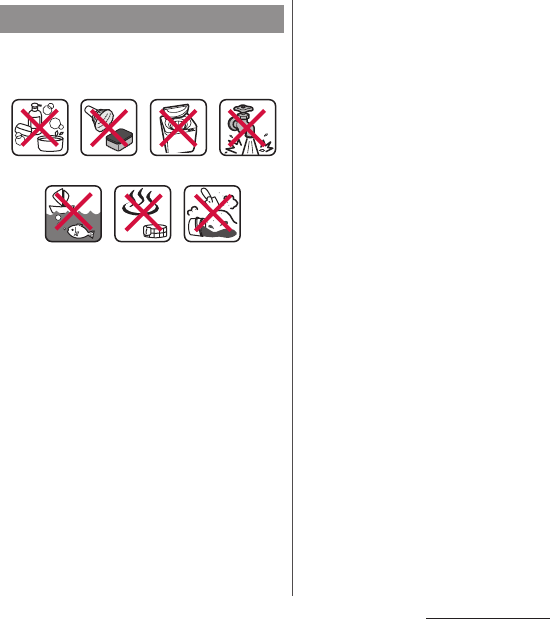
27
Contents/Precautions
Do not perform actions shown in the
illustrations below.
Observe the following precautions to use the
terminal properly.
・
Accessories and optional devices are not
waterproof/dustproof.
・
Do not apply water flow stronger than
allowed (P.24). SO-01K provides IPX5
waterproofness, but doing so may cause
malfunction.
・
If the terminal gets wet with salt water, sea
water, refreshing beverage or mud or sand
adhered, wash it immediately. If they dry out,
it is hard to remove the dirt and it may cause
damage or malfunction.
・
Do not put the terminal in hot water, use it in
a sauna or apply hot airflow (from a hair dryer
etc.) to it.
・
Do not move the terminal in water or slam the
terminal against the surface of water.
・
If you put the terminal in tap water, be sure to
have it within 30 minutes.
・
When you use the terminal in swimming pool,
obey rules of the facility.
・
The terminal does not float on water.
・
Do not leave water on the terminal. In cold
region, the terminal freezes up and may cause
malfunction.
・
Do not leave water droplet on the earpiece/
speaker, microphone, speaker, second
microphone, and headset jack. Such water
may interfere with talking.
・
If the terminal gets splashed with water or
other liquid while the cover of docomo nano
UIM card/microSD card slot is open, the liquid
may get inside the terminal, causing electric
shock or malfunction. Stop using the terminal,
turn off the power and contact a DOCOMO-
specified repair office.
・
If the rubber gasket on the inner side of the
cover of docomo nano UIM card/microSD
card slot is damaged or deformed, have it
replaced at a DOCOMO-specified repair office.
・
Do not connect TV antenna cable, earphones,
etc. when the terminal is wet with water.
Doing so may cause malfunction.
Important precautions
<Example>
Washing with
brush/sponge
Using Soap/Detergent/
Bath powder
Machine-
washing
Applying strong
water ow
Soaking in
ocean water
Using in hot
spring
Attaching
sand/mud
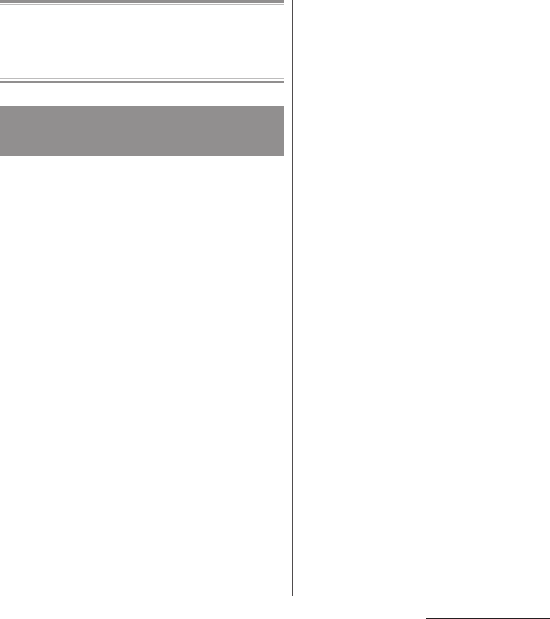
28
Contents/Precautions
DOCOMO does not guarantee actual operations
under all states. Malfunctions deemed to be caused
by inappropriate operation by the customer are
not covered by the warranty.
When the terminal is wet, water may flow out
after wiping it off; drain the water in the
following steps.
a
Hold the terminal firmly and wipe off moisture on
the terminal surface and back side with dry, clean
cloth etc.
b
Shake the terminal about 20 times, firmly holding it,
until no more drops of water come out (shown left).
Do the same with the terminal upside down (shown
right).
c
To wipe any water off the gaps or the following
parts, tap the terminal against a dry, clean cloth or
similar material about 10 times.
・
Earpiece/speaker
・
Microphone
・
Speaker
・
Second microphone
・
Headset jack
・
USB Type-C jack
・
Power key/Screen lock key/Fingerprint sensor
・
Volume key/Zoom key
・
Camera key
・
Cover of docomo nano UIM card/microSD card
slot
Draining water from the
terminal
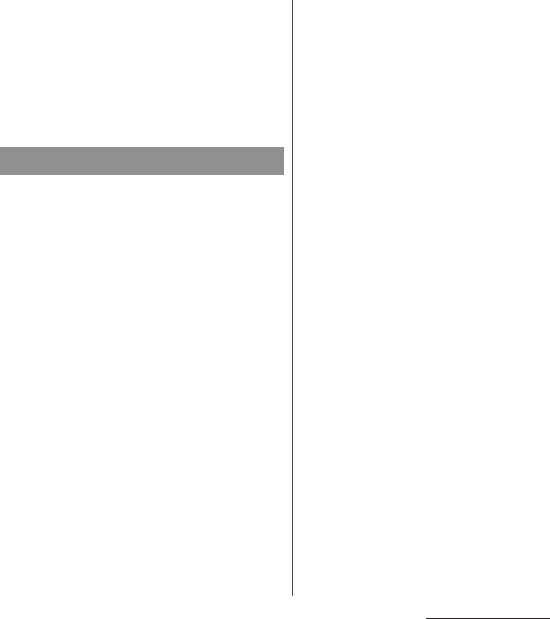
29
Contents/Precautions
d
Wipe off water drained from the terminal with dry,
clean cloth etc., and dry naturally.
・
Wipe off water drained from the terminal with
dry, clean cloth etc., and dry naturally.
・
Do not wipe off water remaining in gaps directly
with a cotton swab etc.
・
Dry the terminal naturally for about 3 hours at
room temperature.
Check the following before and after
charging.
・
Check if the terminal is not wet. Never charge
the battery when the terminal is wet.
・
Accessories and optional devices are not
waterproof/dustproof.
・
When charging the battery when or after the
terminal is wet, adequately drain it and wipe
off water with a dry, clean cloth etc.
・
Do not use the AC adapter in a bathroom,
shower room, kitchen, lavatory, or other
humid area. Doing so may cause fire or
electric shock.
・
Do not touch the AC adapter with wet hands.
Doing so may cause electric shock.
・
Never connect a Type-C plug if the terminal is
wet. Although the terminal is waterproof,
inserting a Type-C plug when the terminal is
wet may cause an electric shock or short
circuit due to moisture or foreign matter on
the terminal or the Type-C plug. This can
cause excessive heat, malfunction, fire, burn
injury, electric shock, etc.
Notes on charging
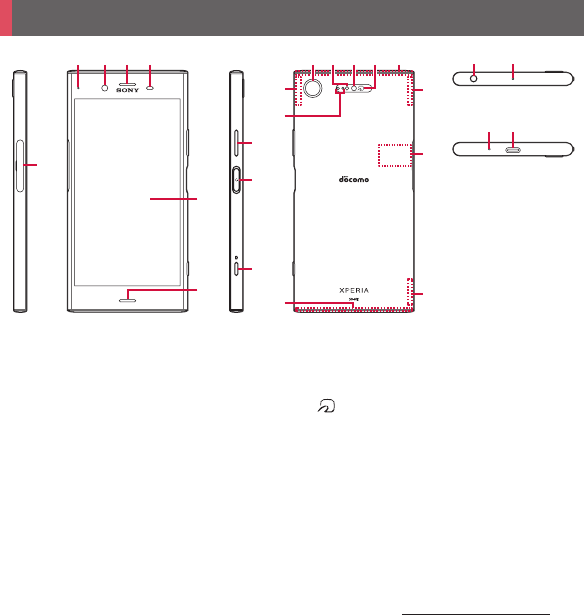
30
Before Using the Terminal
a
docomo nano UIM card/microSD card slot
b
Notification LED
→
P. 5 0
c
Front camera lens
d
Earpiece/speaker
e
Proximity/light sensor : Detects a face getting closer
to the touch screen during a call and turns it off to
prevent misoperation, and helps with automatic
screen brightness control.
f
Touch screen
→
P. 4 4
g
Speaker
h
Volume key/Zoom key
iO
Power key/Screen lock key/Fingerprint sensor
→
P. 4 2 , P. 1 8 2
jk
Camera key
→
P.134, P.137, P.139
k
Camera lens
l
RGBC-IR sensor : When shooting, it detects
elements of light source of shooting environment
to adjust white balance automatically.
m
Flash/Photo light
n
mark
o
LTE/FOMA/GPS antenna section
*1
p
Wi-Fi antenna section
*1
q
Laser AF sensor : When shooting, it detects distance
to a subject and focus on automatically.
r
LTE/FOMA antenna section
*1
s
Wi-Fi/Bluetooth antenna section
*1
t
Nameplate
*2
u
LTE antenna section
*1
v
Headset jack
→
P.128, P.231
w
Second microphone : Reduces noise to make voice
to be listened easily.
Part names and functions
b c d e
h
i
j
a
vw
x y
o
f
g
s
t
u
p
r
q
k m nl
Top
Bottom
RightLeft BackFront

31
Before Using the Terminal
x
Microphone
y
USB Type-C jack
*1 The antenna is built into the terminal. Covering
around the antenna with your hand may affect the
quality of communications.
*2 A sticker bearing the CE mark, FCC ID, IMEI
information, etc. is attached. Please do not peel off
the sticker or remove the nameplate.
❖
Note
・
Do not put a sticker or other material on the
proximity/light sensor, laser AF sensor, or RGBC-IR
sensor.
・
The back cover cannot be removed. Attempting to
remove the back cover with excessive force may
cause damage or malfunction.
・
The battery is built into the terminal and not removal.
The docomo nano UIM card is an IC card
recorded user information such as your
phone number etc.
・
You can use the terminal with a docomo nano
UIM card. If you have a docomo mini UIM card,
UIM, or FOMA card, bring it to a docomo Shop
to replace it with a docomo nano UIM card.
・
When docomo nano UIM card is not inserted
to the terminal, making calls, packet
communication, etc. are not available.
・
For details on the docomo nano UIM card,
refer to the docomo nano UIM card manual or
NTT DOCOMO website.
・
If a microSD card is installed, be sure to
unmount it (P.35) (to disable reading/writing)
before installing or removing the docomo
nano UIM card.
・
Opening/closing the cover of docomo nano
UIM card/microSD card slot (P.25).
■
Security codes of the docomo nano
UIM card
The docomo nano UIM card has a security
code called a PIN code. The code is set to
"0000" at subscription, which you can
change by yourself (P.181).
❖
Information
・
Please be careful not to touch or scratch the IC when
you handle the docomo nano UIM card. Doing so
may cause malfunction or damage.
docomo nano UIM card
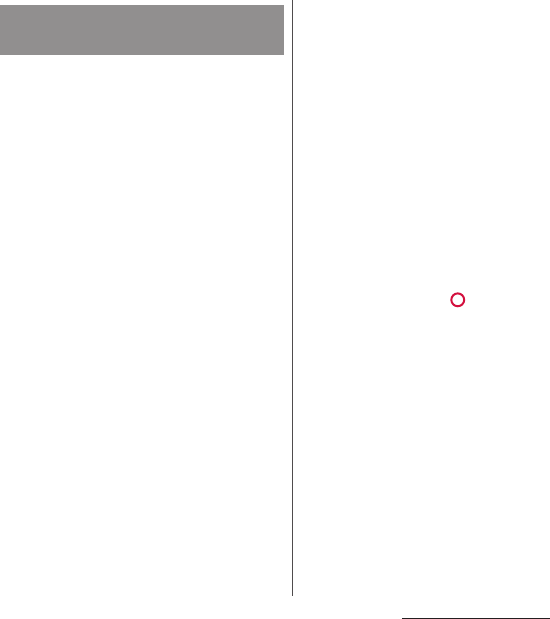
32
Before Using the Terminal
1
Draw the cover of docomo nano
UIM card/microSD card slot (P.26).
2
Pull the tray straight out from the
terminal.
3
With the IC side facing up, place
the docomo nano UIM card on the
tray.
・
Make sure that the corner cut of the
card is oriented properly.
・
Be sure to fit the docomo nano UIM
card into the tray so that it does not
shift.
4
Hold the terminal horizontally and
insert the tray with the card into
the terminal and push it straight.
・
Be careful about the direction to insert
of the tray.
5
Push the tray into the end and
firmly press the parts and make
sure that there are no gaps
between the terminal and cover.
Inserting docomo nano UIM
card

33
Before Using the Terminal
1
Draw the cover of docomo nano
UIM card/microSD card slot (P.26).
2
Pull the tray straight out from the
terminal. (P.32).
3
Remove the docomo nano UIM
card from the tray.
4
Insert the tray into the terminal
and push it straight.
・
Be careful about the direction to insert
of the tray.
5
Firmly push the tray into the end
and make sure that there are no
gaps between the terminal and
cover (P.32).
You can save data in the terminal to a
microSD card or import data from the
microSD card to the terminal. You can use
microSD card for any other compatible
devices.
・
The terminal supports microSD card of up to
2 GB, and microSDHC card of up to 32 GB,
microSDXC card of up to 256 GB (As of May,
2017).
・
For compatible microSD cards, contact
manufacturers of microSD cards.
・
A microSDXC card can be used only on a
compatible device. Do not insert a
microSDXC card into a non-microSDXC-
compatible device may damage or destroy
data saved on the microSDXC card.
・
If you want to reuse a microSDXC card on
which data is destroyed, format microSDXC
card (all data will be erased) on an SDXC-
compatible device.
・
When copying data to/from a non-SDXC-
compatible device, use a card (microSDHC
card , microSD card, etc.) complying with
standards of device.
Removing docomo nano UIM
card
microSD card
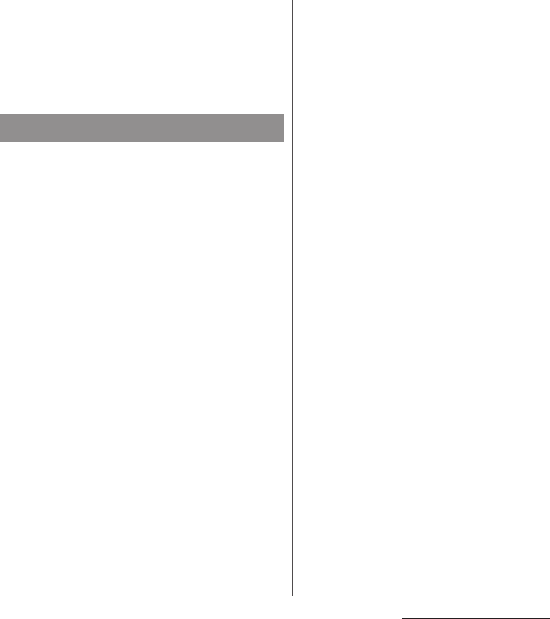
34
Before Using the Terminal
・
The terminal supports microSD cards of up to
Class 10 and UHS speed class 1. Note that the
speed class indicates performance of
microSD cards and all the functions may not
be performed at the speed class rate.
・
Opening/closing the cover of docomo nano
UIM card/microSD card slot (P.25).
1
Draw the cover of docomo nano
UIM card/microSD card slot out
(P.26).
2
Pull the tray out straight from the
terminal to remove.
3
Set microSD card into the tray with
the contacts side facing up.
・
Set a microSD card surely into the tray
not come off.
4
Hold the terminal horizontally and
insert the tray with the card and
press it straight into the slot.
・
Be careful about the direction to insert
of the tray.
Installing microSD card
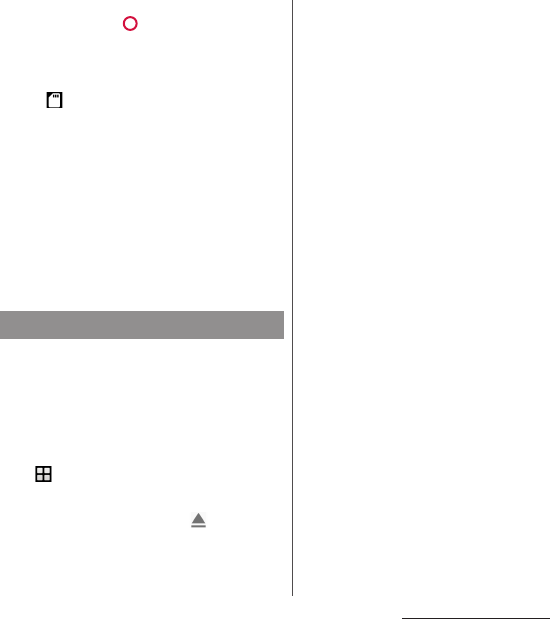
35
Before Using the Terminal
5
Push the tray into the end and
firmly press parts and make
sure that there are no gaps
between the terminal and the
cover.
・
appears on the status bar and
writing to the microSD card is enabled.
Make sure to unmount microSD card (make
reading/writing unavailable) before
removing.
・
Opening/closing the cover of docomo nano
UIM card/microSD card slot (P.25).
1
From the Home screen,
u
[Settings]
u
[Storage &
memory].
2
[Storage usage]
u
Tap of "SD
Card".
・
The microSD card is unmounted.
3
Draw the cover of docomo nano
UIM card/microSD card slot out
(P.26).
4
Pull the tray out straight from the
terminal to remove (P.34).
5
Remove the microSD card from the
tray.
6
Hold the terminal horizontally and
insert the tray and press it straight
into the slot.
・
Be careful about the direction to insert
of the tray.
Removing microSD card
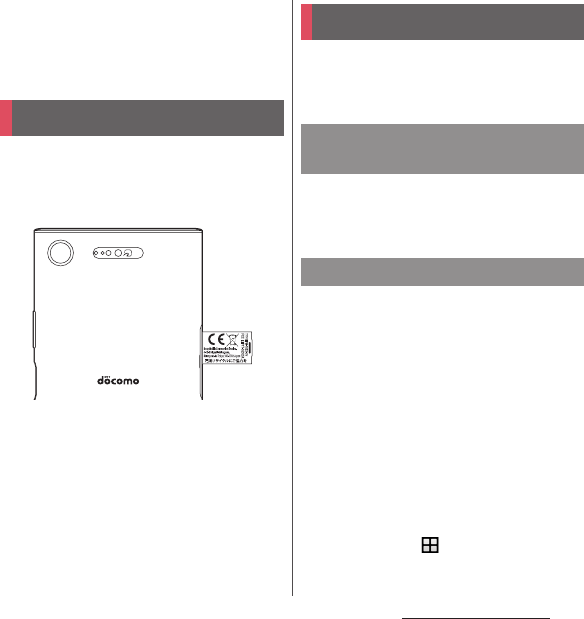
36
Before Using the Terminal
7
Firmly push the tray into the end
and make sure that there are no
gaps between the terminal and the
cover (P.35).
1
Open the docomo nano UIM card
slot cover, and insert a fingernail
into the hook at the edge of the
label tray, then pull it out straight.
The internal battery is not fully charged at the
time of purchase.
・
Estimated charging time (P.229)
The charging time varies by the internal
battery condition or operating environment.
・
Estimated usage time (P.229)
・
The internal battery is a consumable part.
Each time the internal battery is recharged,
the battery usage time per one charge
gradually decreases.
・
When the battery usage time per one charge
becomes about half of that at the time of
purchased, replacing the internal battery is
recommended because the internal battery is
near the end of life.
・
Watching TV etc. for a long time while
charging may shorten the lifetime of the
internal battery.
・
To check the charging performance, from the
Home screen, tap
u
[Settings]
u
[About
phone]
u
[Status]
u
[Battery life].
CE mark and FCC ID
Charging
Operation time on full charge
(estimate)
Life of the internal battery
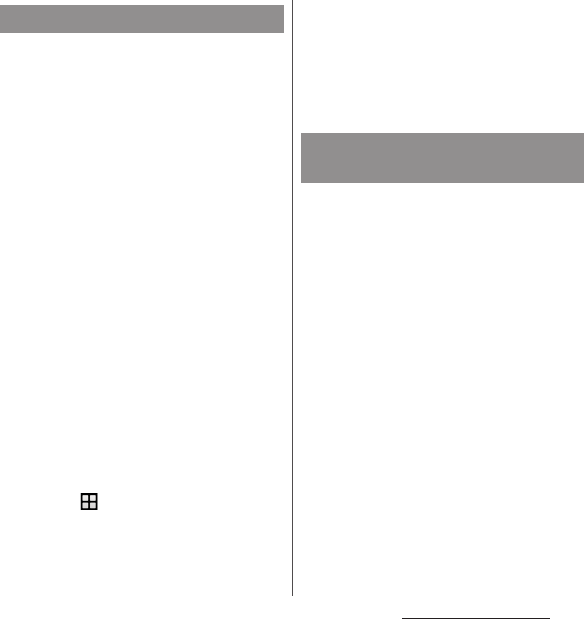
37
Before Using the Terminal
・
It is recommended to use the AC Adapter 06
(optional) for charging. For details on the AC
Adapter 06, refer to the AC Adapter 06
manual.
・
The AC Adapter 06 is compatible with 100V to
240V AC. For using the terminal overseas, a
plug adapter that fits the electrical outlets in
the country you stay is needed. Do not use an
electrical transformer for overseas use to
charge the terminal.
・
Use a compatible AC adapter or USB cable A
to C for charging. If you use a charger other
than compatible ones, charging may not be
available or operations may not be performed
correctly.
・
Insert and remove the AC adapter cord or USB
cable A to C slowly and evenly so that
excessive force is not applied.
・
When charging starts while the power is on, a
sound to indicate the start of charging is
heard, and the notification LED of the terminal
turns on (P.50).
・
To check the battery level, see the status bar at
the top of the screen or from the Home
screen, tap
u
[Settings]
u
[About phone]
u
[Status] to see "Battery level".
・
If you start charging with the terminal
powered off, the screen indicating charging
status activates although you cannot operate
the terminal. Therefore, do not charge the
battery in a place where the powering off is
required.
Battery Care is a function that learns your
charging habit (time zone for connecting to
charging equipment long) to adjust charging
speed and keep battery performance better
so as to extend battery life.
■
Starting "Battery Care" function
It predicts the time when charging
equipment will be disconnected by learned
charging habit and adjusts charging speed
so that the battery become fully charged at
the time.
After start of charging with Battery Care,
charging pauses once short of full charge.
And then charging resumes near estimated
full charge time to be on time for full charge.
Before charging
Saving battery life (Battery
Care)
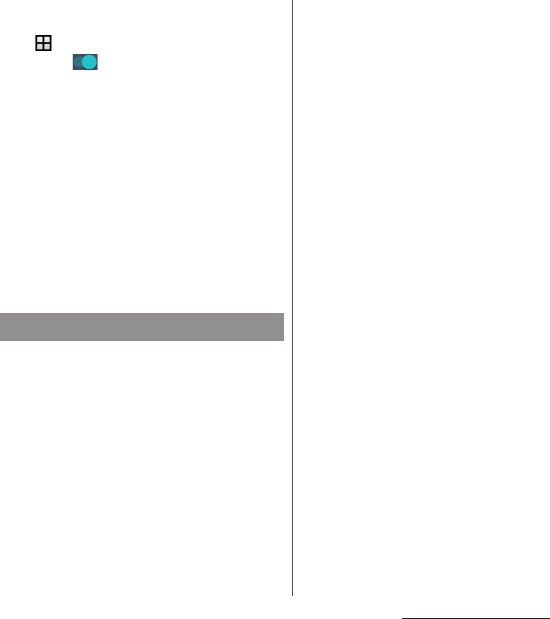
38
Before Using the Terminal
■
Switching normal charging
・
From the Home screen,
u
[Settings]
u
[Battery]
u
[Battery Care]
u
Tap to turn off Battery Care.
・
To temporarily stop Battery Care charging
and switch to normal charging, drag the
status bar down and tap the notification
of Battery Care charging.
❖
Note
・
It may take 7 days or more to complete learning your
habit.
・
If regularity in your charging habit cannot be found,
Battery Care does not start because incomplete of
the learning and normal charging will be performed.
・
If you remove charging equipment during Battery
Care charging, the terminal may not be fully charged.
To charge the battery using the Desktop
Holder SO27 (optional) and AC Adapter 06
(optional), operate the following steps.
・
Depending on the thickness of the terminal,
please install the attachment that was
included with the desktop holder before
charging. Placing the terminal on the desktop
holder without the attachment on it may
damage the USB Type-C jack or other parts.
・
When you do not attach a commercially
available case or cover to the terminal, attach
the Attachment 52B (P.39) to the desktop
holder to use.
1
Insert a Type-C plug of the AC
adapter into the charging jack on
the back of the desktop holder.
2
Unfold the power plug of the AC
adapter and insert it into a power
outlet. Then place the terminal on
the desktop holder.
・
A sound to indicate the start of
charging is heard, and the notification
LED of the terminal turns on (P.50).
Charging with desktop holder

39
Before Using the Terminal
3
When charging is complete,
holding the desktop holder, lift the
terminal up to remove.
4
Remove the power plug of AC
adapter from the outlet, and then
remove the Type-C plug from the
desktop holder.
❖
Note
・
Connect the terminal correctly. Wrong connection
may cause damage.
・
A terminal mounted on the desktop holder may be
damaged if pressed hard against the holder.
Attaching/Removing the attachment
■
Attaching
1
Check the shape of front/back of the
attachment and the attaching part of
the desktop holder, then fit the
attachment with the desktop holder.
2
Firmly press the attachment straight
into the desktop holder and make
sure that there are no gaps between
the attachment and the desktop
holder.
■
Removing
1
Hold the desktop holder and
remove the attachment lifting up
the both ends.

40
Before Using the Terminal
When using AC Adapter 06 (optional) for
charging, do the following procedures.
1
Insert the Type-C plug of the AC
adapter horizontally into the USB
Type-C jack of the terminal.
2
Unfold the power plug of the AC
adapter and insert it into an outlet.
・
A sound to indicate the start of
charging is heard, and the notification
LED of the terminal turns on (P.50).
3
When charging is complete,
remove the power plug of the AC
adapter, and then remove the
Type-C plug horizontally from the
terminal.
❖
Note
・
Connect the AC adapter correctly. Wrong connection
may cause damage.
DC Adapter 04 (optional) is an adapter for
supplying power from a car accessory socket
(12V/24V).
When using DC Adapter 04, microUSB
conversion adapter B to C 01 (optional) is
required.
For details, refer to manuals of DC Adapter
and microUSB conversion adapter.
Charging with AC adapter
Charging with DC adapter

41
Before Using the Terminal
When charging using USB cable A to C 01
(optional), do the following procedures.
1
Insert a Type-C plug of the USB
cable A to C horizontally into the
USB Type-C jack of the terminal.
2
Insert a USB plug of the USB cable
A to C to a USB port of a PC.
・
A sound to indicate the start of
charging is heard, and the notification
LED of the terminal turns on (P.50).
・
If the installation screen for the
terminal's driver software appears on
your PC, please wait a moment for the
installation to complete.
・
When "Install software" screen appears
on the terminal, tap [SKIP] or [CANCEL].
・
When the "Use USB to" confirmation
screen appears, tap [CANCEL].
3
When charging is complete,
remove the USB plug of the USB
cable A to C from the USB port of
PC and then remove the Type-C
plug horizontally from the
terminal.
❖
Note
・
Connect the USB cable A to C correctly. Wrong
connection may cause damage.
Charging with a PC
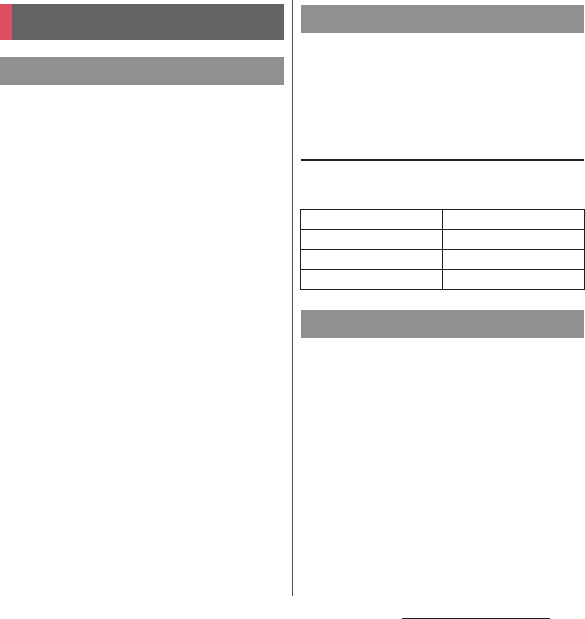
42
Before Using the Terminal
1
Press and hold
O
for at least 1
second.
・
The terminal vibrates and the lock
screen appears after a while.
・
When you first turn on the power and
"
ようこそ
(Welcome)" is displayed,
follow the onscreen instructions to
make initial settings (P.43).
2
Cancel the screen lock.
・
Canceling the screen lock (P.43).
❖
Information
・
If the notification LED flashes red multiple times or an
icon appears indicating that the battery is low when
you press
O
with the terminal powered off, the
battery is running low. Charge the terminal (P.36).
・
When SIM card lock (P.181) is set, enter PIN code on
the PIN code entry screen (P.181).
1
Press and hold
O
for at least 1
second.
2
[Power off].
Using a menu when pressing and
holding
O
at least 1 second
The following operations are available from
the menu.
When sleep mode is set, the screen backlight
turns off so that you can avoid an incorrect
action of the touch screen or the keys, and
set the screen lock.
1
Press
O
.
・
Press
O
again to exit from sleep
mode and turn on the screen backlight.
❖
Information
・
Also, when the screen backlight goes off after a
specified time elapses, the terminal goes into sleep
mode. You can change the time-out period for
turning off the screen backlight (P.169).
Turning power on/off
Turning power on
Turning power off
Power off
P. 4 2
Restart
Restarts the terminal.
Emergency mode
P. 4 8
Take screenshot
P. 4 7
Setting sleep mode
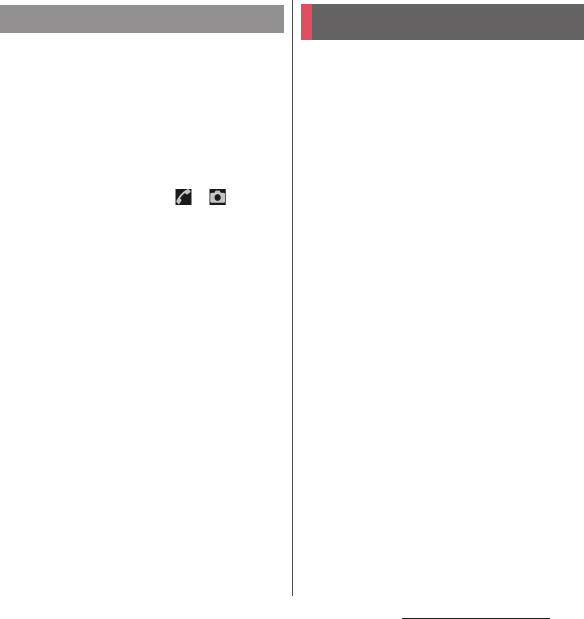
43
Before Using the Terminal
The lock screen appears when you turn the
power on or press
O
to exit sleep mode.
1
Swipe (or flick) up/left on the lock
screen.
・
Alternatively, touch
O
to cancel the
screen lock.
❖
Information
・
On the lock screen, swipe (flick) or to use the
phone or the camera.
・
You can change screen unlock method (P.181).
・
Once you register your fingerprint in the Fingerprint
Manager, you can use fingerprint authentication to
unlock the screen (P.182).
When you first turn on the power and "
ようこ
そ
(Welcome)" is displayed, follow the
onscreen instructions to make initial settings,
such as individual functions and services.
1
[GET STARTED].
・
Tap [
日本語
(Japanese)] to change the
language.
・
Tap [VISUAL AIDS] to make settings
related to the accessibility functions.
・
Follow the onscreen instructions to
make the following settings.
- Important information setting
- Selecting the setup method
- Setting the network connection
- Set your Google account
- Setting the unlock method with
fingerprint
- Setting the Google services
- Setting the Google apps
-Xperia
™
services setting
- Setting the Xperia Intelligence
engine
™
- Home application setting
Canceling the screen lock
Initial settings

44
Before Using the Terminal
2
When the initial settings screen for
docomo services appears, mark
"Agree to all"
u
[NEXT].
・
Follow the onscreen instructions to
make the following settings.
- d ACCOUNT settings
- docomo cloud settings
- Install all apps setting
- "Anything else?" settings
3
When the setup completion screen
appears, [FINISH].
❖
Information
・
The displayed setting items may differ depending on
operation of the terminal.
・
Some settings can be changed later (P.71, P.159,
P.181, P.182, P.186, P.187, P.190, P.191, P.193, P.194).
・
Make sure that the data connection is available (LTE/
3G/GPRS) or the terminal is connected to a Wi-Fi
network before setting up online services (P.50).
・
You can use the terminal without setting your
Google account, however the Google services such
as Gmail, Google Play, etc. are not available.
Precautions on using touch screen
・
Touch screen is designed for being touched
lightly with fingers. Do not push the touch
screen hard with a finger or press sharp
objects (nail, ballpoint pen, pin, etc.) against
the screen.
・
Touching the touch screen may not work in
the following cases. Note that it may cause
malfunction.
- Operation with tip of fingernail
- Operation with foreign object on the screen
- Operation with protective sheet or seal on
the screen
- Operation on the wet touch screen
- Operation with fingers wet with sweat or
water
- Operation under water
Operations on the touch screen
■
Tap
Touch an item such as icon or menu with
your finger lightly and release it.
・
Double-tap means tapping twice quickly.
■
Touch and hold
Touch and hold an icon or menu item long.
Basic operations
Using the touch screen
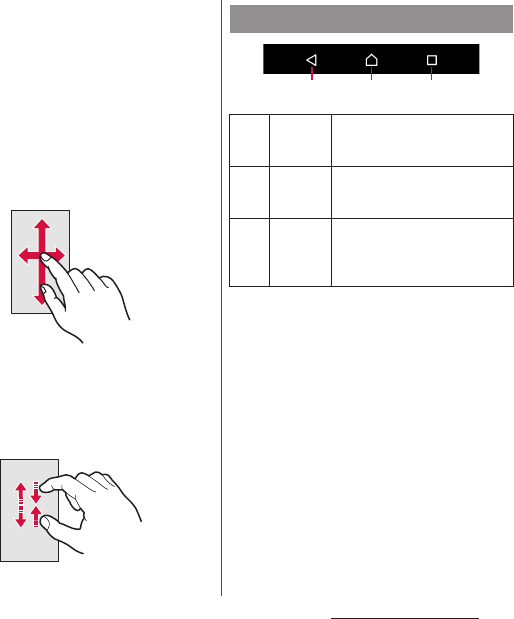
45
Before Using the Terminal
■
Swipe (Flick)
Touch the screen and flick up/down or left/
right.
■
Drag
Touch the screen, drag to the desired
position and release the finger.
■
Scroll
When whole content cannot be displayed,
flick up/down/left/right displayed content
to scroll (move) the display position.
■
Pinch
Touch the screen with two fingers and
widen (pinch-out) or narrow (pinch-in) the
fingers' distance. On some screens, pinch-
out to zoom in and pinch-in to zoom out.
* In this manual, each key icon operation is described
with
b
,
h
, and
n
.
Basic key icon operation
b
Back Go back to the previous screen. Or
close a dialog box, an option
menu, the Notification panel, etc.
h
Home Go to the Home screen.
Touch and hold the icon to open
the "Google" application.
n
Task Display thumbnails of recently
used applications. You can
activate or quit them here (P.70).
You can use the split screen (P.70).
b h n
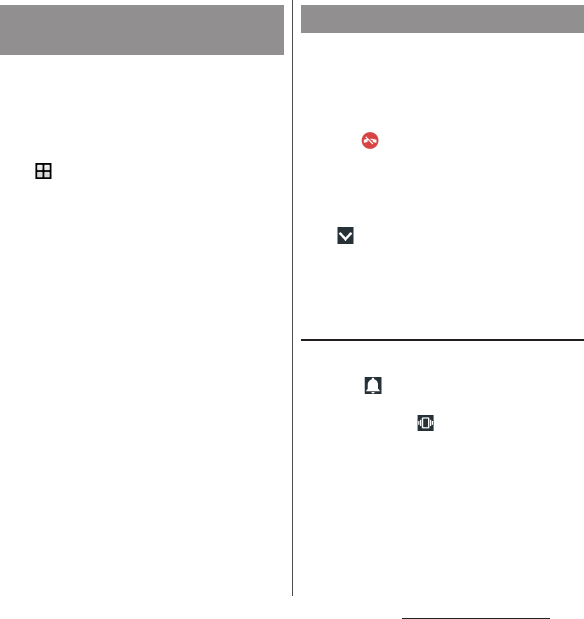
46
Before Using the Terminal
You can set the screen orientation to switch
between landscape and portrait view
automatically according to the terminal
orientation.
1
From the Home screen,
u
[Settings]
u
[Display].
2
[When device is rotated].
3
[Rotate the contents of the screen].
・
Select "Stay in portrait view" to lock the
screen in portrait orientation.
❖
Information
・
Some displayed screens are fixed in portrait
orientation or landscape orientation.
・
Changing orientation of the terminal in nearly
horizontal state against the ground does not switch
to portrait view/landscape view automatically.
・
Even when silent mode is on, the following
sounds are not muted: the shutter sound; the
sounds produced when starting and ending
video recording; alarms; sounds from video
and music; and the sound produced when
you tap during a call.
・
Silent mode is canceled when you press the
volume up key to increase volume or when
you adjust the "Ring volume" (P.173) in
"Sound" while Silent mode (Vibrate) is set.
・
Tap on the volume control bar to adjust
the volume for media playback and alarms.
However the alarm volume set via the "Clock"
application has precedence.
Setting silent mode (Vibrate)
1
Press the volume up or down key.
2
Tap .
・
The icon in the volume control bar
changes to (white).
Switching portrait or landscape
view automatically
Setting silent mode
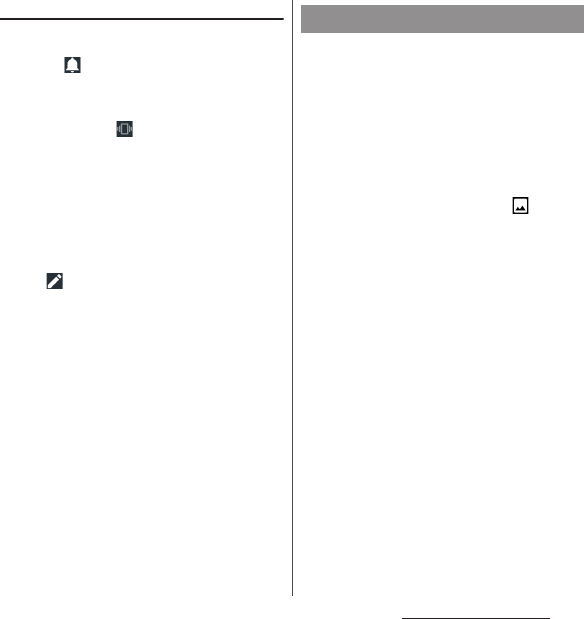
47
Before Using the Terminal
Setting silent mode (Mute)
1
Press the volume up or down key.
2
Tap .
3
Press the volume down key.
・
The icon in the volume control bar
changes to (gray).
・
Tap [END NOW] on the volume control
bar to cancel silent mode (mute).
・
Silent mode (mute) can also be set by
selecting the "Alarms only" or "Total
silence" of the Do not disturb function
in the Quick settings panel (P.54). Before
using the Do not disturb function, tap
and set "Do not disturb" to the
available quick setting tool.
You can capture the currently displayed
screen as a still image (Take screenshot).
・
For some applications, the capturing of the
screenshot is not available.
1
On the screen to capture, press
and hold
O
and the volume
down key at the same time for at
least 1 second.
・
The still image is saved and appears
on the status bar.
❖
Information
・
Alternatively, press and hold
O
for at least 1
second
u
Tap [Take screenshot] to capture a
screenshot.
・
Drag the status bar downwards
u
Tap [Screenshot
captured.] to view the captured image in the
"Album", "Photos", or "Sketch" application. Also, open
the notification of "Screenshot captured" (P.53) and
tap [SHARE] to send the image or tap [DELETE] to
delete the image.
Capturing the displayed screen
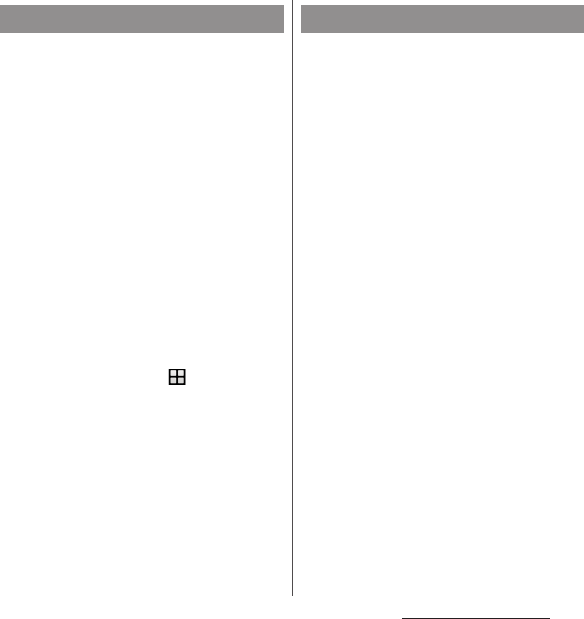
48
Before Using the Terminal
In case of emergency such as disaster, restrict
functions to save the battery power.
1
Press and hold
O
for at least 1
second.
2
[Emergency mode]
u
Confirm
"IMPORTANT INFORMATION"
u
Mark "I have read the important
information"
u
[TURN ON].
・
All running applications end and the
terminal restarts.
❖
Information
・
To cancel emergency mode, press and hold
O
for
at least 1 second
u
Tap [Emergency mode]
u
[TURN
OFF], or drag the status bar down
u
Tap [Emergency
mode is on]
u
[TURN OFF]. Emergency mode is
canceled and the terminal restarts.
・
For details on available applications in emergency
mode, from the Home screen,
u
[Settings]
u
[Battery]
u
[Emergency mode]
u
[IMPORTANT
INFORMATION]
u
Tap [Available apps] to see the
information.
・
If you set/cancel the emergency mode, you may
need to reconfigure widgets etc. on the Home
screen.
If you have more than one application
available when sending an email or
displaying an image, an application selection
screen appears.
<Example> Selecting an application to send an
email from the phonebook
1
From the Home screen, [
ドコモクラ
ウド
(docomo cloud)]
u
[docomo
phonebook]
u
Tap "Contacts" tab
u
Select a contact.
2
Select an email address.
・
An application selection screen
appears.
3
Select an application
u
[JUST
ONCE]/[ALWAYS].
・
Select "JUST ONCE" to view available
applications each time, or "ALWAYS" to
use the same application all the time. If
you select "ALWAYS", an application
selection screen does not appear the
next time you perform the same task.
・
If you previously selected "JUST ONCE"
for an application, then a screen with
that application selected appears when
you perform the same task. Select
another application in the "Use a
different app" area as needed.
Setting Emergency mode Selecting an application to use
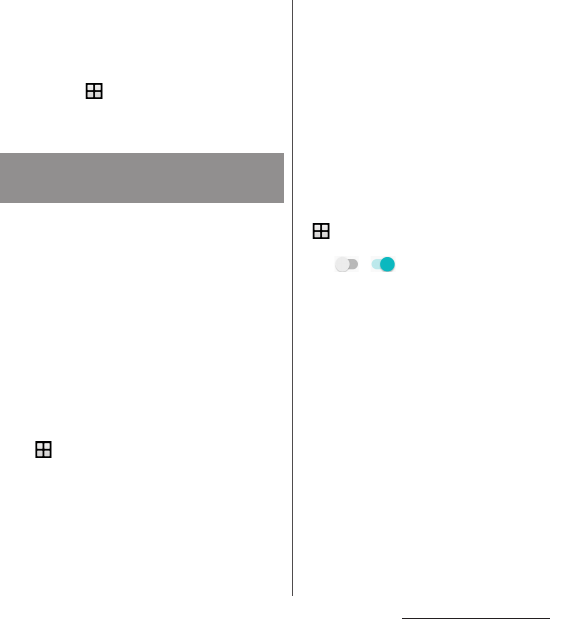
49
Before Using the Terminal
❖
Information
・
Some tasks may require you to select an application
each time, with "JUST ONCE" or "ALWAYS" not
displayed on an application selection screen.
・
To deselect the application set to "ALWAYS", from the
Home screen,
u
[Settings]
u
[Apps]
u
Tap the
application you want to deselect
u
[Open by default]
u
[CLEAR DEFAULTS].
The first time you launch an application or
function that accesses other functions and
information on your terminal, the
confirmation screens requesting permissions
of the access rights appear.
When you approve these access rights, the
corresponding functions and information
become available to the application/
function.
<Example> If launching the "Music" application
for the first time
1
From the Home screen,
u
[Music].
・
A confirmation screen appears.
・
When a screen that describes the
permissions appears, follow the
onscreen instructions.
2
[DENY]/[ALLOW].
・
Depending on the application/
function, multiple confirmation screens
may appear or the display may be
different. Check the displayed contents
carefully and follow the onscreen
instructions.
❖
Information
・
If the permission is not granted, some applications/
functions may not work, or use of the functions may
be limited.
・
To change the permissions, from the Home screen,
u
[Settings]
u
[Apps]
u
Tap the application whose
permissions you want to change
u
[Permissions]
u
Tap / for the item you want to change.
Setting an application's
permissions
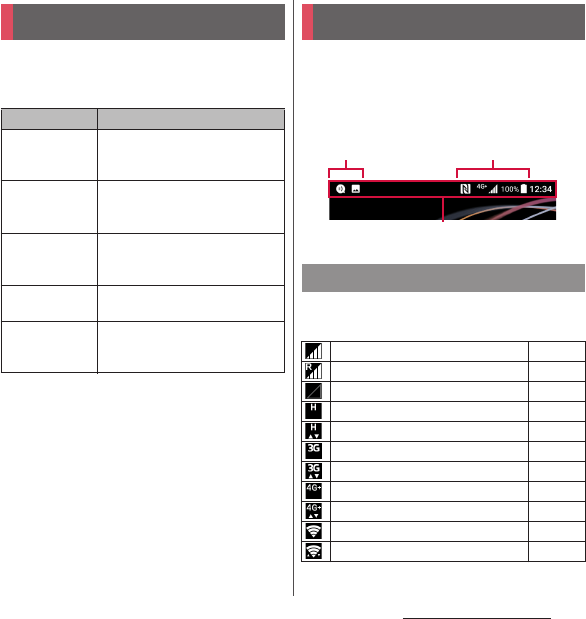
50
Before Using the Terminal
Notification LED provides information on the
terminal status, incoming calls, mail
reception, etc.
* The screen backlight blinks when the backlight is off.
❖
Information
・
If the notification LED flashes multiple times when
you press
O
with the terminal powered off, the
battery is running low.
・
When charging starts with the power off, notification
LED turns on in red first.
A status bar appears at the top of the screen.
In the status bar, the terminal status and
notification are displayed. Notification icons
appear on the left side, and status icons
appear on the right side of the status bar.
The main status icons displayed on the status
bar are as follows.
Notification LED
LED status Indication
Red
Indicate that the battery level is
14% or less while the battery is
being charged
Orange
Indicate that the battery level is
15% - 89% while the battery is
being charged
Green
Indicate that the battery level is
90% or more while the battery is
being charged
Flashing red
Indicate that the battery level is
14% or less
Flashing white
*
Indicate missed calls, new
messages (SMS), or new Gmails
exist
Status bar
Status icon
Signal strength
―
International roaming enabled
―
Out of service
―
HSPA available
―
Communicating in HSPA
―
3G available
―
Communicating with 3G
―
4G (LTE) available
*1
―
Communicating with 4G (LTE)
*1
―
Connected to Wi-Fi P.159
Communicating in Wi-Fi P.159
Status bar
Notication icon Status icon
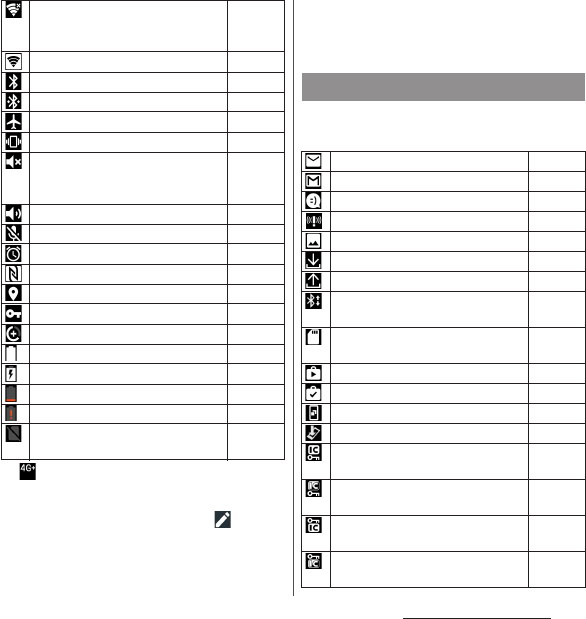
51
Before Using the Terminal
*1 is always displayed when the terminal is
connected with LTE.
*2 Can be set with the quick setting tool in the Quick
settings panel (P.54). Before using, tap and set
"Do not disturb" to the available quick setting tool.
❖
Information
・
You can select icons to be displayed in the status bar
in "System icons" (P.169).
The main notification icons displayed on the
status bar are as follows.
Connected to a Wi-Fi network with
no access to the Internet. The Wi-Fi
signal is poor.
P. 1 5 9
Portable hotspot (Wi-Fi tethering) ON P.164
Bluetooth function ON P.197
Connected to Bluetooth device P.198
Airplane mode activated P.163
Silent mode (Vibrate) ON P.46
Silent mode (mute) is set/Do not
disturb function
*2
is set to [Alarms
only] or [Total silence]
P. 4 7
Speakerphone ON P.93
Microphone put on mute P.93
Alarm is set P.153
NFC Reader/Writer, P2P function ON P.200
Positioning with GPS
―
Connected to VPN P.166
Data Saver is set P.162
Battery status
―
The battery is charging P.36
Battery is low
―
Charging is required
―
docomo nano UIM card is not
inserted
P. 3 1
Notification icon
New email message P.111
New Gmail message
―
New message (SMS) P.108
New Area Mail P.115
Screenshot saved P.47
Receiving/downloading data
―
Sending/uploading data
―
Notification of data reception etc. via
Bluetooth communication
P. 1 9 9
microSD card is detected/currently
mounted
P. 3 5
Update notification
―
Installation completed P.121
Application update notification
―
Software update notification P.226
NFC / Osaifu-Keitai lock set on the
terminal and docomo nano UIM card
P. 1 2 4
NFC / Osaifu-Keitai lock set on the
terminal or docomo nano UIM card
P. 1 2 4
Omakase Lock set on the terminal
and docomo nano UIM card
―
Omakase Lock set on the terminal or
docomo nano UIM card
―
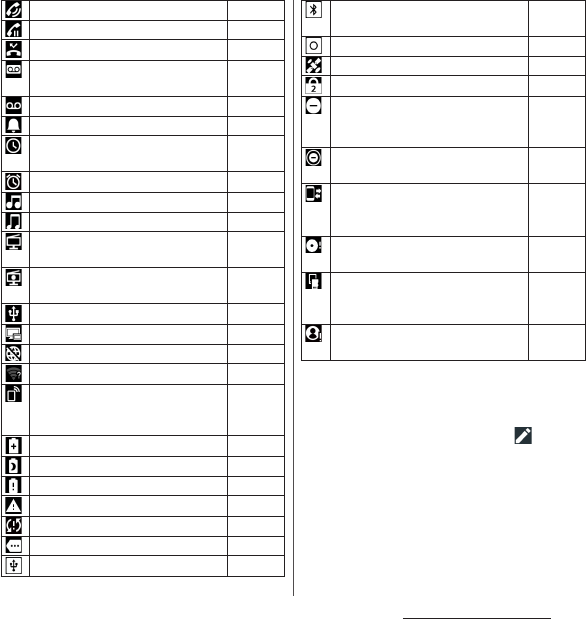
52
Before Using the Terminal
*1 Appears when switched to the Home screen etc.
*2 Appeared while using a speakerphone or
earphones with Do not disturb function is enabled.
*3 Can be set with the quick setting tool in the Quick
settings panel (P.54). Before using, tap and set
"Do not disturb" to the available quick setting tool.
Call is incoming/dialing/during a call
―
Call is on hold P.94
Missed call P.96
Message is recorded in Answering
Machine
P.91, P.96
New voice mail
―
Event notification for Schedule P.152
Stopwatch is running/Timer is in use P.153,
P. 1 5 4
Alarm is in snooze mode or sounding P.153
Playing a track with Media Player P.147
Playing a truck in Music
―
Watching TV
*1
/Notification of
reserved watching
P. 1 2 9
Recording TV
*1
/Notification of
reserved recording
P. 1 3 2
USB device is connected P.176
Screen mirroring connected P.163
Mobile data communication invalid P.162
Wi-Fi open network available P.160
The terminal set as media server/
connection request notification
received
P. 2 0 3
STAMINA
®
mode ON P.177
Charging with Battery Care P.37
Battery is low (15% or less)
―
Error message/caution message
―
Problem with sync
―
Some notifications are hidden
―
USB tethering ON P.164
Bluetooth tethering is ON and
Bluetooth device is connected
P. 1 6 5
2 or more tethering functions ON
―
AUTO-GPS is set P.186
Omakase Lock is set
―
Silent mode (mute) is set/Calling
*2
/
Do not disturb function
*3
is set to
"Alarms only" or "Priority only"
P. 4 7
Do not disturb function
*3
is set to
"Total silence"
―
Backing up/Restoring with docomo
Data Copy/Periodical backing up is
complete
P. 1 5 4
Available internal storage is getting
low
―
Notification of data transfer to
microSD card exists (decrease of
available internal storage)
―
Authentication failed when you set
up your d ACCOUNT
P. 1 8 6
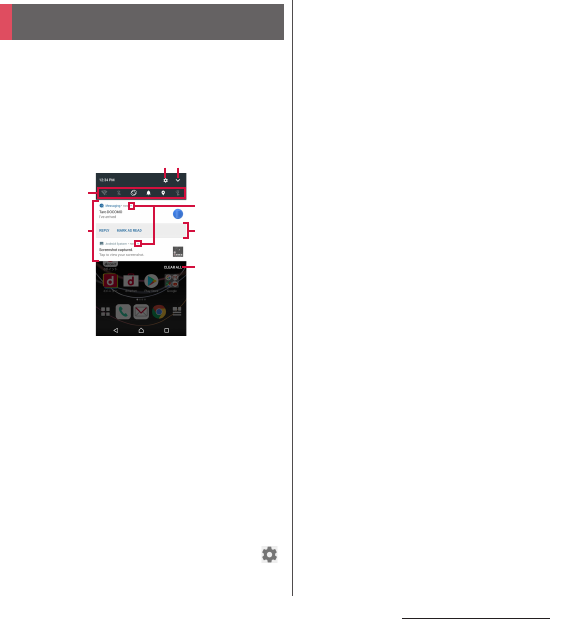
53
Before Using the Terminal
When notification icons appear on the status
bar, you can open the Notification panel to
check the notifications, activate
corresponding application, etc.
1
Drag the status bar downwards.
a
Settings
・
Display the Settings menu (P.158).
b
Open the Quick settings panel
・
Open the Quick settings panel (P.54).
c
Quick setting tools
・
A part of the quick setting tools (P.54) are
displayed.
・
Tap to set ON/OFF of the function.
d
Notifications
・
Flick left or right the notification to clear from the
list. However, some notifications may not be
cleared.
・
To change the notification setting, drag the
notification left or right and tap the displayed ,
or touch and hold the notification.
e
Open/Close the notification
・
Open the notification to fully display the content
or operation menu.
・
If the icon may not be displayed, the notification
may be opened by dragging the notification
down or pinching (P.45) on the notification.
・
Some notifications may not be displayed or
opened by tapping.
f
Operation menu
・
The operation menu such as "CALL BACK" or
"DELETE" may be displayed when it is opened.
・
For some notifications, replying the message
(SMS) from the Notification panel by tapping the
item of the operation menu may be available.
g
Clear
・
Clear contents on the Notification panel. Some
notifications may not be cleared.
❖
Information
・
To close the Notification panel, tap
b
or drag the
panel up.
・
Even when the notification icon is not displayed on
the status bar, the notification indicating the terminal
status may be displayed.
・
You can also swipe (or flick) down the screen on the
lock screen to display the Notification panel and
check the notifications (You do not need to operate
the terminal to see new notifications or a part of
notifications that are received after the lock screen is
set). You can set to hide notifications on the lock
screen (P.171) or to show them all the time (P.171).
Notification panel
d
c
f
g
e
ba
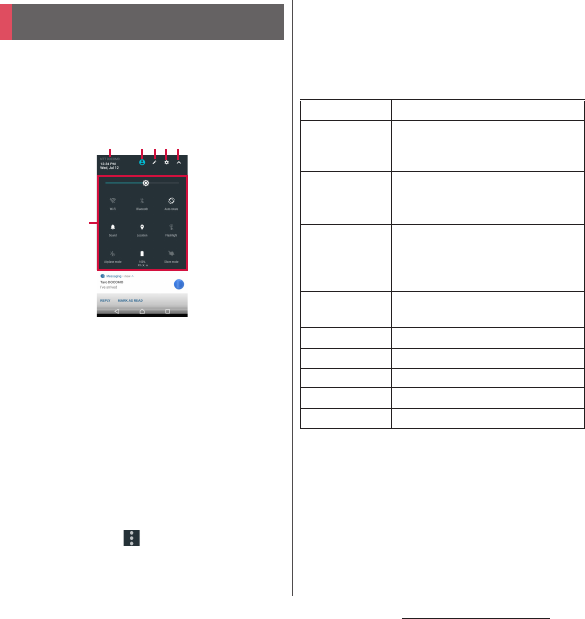
54
Before Using the Terminal
You can open the quick settings panel to
enable or disable functions.
1
Drag the status bar downwards
with two fingers.
a
Name of network operator
b
Users
・
Add or switch a guest/user who use the terminal,
or delete a guest.
・
Tap [MORE SETTINGS] to display "Users" in the
Settings menu (P.185).
c
EDIT
・
Display the edit screen to add, delete or rearrange
the quick setting tools.
・
When the icon indicating the number of pages
and the current page appears below the quick
setting tools, flick the quick setting tools left or
right to switch the page.
・
In the edit screen,
u
[Reset] to restore to the
default.
d
Settings
・
Display the Settings menu (P.158).
e
Close the Quick settings panel
・
Close the Quick settings panel and display the
Notification panel.
f
Quick settings
* In the Quick settings panel, the remaining battery
and remaining standby time (estimate) are displayed.
Quick settings panel
f
a decb
Brightness level
Adjust the screen brightness.
Wi-Fi
Set ON/OFF of Wi-Fi function, or
scan Wi-Fi networks and connect a
Wi-Fi network.
Bluetooth
Set ON/OFF of Bluetooth function,
or scan the paired Bluetooth devices
to connect.
Auto-rotate
Set whether to switch portrait/
landscape view automatically
according to the terminal
orientation.
Sound
Enable sound, silent mode (Vibrate),
or silent mode (Mute).
Location
Enable/disable location information.
Flashlight
Set ON/OFF of the flash/photo light.
Airplane mode
Enable/disable Airplane mode.
Battery
*
Set ON/OFF of STAMINA mode.
Glove mode
Enable/disable Glove mode.
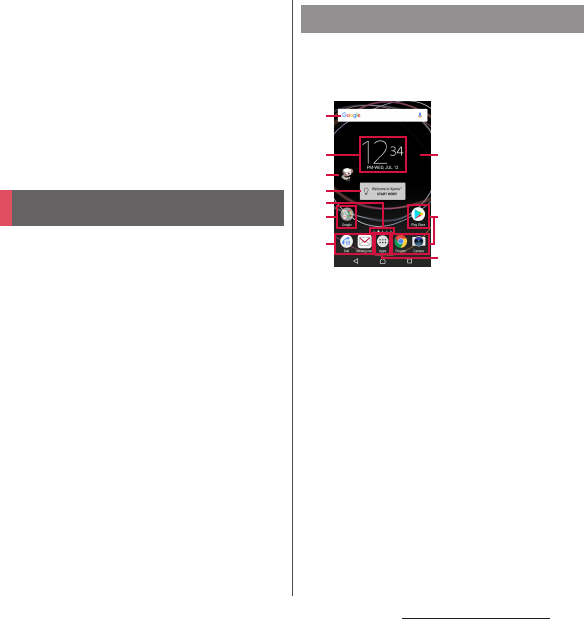
55
Before Using the Terminal
❖
Information
・
Touch and hold the quick setting tool to display each
setting screen.
・
The quick setting tool may be automatically added
depending on the operation of the terminal.
・
You can also open the Quick settings panel by
dragging down the Notification panel or dragging
down the status bar on the lock screen.
・
To close the Quick settings panel, tap
b
or drag
the panel up.
You can switch the Home screen of the
terminal to "docomo LIVE UX", "Xperia
™
Home" or "Simple Home".
・
"docomo LIVE UX" (P.80)
・
"Simple Home" (P.59)
・
Switching home applications (P.71)
This section describes the Home screen
displayed when the home application is set
to "Xperia
™
Home".
a
Widget : Google Search
b
Widget : Clock
c
Machi-chara
d
Widget : Introduction to Xperia
™
e
Current page
・
Display the number of home screens and current
home screen position. Flick the Home screen left
or right to switch the pages.
・
When "Google Now
™
" (P.58) is set to ON, "G" is
displayed in the leftmost position.
f
Folder
・
This folder contains application icons and other
items.
g
Shortcuts (applications)
h
Wallpaper
i
Apps button
・
When you tap, if a confirmation screen regarding
data collection that aids the provision of
recommended app information is displayed,
follow the onscreen instructions.
Home screen
Xperia
™
Home screen
a
b
c
d
e
g
i
g
h
f
©NTT DOCOMO
"ひつじのしつじくん®
(Butler Sheep)"

56
Before Using the Terminal
❖
Information
・
You can add widgets and shortcuts, change the
wallpaper, and perform other tasks by touching and
holding an area of the Home screen where no icons
are displayed or by pinching in on the Home screen.
・
To change the page of the start screen for
operations, display the page you want to change to
and touch and hold the area of the Home screen
where no icons are displayed
u
Tap displayed in
the upper left of screen. However, when "Google
Now
™
" (P.58) is set to ON, a start screen cannot be
changed.
・
If you swipe (flick) down on an area of the Home
screen where no icons are displayed, the applications
search screen appears.
Adding a home screen
Up to 20 pages can be added.
1
Touch and hold an area of the
Home screen where no icons are
displayed.
2
Flick left or right on the Home
screen
u
Tap .
❖
Information
・
To return to the Home screen, tap
h
or
b
, or
tap any home screen.
・
To delete a home screen, switch to the home screen
and then touch and hold the area of the home
screen where no icons are displayed
u
Tap
displayed in the upper right of screen.
・
When "Google Now
™
" (P.58) is set to ON, up to 20
pages and Google Now screen can be added.
However, new pages cannot be located at the left of
Google Now screen.
Adding a widget to the Home screen
Widget is an application which can be added
to the Home screen to use. Use a widget to
start an application easily.
1
Touch and hold an area of the
Home screen where no icons are
displayed.
2
[Widgets]
u
Select the widget.
・
If a settings screen etc. appears, follow
the onscreen instructions.
❖
Information
・
To return to the Home screen, tap
h
, or tap any
home screen.
・
If a frame is displayed around the added widget, you
can drag the frame to resize the widget.
・
To remove a widget, on the Home screen, touch and
hold the widget
u
Drag it to "Remove from home
screen" which appears at the top of the screen.

57
Before Using the Terminal
Adding a shortcut to the Home screen
You can add shortcuts of contact, etc. to the
Home screen.
1
Touch and hold an area of the
Home screen where no icons are
displayed.
2
[Widgets]
u
[Shortcuts].
3
Select the shortcut.
・
When a data selection screen or setting
screen appears, follow the onscreen
instructions.
❖
Information
・
To return to the Home screen, tap
h
, or tap any
home screen.
・
To remove a shortcut, on the Home screen, touch
and hold the shortcut
u
Drag it to "Remove from
home screen" which appears at the top of the screen.
Adding folders on the Home screen
You can put shortcuts, etc. added to the
Home screen into a folder to manage them.
1
From the Home screen, touch and
hold an icon
u
Drag it over another
icon.
❖
Information
・
To move an icon into a folder, touch and hold the
icon on the Home screen
u
Drag it over the folder.
・
To change a folder name, tap a folder
u
Tap the folder
name
u
Enter a folder name
u
Tap [DONE].
・
To delete a folder, touch and hold the folder on the
Home screen
u
Drag it to "Remove from home
screen" which appears at the top of the screen
u
Tap
[DELETE]. Shortcuts, etc. in the folder are also deleted.
Changing wallpaper
You can change the wallpaper of the Home
screen and the lock screen.
1
Touch and hold an area of the
Home screen where no icons are
displayed.
2
[Wallpapers].
3
Tap [Album]/[Live Wallpapers]/
[Photos]/your desired image.
・
If you tap any of [Album], [Live
Wallpapers], or [Photos], select an
image and follow the onscreen
instructions to set the wallpaper.
❖
Information
・
To return to the Home screen, tap
h
, or tap any
home screen.
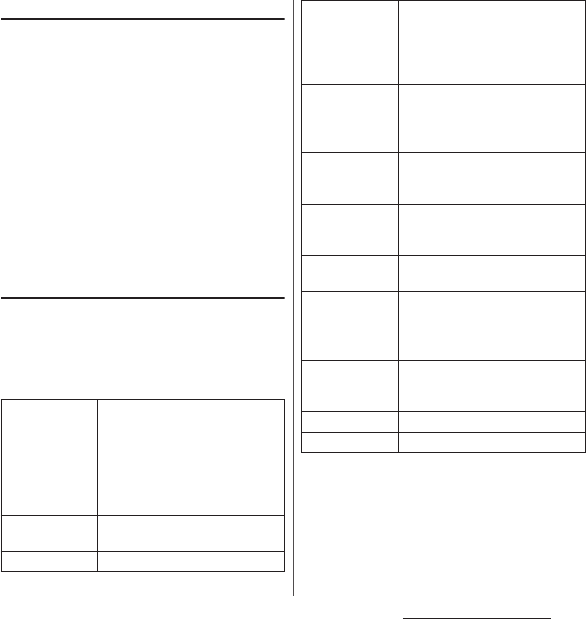
58
Before Using the Terminal
Changing theme
You can change themes for the Home screen,
wallpaper of the lock screen, etc.
1
Touch and hold an area of the
Home screen where no icons are
displayed.
2
[Themes].
3
Select the theme
u
[APPLY THEME]
u
[OK].
❖
Information
・
Tap [GET MORE THEMES] in Step 3 to download
themes and add.
Setting Home screen
1
Touch and hold an area of the
Home screen where no icons are
displayed.
2
[Settings].
Auto rotation
Set whether to switch the Home
screen or application screen to
portrait/landscape view
automatically according to the
terminal orientation when "When
device is rotated" (P.46) is set to
"Rotate the contents of the screen".
Icon size
Set the size of icons on the Home
and application screens.
Icon appearance
Change the design of the icons.
Show names in
dock
Set whether to display the names
of shortcuts and other items
arranged on the dock at the
bottom of the Home screen (on
either side of Apps button).
Automatically
place icons
together
Set whether to automatically
arrange shortcuts, etc. that are on
the Home screen so that there are
no gaps.
Pane transition
Set the type of transition that
occurs when you switch between
panes of the Home screen.
App
recommendations
Set whether to show app
recommendations on the
applications search screen.
Google Now
™
Set whether to add Google Now
screen to the Home screen.
Add icons to
home screen
Set whether to add a shortcut to
the Home screen simply by
touching and holding an icon on
the application screen.
Icon on home
screen
Set whether to permit addition of
duplicative application shortcuts to
the Home screen.
License
Display the licenses.
Version
Display the app versions.
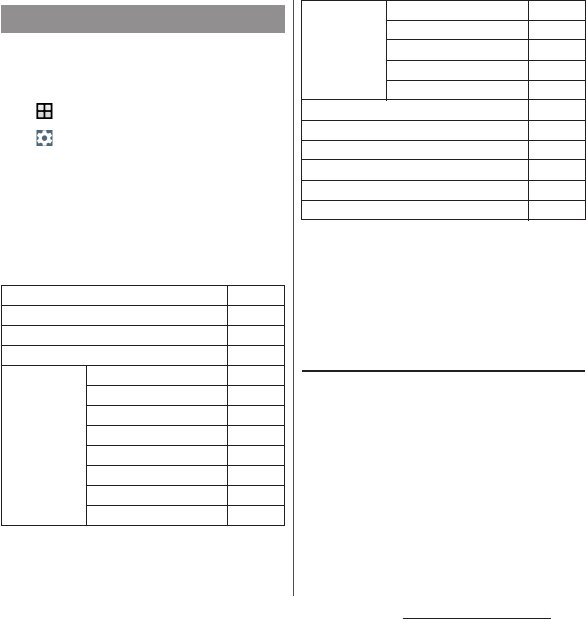
59
Before Using the Terminal
Set Simple Home to use Home screen and
the setting menu limited to basic functions.
1
From the Home screen,
u
[Settings]
u
[Apps].
2u
[Home app]
u
[Simple Home]
u
[OK].
3
[OK].
・
To set the font size to "Largest", mark
"Set font size to Largest".
■
Applications on the Simple Home
screen
* The list of applications such as "Anshin Scan",
"docomo phonebook", etc. is displayed.
❖
Information
・
To change to the standard Home screen, from the
Simple Home screen, tap [Settings]
u
[Exit Simple
Home]
u
[OK]
u
[docomo LIVE UX]/[Xperia
™
Home].
Using speed dials
Save frequently used contacts to "Speed dial"
to easily make a call or send a message.
■
Saving contacts
Save phone numbers and mail addresses to
"Contacts" beforehand.
1
On the Simple Home screen,
[Speed dial]
u
[OK].
Simple Home screen
Maps
P. 1 5 0
Chrome
P. 1 1 7
Settings
P. 6 0
My Apps
P. 6 1
Tools Contacts
P. 6 5
Calendar
P. 6 3
Clock
P. 1 5 3
Calculator
P. 6 4
Gmail
P. 1 1 4
Play Store
P. 1 2 1
d
メニュー
(dmenu)
P. 1 2 0
d POINT
P. 6 5
Media Music
P. 6 5
Album
P. 1 4 5
Video
P. 6 5
TV
P. 1 2 7
YouTube
P. 6 7
Camera
P. 1 3 3
docomo mail
P. 1 0 7
Messaging
P. 1 0 7
Dial
P. 6 3
Apps
*
―
Speed dial
P. 5 9
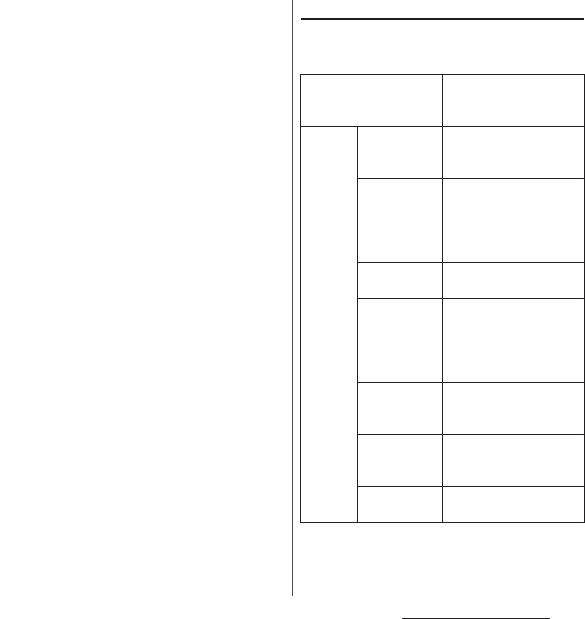
60
Before Using the Terminal
2
Select a contact to save.
・
The name "Speed dial" on the Simple
Home screen will change to the name
saved in the "Contacts" application.
■
Making a call
1
On the Simple Home screen, select
a speed dial
u
[Call].
・
Operation during a call (P.93)
■
Sending messages (SMS)/mail
1
On the Simple Home screen, select
a speed dial
u
[Send message]/
[Send email].
・
How to send a message (SMS) (P.107)
・
How to send email (P.111)
・
How to send Gmail (P.114)
❖
Information
・
To change/delete/edit contacts saved in the speed
dials, from the Simple home screen, select a contact
saved in the speed dial
u
[MENU]
u
Tap any of [Edit
entry]/[Delete entry]/[Edit contact].
Using Settings
1
On the Simple Home screen,
[Settings].
My profile
Check your own phone
number and mail address,
etc.
Display Wallpaper
Set the wallpaper for the
Simple Home screen or
the lock screen.
Themes
Set the theme for the
wallpaper of Simple
Home screen or the lock
screen, or download
themes.
Brightness
Adjust the screen
brightness.
Auto-rotate
screen
Set whether to switch
portrait/landscape view
automatically according
to the terminal
orientation.
Font size
Set font size for the
"Contacts" application,
etc.
Sleep
Select a time duration
before the screen back
light turns off.
Screen lock
Set screen unlock
method.

61
Before Using the Terminal
Saving applications in My Apps
If frequently used applications, etc. are saved
in the "My Apps" folder, the applications can
easily be activated.
1
On the Simple Home screen, [My
Apps]
u
[EDIT]
u
[OK].
2
Mark applications to save
u
[DONE].
❖
Information
・
To delete applications saved in the "My Apps" folder,
in Step 2, unmark applications
u
Tap [DONE].
Changing applications on the Simple
Home screen
1
On the Simple Home screen,
[Settings]
u
[Customize Home].
2
[Change apps]/[Reorder apps].
3
Select the application
u
Select the
application to display/select the
location to move to.
・
Grayout applications cannot be
changed.
4
[OK].
❖
Information
・
In Step 2, tap [Reset]
u
[OK] to restore the defaults.
Note that contacts saved in the speed dials and
applications saved in "My Apps" folder are not
restored.
Sound Silent/Vibrate
mode
Set silent mode.
Ringtone
Set ringtone.
Vibrate on
touch
Set whether to vibrate the
terminal for some
operations such as
specified software key
operation.
Touch sounds
Set whether to emit
sound when selecting
menu.
Vibrate when
ringing
Set whether to vibrate the
terminal when receiving a
call.
Customize
Home
Change apps
P. 6 1
Reorder apps
Reset
More settings
Display Settings menu on
the standard Home screen
(P.158).
Exit Simple Home
Change to the standard
Home screen.
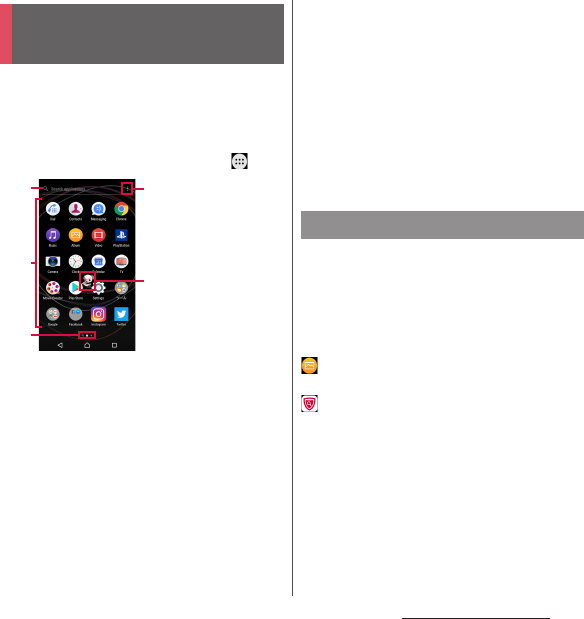
62
Before Using the Terminal
This section describes the application screen
displayed when the home application is set
to "Xperia
™
Home".
・
Switching Home application (P.71)
1
From the Home screen, tap .
a
Application search bar
・
Tap to display the application search screen and
search for applications.
・
The application search screen can also be
accessed by flicking to the right on the first page
of the Application screen.
b
Application icon list
・
Some application icons are displayed with a
number of missed calls, unread mails, etc.
c
Current displayed position
・
Display the number of pages and current screen
position. Flick the application screen left or right
to switch sheets.
・
The leftmost sheet is the application search
screen.
d
Option menu
・
This menu allows you to rearrange application
icons and manage applications (for example, by
moving or uninstalling) and to set the Home
screen (P.58).
e
Machi-chara
Applications displayed on the application
screen are as follows.
・
For usage of some applications, separate
subscription (Charged) is required.
・
For some applications, you can check
functions or operation steps from the help.
Album
Play still pictures or videos.
→
P. 1 4 5
Anshin Scan
*1
An application that allows you to use your
smartphone with peace of mind. It detects
viruses, helps you understand which
applications use your personal data, and alerts
you if you are attempting to access potentially
dangerous websites.
Xperia
™
Application
screen
c
a
b
©NTT DOCOMO
"
ひつじのしつじくん®
(Butler Sheep)"
e
d
Application list
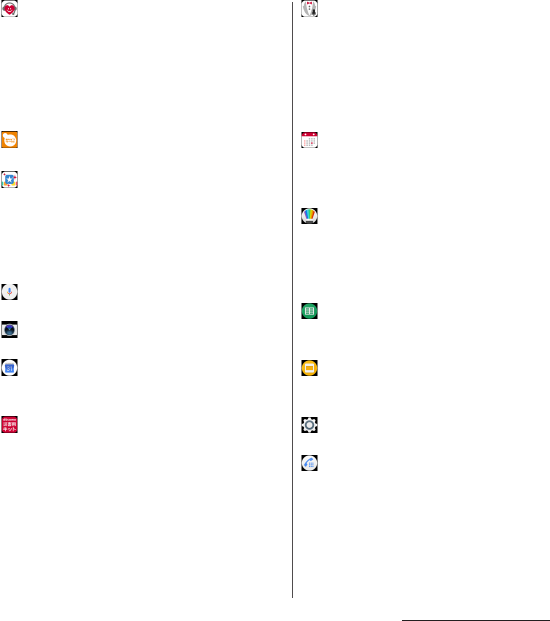
63
Before Using the Terminal
遠隔サポート
(Enkaku support)
An application for using "
あんしん遠隔サポート
(Anshin Enkaku Support)". "
あんしん遠隔サポー
ト
(Anshin Enkaku Support)" is a service that
allows staff of the Call center to support the
terminal operations by remote-checking the
display of your terminal.
→
P.221
Osaifu-Keitai
*2
Use Osaifu-Keitai services.
→
P. 1 2 2
おすすめアプリ
(Recommended apps)
*1
An application that allows you to check
information on app recommendations
provided by DOCOMO, based on your
application usage condition, and to install
those applications.
Voice Search
*3
Use Google Voice Search.
→
P. 7 2
Camera
Shoot photos or videos.
→
P. 1 3 3
Calendar
Register and manage your plans and reminders
etc.
Disaster kit
*1
An application for using Disaster Message
Board, Disaster Voice Messaging Service and
Early Warning "Area Mail" (P.115).
しゃべってコンシェル
(Shabette concier)
*1
Just speak to your "concierge", and he or she
will understand what you want to do. You can
easily check the weather or transfer
information, make phone calls, set an alarm, or
perform other tasks. You can also enjoy
chatting with various characters.
Schedule
*4
An application for creating/managing schedule
whose data is shared with Memo application. It
supports i-concier service.
→
P.152
Sketch
*2
An application that allows you to create
drawings or illustrations by touching the screen
or to import photos and modify them. Also,
publish created sketches or share the sketches.
Sheets
*3
Create, edit and share spreadsheets, as well as
view, edit and save Excel files.
Slides
*3
Create, edit and share slide show presentations,
as well as view, edit and save PowerPoint files.
Settings
Configure settings for the terminal.
→
P.158
Dial
Open the Xperia
™
phone application to make/
receive calls.
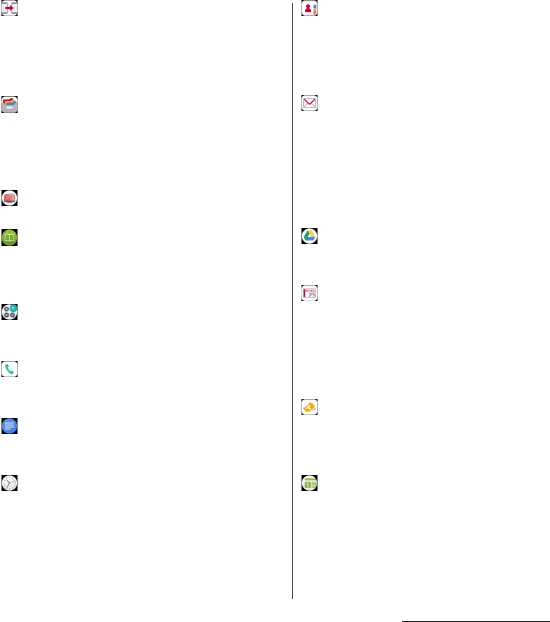
64
Before Using the Terminal
Data Copy
An application that allows you to transfer data
when changing the model, back up to/restore
from a "microSD card" or the "Data Storage BOX
(Cloud)).
→
P. 1 5 4
データ保管
BOX (Data Storage BOX)
*4
An application for using Data Storage BOX.
Data Storage BOX is a service which allows you
to upload files to easily manage them in the
cloud.
TV
Watch TV programs.
→
P. 1 2 7
電子書籍
Reader by Sony (e-books Reader
by Sony)
*5
Purchase books or other content at the "Reader
Store", Sony's eBooks store.
Calculator
*2
Perform basic arithmetic operations and other
various calculations.
Phone
*1
An application for using phone features and
configuring call settings.
→
P. 8 8
Docs
*3
Create, edit and share documents, as well as
view, edit and save Word files.
Clock
Use alarm, world clock, stop watch and timer.
→
P. 1 5 3
docomo phonebook
*4
A phonebook application provided by
DOCOMO. It allows you to manage your
docomo account's phonebook data in the
cloud.
→
P. 1 0 2
docomo mail
*4
Send/receive mails using DOCOMO mail
address (@docomo.ne.jp).
Your d ACCOUNT allows you to use the same
email address to send, receive, and view email
on several devices, such as tablets and
computers.
→
P. 1 0 7
Drive
*3
View/manage/share files stored in Google
Drive.
Instruction Manual
Display the terminal instruction manual. You
can directly start a function you want to use
from the explanation (in Japanese only).
* See "About manuals of SO-01K" in
"Introduction".
ToruCa
*1
An application for collecting saving coupons/
convenient information from your favorite
shops.
→
P.126
News
*5
Read a collection of the latest news and topics
of interest.
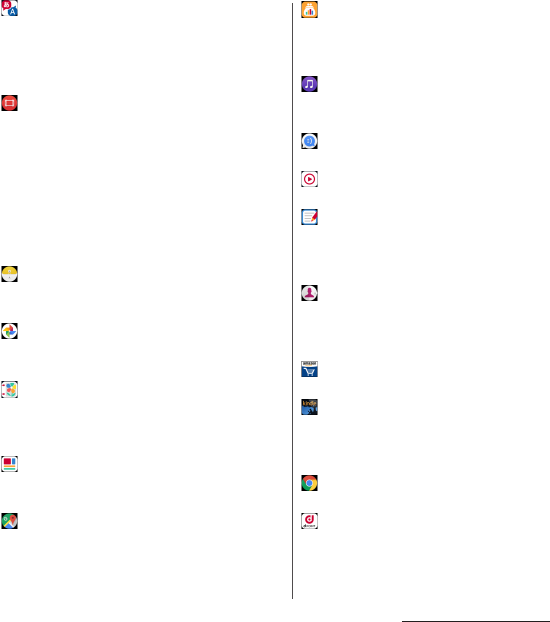
65
Before Using the Terminal
Hanashite Hon'yaku
*1
An application for translating spoken words
into the listener's native language. This allows
you to enjoy talking with people who speak
languages other than your own.
Video
Downloads the "Video & TV SideView"
application. After installation and when
selected, the "Video & TV SideView" application
launches and allows you to play videos saved
to internal storage or a microSD memory card.
In addition, view the TV program guide or use
your terminal as a remote for Sony televisions
or other devices.
File manager
*2
Search for still pictures, videos, music files,
downloaded files, and so on.
→
P. 1 9 5
Photos
*3
Play photos and videos. You can back them up
to your Google account.
フォトコレクション
(Photo collection)
*4
A service for backing up photos or videos up to
5GB to cloud free of charge, then accessing the
backup data from smartphones, tablets or PCs.
My Magazine
*1
A search service for displaying articles in the
category of your choice.
→
P. 8 6
Maps
*3
Use Google Maps services, such as viewing the
current location, finding another location and
searching the routes.
→
P. 1 5 0
マネレコ
(Manereko)
*1
A banking app that allows you to check the
balance of your bank account, details of your
credit card, etc.
Music
Play music files stored on your internal storage
or microSD card.
Messaging
Send and receive messages (SMS).
→
P. 1 0 7
Media Player
*1
Play music and videos.
→
P.147
Memo
*4
An application for creating/managing memos
whose data is shared with Memo application. It
supports i-concier service.
Contacts
Open the Xperia
™
phonebook application to
manage contact information for your friends
and family.
Amazon Shopping
Purchase goods from Amazon.co.jp.
Amazon Kindle
A Kindle e-books reader app for reading books
purchased on Amazon. You can also purchase
e-books from Amazon using this app.
Chrome
Browse web pages in Chrome.
→
P. 1 1 7
d POINT
An application that allows you to check,
accumulate, and use your d POINT.
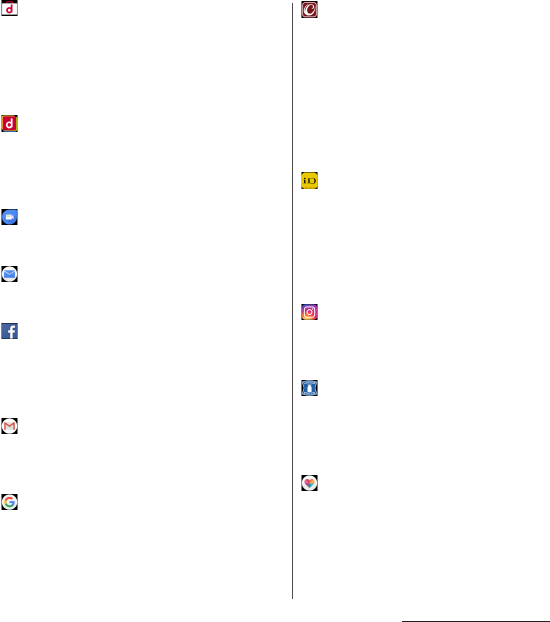
66
Before Using the Terminal
dmarket
dmarket provides a variety of services, offering
digital content, such as music, videos, and
books, and giving you access to a shopping
site, travel booking site, and other e-commerce
sites.
→
P. 1 2 0
d
メニュー
(dmenu)
An application shortcut for "dmenu". In dmenu,
you can easily access sites recommended by
docomo, as well as convenient applications.
→
P. 1 2 0
Duo
*3
An application that allows you to make video
calls.
Email
*2
Send and receive emails. Multiple accounts are
available.
→
P.110
Facebook
*6
Facebook allows you to build closer
relationships with your friends, family,
colleagues, or classmates and to know what is
going on in the world.
Gmail
*3
You can use the email services provided by
Google and major Internet service providers.
→
P. 1 1 4
Google
*3
Search information in the terminal and web
pages by keywords.
→
P. 7 2
iコンシェル
(i-concier)
*1
i-concier is a service that turns your
smartphone into your "butler" or "concierge" to
help you in your daily life.
It provides you with timely and useful
information that fits your schedule, local area,
and current location. For example, you can
obtain information about rain forecasts (with
alarms), train timetables, and tourist spots.
iD
アプリ
(iD application)
An application for using "iD", electronic money
offered by DOCOMO. Once you have set up
"iD" on your Osaifu-Keitai, you can hover the
terminal over an IC card reader at various shops
to make your shopping easier and more
comfortable.
→
P. 1 2 5
Instagram
Freely edit the photos and videos taken with
your terminal and share them easily with
people around the world.
LAWSON
An official application from LAWSON. You can
display your digital membership card on the
phone, search for LAWSON stores, and find
money-saving trial coupons.
Lifelog
*5
Keep track of your daily activities, including
your number of steps and calorie consumption.
This application also records your actions on
the terminal, such as shooting photos and
videos and listening to music.
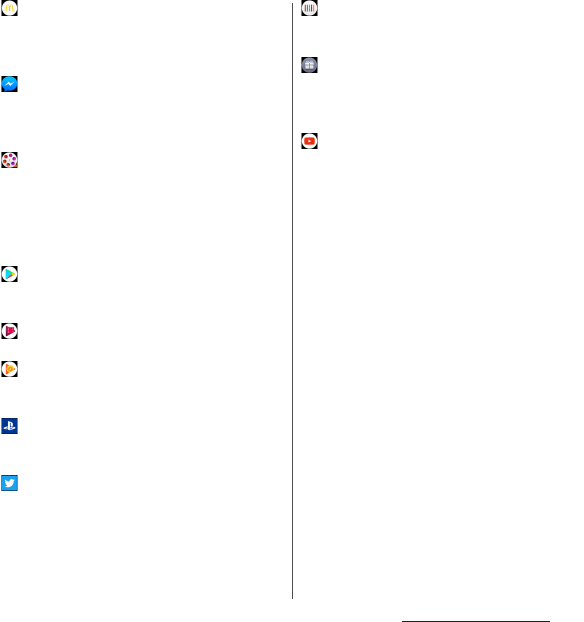
67
Before Using the Terminal
McDonald's
An official application from McDonald's. Get
the latest information and obtain coupons that
can be used in stores.
Messenger
*6
Send messages or make calls or video calls to
the contact of the mobile phone or the friend/
group of Facebook.
Movie Creator
Automatically creates highlight movies from
the pictures and videos you have taken. Select
pictures and videos to manually create a
highlight movie. Save highlight movies as
video files to share them to other people.
Play Store
Download or purchase various applications etc.
from Google Play.
→
P.121
Play Movies & TV
*3
Rent or purchase movies, etc. from Google Play.
Play Music
*3
With Music, you can play, store, and share
music.
PlayStation
Connect your terminal to a PlayStation
™
, and
the terminal will work as a controller.
Twitter
Official Twitter client application. Post a short
message on the website and communicate
with someone else.
What's New
*5
Check the latest information of music, videos
and applications.
Xperia
™
Lounge Japan
*5
An application that provides information about
products and campaigns from Sony Mobile
Communications, Inc.
YouTube
*3
Play YouTube videos.
*1 Stored in the "
ドコモのおすすめ
(DOCOMO's
recommendations)" folder.
*2 Stored in the "
ツール
(Tools)" folder.
*3 Stored in the "Google" folder.
*4 Stored in the "
ドコモクラウド
(docomo
cloud)" folder.
*5 Stored in the "Sony" folder.
*6 Stored in the "Facebook" folder.
❖
Information
・
Some pre-installed applications can be uninstalled.
Even if uninstalled, some applications can be
downloaded from "Play Store" (P.121) etc. again.
・
Some applications require downloading and
installation. If downloading an application is not
available, set to allow to download (P.178).
・
Having multiple applications running can consume
more battery power, resulting in fewer hours of use.
For this reason, it is recommended to quit
applications that you are not using. To quit an
application,
nu
Flick left or right on its
thumbnail.
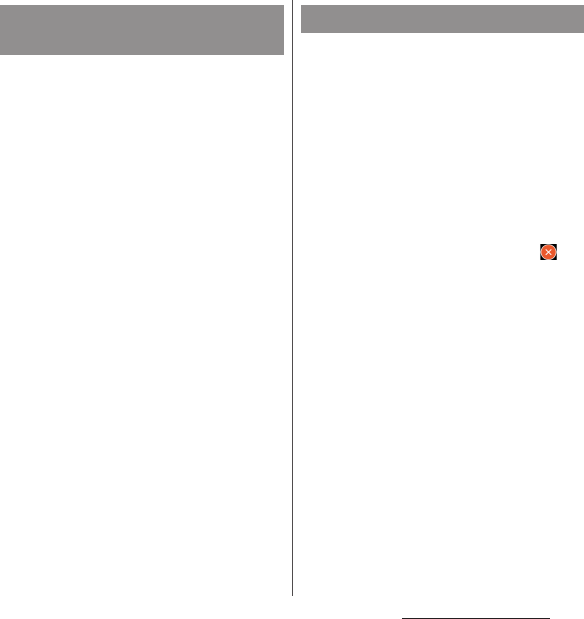
68
Before Using the Terminal
Add shortcuts of application to the Home
screen.
1
On the application screen, touch
and hold the icon to add to the
Home screen.
・
For the application icons in a folder,
drag out from the folder.
・
Touch and hold the folder to add the
folder containing the application
shortcuts to the Home screen.
2
Drag it to "Add to home screen"
displayed at the top of the screen.
・
When the Home screen is displayed,
drag it to a position to locate the
shortcut.
❖
Information
・
When "Add icons to home screen" (P.58) is set to ON,
you can add application shortcuts to the Home
screen just by touching and holding application icon
you want to add in Step 1.
・
When "Icon on home screen" (P.58) is set to ON,
previously added shortcut will be deleted
automatically if application shortcut added to the
Home screen is duplicated.
・
Before uninstalling application, back up
contents related to the application that you
want to save including data saved in the
application.
・
Some applications may not be uninstalled.
1
Touch and hold an area of the
application screen where no icons
are displayed.
・
Tap the folder to uninstall the
application contained to the folder.
2
Tap an application icon with .
3
[OK].
・
When uninstalling application is
unavailable, "DISABLE" is displayed to
disable the application (P.175).
❖
Information
・
Alternatively, pinch-in on the application screen to
operate.
Adding an application to the
Home screen
Uninstalling an application

69
Before Using the Terminal
When the order of application icons is set to
"Own order" in the option menu (P.62), you
can manage your application icons on the
application screen by putting them in folders.
1
On the application screen, touch
and hold an application icon
u
Drag it over another one.
❖
Information
・
To move an icon to a folder, on the application
screen, touch and hold the icon
u
Drag it over a
folder.
・
To take out an application icon from a folder, tap the
folder
u
Touch and hold the application icon
u
Drag it
to a place you want to locate.
・
To change a folder name, tap a folder
u
Tap the folder
name
u
Enter a folder name
u
Tap [DONE].
When the order of application icons is set to
"Own order" in the option menu (P.62), you
can rearrange your application icons as you
like.
1
On the application screen, touch
and hold an icon
u
Drag it to any
position you like.
❖
Information
・
To add a new page of the application screen, while
rearranging the application icons, drag the icon to
the right end of the rightmost page.
・
Automatically sort the icons by selecting the order
"Most used", "By name", or "By date" in the option
menu (P.62).
Adding a folder to the
application screen
Rearranging application icons
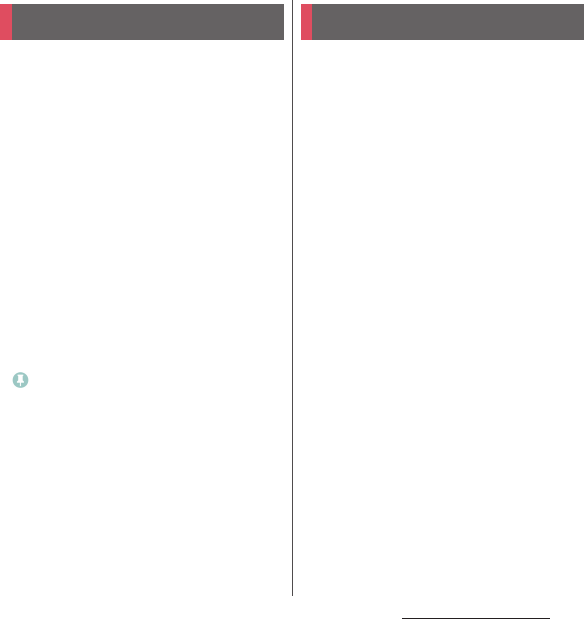
70
Before Using the Terminal
Display recently used applications as
thumbnails to confirm, open, switch
between, or close them.
1n
.
・
Applications are displayed as
thumbnails.
❖
Information
・
Tap a thumbnail to open or switch the application.
Although, depending on the displayed thumbnails,
the application may not accessible.
・
To delete the application thumbnail, flick the
thumbnail left or right or tap [×] displayed at the
upper right of the thumbnail. To clear all thumbnails,
tap [CLEAR ALL] displayed at the upper right of the
screen.
・
Clearing the thumbnail of an application closes the
application.
・
If "Screen pinning" (P.178) is turned on, you will see
on the thumbnail of your most recently opened
application. You can tap it to pin the screen. If a
screen is pinned, you cannot use the applications
other than displayed one. To cancel pinning, follow
the onscreen instructions.
Split the screen in up and down to display
and operate two applications.
・
Activate the application to display
beforehand.
・
If the application does not support the split
screen, it cannot be displayed with this
function.
1n
.
・
Applications are displayed as
thumbnails.
2
Touch and hold the application
thumbnail to display
u
Drag to the
"Drag here to use split screen"
appeared at the top of screen.
・
When "App doesn't support split
screen" appears at the top of the
screen, the application cannot be
displayed in the split screen.
3
Tap the application thumbnail to
display from the lower part of the
screen.
・
If the application thumbnail is not
displayed, tap
h
to activate the
application to display.
Task manager Split screen
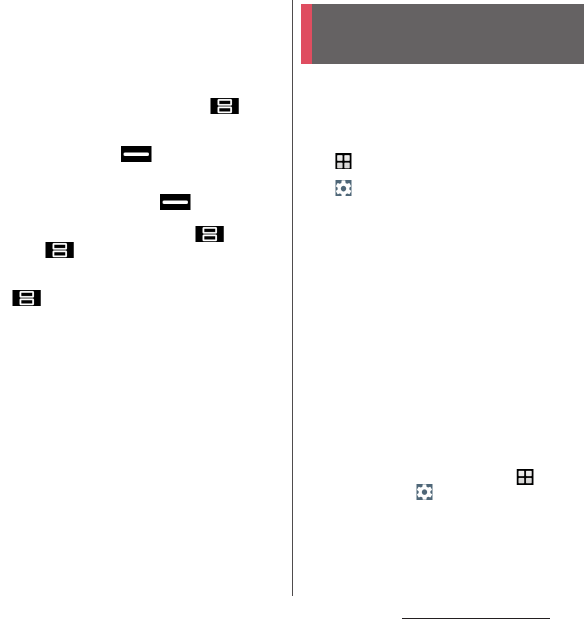
71
Before Using the Terminal
❖
Information
・
The application windows in the split screen can be
displayed up and down in the portrait view and left
and right in the landscape view.
・
The application window displayed in the lower part
(right part for the landscape view) can be switched.
To switch the application window, tap and
select the application thumbnail, or tap
h
to
activate the application.
・
In portrait view, drag of the split line displayed
in the center of the split screen up or down to
change the range of the application window.
・
To end the split screen, drag to the upper or
lower of the screen (left end or right end for the
landscape view), or touch and hold .
・
When is displayed at the bottom of the screen,
the split screen is still functioning. When the
application window is displayed in full screen, tap
to return to the split screen.
You can switch the Home application of the
terminal to "docomo LIVE UX", "Xperia
™
Home" or "Simple Home".
1
From the Home screen,
u
[Settings]
u
[Apps].
2u
[Home app].
3
Tap [docomo LIVE UX]/[Xperia
™
Home]/[Simple Home]
u
[OK].
・
If you tap "Simple Home", see how it
looks and tap [OK].
・
A home application, lock screen,
phonebook application, and music and
video player applications are set all at
once for "docomo" or "Xperia
™
".
❖
Information
・
When the home application is switched, widgets or
shortcuts on the screen may not be displayed
correctly depending on home screen layout etc.
・
To set a home application, lock screen, phonebook
application, and music and video player applications
individually, from the Home screen, tap
u
[Settings]
u
[Apps]
uu
[Preferred apps settings].
Switching Home
application
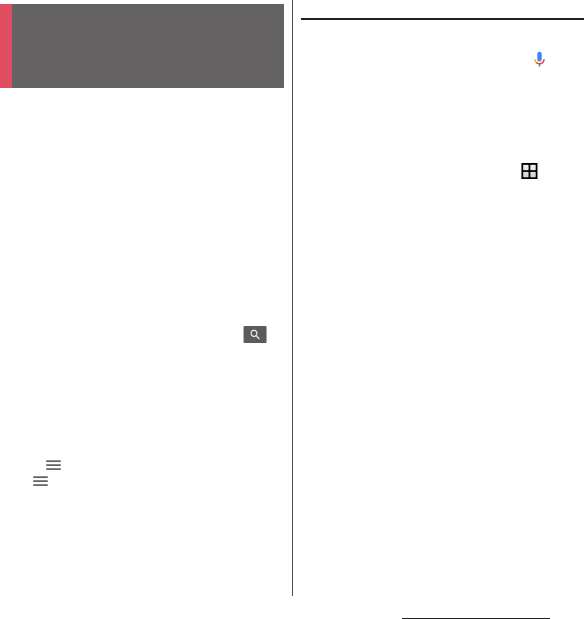
72
Before Using the Terminal
Enter a word in the search box to browse the
information in the terminal or on the
Internet.
1
From the Home screen, tap the
Google search widget.
・
When the screen that explains the feed
appears, follow the onscreen
instructions.
2
Enter a search word.
・
Character entry (P.73)
・
The search candidate list appears.
3
Tap the search suggestion or
on the software keyboard.
❖
Information
・
Alternatively, from the Home screen, tap [Google]
u
[Google] to open the "Google" application.
・
When applications appear in Step 2, select an
application to activate.
・
When is displayed in the search result screen etc.,
tap
u
[Settings] to make settings for the search
function.
Using Google Voice Search
Enter a search word by voice.
1
From the Home screen, tap on
the Google Search widget.
2
Speak a search word to the
microphone.
❖
Information
・
Alternatively, from the Home screen, tap
u
[Voice
Search] to activate the "Voice Search" application.
Searching information in
the terminal and web
pages
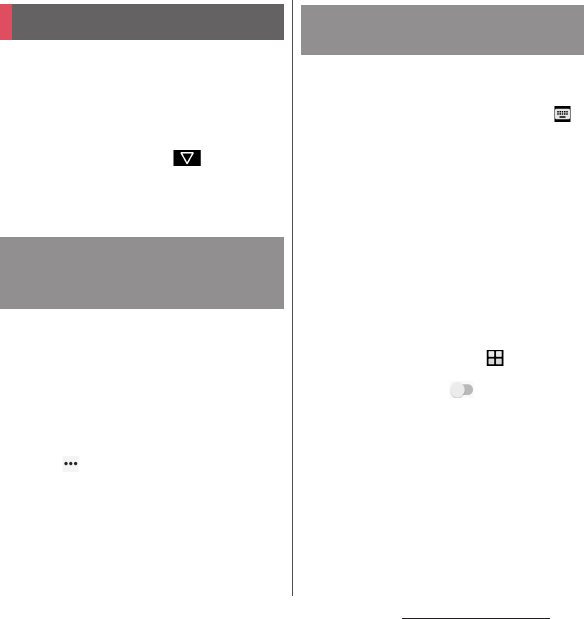
73
Before Using the Terminal
Enter characters using the software keyboard
(keyboard on the screen) which appears
when you tap the character input box in a
mail, phonebook, etc.
❖
Information
・
To hide software keyboard, tap displayed at
the lower left of the screen.
・
A magnifier appears when you touch and hold a text,
and you can enlarge the text.
Character input method for the terminal is
set to "Xperia
™
Japanese keyboard" by
default when the language is set to
日本語
(Japanese). Details on using Xperia Japanese
keyboard are explained in "POBox Plus
使い方
ガイド
(Online help)".
1
From the character entry screen,
tap in the quick tool bar.
・
Details of the quick tool bar (P.75)
2
[Online help].
Switch the software keyboard to use for
entering characters.
1
While entering characters, tap
at the bottom of the screen.
・
The screen for changing the software
keyboard appears.
2
Select the software keyboard.
❖
Information
・
When the language is set to English, the default
keyboard is set to "SwiftKey Keyboard". To use the
Japanese keyboard, tap [Xperia
™
Japanese
keyboard] in Step 2. In this manual, explanations are
given only for "Xperia
™
Japanese keyboard".
・
If the software keyboard you want use is not
displayed on the screen for changing the software
keyboard, from the Home screen,
u
[Settings]
u
[Languages & input]
u
[On-screen keyboard]
u
[Manage keyboards]
u
Tap of the keyboard.
Character entry
POBox Plus
日本語入力
使い方ガイ
ド
(Xperia™ Japanese keyboard
Online help)
Selecting the software
keyboard
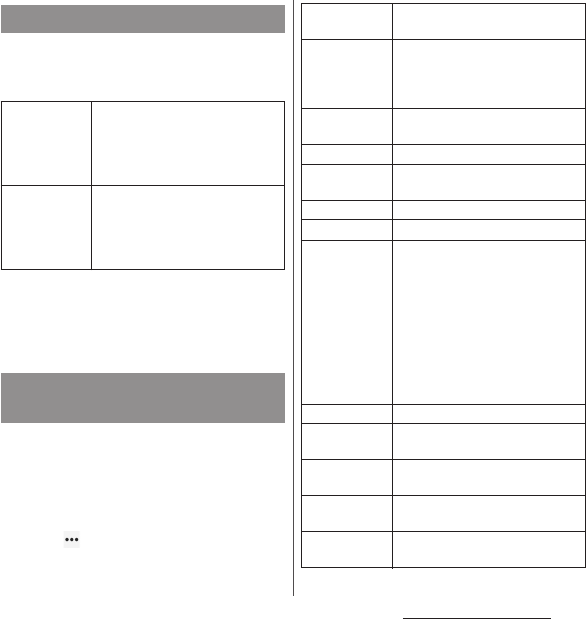
74
Before Using the Terminal
For Xperia
™
Japanese keyboard, the
following software keyboard can be used.
・
Character input method (P.75)
❖
Information
・
Besides using the software keyboards, handwriting
input and voice input are available for entering
characters.
Display the tool list to switch between
software keyboard and handwriting/voice
input, use plug-in applications (extensions),
or change the settings.
1
From the character entry screen,
tap in the quick tool bar.
・
Details of the quick tool bar (P.75)
Software keyboard
Keypad
Keyboard with the same key
arrangement as a mobile phone.
Repeatedly tap a key to select a
character (multi-tap input). Flick
input is also available.
QWERTY
Keyboard with characters allocated
in the same arrangement as general
PCs. Enter Japanese in Roman
character. Flick input is also
available.
Switching software keyboard
or changing the settings
Keyboard
layout
Set software keyboard (Keypad or
QWERTY) for each character mode.
Switch to
QWERTY/
Switch to
keypad
Switch to QWERTY/keypad.
One-handed
keyboard
Change the keyboard size for one-
handed operation.
My Words
P. 7 8
Settings
Change Xperia
™
Japanese
keyboard settings.
Keyboard skins
Change software keyboard skin.
Online help
P. 7 3
For beginners
Select "Online help" to display
"POBox Plus
日本語入力
使い方ガイド
(Online help for Xperia
™
Japanese
keyboard)" (Japanese) (P.73).
Select "Simple keyboard" to change
to the software keyboard with
bigger texts and simple design.
Select "Reset" to restore the settings
and design of the software
keyboard to their factory defaults.
Handwriting
Switch to handwriting input.
docomo voice
input
Switch to docomo voice input.
Google voice
typing
Switch to Google voice typing.
Download
Download plug-in applications
(extensions) from website.
Contact Picker
2.3
P. 7 8
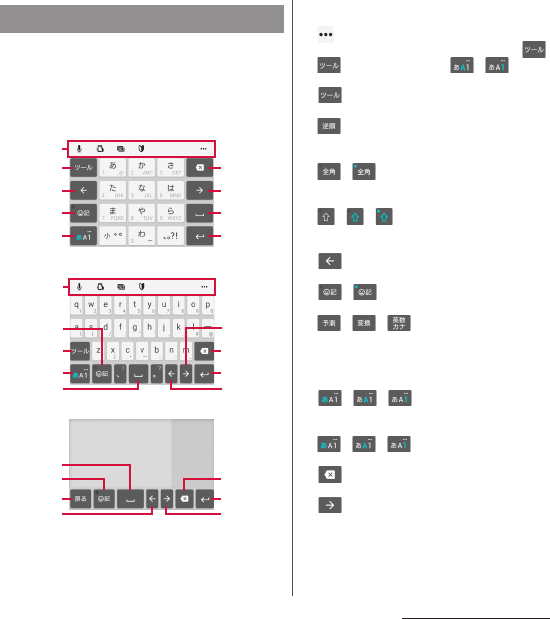
75
Before Using the Terminal
When you tap a key on the software
keyboard, candidates list for the entered
characters appears. Tap a word to enter from
the candidate list, text can be input one after
another.
a
Quick tool bar
Display shortcuts of frequently-used functions. Tap
to display the tool list (P.74).
If the quick tool bar is not displayed, tap (when
is not displayed, tap / to switch the
character mode to "Kana").
b
Show/hide the quick tool bar.
When entering on the keypad, characters assigned
to a key appear in reverse order.
/
Appears when entering numbers, tap to switch one-
byte/two-byte character.
/ /
When entering alphabet letters on QWERTY, tap to
switch lower case, capitalization and upper case.
c
Move the cursor to the left.
d
/
Hide/show the list of symbols, facemarks, etc.
/ /
Appears before fixing character in Kana mode and
switches among
予測
(prediction) candidate list/
変換
(conversion) candidate list/
英数カナ
(alphanumeric/
katakana) conversion candidate list.
e
/ /
The character mode switches "Kana"
→
"Alphabet"
→
"Numeric" in order.
/ / Touch and hold
Display the tool list (P.74).
f
Delete the character before the cursor.
g
Move the cursor to the right.
When there is an unfixed character string with the
cursor positioned at the right end, enter the same
character as the last entered ones (Except for
Handwriting input).
Character input method
b
c
a
d
e
f
g
h
i
Keypad
a
h
d
b
e
c
g
f
i
QWERTY
c
h
d
j
g
f
i
Handwriting input
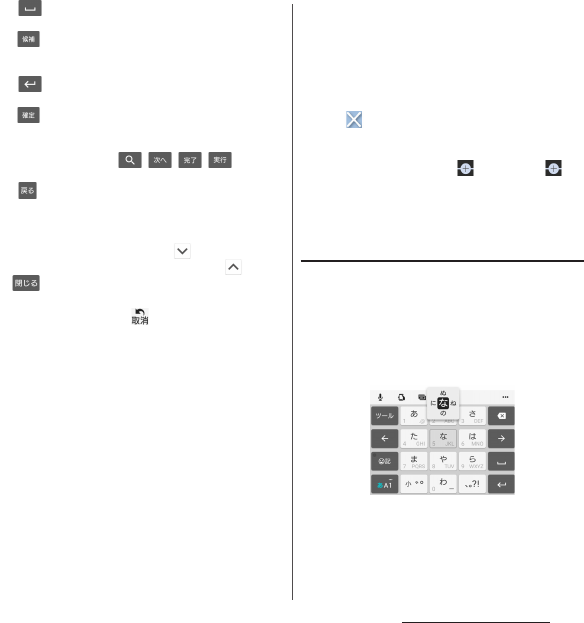
76
Before Using the Terminal
h
Enter spaces.
In Kana mode, highlight and select word in the
candidate list.
i
Enter a line feed.
*
Appears before fixing character and fixes the
character.
* In some screens, , , , , etc.
appear.
j
Return to keypad/QWERTY.
❖
Information
・
To enlarge the display area, tap in the candidate
list. To display the software keyboard, tap or
.
・
To return to the display before conversion after the
conversion is fixed, tap displayed in
つながり予測
(associative) candidate (except in handwriting input
mode) etc.
・
Note the following when you use Handwriting input.
- For voiced sound and semi voiced sound mark,
enter in the right upper part of the input screen.
- For punctuation mark and lower case, enter in the
lower part from the center of the input screen.
・
For Handwriting input, the following operations are
available.
- Tap an icon at the upper left of entered character
to display candidates for the entered character.
Recognized character is displayed in light blue and
characters are displayed at the bottom of
candidate list in different colors by type.
- Tap at the upper right of entered character to
delete the entered character.
- When entering 2 or more characters and tapping
the icon at the upper left, appears. Tap to
combine entered 2 characters to 1 character.
Combine characters with this operation if 1 Kanji
character is recognized as 2 characters or other.
Flick input
Flick up/down/left/right to enter characters
in each column of kana syllabary.
<Example> Entering characters in "
な
" column
You can enter "
な
" only by tapping. Flick left
for "
に
", up for "
ぬ
", right for "
ね
" and down
for "
の
".
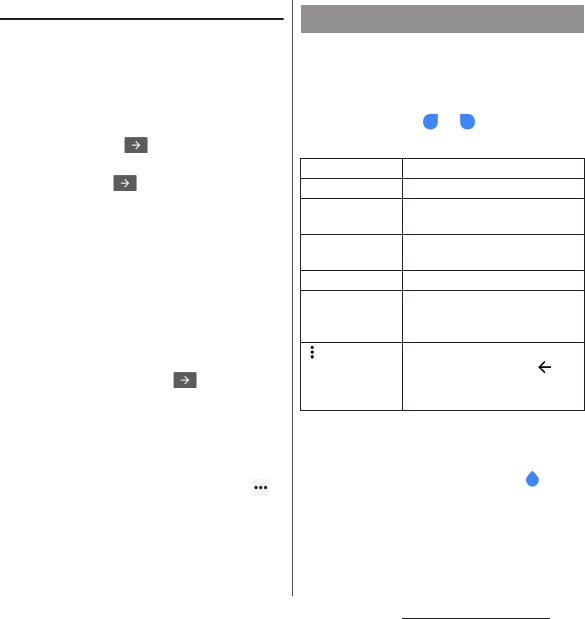
77
Before Using the Terminal
Multi-tap input
Tap the same key continuously to enter the
assigned character.
To enter a character assigned to the same
key, wait for changing the color of tapped key
to the original (approx. 1 second), then enter
the next character (for entering the next
character soon, tap to change the color
of key to the original). With the key in the
original color, tap to enter the last
entered character again.
<Example> Entering "
あお
"
1
Tap "
あ
" once
u
Wait approximately
1 second (until the key color
returns to the original).
2
Tap "
あ
" 5 times.
or
1
Tap "
あ
" once
u
Tap
(immediately).
2
Tap "
あ
" 5 times.
❖
Information
・
To switch the input method used on the keypad
between "Flick input" and "Multi-tap input", tap in
the quick tool bar on the character entry screen
u
[Settings]
u
[Input style & sensitivity]
u
[Input style],
then select your desired item.
In the character entry screen, when you
double-tap a character to edit, or touch and
hold or double-tap a text to copy in a web
page etc., the edit menu appears near the
selected text. Drag or to change the
character string to select.
❖
Information
・
To paste a copied or cut character string, touch and
hold a position to insert
u
Tap [PASTE]. When text is
already entered, tap a position to insert
uu
Tap
[PASTE].
・
On some applications, these functions may not be
available or the editing menu may appear different.
Editing text
CUT
Cut a selected character string.
COPY
Copy a selected character string.
PASTE
Paste a copied/cut character
string.
SHARE
Attach and send the selected
character string to an application.
SELECT ALL
Select all text.
WEB SEARCH
Search for online information
related to the selected character
string.
Display the editing menu that
could not be shown. Tap to
return to the previous editing
menu.

78
Before Using the Terminal
If contacts are registered to the Contacts, you
can use "Contact Picker 2.3" to enter contact
information when entering characters.
1
From the character entry screen,
tap in the quick tool bar.
・
Details of the quick tool bar (P.75)
2
[Contact Picker 2.3]
u
Tap
"CONTACTS" tab.
3
Select a contact to quote.
4
Mark items to quote
u
[OK].
・
If the quoted information is not
displayed, tap the character entry field.
❖
Information
・
The "HISTORY" tab displays your own contact
information and contact information you retrieved
when you entered characters previously.
You can add words to My Words beforehand
to have them appear as preferred candidates
when entering characters.
1
From the character entry screen,
tap in the quick tool bar.
・
Details of the quick tool bar (P.75)
2
[My Words].
3
Tap .
4
Enter the reading into the
character input box for "Reading".
5
Tap the character input box for
"Word"
u
Enter the word.
6
[OK].
❖
Information
・
To delete registered words, in Step 3, mark words to
delete
uu
Tap [DELETE].
Quoting contacts My Words
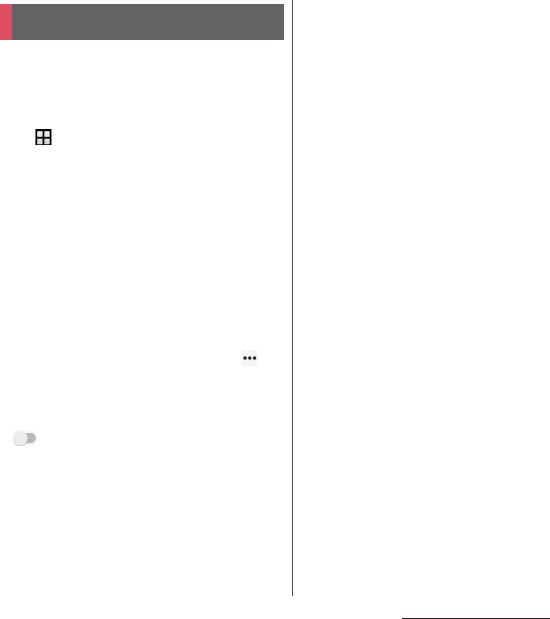
79
Before Using the Terminal
For each input method, you can make
settings related to character entry or check
application information.
1
From the Home screen,
u
[Settings]
u
[Languages &
input].
2
[On-screen keyboard]
u
Select the
software keyboard.
・
Tap an item displayed on the screen to
set.
・
If the introduction screen etc. appears,
follow the onscreen instructions.
❖
Information
・
The items vary depending on the input method.
・
When entering characters with Xperia
™
Japanese
keyboard, on the character entry screen, tap of
the quick tool bar
u
[Settings] to display the settings
screen for Xperia
™
Japanese keyboard.
・
If the software keyboard is not displayed, in Step 2,
[On-screen keyboard]
u
[Manage keyboards]
u
Tap
of the keyboard.
Setting the character entry
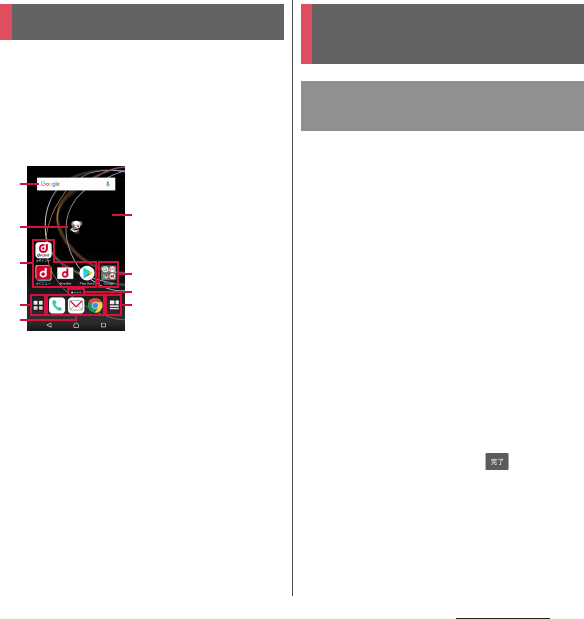
80
docomo LIVE UX
docomo LIVE UX
Home screen is displayed when
h
is
tapped. You can activate applications,
widgets, etc. or display the applications
screen from it.
・
Flick the Home screen left or right to switch
the pages.
a
Widget : Google Search
b
Machi-chara
c
Application icon
d
Apps button
・
Display the application list screen (P.83).
e
Application icons
・
This icons are always displayed even when the
Home screen page is switched.
f
Wallpaper
g
Folder
・
Several application icons are stored in the folder.
h
Current position
・
Display the number of home screens and current
home screen position.
i
My Magazine button
・
Display My Magazine (P.86).
Move application icons or add widgets or
folders to the Home screen.
1
Touch and hold an area of the
Home screen where no icons are
displayed.
2
Tap any of [Show apps]/[Show
widgets]/[Create folder].
・
To move/add applications or widgets,
touch and hold the icon
u
Drag it to the
Home screen display area at the
bottom of the screen.
❖
Information
・
To move an application icon into a folder, touch and
hold the icon on the Home screen
u
Drag it over the
folder.
・
To change a folder name, tap a folder
u
Tap the folder
name
u
Enter a folder name
u
Tap of software
keyboard.
・
If a frame appears when you release your finger after
touching and holding a widget, drag the frame to
change the display size.
Home screen
a
b
c
e
d
f
g
h
i
©NTT DOCOMO
"ひつじのしつじくん®
(Butler Sheep)"
Managing the Home
screen
Adding/Moving applications
etc. to the Home screen
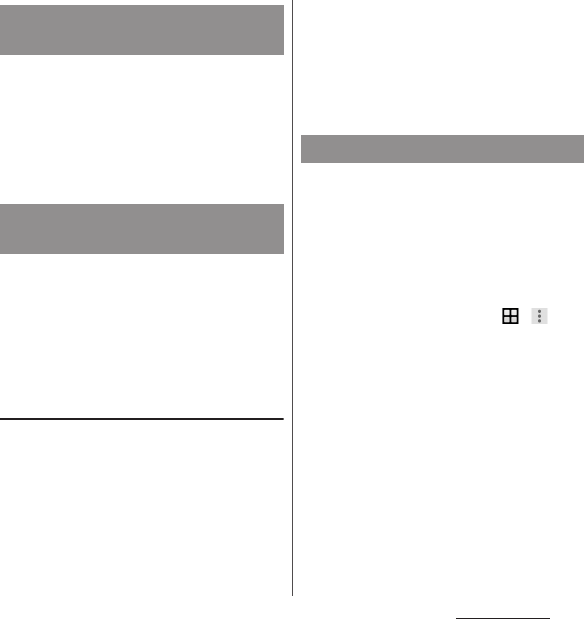
81
docomo LIVE UX
1
From the Home screen, touch and
hold an icon.
2
Drag it anywhere.
・
To move to the next home screen,
touch and hold the home screen and
drag it to left or right.
1
From the Home screen, touch and
hold an icon.
2
Drag to "Back to apps list"/
"Remove from Home" displayed in
the top of the screen.
Uninstalling an application or widget
from the Home screen
・
Before uninstalling application, back up
contents related to the application or widget
that you want to save including data saved in
the application or widget.
・
Some applications or widgets may not be
uninstalled.
1
From the Home screen, touch and
hold an icon.
2
Drag to "Uninstall" displayed in
the top of the screen
u
[OK].
❖
Information
・
You can disable some applications or widgets which
cannot be uninstalled by dragging to "Disable app"
displayed in the top of the screen in Step 2 (P.175).
1
Touch and hold an area of the
Home screen where no icons are
displayed.
2
[Change Kisekae].
3
Tap a Kisekae to change to
u
[Set].
❖
Information
・
Alternatively, from the Home screen,
uu
[Kisekae].
・
You can add Kisekae contents by tapping [Search on
the web] to download from website. To delete added
Kisekae contents, tap a Kisekae to delete in Step 3
u
[DELETE]
u
[Delete].
Moving an icon on the Home
screen
Deleting an icon from the
Home screen
Changing Kisekae
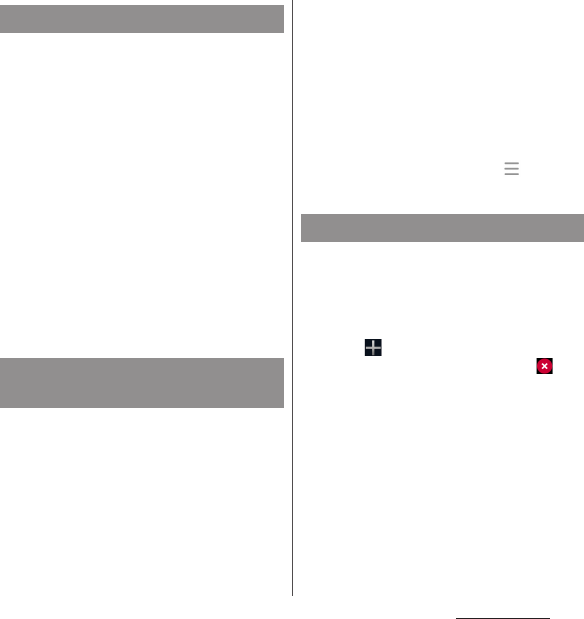
82
docomo LIVE UX
You can change wallpaper of the displayed
home screen.
・
Display a home screen page to change in
advance.
1
Touch and hold an area of the
Home screen where no icons are
displayed.
2
[Change wallpaper].
3
Tap the wallpaper to change to.
・
Tap [Select another wallpaper] to select
from "Photos", "Images" or "Live
Wallpapers".
4
Follow the onscreen instructions
to set wallpaper.
1
Touch and hold an area of the
Home screen where no icons are
displayed.
2
[Machi-Chara setting].
3
[
表示する
(Show)]/[
表示しない
(Do
not show)] of "
キャラ表示
(Chara
display)".
・
Tap the tab to make settings of
基本設定
(Basic settings)/
キャラ設定
(Chara
setting)/
音声起動設定
(Voice activation
setting) as required.
❖
Information
・
For details on Machi-chara, in Step 3,
u
[
ヘルプ
(Help)] to refer to the Help. (in Japanese only)
1
Touch and hold an area of the
Home screen where no icons are
displayed.
2
[Home screens].
3
Tap .
・
To delete the home screen, tap of
the home screen thumbnail.
・
To sort home screens, touch and hold a
home screen thumbnail you want to
sort
u
Drag it to any position.
❖
Information
・
Alternatively, pinch-in on the Home screen to display
the home screen list.
・
Up to 7 pages can be set.
・
To return to the Home screen, tap
h
or
b
, or
pinch-out.
Changing wallpaper
Changing Machi-Chara display
setting
Adding a home screen page
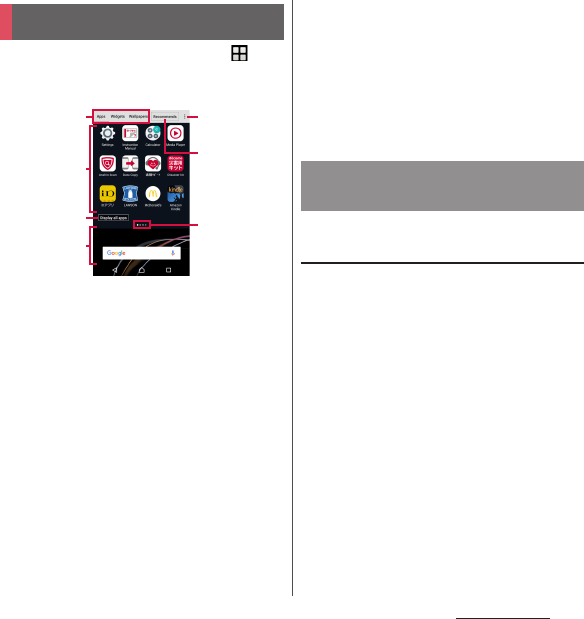
83
docomo LIVE UX
1
From the Home screen, tap .
・
Flick the Home screen downwards to
display the application screen.
a
Apps/Widgets/Wallpapers tab
・
Display application icons/widgets/wallpaper list.
b
Application icon list
・
Applications on the Home screen are not
displayed in the list.
・
Flick the list screen left or right to switch the
pages.
c
Display all apps
・
You can search the application (P.85).
d
Home screen display area
・
Flick left or right to switch the pages.
e
Option menu
・
View optional menu such as Settings.
f
Recommends button
・
Install applications recommended by DOCOMO
(P.84).
g
Current position
・
Display the number of list screens and current
screen position. Display by application icon/
widget list.
❖
Information
・
To close the application screen, tap
b
or
h
, or
flick up the Home screen display area at the bottom
of the screen.
Moving/Adding an application or
widget to the Home screen
1
On the application screen, touch
and hold an icon to move/add to
the Home screen.
2
Drag it to the Home screen display
area at the bottom of the screen.
・
When the home screen is displayed,
drag it anywhere.
Application screen
b
e
g
f
c
a
d
Customizing the application
screen
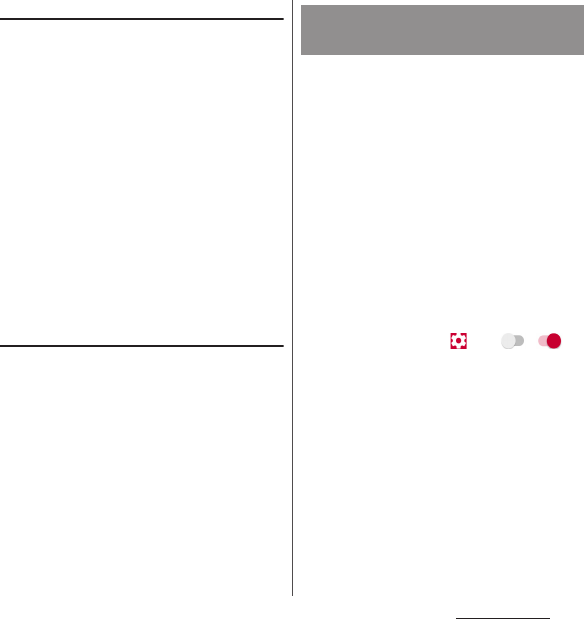
84
docomo LIVE UX
Uninstalling an application or widget
Some application icons and widgets can be
uninstalled from the application screen.
・
Before uninstalling, see "Uninstalling an
application or widget from the Home screen"
(P.81).
1
On the application screen, touch
and hold the icon of application.
2
Drag to "Uninstall" displayed in
the top of the screen
u
[OK].
❖
Information
・
You can disable some applications or widgets which
cannot be uninstalled by dragging to "Disable app"
displayed in the top of the screen in Step 2 (P.175).
Moving application in the application
icon list
1
On the application screen, touch
and hold the icon.
2
Drag it anywhere.
Install applications recommended by
DOCOMO.
1
On the application screen,
[Recommends].
・
When using the service for the first
time, you will see the introduction
screen for Osusume App. Tap [ENABLE]
to display the application list screen
and enable notification of Osusume
App.
2
Select an application.
・
An introduction screen for app appears.
❖
Information
・
On the application screen,
u
Tap / of
"Notification settings" to switch on/off of Osusume
App notification.
Installing "Recommends"
applications
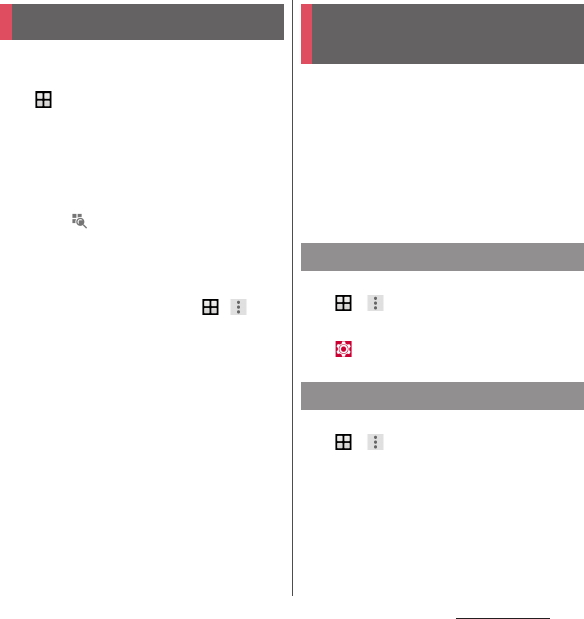
85
docomo LIVE UX
It is a function to search the applications.
1
From the Home screen,
u
[Display all apps].
・
All applications are displayed in a list.
2
Tap an application.
・
The application activates.
・
To sort the applications, tap [By app
name] in the upper right of the screen.
・
Tap to display the screen where the
application is located with the
application focused.
❖
Information
・
Alternatively, from the Home screen,
uu
[Display all apps] to display the list of all applications.
You can use docomo LIVE UX data backed up
on the docomo cloud to restore the layout of
applications, widgets, and other items on the
Home screen. Once it is restored, a page for
docomo services is added to the bottom of
the Home screen.
・
To use the backup and restore features, you
need to set up your d ACCOUNT (P.186).
1
On the Home screen,
uu
[Layout backup &
Restore].
2u
[BACKUP].
1
On the Home screen,
uu
[Layout backup &
Restore].
2
[Restore the latest backup data]/
[Restore from backup data list].
Display all apps Backing up and restoring
the Home screen
Backing up the Home screen
Restoring the Home screen
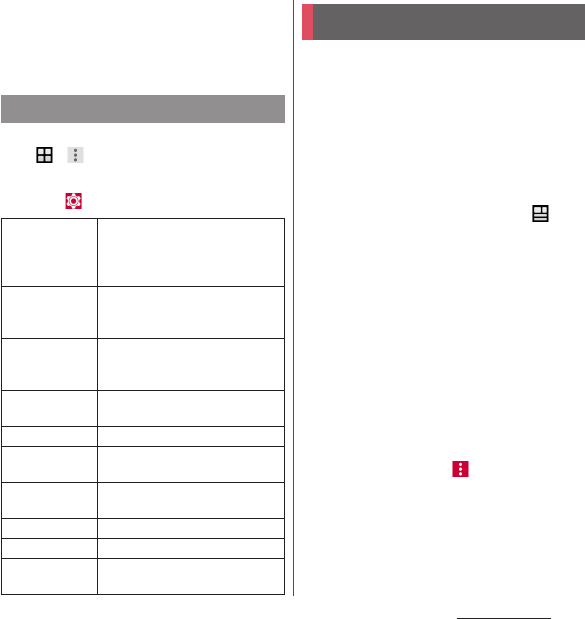
86
docomo LIVE UX
3
[Restore].
・
If you selected "Restore from backup
data list", select the data you want to
restore
u
Tap [Restore].
1
On the Home screen,
uu
[Layout backup &
Restore].
2
Tap .
My Magazine is a search service for
displaying articles for categories you
selected. By your tendency of read articles or
profile information, the more you use, the
more it comes close to your preference. Also,
you can set to enable notifications of notice,
or customizing of My Magazine using your
docomo service subscription information etc.
1
From the Home screen, tap .
・
When you activate the application for
the first time, select categories on the
selection screen and then tap [OK].
・
Flick the article list screen left or right to
switch categories.
・
Tap [See more info] to show other
articles in the category.
2
Tap an article you want to read.
❖
Information
・
Alternatively, flick the Home screen up to display the
article list.
・
You can change the settings of My Magazine or
check the help by tapping in Step 2.
Backup settings
Backup
automatically
Set whether to periodically back up
when the home screen
information for the docomo LIVE
UX is updated.
Multi-Device
Sync
Set whether to send a notification
to your other devices when an
application has been installed.
Sync on Wi-Fi
only
Set whether to back up or sync
data only when the terminal is
connected via Wi-Fi.
Sync while
Roaming
Set whether to back up or sync
data during international roaming.
Usage statistics
Set whether to send usage status.
Delete backup
data
Delete your backup information
from the server.
Open source
licenses
View open source licenses.
Terms of use
View the terms of use.
Help
View the operation guide.
About
View the application's version and
other information.
Using My Magazine
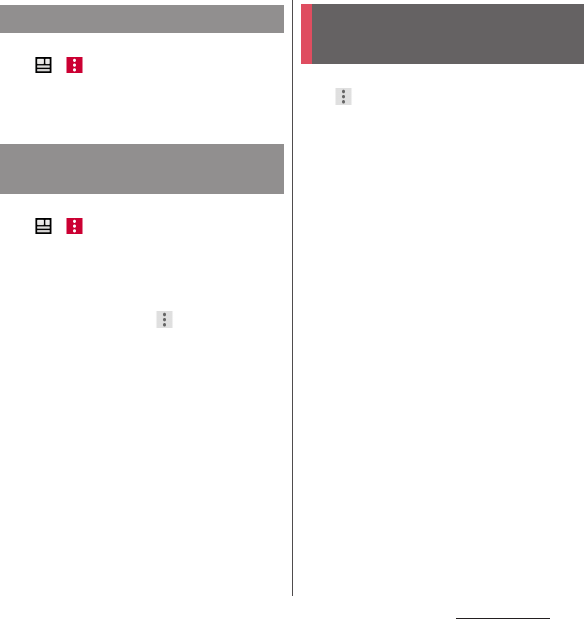
87
docomo LIVE UX
1
From the Home screen,
uu
[Display category
setting].
2
Put marks to the categories.
1
From the Home screen,
uu
[My Magazine settings]
u
[My Magazine use setting].
2
[Use]/[Not use]
u
[OK].
❖
Information
・
You can also set by tapping on the application
screen
u
[My Magazine use setting].
1
On the application screen,
u
[About].
❖
Information
・
If the update of docomo LIVE UX is available, "Update
now" is displayed in the application information
screen. Tap it to update docomo LIVE UX.
Setting a category
Changing My Magazine use
setting
Checking Home
application information
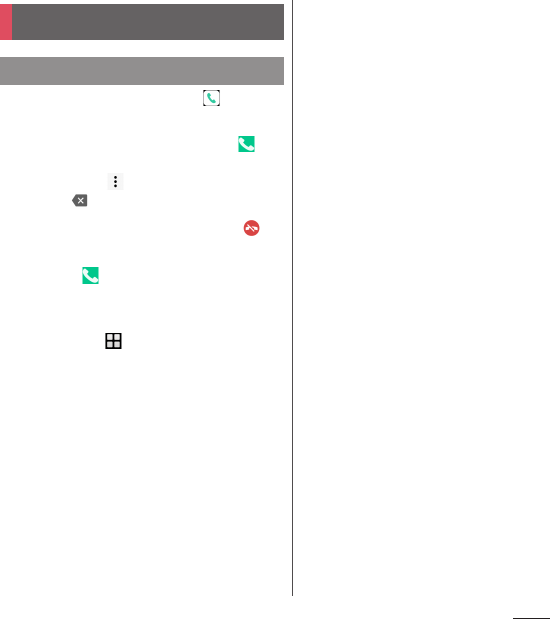
88
Phone
Phone
1
From the Home screen,
u
"Dial"
tab.
2
Enter a phone number
u
Tap .
・
To make a video call, enter a phone
number
uu
Tap [Video call].
・
Tap to delete the number.
3
When the call is finished, tap .
❖
Information
・
In Step 2, tap without entering a phone number
to enter the phone number registered as the latest
call in Recent calls.
・
To activate Xperia
™
phone application, from the
Home screen, tap
u
[Dial].
・
With VoLTE, you can make high-quality voice and
video calls. You can also switch between voice and
video calls.
To use VoLTE, both parties must meet the following
requirements.
- Both terminals support VoLTE
- Within the area where VoLTE is available
- "Preferred network type" (P.207) in "Mobile
networks" is set to "4G (preferred)/3G/GSM" or "4G/
3G", and "Enable VoLTE" (P.207) is ON
・
With VoLTE (HD+), you can make voice and video
calls with sound that is much higher quality than
with VoLTE.
To use VoLTE (HD+), the usage requirements of VoLTE
must be met, and both you and the other party must
have models which support VoLTE (HD+).
・
On a video call, both speakers can see each other
while talking.
- When you make a video call, voice call and packet
communication charges will apply. When you
receive a video call, packet communication
charges will apply.
- Video calls are based on best-effort
communication (which optimizes transmission
speed depending on how busy your network is),
so the quality of video images varies depending on
your network environment.
- If your terminal fails to switch to the video call
during a voice call, the massage appears on the
screen and the voice call continues.
- Since imaging for video call varies by terminal
model, your terminal and the other party's
terminal may show different image in scope.
Making/Receiving a call
Making a call/video call
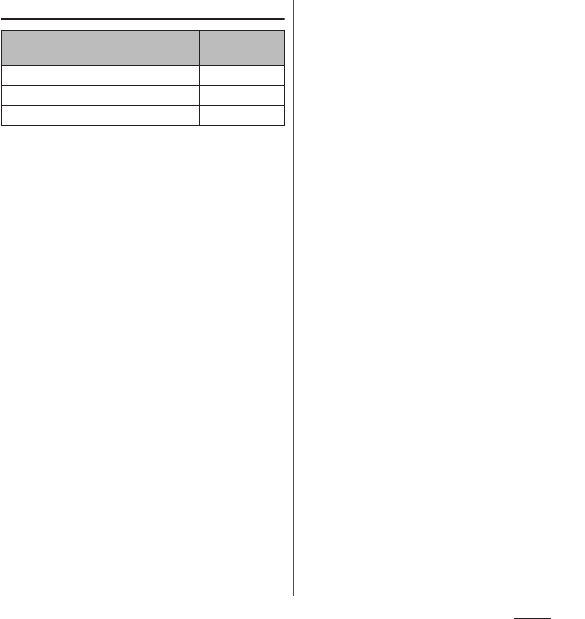
89
Phone
Emergency call
❖
Note
・
This terminal supports "Emergency call location
information". If you use the terminal to place a call to
emergency numbers such as 110, 119, or 118, the
information of a location where you are calling from
(location information) is automatically notified to the
Emergency call acceptance organization such as the
Police Station.
However, the Emergency call acceptance
organization may not be able to figure out your exact
location depending on the location where you place
a call or radio wave condition.
If you make a call hiding your caller ID, such as by
entering a phone number with "184" for each call,
your location information and phone number are not
reported. However, when the Emergency call
acceptance organization deems it necessary for
lifesaving purposes, etc., they may decide to obtain
your phone number and accurate location
information from your GPS, regardless of your
settings.
Note that the areas/time for which the "Emergency
call location information" is ready to be used vary
depending on the preparatory state of each
Emergency call acceptance organization.
・
When calling 110, 119 or 118 for emergency from the
terminal, tell that you are calling from a mobile
phone, and give your phone number and your
current location precisely for checking callback from
the police/fire department. Also, make a point to call
in a stationary position to prevent the call from being
dropped. Do not power off the terminal for at least
10 minutes after the emergency call just in case the
Police or Fire/Ambulance may have to get in contact
with you.
・
Note that you may not connect to the local Fire
Department or Police Station depending on where
you are calling from.
❖
Information
・
If docomo nano UIM card is not inserted to the
terminal, emergency calls (110, 119, 118) cannot be
made in Japan.
・
You can make an emergency call by tapping
[EMERGENCY CALL/INFO] on the lock screen.
・
If you make an emergency call with Call Blocking is
ON, the setting of the Call Blocking turns off
automatically. However, the Call Blocking will be set
120 minutes later again only when Block numbers is
set.
・
Emergency calls may not be available on some
networks.
・
The video call feature does not support emergency
calls to 110, 119, and 118.
Emergency call Phone
number
Police call
110
Fire and emergency rescue
119
Coast guard
118
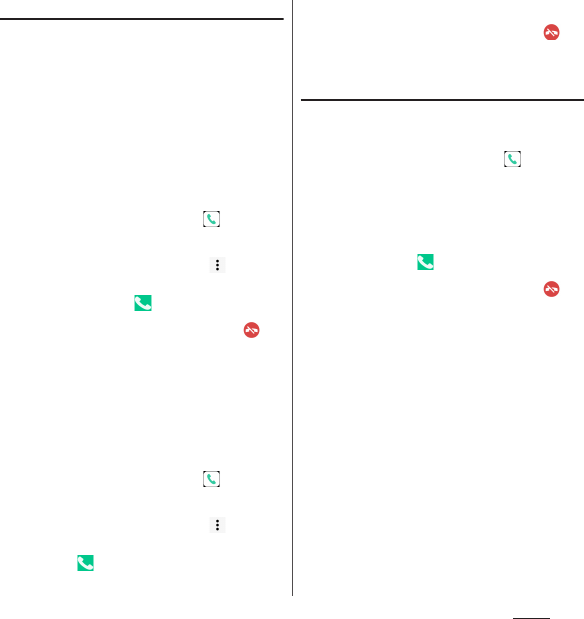
90
Phone
Entering pause (,)/(;) to send
For using services requiring entry of number
during a call such as check of the balance of a
bank account, reservation of tickets, etc.,
enter an additional number to a phone
number beforehand and make a call.
■
Using 2-second pause (,)
Added number will automatically be sent
approximately 2 seconds after a call is
accepted.
1
From the Home screen,
u
"Dial"
tab.
2
Enter a phone number
uu
[Add
2–sec pause]
u
Enter an additional
number
u
Tap .
3
When the call is finished, tap .
■
Using a wait (;)
Sending is automatically on standby when
the call is made and a confirmation screen
asking if you send the additional number
appears.
1
From the Home screen,
u
"Dial"
tab.
2
Enter a phone number
uu
[Add
wait]
u
Enter an additional number
u
Tap .
3
On a confirmation screen, [YES].
4
When the call is finished, tap .
Making an international call (WORLD
CALL)
For details on the WORLD CALL, refer to NTT
DOCOMO website.
1
From the Home screen,
u
"Dial"
tab.
2
Dial + (touch and hold [0])
u
Enter
Country code, Area code (City
code), recipient number in the
order
u
Tap .
3
When the call is finished, tap .
❖
Information
・
If the area code begins with "0", omit "0". However, "0"
may be required to dial to some countries or areas
such as Italy.
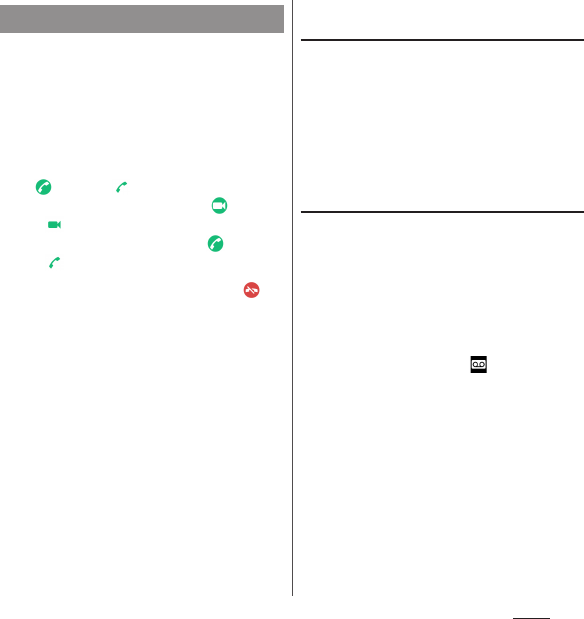
91
Phone
・
When a phone or video call comes in, the
incoming call screen appears.
If the screen backlight is on (except on the
lock screen) or an application is running, the
notification appears at the top of the screen
(P.92).
1
On the incoming call screen, drag
(left) to (right).
・
To accept a video call, drag (left) to
(right) for "Answer video". To answer
a call with voice only, drag (left) to
(right) for "Answer voice".
2
When the call is finished, tap .
❖
Information
・
When "Answer" of "Suguden setting" (P.99) is ON, an
incoming call can be answered just by holding up
the terminal to your ear.
・
When "Disconnect" of "Suguden setting" (P.99) is ON,
a call can be disconnected by the motion or voice
keyword during a call.
Answering a video call with the
camera turned off
You can answer a video call without sending
your image to the other party.
1
On the incoming call screen,
[RESPONSE OPTIONS].
2
[Answer without video].
Answering calls with Answering
Machine
Even when Answering Machine is not set, you
can activate Answering Machine manually.
1
On the incoming call screen,
[RESPONSE OPTIONS].
2
[Reject with Answering Machine].
❖
Information
・
If there is a recorded message, is displayed in the
status bar. Drag the status bar downwards
u
Tap the
notification of the Answering Machine to display the
Messages screen and you can check the recorded
messages.
Receiving a phone/video call
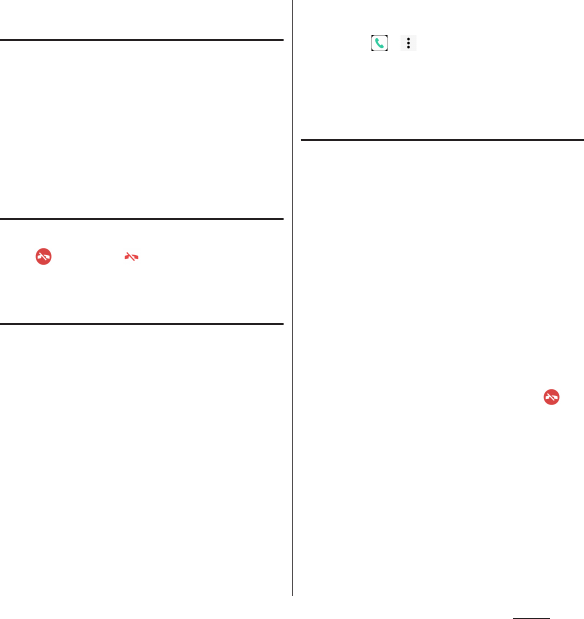
92
Phone
Muting the ringtone for an incoming
call
1
While receiving a call, press the
volume key or
O
.
❖
Information
・
You can stop vibration by pressing the volume key or
O
when silent mode (Vibrate) is set.
・
On the Home screen etc., press the volume key to
adjust the ringtone volume.
Declining a call
1
On the incoming call screen, drag
(right) to (left).
Rejecting an incoming call and
sending a message (SMS)
If you are not available to answer a phone or
a video call, you can decline the call and send
a message (SMS). Messages for sending are
pre-registered, and you can edit them if
necessary.
1
On the incoming call screen,
[RESPONSE OPTIONS].
2
Tap a message to send.
・
Tap [Write new message] to create and
send a message.
❖
Information
・
To edit/add a message beforehand, from the Home
screen, tap
uu
[Call settings]
u
[Reject call
with message]
u
Select an existing message or blank
space and edit it
u
[OK].
Receiving a phone/video call when an
application is running
If the screen backlight is turned on (except
on the lock screen) or an application is
running when a call comes in, the notification
appears in the upper screen.
1
[ANSWER].
You can start a voice conversation.
・
To accept a video call, tap [VIDEO
CALL].
・
To decline a call, tap [DECLINE].
・
Tap the upper part of displayed
notification to open the incoming call
screen.
2
When the call is finished, tap .
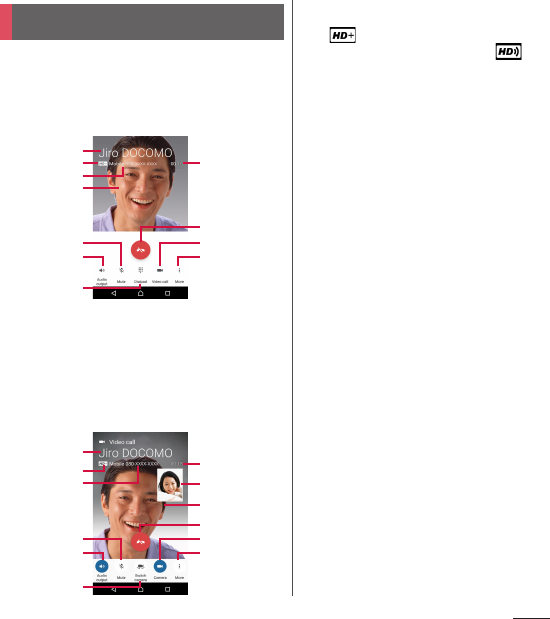
93
Phone
On the Calling screen, you can set voice
output or mute, or enter a phone number to
make a call to another party.
■
Screen displayed during a voice call
■
Screen displayed during a video call
While on a video call, you will see the other
party's image in a parent window, and your
image in a child window, with the control
icons hidden. Tap the screen to show the
control icons.
a
Name, phone number, etc. of the other party
b
Sound quality of VoLTE call
・
(super high sound quality) is displayed
during calls in VoLTE (HD+), and (high
sound quality) is displayed during calls in VoLTE
(HD).
c
Phone number registered in the phonebook entry
d
Photo/image set in the phonebook entry
e
Mute : Turn the microphone on/off during a call.
f
Audio output : Turn the speakerphone on/off.
・
Other party's voice can be heard from the speaker
and handsfree call can be made.
・
Video calls are made or received with the
speakerphone turned on.
・
When the terminal is connected to a Bluetooth
device, you can tap the icon to switch the audio
output.
g
Dial key : Send a push signal while on a call.
h
Call duration time
i
End a call
j
Video call : Switch from a voice call to a video call.
・
When you tap this icon, the other party will see a
message asking for permission to switch to a
video call. If the other party accepts it, you can
switch to a video call.
・
If the other party has declined to switch to a
video call, is outside a VoLTE service area, or is
using a terminal that does not support VoLTE, a
message appears indicating that the call cannot
be switched. Tap [OK] to continue the voice call.
・
"Hold call" is displayed during a 3G voice call.
Operations during a call
i
h
j
k
a
b
c
d
f
e
g
i
h
m
n
o
p
a
b
c
f
e
l
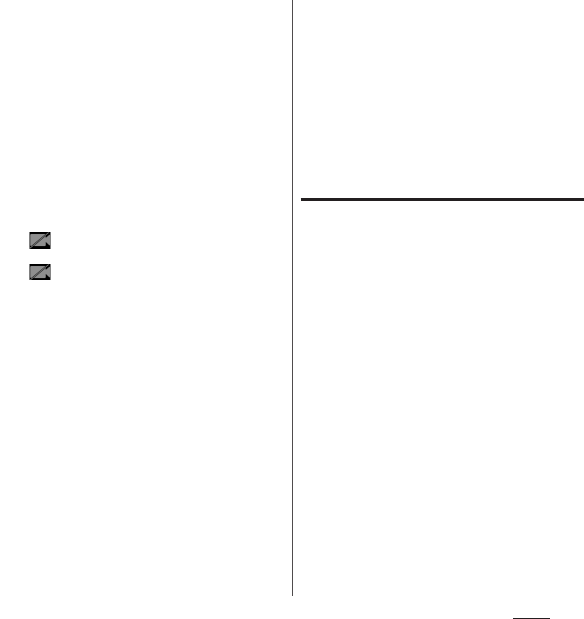
94
Phone
k
More (voice call)
・
Hold a call
[More]
u
Tap [Hold call]/[Resume call] to put a
voice call on hold or resume the call.
・
To hold a call, "Call waiting" subscription is
required (P.97).
・
Add call
[More]
u
Tap [Add call] to add a voice call.
・
"Add call" is displayed during a 3G voice call.
・
To add a call, "Call waiting" subscription is
required (P.97).
l
Switch camera
・
Tap this icon to switch between cameras for
shooting your image.
m
Child window for a video call (your image)
・
is displayed if the camera is hidden.
n
Parent window for a video call (other party's image)
・
is displayed if your terminal cannot receive
the other party's image.
o
Camera
・
Select whether to send your image to the other
party or hide it.
p
More (video call)
・
Change to voice
[More]
u
Tap [Change to voice] to switch to a voice
call.
・
Dialpad
Open a dialpad while on a video call.
・
Switch videos
[More]
u
Tap [Switch videos] to switch the display
area between the parent window (showing the
other party's image) and the child window
(showing your image).
❖
Note
・
Do not bring the terminal close to your ear with the
speakerphone on to avoid from hearing damage.
❖
Information
・
The notification icon is displayed on the status bar
while dialing, incoming, calling or holding. Even if
you switch the screen to the other screen such as the
Home screen, returning to the Phone application
screen is available by dragging the status bar down
and then tap the notification.
・
When you switch to the other screen such as the
Home screen during a video call, the camera is
turned off.
Adjusting the earpiece volume
1
Press the volume key during a call.
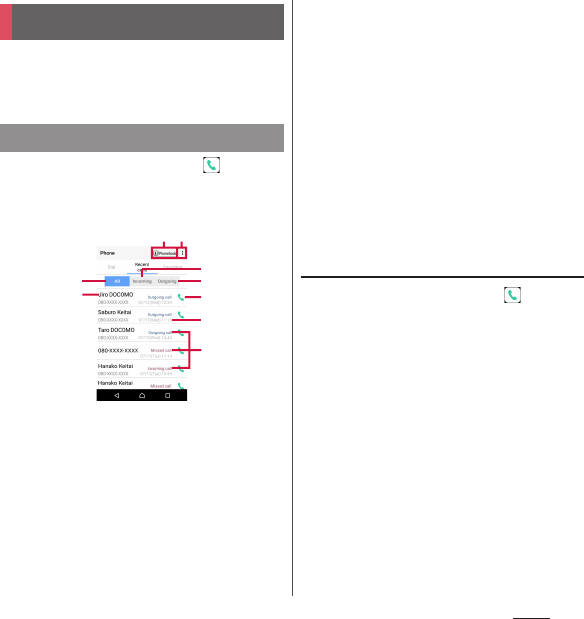
95
Phone
Incoming calls and outgoing calls are
displayed by chronological order in the
Recent calls screen.
1
From the Home screen,
u
Tap
"Recent calls" tab.
■
Recent calls screen
a
Phonebook
・
The phonebook list screen appears.
b
Option menu
c
All tab
d
Phone number/name
・
Tap to make a voice call or video call, create an
SMS message, etc.
・
Touch and hold to display "Edit number before
call", "Delete from call log", "Register as blocked
number" or "Search location".
e
Incoming tab
f
Outgoing tab
g
Voice call button
・
Tap this button to make a voice call to the
corresponding phone number in the call log.
h
Date
i
History
・
The details of an incoming or outgoing calls
(Outgoing, Incoming, or Missed call) are
displayed.
❖
Information
・
The number of call history that can be stored
depends on the amount of available memory on
your terminal.
Adding a number from the Recent
calls to Phonebook
1
From the Home screen,
u
Tap
"Recent calls" tab
u
Tap a phone
number
u
[Register].
・
Alternatively, in the Recent calls screen,
touch and hold a phone number
u
[Edit
number before call]
u
[Register].
2
[Add new contact]/[Add to the
existing contact].
・
When "Add to the existing contact" is
selected, select a contact to save to.
3
On the profile edit screen, enter
necessary information such as
name.
・
To add items, tap [Add other items].
4
[Save].
Call history
Showing call history
c
d
ab
f
h
e
i
g
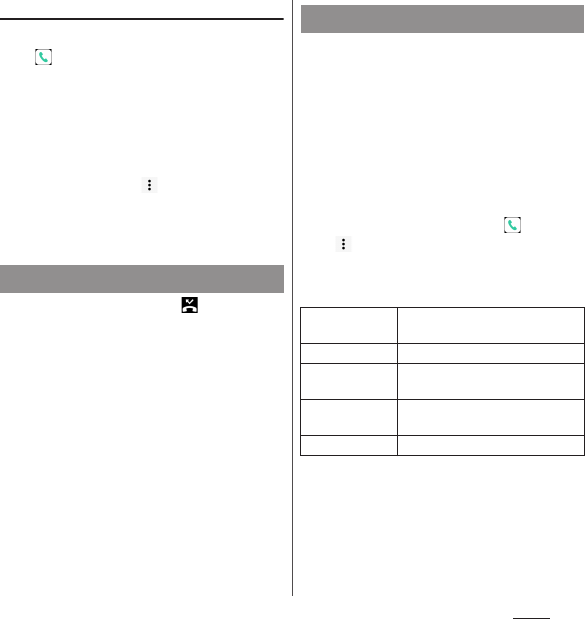
96
Phone
Deleting a call history
1
From the Home screen,
u
"Recent calls" tab
u
Touch and
hold the incoming/outgoing
history to delete.
2
[Delete from call log]
u
[OK].
❖
Information
・
To delete all the call history, in the Recent calls
screen, tap the "All" tab
uu
[Delete log]
u
Mark
"Select all"
u
[Delete]
u
Tap [Delete].
・
Voice and video calls are not distinguished in the
Recent calls.
When you have missed calls, appears in
the status bar.
1
Drag the status bar downwards.
2
[Missed call].
❖
Information
・
When there is a missed call, you can make a call or
send message (SMS) to the caller of the missed call
from "CALL BACK"/"MESSAGE" below "Missed call" in
the Notification panel.
For multiple missed calls, number of calls appears
below "Missed call".
・
A missed call notification and the number of missed
calls are displayed on the lock screen. Double-tap the
notification to see the Recent calls screen.
When Answering Machine is set, the
answering message is played when you
cannot answer an incoming call and message
from the caller can be recorded even if you
are not subscriber of Voice Mail Service. Up to
approximately 60 seconds per one can be
recorded.
・
Answering Machine is not available for video
calls.
1
From the Home screen,
u
Tap
.
2
[Call settings]
u
[Answering
Machine].
Displaying missed calls
Answering Machine
Answering
Machine
Set whether to use Answering
Machine.
Pick up after
Set a ringing time for answering.
Use while
roaming
Set whether to use Answering
Machine when you stay abroad.
Greetings
Switch the answering message
language to Japanese or English.
Messages
Check recorded messages.
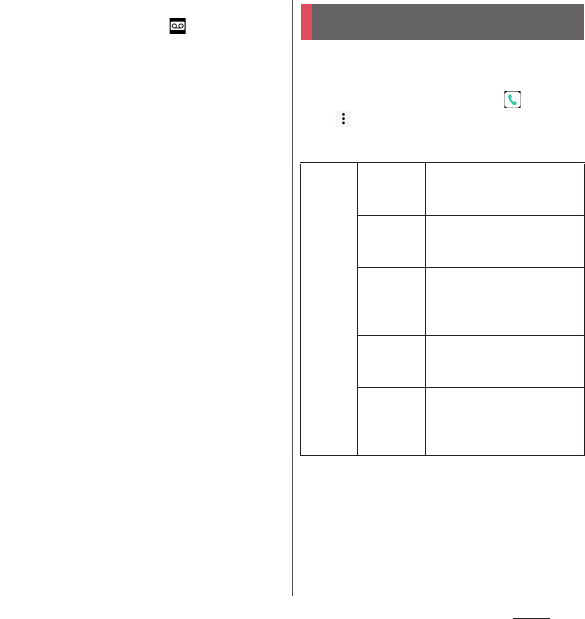
97
Phone
❖
Information
・
If there is a recorded message, is displayed in the
status bar. Drag the status bar downwards
u
Tap the
notification of the Answering Machine to display the
Messages screen and you can check the recorded
messages.
・
To delete recorded message, touch and hold a
message
u
Tap [Delete]/[Delete all]
u
[OK].
・
The number of messages that can be stored
depends on the amount of available memory on
your terminal.
You can set the network services, set call
rejection, or edit Reject call with message.
1
From the Home screen,
u
Tap
.
2
[Call settings].
Call settings
Network
service
Voicemail
service
*1
Record caller's message
when you cannot answer an
incoming call.
Call
forwarding
service
*1
Forward a call when you
cannot answer an incoming
call.
Call
Waiting
*1
Put the current call on hold
and answering an incoming
call or making a call to
another party.
Caller ID
notification
Notify the display of the other
party's phone of your phone
number when calling.
Nuisance
call
blocking
service
Register phone numbers of
nuisance call to reject.
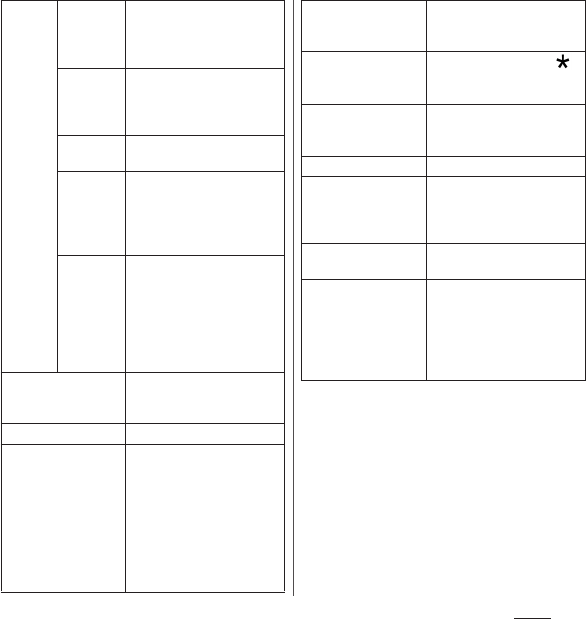
98
Phone
*1 Not available for video calls.
*2 Not displayed if a docomo nano UIM card is not
inserted.
Network
service
Caller ID
display
request
service
Answer calls without phone
number with guidance to
request caller ID display.
Call
notification
Notify incoming calls by
message (SMS) while the
power is off or you are out of
service area.
English
guidance
Switch the voice guidance to
English or Japanese.
Remote
operation
settings
Set to operate Voice Mail
Service or Call forwarding
Service using land-line
phone, public phone or
DOCOMO mobile phone, etc.
Public
mode
(power
OFF)
setting
While the terminal is OFF or
in Airplane mode, a guidance
message indicating that the
receiver cannot answer the
call is heard on the caller's
terminal and then the call
ends.
Roaming settings
Set to reject incoming calls
overseas or use roaming
guidance (P.210).
Answering Machine
P. 9 6
Call Blocking
Set whether to reject
incoming calls for numbers
not in the phonebook,
private, from a pay phone, or
unknown.
You can block the calls and
messages (SMS) from the
registered phone number
with "Block numbers".
Reject call with
message
Edit/set a message (SMS) to
be sent when rejecting an
incoming call (P.92).
Sub address settings
Set whether to identify " "
in phone number as a sub
address separator.
Prefix settings
Register a prefix number
added before phone number
when making a call.
Suguden setting
P. 9 9
Contact docomo
*2
Make a call to General
Inquiries, inquiries for
damage, theft or loss
overseas or damage overseas.
Calling accounts
Set Internet phone (SIP)
account.
Extension line service
setting
Make settings to use the
Office Link holding and
forwarding line service.
The Office Link is an
extension line service for
corporate customer.
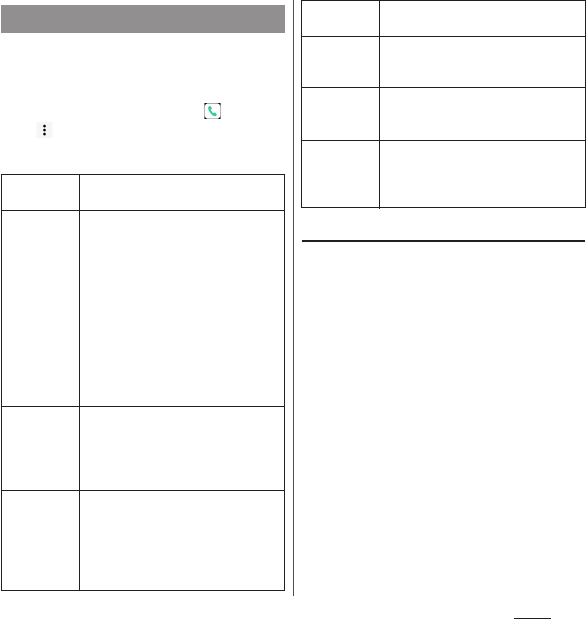
99
Phone
Make settings for "Suguden" which allows
you to operate phone with the motions and
the voice command.
1
From the Home screen,
u
Tap
.
2
[Call settings]
u
[Suguden setting].
Notes on using Suguden
・
Suguden allows you to operate the phone by
the motions of the terminal or the voice
commands, but the function does not work
properly in the following situations.
- When using speakerphone
- When using earphones or a headset
- When connected to a Bluetooth device that
supports calling function
- When making or receiving an additional call
during a call
- While lying down
- When you perform vigorous exercise such
as running, going up and down stairs, etc.
- The display is covered with a book type
smartphone case etc.
Suguden setting
Answer
Set whether to answer calls by holding
up the terminal to ear.
Disconnect
(Motion/
Voice
command)
Set whether to end a call by motion or
voice command.
When the "Motion" is ON, a call can be
disconnected by placing the terminal
horizontally with the screen faced
down while calling, or by shaking the
terminal twice.
When the "Voice command" is ON, a
call can be disconnected by saying the
disconnect keyword while calling and
then detaching your ear from the
terminal.
Call
Set whether to make a call to the other
party that is registered in advance or
saved to call history by shaking the
terminal once with the Home screen
displayed and then holding up to ear.
Mute, Reject
Set whether to reject calls by placing
the terminal horizontally with the
screen faced down while a call is
incoming, or shaking the terminal
twice. You can select from "Mute",
"Reject", or "Reject and send SMS".
Call ranking
Check the other party whom you
called many times.
Hide the
name when
receiving
Set whether to hide the names of
people registered to the phonebook
when receiving their calls.
Sending of
use
information
Set whether to send your user
information to DOCOMO via Suguden.
Disable
Suguden
during
roaming
Set whether to disable the settings for
Suguden when you stay abroad.

100
Phone
・
If the terminal is placed within a bag or pocket
while on the incoming call screen, calls may
be answered or disconnected for the rare
occasion because that is recognized as
motion performance.
・
The proximity sensor does not respond well
to black objects.
When answering calls, if you press the
earpiece over your hair, the proximity sensor
may have trouble working and may cause
failure to answer the call. In this case, please
press the earpiece directly to your ear.
When disconnecting/rejecting a call, flipping
over the terminal on a black desk, etc. may
cause the operation to fail (cannot
disconnect/reject). In this case, instead of
placing the terminal directly on the surface,
flip over the terminal about 1 cm above the
desk etc. to operate (disconnect/reject).
Functions of Suguden
●
Dialing
A Suguden call can be made from the
Home screen or the lock screen (when
"Screen lock" is set to "None" or "Swipe").
●
Hide the name when receiving
Suguden does not support video calls, but
the "Hide the name when receiving" setting
is compatible with video calls.
●
Mute, Reject
When "Mute, Reject" is ON, a call may be
rejected if you shake the terminal strongly
even just once when the call is incoming
because the action is recognized as a
motion performance.
●
Disconnect (Motion/Voice command)
When "Disconnect" is ON and the
disconnect operation is performed (motion
/disconnect keyword), a call will be
disconnected even in the following
situations.
・
When the other party puts the call on hold
・
When the Answering Machine is activated
(playing back the greeting/recording a
message)

101
Phone
●
Disconnect (Motion)
・
When disconnecting a call with Suguden
motion, it may not react (disconnect) if
the speed of motion for placing the
terminal facing down is fast. In that case,
try the motion slowly to react
(disconnect).
・
When "Disconnect" is ON, a call may be
disconnected if you shake the terminal
strongly even just once during the call
because the action is recognized as
motion performance.
●
Disconnect (Voice command)
・
While calling with Disconnect (Voice
command) ON, an application using the
microphone or a voice recording
application using the voice sound during
a call may not be available. For using the
voice recording application during a call,
turn off the setting of disconnection by
voice command.
・
When the Answering Machine is activated
(playing back the greeting/recording a
message), disconnection by voice
command is unavailable. In the case that
you answer a call while recording with the
Answering Machine, disconnection by
voice command is available.
・
For calls using "Hanashite Hon'yaku",
disconnection by voice command is not
available.
・
Although the voice command function of
Suguden uses the voice recognition
technology or the language processing
technology, DOCOMO is not liable for any
accuracy of those technologies.
・
The voice recognition may fail when the
volume of voice is too small during a call
or calling under a noisy environment, or
depending on the way of utterance.
●
Disable Suguden during roaming
Suguden is disabled automatically in
overseas by default setting. To use Suguden
in overseas, turn off the "Disable Suguden
during roaming".
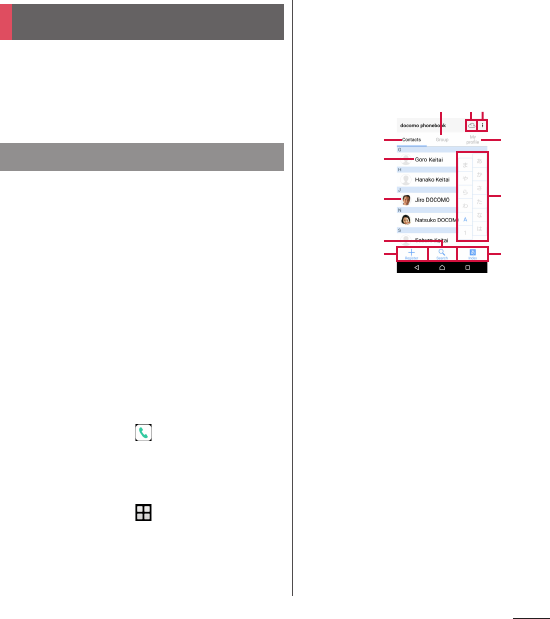
102
Phone
On the phonebook, you can enter various
information for contacts, for example, phone
numbers, mail addresses and various service
accounts.
1
From the Home screen, [
ドコモクラ
ウド
(docomo cloud)]
u
[docomo
phonebook]
u
"Contacts" tab.
・
The phonebook list screen appears.
❖
Information
・
To use cloud service for the phonebook, "docomo
phonebook" application is needed. When you use
the "docomo phonebook" for the first time
(including after resetting the application) or log in to
cloud from the "docomo phonebook", the "Use of
Cloud" screen appears and you can start using cloud.
・
Cloud service for docomo phonebook is not
available when user is switched to the other than the
owner.
・
From the Home screen,
u
Tap [Phonebook] to
display the phonebook list.
・
Use docomo Data Copy application to back up/
restore the phonebook data to/from a microSD card
(P.155).
・
From the Home screen,
u
Tap [Contacts] to
activate Xperia
™
phonebook.
■
Phonebook list screen
On the phonebook list screen, you can view
details of your contacts. You can add a
photo or image to a phonebook entry, and
display phonebook entries by group.
a
Group tab
・
Display the phonebook group.
b
Cloud
・
Log in to cloud ("Use of Cloud" screen is
displayed) or log out of cloud ("Suspend sync"
screen is displayed).
c
Option menu
d
Contacts tab
e
Name registered in the phonebook entry
・
Tap to display the profile screen.
f
Photo/image set in the phonebook entry
g
Search
h
Register
i
My profile tab
・
Check your own phone number.
j
Index character area
・
Tap index character to display phonebook entries
allocated to the index character.
Phonebook
Displaying phonebook
k
d
b
f
g
e
a
h
i
c
j

103
Phone
k
Index
・
Display the index character to search entries in
the order of Japanese syllabary, alphabet, etc.
Adding a new phonebook entry
1
From the Home screen, [
ドコモクラ
ウド
(docomo cloud)]
u
[docomo phonebook]
u
Tap
"Contacts" tab
u
[Register].
2
On the profile edit screen, enter
necessary information such as
name.
・
To add items, tap [Add other items].
3
[Save].
❖
Information
・
The contacts are listed in the order of Japanese
syllabary of the reading of last name or first name
and alphabet of last name or first name. If the
reading field is vacant, the contacts are displayed in
the order of Japanese syllabary of last name or first
name and alphabet of first name or last name,
however last name and first name in Kanji are
displayed in "
他
(other)" field.
・
Alphabet (one-byte) last and first name are displayed
in the order of first name - last name.
Making a call/video call from the
phonebook
1
From the Home screen, [
ドコモクラ
ウド
(docomo cloud)]
u
[docomo phonebook]
u
Tap
"Contacts" tab
u
Select a
phonebook entry you want to
make a call to.
2
On the profile screen, tap a phone
number.
3
[Call]/[Video call].
Editing a phonebook entry
1
From the Home screen, [
ドコモクラ
ウド
(docomo cloud)]
u
[docomo phonebook]
u
Tap
"Contacts" tab
u
Select a
phonebook entry to edit.
2
On the profile screen, [Edit].
3
Select a required item and edit.
4
[Save].
Managing phonebook
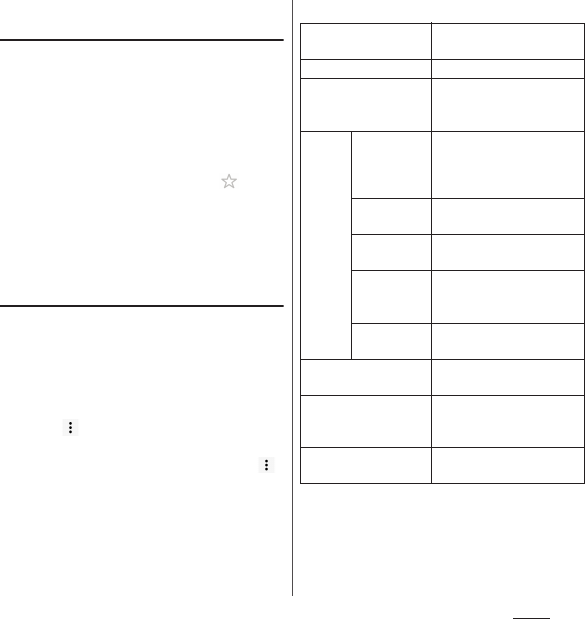
104
Phone
Registering a phonebook entry to
Favorites
1
From the Home screen, [
ドコモクラ
ウド
(docomo cloud)]
u
[docomo phonebook]
u
Tap
"Contacts" tab
u
Select a
phonebook entry to add to
Favorites.
2
On the profile screen, tap .
❖
Information
・
To display phonebook entries added to Favorites, on
the phonebook list screen, tap "Group" tab
u
[Favorites].
Using optional menu
1
From the Home screen, [
ドコモクラ
ウド
(docomo cloud)]
u
[docomo
phonebook]
u
Tap "Contacts" tab/
"My profile" tab.
2
On the Contacts/My profile screen,
tap .
・
On the Contacts screen, select a
contact
u
On the Profile screen, tap
to display the option menu of the
profile screen.
■
Phonebook list screen
*1 Signing in to cloud is required.
*2 Subscription to i-concier is required.
Delete contact
Select and delete several/all
phonebook entries.
Cloud menu
*1
Display cloud menu.
SD card/SIM card/
common
Export/import phonebook
entries or send them via
Bluetooth or Email (P.106).
Settings International
use setting
for docomo
phonebook
Set for using docomo
phonebook overseas.
d ACCOUNT/
Wi-Fi settings
Set a d ACCOUNT to use
docomo services via Wi-Fi.
Contacts
display order
Set display order of
phonebook entries.
Accounts to
display
Set a phonebook to be
displayed in the phonebook
list screen.
i-concier
menu
*2
Set the phonebook support
function for i-concier.
Help
Display Help of docomo
phonebook.
Number of registered
contacts
Display the number of
contacts registered to each
account.
About
Display version etc. of
docomo phonebook.

105
Phone
■
Profile screen
■
My profile screen
Setting phonebook entries to Group
1
From the Home screen, [
ドコモクラ
ウド
(docomo cloud)]
u
[docomo phonebook]
u
Tap
"Group" tab.
2
Tap a group.
3
[Add member]
u
Mark phonebook
entries to add
u
[OK]
u
[OK].
❖
Information
・
To cancel group setting, in Step 3, [Delete member]
u
Mark phonebook entries
u
[OK]
u
[OK].
・
When you set Google account etc., display groups by
account. You can set/cancel group in the same
account.
Creating a new group in the
phonebook
1
From the Home screen, [
ドコモクラ
ウド
(docomo cloud)]
u
[docomo phonebook]
u
Tap
"Group" tab.
2
[Add group].
3
On the group adding screen, select
the account and enter account,
group name, icon, color
u
[OK].
・
The items vary depending on the
account type.
❖
Information
・
Groups in docomo account can be sorted. To do so,
tap [Sort] in Step 2 and follow the onscreen
instructions.
・
Groups added to your docomo account, as well as
your Google account, etc. can be edited/deleted. To
edit/delete a group, touch and hold a group
u
[Edit
group]/[Delete group].
Share
Send a displayed phonebook
entry with Bluetooth function,
Email, etc.
Delete
Delete a displayed phonebook
entry.
Set ringtone
Set a ringtone for displayed
phonebook entry.
Join/Separate
Join/separate displayed
phonebook entry.
Send My profile
If you change the My profile
content, send the changed
content to mail addresses that
are registered to the docomo
phonebook all at once.
Share
Send a content saved to My
profile using Bluetooth
function, Email, etc.

106
Phone
Checking My profile and editing
information
1
From the Home screen, [
ドコモクラ
ウド
(docomo cloud)]
u
[docomo
phonebook]
u
Tap "My profile" tab
u
[Edit].
2
On the My profile screen, enter
necessary information such as
name.
3
[Save].
Phonebook entries can be imported from a
microSD card or docomo nano UIM card, or
exported to a microSD card. This is useful, for
example, when you want to move the
contact information to another phone. Also,
sending all phonebook data via Bluetooth
function, Email, etc. is available.
・
To backup to/restore from a microSD card, use
docomo Data Copy (P.155).
・
You can also use a synchronization service for
synchronizing your phonebook (P.188).
・
For exporting to/importing from a microSD
card, insert a microSD card in advance (P.34).
1
From the Home screen, [
ドコモクラ
ウド
(docomo cloud)]
u
[docomo phonebook]
u
Tap
"Contacts" tab
uu
[SD card/SIM
card/common].
2
Select an item.
・
When [Send all data (common)] is
tapped, confirm the displayed content
and the drag the status bar
u
Tap
[Finished exporting contacts.] and
select the application to send.
・
After this step, follow the onscreen
instructions.
Importing/Exporting/Sharing
phonebook entries
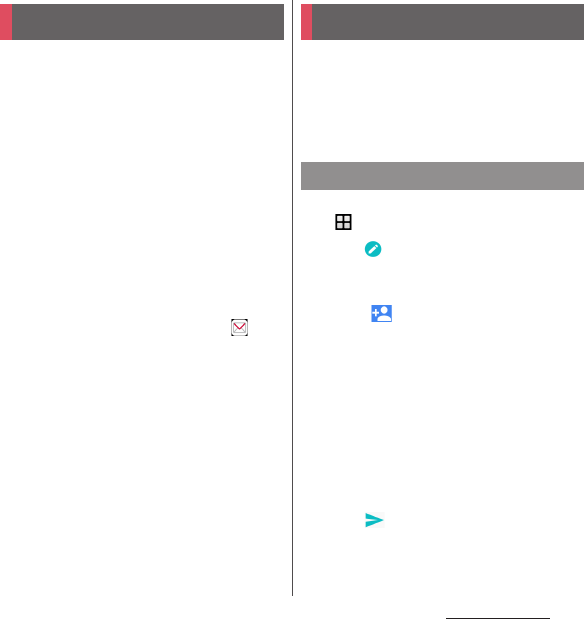
107
Mail/Web browser
Mail/Web browser
Send/receive mails using DOCOMO mail
address (@docomo.ne.jp).
Data can be easily transferred when
changing models or restored when you have
lost the terminal since sent and received
mails are saved on the docomo mail server.
Also, your d ACCOUNT allows you to use the
same email address to send, receive, and
view email on several devices, such as tablets
and computers.
For details of docomo mail, refer to NTT
DOCOMO website.
https://www.nttdocomo.co.jp/service/
docomo_mail/ (in Japanese only)
1
From the Home screen, tap .
・
After this step, follow the onscreen
instructions.
You can send/receive text message to/from a
mobile phone number as a recipient.
For details of available number of characters
etc., refer to "Short Message Service (SMS)"
on NTT DOCOMO website.
1
From the Home screen,
u
[Messaging].
2
Tap (Write new message).
3
Enter the recipient's phone
number.
・
Tap to select a contact from the
registered contacts. Tap [Index] to
search contacts from the index
character.
4
[Write message]
u
Enter a message.
・
When the number of entered
characters comes close to a limit, a
number of enterable characters
appears on the lower right of the text
box.
5
Tap (Send).
docomo mail Message (SMS)
Sending message (SMS)
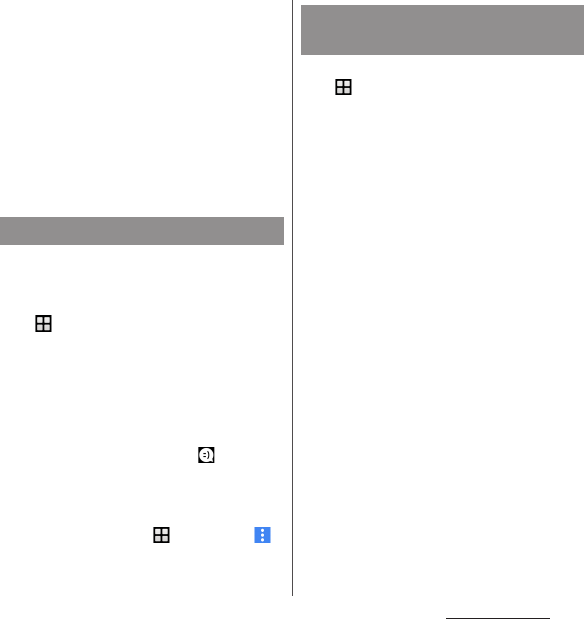
108
Mail/Web browser
❖
Information
・
You can also send/receive text messages to/from
customers of overseas network operators. Refer to
NTT DOCOMO website for details on the countries
and overseas network operators that provide this
service.
・
To send SMS to users of overseas network operators,
enter "+", "Country code" and then "the recipient
mobile phone number". Enter the phone number
without a leading "0", if any. Alternatively, enter "010",
"Country code" then "the recipient mobile phone
number" in order.
Sent/received message (SMS) is displayed in
thread by recipient/sender.
1
From the Home screen,
u
[Messaging].
・
Senders with unread messages (SMS)
are displayed in bold font.
2
Select a sender whose messages
(SMS) you want to read.
❖
Information
・
When you receive a message (SMS), appears on
the status bar. Drag the status bar downwards to
read the received message (SMS).
・
Touch and hold a message (SMS)
u
Tap [Add star] to
add a star. To check starred messages (SMS) in a list,
from the Home screen, tap
u
[Messaging]
u
u
[Starred messages].
1
From the Home screen,
u
[Messaging].
2
Tap an image part for a phone
number to save
u
[SAVE].
3
[Add new contact]/[Add to the
existing contact].
・
When "Add to the existing contact" is
selected, select a contact to save to.
4
On the profile edit screen, enter
necessary information such as
name
u
[Save].
❖
Information
・
If the sender is already saved in the phonebook, you
can tap photo or image part in Step 2 to check the
registered information in the phonebook.
Reading message (SMS)
Saving phone number of
message (SMS) to phonebook
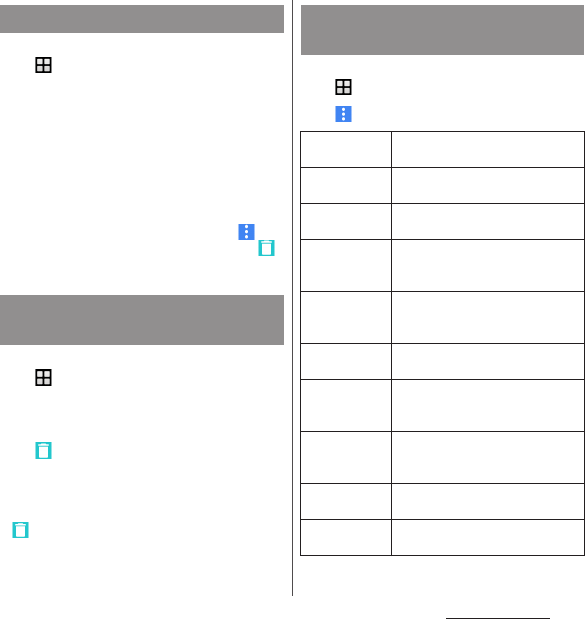
109
Mail/Web browser
1
From the Home screen,
u
[Messaging].
2
Select a sender/recipient whose
messages (SMS) to delete.
3
Touch and hold a message (SMS) to
delete.
4
[Delete message]
u
[DELETE].
❖
Information
・
To delete several messages (SMS), in Step 3,
u
[Delete messages]
u
mark the messages (SMS)
u
u
[DELETE].
1
From the Home screen,
u
[Messaging].
2
Touch and hold a sender/recipient
you want to delete.
3u
[DELETE].
❖
Information
・
To delete messages (SMS) of several senders and
recipients, in Step 3, mark the senders/recipients
u
u
[DELETE].
1
From the Home screen,
u
[Messaging].
2u
[Settings].
* With silent mode (Mute) turned on, the terminal does
not vibrate when receiving messages (SMS).
Deleting a message (SMS)
Deleting messages (SMS) by
sender/recipient
Changing settings for
Messaging (SMS)
Notification
sound
Set notification sound for receiving.
Notifications
Set whether to show message (SMS)
arrival notification in the status bar.
Notification
vibration
*
Set whether to notify with vibration
when receiving.
Notification
light
Set whether to notify with the
notification LED for receiving when
the backlight is turned off.
Delivery report
Set whether to mark to the
messages (SMS) that you send when
the recipient receives them.
Default SMS
app
Set a default messaging application.
Blocked
numbers
Set whether to block the incoming
calls and messages (SMS) from the
registered phone number.
Cost saving
Set whether to convert the special
characters for foreign countries to
send more text.
SIM messages
Manage messages (SMS) saved to a
docomo nano UIM card.
SMS center
number
Check SMS center number.
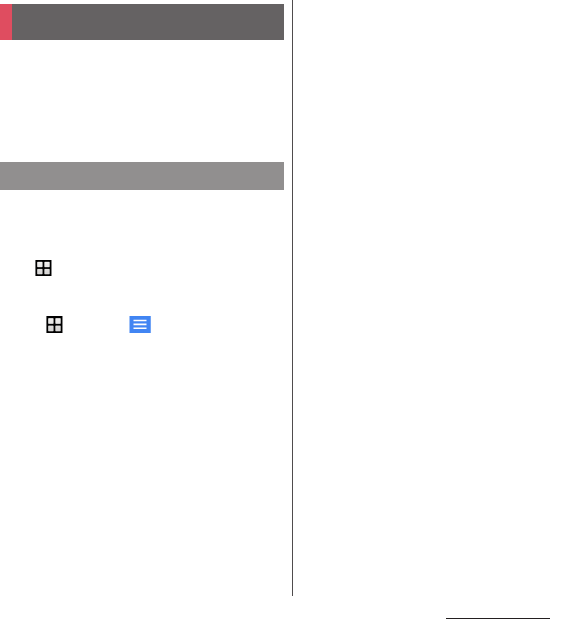
110
Mail/Web browser
You can add a POP3 or IMAP compatible
email account provided by general provider,
or an Exchange ActiveSync account to send
or receive email.
You can set multiple Email accounts.
Set an Email account following the onscreen
instructions.
1
From the Home screen,
u
[Email].
・
To set a second or subsequent email
account, from the Home screen,
u
[Email]
uu
[Settings]
u
Tap
[Add account].
2
Enter an email address
u
[NEXT].
3
Enter a password
u
[NEXT].
・
To set up an email account manually,
tap [MANUAL SETUP] and follow the
onscreen instructions.
4
Follow the onscreen instructions
to configure necessary items
u
Tap
[NEXT] to finish the setting.
・
If the screen for selecting type of
account appears, tap the type of the
email account and follow the onscreen
instructions to set.
5
Enter your account name and the
name to be displayed in your
outgoing emails
u
[FINISH SETUP].
・
Inbox for set email account appears.
❖
Information
・
If you need to make the settings manually, contact
your email service provider or system administrator
for the correct email account settings.
・
If you set an Exchange ActiveSync account as an
email account, and if server manager sets Remote
wipe, the data saved in the terminal may be deleted.
Email
Making initial setting for Email
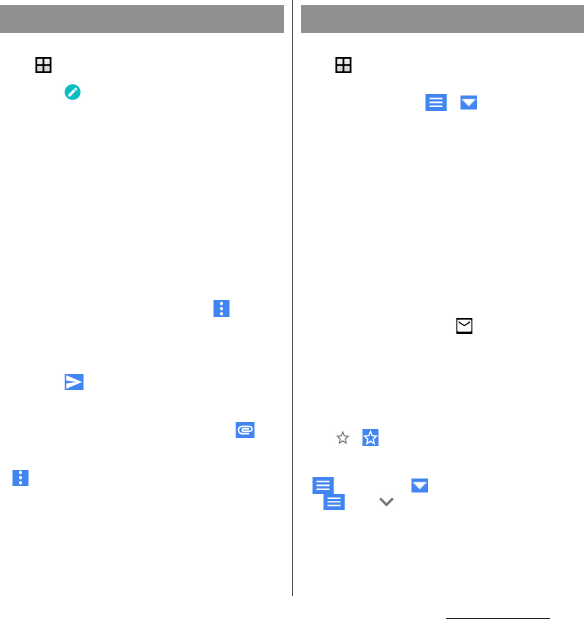
111
Mail/Web browser
1
From the Home screen,
u
[Email].
2
Tap (Write new message).
3
Enter the email address of
recipient.
・
When you enter a name or email
address in the email address field,
contacts matched to the entered
numbers or letters are listed.
・
To enter multiple email addresses in
characters directly, separate with a
comma (,) or a space input and then
enter the next email address.
・
To add Cc or Bcc recipients,
u
Mark
"Show Cc"/"Show Bcc".
4
Enter a subject and message.
5
Tap (Send).
❖
Information
・
To attach a file, while creating an email, tap and
select a file.
・
To save an email as draft, when creating an email, tap
u
[Save as draft] or change screen to another one.
・
Email is handled as an email from a PC. Your email
cannot be received if rejecting emails from PCs is set
on a recipient terminal.
1
From the Home screen,
u
[Email].
・
If you have set up more than one email
account, tap
uu
Tap the email
account to receive the emails.
2
On the Inbox, flick the screen
down.
・
This refreshes the Inbox.
3
Tap an email you want to read.
❖
Information
・
The sender name of a received email is the name set
on sender's terminal.
・
If you specified "Notification" in the email account
settings (P.113) and set "Check frequency" to an
option other than "Manual", appears in the status
bar to notify you when you have received a new
email. Drag the status bar downwards to read the
received email.
・
Tap an address of received email to register the
address to the phonebook. For addresses already
registered, displaying phonebook entries is available.
・
Tap / in the Inbox or the email message
window to highlight the star and add the email to
the "Starred" filter. To see a list of starred emails, tap
in the Inbox
uu
Tap the email account
uu
Tap of "Filters"
u
[Starred].
Creating and sending email Receiving and reading email
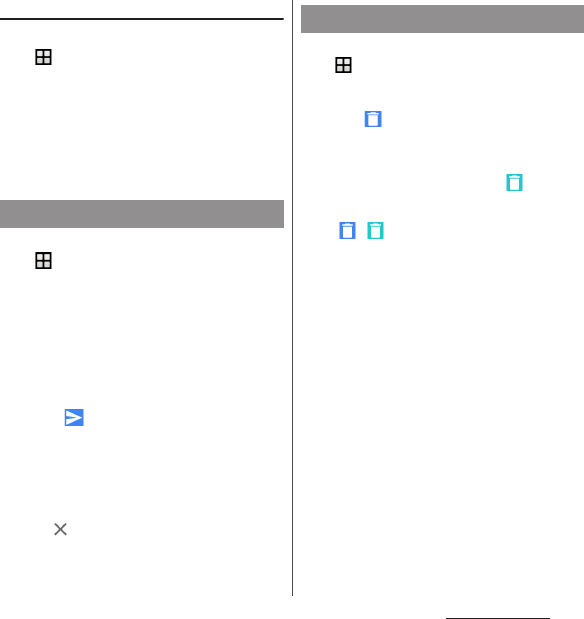
112
Mail/Web browser
Saving attachment file of email
1
From the Home screen,
u
[Email].
2
Tap an email with attached files.
・
When attached file is not loaded, tap
[LOAD].
3
Tap [SAVE] of file
u
Select a saving
destination
u
[SAVE].
1
From the Home screen,
u
[Email].
2
Tap an email to reply or forward
u
Tap any of [REPLY]/[REPLY ALL]/
[FORWARD].
・
When you tap [FORWARD], enter an
email address to forward to.
3
Enter a message.
4
Tap (Send).
❖
Information
・
To delete the original email content, unmark "Quoted
text".
・
When you forward an email, the attachment file of
the original message is attached. To delete attached
file, tap .
1
From the Home screen,
u
[Email].
2
Tap an email to delete.
3
Tap .
❖
Information
・
To delete more than one email, in Step 2, touch and
hold an email
u
Mark the emails
u
Tap .
・
If "Delete confirmation" is ON in the Settings for
"Email" application, the confirmation screen appears
after / is tapped. Tap [DELETE].
Replying/Forwarding email
Deleting email
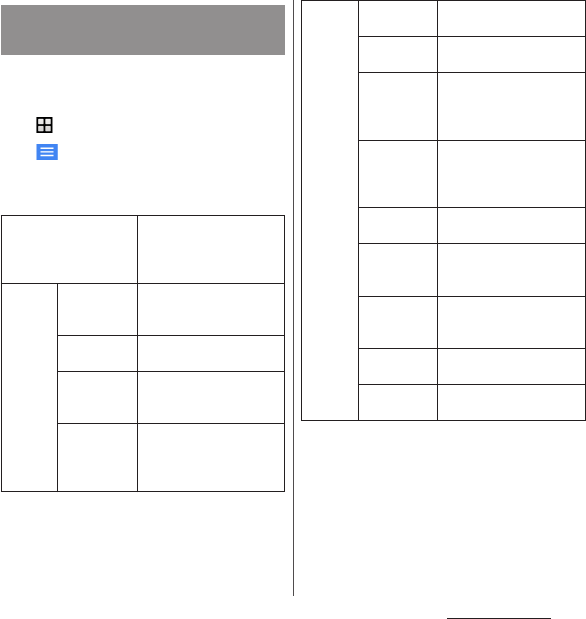
113
Mail/Web browser
<Example> Setting up an email account that
supports IMAP
1
From the Home screen,
u
[Email].
2u
[Settings].
3
Tap an Email account you want to
change the settings for.
* With silent mode (Mute) turned on, the terminal does
not vibrate when receiving emails.
❖
Information
・
The items vary depending on the account type.
・
If you set "Check frequency" to an option other than
"Manual", and you are using a pay-as-you-go data
communication plan, packet communication
charges may apply every time you check for new
emails.
Changing Email account
settings
Notification
Configure Status bar
notification, Notification
sound, Vibrate
*
, and
Notification light settings.
Sync
settings
Check
frequency
Set how often the Email
application checks for new
emails.
Days to sync
Set a period of emails for
sync.
Auto
download
attachments
Set whether to download
attached file automatically
when connecting via Wi-Fi.
Pre-
download
limit
Set whether to download
whole email including the
message text before the
email is opened.
General
settings
Account
name
Change account name.
Your name
Change your name (sender
name).
Incoming
settings
Specify a username,
password, and other
settings for the incoming
server.
Outgoing
settings
Specify a username,
password, and other
settings for the outgoing
server.
Signature
Change your signature or
specify how to insert it.
Quick reply
Register phrase that can be
inserted when creating an
email.
Security
Select certifications, set
digital signature or
encryption.
Temporar y
files
Delete temporary files.
Delete
account
Delete Email account.
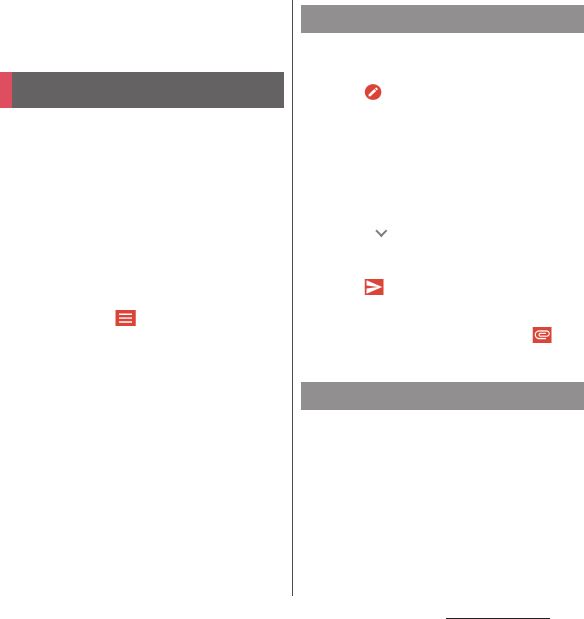
114
Mail/Web browser
・
You can change the settings for the "Email"
application with the setting items displayed below
the account in Step 3.
You can use the email services provided by
Google or by general providers.
・
Set up your Google account (P.187) or email
account by following the onscreen
instructions, if you have not already done so.
・
If you do not synchronize Gmail after Google
account is set, "Account not synced" screen
appears. Follow the onscreen instructions.
❖
Information
・
For details on Gmail, from the Home screen, tap
[Google]
u
[Gmail]
uu
[Help & feedback] to see
Gmail Help.
1
From the Home screen,
[Google]
u
[Gmail].
2
Tap (Compose).
3
Enter the email address of
recipient.
・
When you enter a name or email
address in the email address field,
contacts matched to the entered
numbers or letters are listed.
・
Tap to add Cc or Bcc recipients.
4
Enter a subject and message.
5
Tap (Send).
❖
Information
・
To attach a file, when creating a Gmail, tap
u
[Attach file] and select the file.
1
From the Home screen,
[Google]
u
[Gmail].
2
On the Inbox, flick the screen
down.
・
This refreshes the Inbox.
Gmail
Sending Gmail
Refreshing Gmail

115
Mail/Web browser
Area Mail is a service which allows you to
receive earthquake early warning or tsunami
warning, emergency warning related to
weather etc. delivered by the Meteorological
Agency, and disaster/evacuation information
delivered by the national government or
local governments without being influenced
by congestion.
・
Area Mail is a free service for which
subscription is not required.
・
Area Mail cannot be received in the following
case.
- During a voice call (except for VoLTE voice
calls)
- Out of service area
- While power is off
- During International roaming
- During Airplane mode
- When software is being updated
- When a SIM other than by DOCOMO is
inserted
- While sending/receiving a message (SMS)
・
Area Mail may not be received when
tethering is set or during packet
communications.
・
Area Mail (earthquake early warning) that
could not be received cannot be received
later.
Area Mail (tsunami warning, emergency
warning related to weather etc., disaster/
evacuation information) can be resent. In the
case you could not receive it, you can receive
it again.
A notification content screen appears and
you are notified by dedicated buzzer sound
or dedicated ringtone and vibration.
・
The buzzer sound and the ringtone cannot be
changed.
1
Receive Area Mail automatically.
2
The buzzer or the ringtone sounds.
3
A message of Area Mail appears
automatically.
Early Warning "Area Mail"
Receiving Early Warning "Area
Mail"
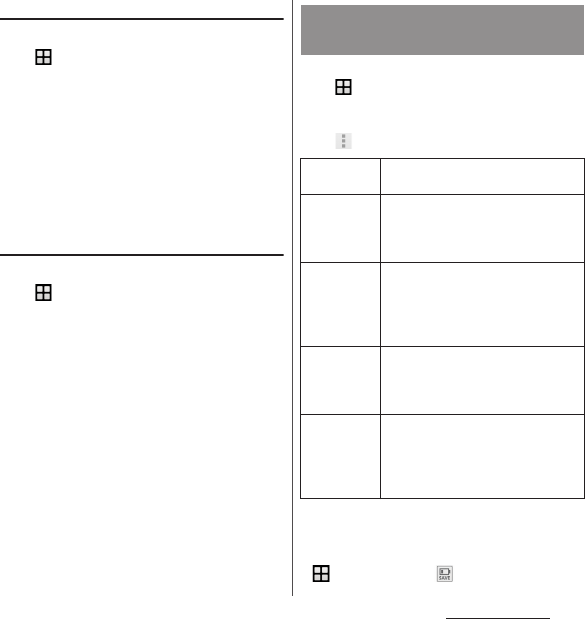
116
Mail/Web browser
Viewing received Area Mail later
1
From the Home screen,
u
[Disaster kit].
2
[Early Warning "Area Mail"].
3
Select an Area Mail from the Area
Mail list.
❖
Information
・
Up to 50 messages can be saved. If savable amount
of Area Mail exceeds the limit of maximum, the
oldest one is deleted in order.
Deleting Area Mail
1
From the Home screen,
u
[Disaster kit].
2
[Early Warning "Area Mail"].
3
Mark the Area Mail in the
list
u
[Delete]
u
[OK].
1
From the Home screen,
u
[Disaster kit].
2
[Early Warning "Area Mail"].
3u
[Settings].
* Not displayed when the language is set to English.
❖
Information
・
To set Emergency mode, from the Home screen,
u
[Disaster kit]
u
Tap (P.48).
Setting Early Warning "Area
Mail"
Receive
setting
Set whether to receive Area Mail.
Beep tone
Set the sounding time or the sound
volume for Area Mail reception, and
whether to sound a dedicated
ringtone even in silent mode.
Check screen
image and
beep tone
Check the ringtone and the screen for
reception of earthquake early warning,
tsunami warning, or disaster/evacuation
information (including emergency
warning related to weather etc.).
やさしい日本語
表示
(Simple
Japanese
display)
Set whether to display earthquake
early warning, tsunami warning in
simple Japanese.
翻訳・アプリ
連携設定
(Translation/
App link
setting)*
Set whether to translate the received
content or use the link with the other
applications.
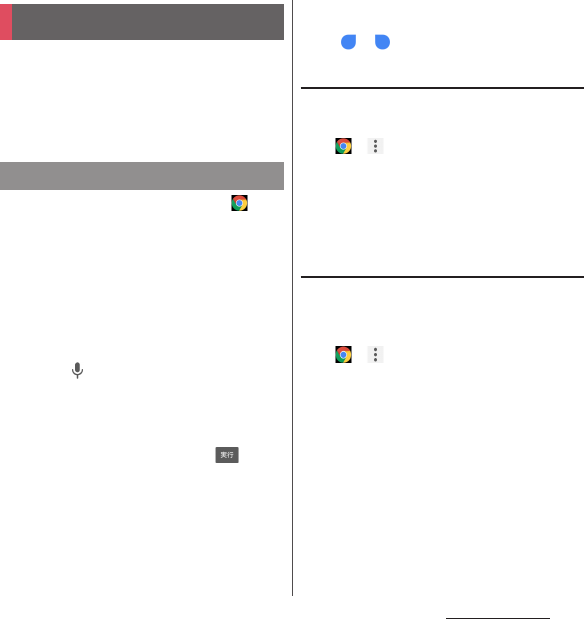
117
Mail/Web browser
Use "Chrome" application to view web pages
like on a PC.
You can use "Chrome" application via packet
communication and Wi-Fi network with the
terminal.
1
From the Home screen, tap .
2
Tap the web page address entry
field on the top of the screen.
・
When address entry field is not
displayed, flick down the screen to
display.
3
Enter a web page address or
keyword to search.
・
Tap for address entry field to enter
search words in voice sound.
・
As you enter an address or characters,
retrieved web pages list appears.
4
Select a candidate or tap on
the software keyboard.
・
To zoom-in/-out web pages, pinch-out/
-in or double-tap the screen.
・
To go back to the previous page, tap
b
.
❖
Information
・
To copy text on web page, touch and hold a text
u
Drag or to select a range of text
u
Tap [COPY ].
Adding a new tab
Open multiple tabs and view web pages.
1
From the Home screen,
uu
[New tab].
2
Display a web page.
・
A number in the icon next to the
address entry field indicates the
number of tabs that are opened.
Opening incognito tab
You can browse web pages without viewing
history and search history.
1
From the Home screen,
uu
[New incognito tab].
2
Display a web page.
❖
Information
・
Around address entry field is displayed in gray with
incognito tab.
・
To close an incognito tab, see "Closing a tab" (P.118).
・
Web pages opened with incognito tab are not
displayed in History. When the tab is closed, record of
Cookie etc. is erased. Downloaded files or
bookmarked web pages can be saved with incognito
tab.
Chrome
Displaying web pages
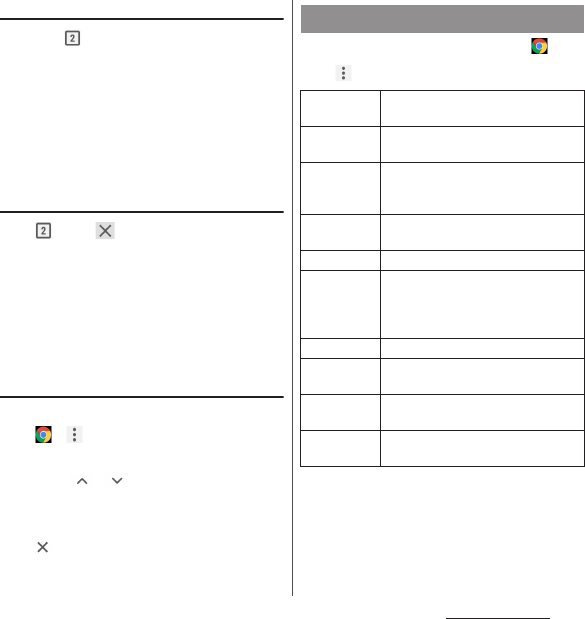
118
Mail/Web browser
Changing tabs
1
Tap .
・
Currently opened tabs are displayed
with thumbnails in a list.
2
Tap the tab.
❖
Information
・
A number in the icon explained in Step 1 varies by
the number of tabs that are opened.
Closing a tab
1u
Tap of tab you want to
close.
・
Alternatively, flick a tab left or right to
close it.
❖
Information
・
A number in the icon explained in Step 1 varies by
the number of tabs that are opened.
Searching text in a web page
1
From the Home screen,
uu
[Find in page].
2
Enter a search word.
・
Tap / to move the highlight to
the next/previous item.
❖
Information
・
Tap to close the search bar.
1
From the Home screen, tap .
2u
[Settings].
Changing Chrome settings
Sign in to
Chrome
Sign in to Chrome with your Google
account.
Search
engine
Set the search engine.
Autofill forms
Set an address or credit card
information to be used for the
automatic input.
Save
passwords
Set whether to save the passwords
entered to web pages.
Home page
Set the Home page.
Privacy
Set the display of suggestions for
navigation error or suggestions for the
address entry field, or clear the
browsing history data.
Accessibility
Set the font size or zooming.
Site settings
Make settings related to webpage
such as Cookie or Javascript.
Data Saver
Set whether to reduce data
communication amount.
About
Chrome
Check the versions of Chrome etc.
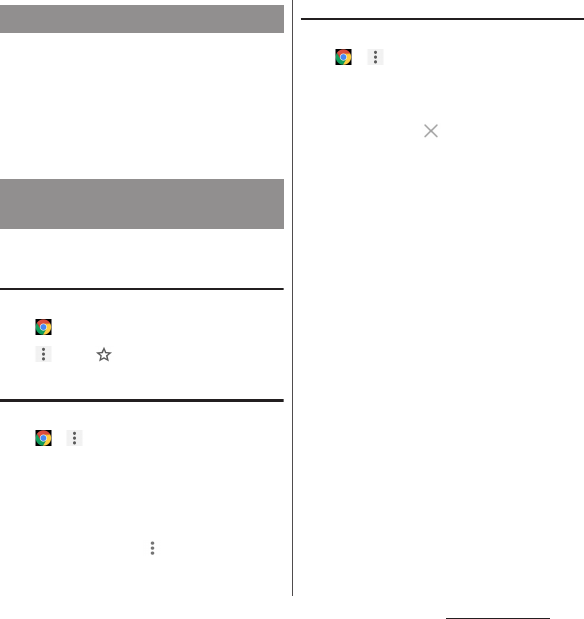
119
Mail/Web browser
Touch and hold a link or an image in a web
page to copy the URL or download the
image.
❖
Information
・
In some website, downloading of files etc. may not
be available.
You can check history, save bookmarks, etc.
Bookmarking a web page
1
From the Home screen,
u
Display a web page.
2u
Tap .
Opening a bookmark
1
From the Home screen,
uu
[Bookmarks].
2
Tap the bookmark you want to
open.
❖
Information
・
You can edit, delete, etc. a bookmark in the
bookmark list by tapping or touching and
holding a bookmark.
Checking history
1
From the Home screen,
uu
[History].
2
Tap a history to check.
❖
Information
・
To delete history, tap of history.
・
To delete all history, [CLEAR BROWSING DATA...]
u
Select a period to clear the data
u
Check that a
checkmark is put to "Browsing history", then tap
[CLEAR DATA].
Operating links
Managing bookmarks and
history

120
Apps
Apps
In dmenu, you can easily access sites
recommended by DOCOMO or convenient
applications.
1
From the Home screen, [d
メニュー
(dmenu)].
・
Browser is activated, "
dメニュー
(dmenu)" appears.
❖
Information
・
To use dmenu, Internet connection by packet
communication (LTE/3G/GPRS) or Wi-Fi is required.
・
For connecting dmenu and downloading
applications introduced in dmenu, packet
communication charge is applied separately. Some
applications automatically perform packet
communications.
・
Paid applications are included to the applications
introduced in dmenu.
dmarket provides a variety of services,
offering digital content, such as music,
videos, and books, and giving you access to a
shopping site, travel booking site, and other
sites.
1
From the Home screen, [dmarket].
❖
Information
・
For details on dmarket, refer to the following website.
https://d.dmkt-sp.jp/common/about/index.html (in
Japanese only)
d
メニュー
(dmenu) dmarket
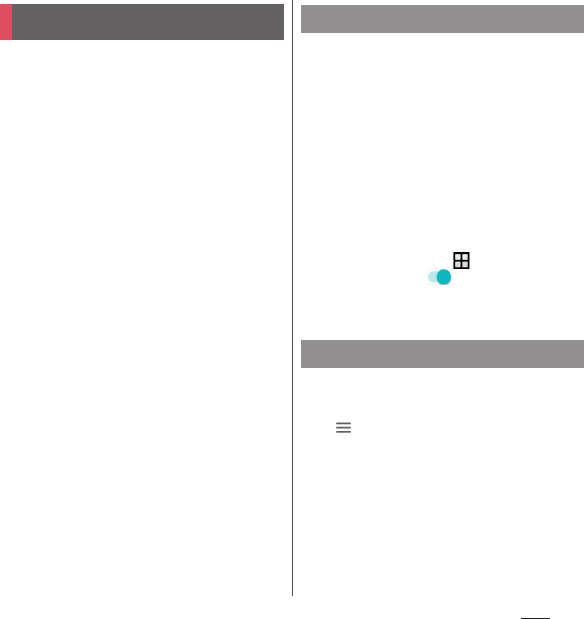
121
Apps
With Google Play, you can directly access
useful applications or fun games and you can
download and install them on the terminal.
・
To use Google Play, you need to set a Google
account (P.187).
・
For details on purchasing applications,
returning your purchases, or requesting a
refund, see Google Play Help.
・
Once you accept the installation of an
application, you will be held responsible for its
use. Be careful especially about applications
which access many functions or large amount
of data.
・
Make sure the security of application, then
install it at your own risk. The terminal may be
infected with a virus and the data may be
damaged.
・
NTT DOCOMO is not liable for any
malfunctions or disadvantage brought to you
or any third party due to application which
you installed and provided by a third party
including Google Inc.
・
For the application which you installed from
Play Store and provided by the third party
including Google Inc., contact each provider.
1
From the Home screen, [Play
Store].
2
Search applications
u
Tap an
application to install.
・
Check the displayed contents carefully
and follow the onscreen instructions.
❖
Information
・
Some applications automatically perform packet
communications. Packet communication is kept
active unless you disconnect it or the time-out error
occurs. To cut off packet communication manually,
from the Home screen, tap
u
[Settings]
u
[More]
u
[Mobile networks]
u
for "Mobile data traffic"
u
[OK].
・
Some applications may be updated automatically.
1
From the Home screen, [Play
Store].
2u
[My apps & games].
3
Tap the applications to uninstall
u
[UNINSTALL]
u
[OK].
・
When you uninstall a charged
application, a screen for refund may
appear. For details, see Google Play
Help.
Play Store
Installing an application
Uninstalling an application

122
Apps
This function allows you to use "
おサイフケー
タイ対応サービス
(Osaifu-Keitai compatible
service)" by which you can pay money or use
coupon, etc. or "
かざしてリンク対応サービス
(Kazashite-Link compatible service)" by
which you can access information by holding
the terminal over a home electric appliances
or smart poster.
You can save electronic money and points to
an IC card of the terminal and a docomo
nano UIM card to check the balance or points
on the screen.
Also, you can prevent from being used
without asking in case of theft or loss by
locking Osaifu-Keitai function.
For details on Osaifu-Keitai, see NTT
DOCOMO website.
・
Make settings from the dedicated website or
application to use Osaifu-Keitai compatible
services.
・
The data in the IC card
*1
or the docomo nano
UIM card
*2
may be lost or altered because of
the malfunction of the terminal (when we
repair your terminal etc., as we cannot keep it
with data remained, you are required to erase
the data by yourself). For support such as
reissuance, restoration, temporary
preservation or transfer of data, contact
Osaifu-Keitai compatible service providers.
For important data, be sure to use a service
with backup service.
・
To use Osaifu-Keitai compatible services that
utilize data on the docomo nano UIM card,
you need to install and configure the
appropriate application provided by the
Osaifu-Keitai compatible service provider. This
applies even if you plan to change the model
of your terminal and continue using your
current docomo nano UIM card.
・
If the data in the IC card or the docomo nano
UIM card is lost, altered or damaged by any
means related to Osaifu-Keitai compatible
service such as malfunction or model change,
DOCOMO assumes no responsibility for the
loss of data.
・
If the terminal is stolen or misplaced,
immediately contact Osaifu-Keitai
compatible service provider for an advice.
*1 Data saved in the IC card installed in the
Osaifu-Keitai compatible terminal
*2 Data stored on a docomo nano UIM card
Osaifu-Keitai
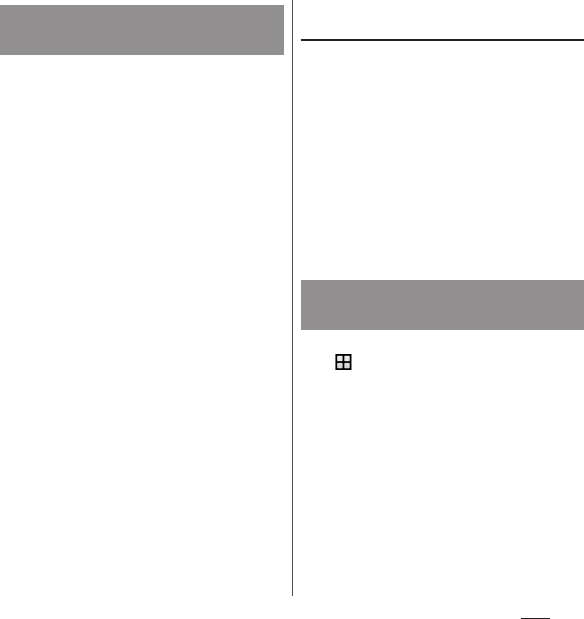
123
Apps
Please note the following when holding the
terminal over an IC card reader or NFC
module equipped device.
・
Bring the NFC / Osaifu-Keitai position close to
the device slowly without hitting it strongly.
・
Hold the NFC / Osaifu-Keitai position over the
center of the device and parallel to it. If
scanning fails even with it held in front of the
center of the scanner, slightly lift up the
terminal, or move it backwards/forwards or to
the left/right.
・
If there are metal objects between the NFC /
Osaifu-Keitai position for holding over and the
other device, scanning may fail. Putting the
terminal into a case or cover may affect
communication. In that case, remove the case
or cover.
NFC / Osaifu-Keitai position for
holding over
The position for holding over when using
NFC / Osaifu-Keitai is on the front of the
terminal.
1
From the Home screen,
u
[Osaifu-Keitai].
2
Select the service from the service
list.
・
Download an application compatible
with service site or service.
3
Hover the NFC / Osaifu-Keitai
position near the IC card reader.
Notes on holding over the
device
Using "Osaifu-Keitai
compatible service"
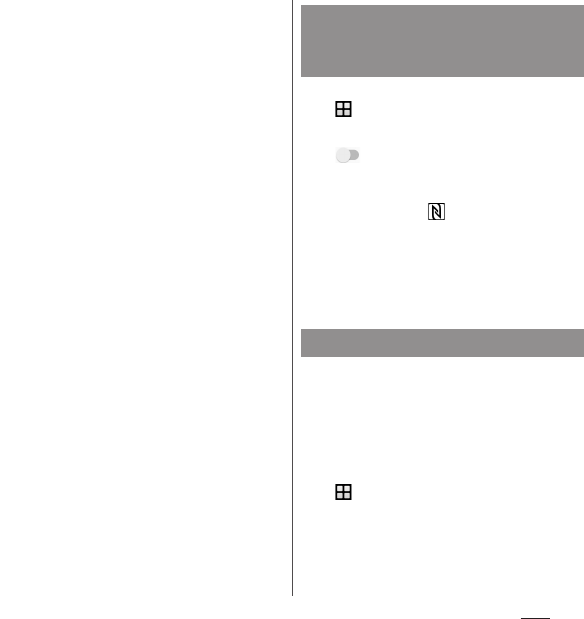
124
Apps
❖
Information
・
You can scan and write data to or from an IC card
reader without activating Osaifu-Keitai compatible
application.
・
These services are available even when the terminal
is off. However, they may not be available if the
terminal has been off for a long time or the battery is
too low.
・
The Osaifu-Keitai compatible application performs
communication which is necessary for providing the
Osaifu-Keitai service in the background regardless of
the setting of "STAMINA mode" (P.177) or "Data saver"
(P.162), and the packet communication charge may
be incurred.
・
Depending on your installed Osaifu-Keitai
compatible application or its settings, your terminal
may not respond even when you hover it over an IC
card reader if the screen is locked or if the screen
backlight of the terminal is off.
・
After the power of the terminal is turned on or the
terminal is restarted, cancel the screen lock and then
hold over a reader to use the Osaif-Keitai service.
・
You can use Osaifu-Keitai compatible service even
when the PIN code for docomo nano UIM card
cannot be unlocked or PIN locked.
・
Note that when you do not subscribe to sp-mode,
some functions of Osaifu-Keitai compatible service
may not be available.
1
From the Home screen,
u
[Settings]
u
[More].
2
[NFC / Osaifu-Keitai settings]
u
Tap
for "Reader/Writer, P2P"
u
[OK].
・
NFC Reader/Writer, P2P function is
enabled, and appears in the status
bar.
3
Hold the NFC / Osaifu-Keitai
position over a device with the
NFC module or a smart poster, etc.
Use "NFC / Osaifu-Keitai lock" settings to
restrict the use of Osaifu-Keitai function and
related services.
・
NFC / Osaifu-Keitai lock is different from
screen lock for the terminal, SIM card lock.
1
From the Home screen,
u
[Settings]
u
[More].
2
[NFC / Osaifu-Keitai settings]
u
[NFC / Osaifu-Keitai lock].
Using "
かざしてリンク対応サービ
ス
(Kazashite-Link compatible
service)"
Locking Osaifu-Keitai function
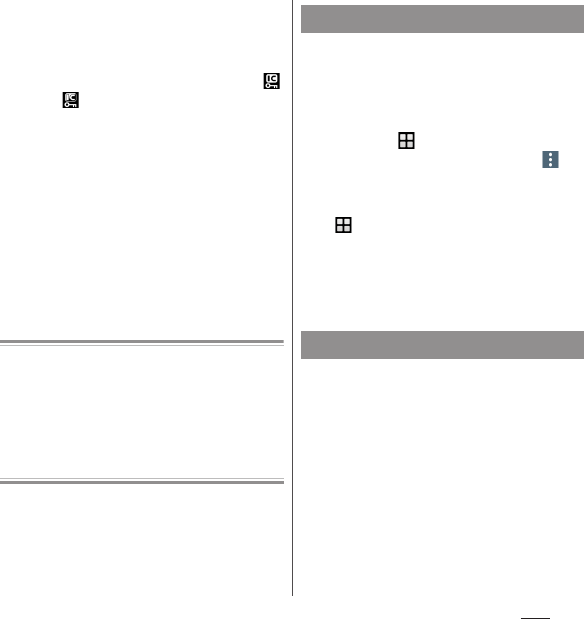
125
Apps
3
Enter a password
u
[NEXT].
・
When using "NFC / Osaifu-Keitai lock"
for the first time, enter a password to
set.
・
Osaifu-Keitai function is locked, and
or is displayed in the status bar.
❖
Information
・
Note that you cannot cancel "NFC / Osaifu-Keitai
lock", if the battery runs out while "NFC / Osaifu-Keitai
lock" is set. Be careful about remaining battery level.
If you cancel "NFC / Osaifu-Keitai lock", charge the
terminal before canceling.
・
You need to unlock to use Osaifu-Keitai menu while
"NFC / Osaifu-Keitai lock" is set.
・
"NFC / Osaifu-Keitai lock" password is not be deleted
even if you reset the terminal.
・
When unlocking "NFC / Osaifu-Keitai lock", insert the
same docomo nano UIM card as the one inserted
when "NFC / Osaifu-Keitai lock" was set, then unlock.
■
NFC
NFC is an abbreviation for Near Field
Communication and a short range wireless
communication method of international standard
defined by ISO (International Organization for
Standardization). You can use a contactless IC card
function, Reader/Writer function, P2P function, and
others.
You can set whether to enable or disable
Osaifu-Keitai compatible services or other
services that you can use by hovering your
terminal over an IC card reader.
・
For details on the Tap & pay feature, from the
Home screen,
u
[Settings]
u
[More]
u
[NFC
/ Osaifu-Keitai settings]
u
[Tap & pay]
u
u
Tap [Help] to see Tap & pay Help.
1
From the Home screen,
u
[Settings]
u
[More].
2
[NFC / Osaifu-Keitai settings]
u
[Tap & pay].
3
Select a service.
"iD" refers to electronic money offered by
docomo. Once you have set up "iD" on your
Osaifu-Keitai, you can hover the terminal over
an IC card reader at various shops to make
your shopping easier and more comfortable.
You can register the information of up to two
cards, and use either one depending on the
privilege.
・
To use iD with your Osaifu-Keitai, you need to
configure settings using the iD application.
・
The charges required for iD service (including
the annual charge) vary by card issuer.
Tap & pay
iD
アプリ
(iD application)
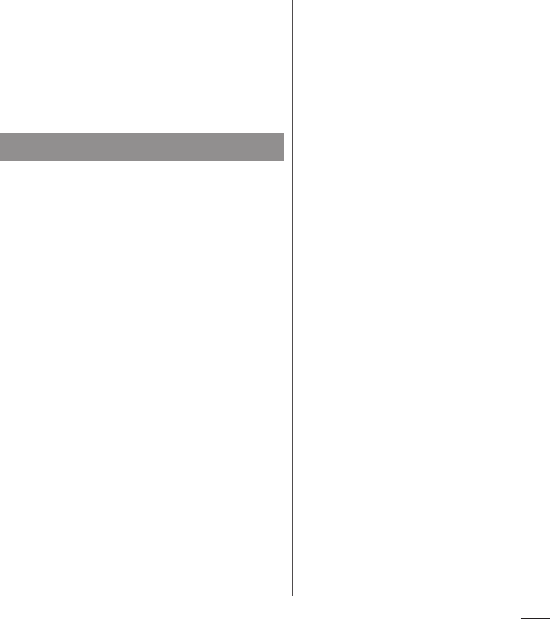
126
Apps
・
Setting up the iD application or checking its
information overseas will incur packet
communication charges that are different
from those in Japan.
・
For details on iD, refer to iD website.
http://id-credit.com/ (In Japanese only)
ToruCa application allows you to save
coupons offered by your favorite shops and
other useful information (ToruCa) to your
terminal. You can obtain ToruCa in various
ways, such as via email, Web download,
Bluetooth, or IC tags. You can easily update
your ToruCa.
For details of ToruCa, refer to NTT DOCOMO
website.
❖
Information
・
For obtaining, displaying or updating ToruCa, a
packet communication charge may be applied.
・
To obtain ToruCa via Bluetooth, you must turn on the
Bluetooth feature of the "ToruCa" application.
・
To obtain ToruCa from an IC tag, you must set
Reader/Writer, P2P (P.200) of the terminal to ON.
・
Depending on the settings of content provider, the
following functions may not be available.
- Updating/sharing ToruCa/displaying map/
obtaining from the IC card reader
・
You may not be able to obtain ToruCa with an IC card
reader, if you do not make initial setting for Osaifu-
Keitai.
・
The "ToruCa" application performs communication
which is necessary for obtaining ToruCa in the
background regardless of the setting of "STAMINA
mode" (P.177) or "Data saver" (P.162), and the packet
communication charge may be incurred.
・
ToruCa may not be obtained by using Bluetooth
function, an IC tag or a reader until the screen lock is
canceled after the terminal is started.
・
The backlight may be turned on when ToruCa is
received via Bluetooth function with the screen
backlight turned off.
ToruCa

127
Apps
TV is an application with which you can
switch between Full seg and 1Seg and watch
according to the air wave reception
condition. In addition, since the data
broadcasting can be received with images
and sounds, interactive service using
communication function of mobile devices
and receiving detailed information are
available.
With Full seg, you can watch a terrestrial
digital TV broadcasting service in high-vision
quality.
With 1Seg, you can watch a terrestrial digital
TV broadcasting service for mobile devices.
For details on "Full seg/1Seg" service, see the
following website.
The Association for Promotion of Advanced
Broadcasting Services
http://www.apab.or.jp/
Using Full seg/1Seg
Full seg and 1Seg are services provided by TV
broadcasting enterprises (stations), etc. A
communication fee for receiving video
picture and sound is not required. Contact
NHK for details on your NHK viewing fees.
There are 2 types of information displayed in
the data broadcasting area: "Data
broadcasting" and "Data broadcasting site".
"Data broadcasting" is displayed using
airwave along with images and sounds; while
"Data broadcasting site" is displayed by
connecting to a site provided by TV
broadcasting enterprises (stations), etc.,
using information of data broadcasting.
For viewing "Data broadcasting site", etc.,
packet communication fees are charged.
Some sites require information fees.
Airwaves
Full seg/1Seg is a broadcast service and a
different type of radio waves (airwaves) from
that of LTE service or FOMA service is
received. Therefore, regardless of whether
you are in or out of LTE service or FOMA
service area, it cannot be received where
airwaves do not reach or during broadcasting
interruptions.
TV

128
Apps
Also, even in a terrestrial digital TV
broadcasting service area, reception
condition may be poor or reception may be
unavailable in the following places:
・
A place far from the tower that the airwaves
are sent from
・
Mountain-ringed regions or a place between
buildings where airwaves are interrupted by
geography or buildings
・
Tunnel, underground or far back from a
building where airwaves are weak or do not
reach
Changing the direction of the TV antenna
cable or moving to another location may
improve signal reception.
TV antenna cable
To watch TV with the terminal, use the
supplied TV antenna cable SO01.
1
Connect the connector plug of TV
antenna cable SO01 to the headset
jack of the terminal.
❖
Information
・
To output voice sound from commercially available
earphones or headphones, connect the earphone or
headphone to TV antenna cable SO01. When
connecting earphones or headphones, insert them
firmly, straight into the connection terminal of TV
antenna cable SO01.
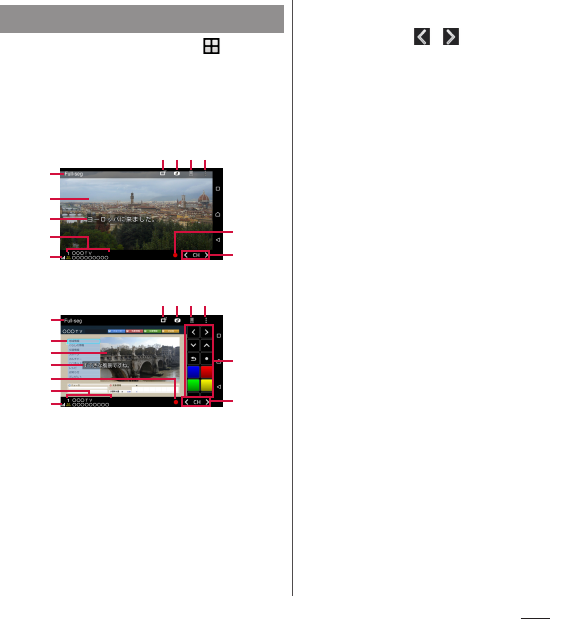
129
Apps
1
From the Home screen,
u
[TV].
・
When using for the first time, make
channel settings according to the
onscreen instructions (P.131).
■
TV watching screen
a
Full seg/1Seg switching icon
b
Data broadcasting icon
c
Remote control button
d
Option menu
e
Broadcasting service in watching (Full seg/1Seg)
f
Image
g
Subtitles
h
Channel, broadcasting station and program
information
i
Reception signal level
j
Record icon
k
Channel selection key
・
Touch and hold / to search available
channels.
l
Data broadcasting
・
For 1Seg programs, data broadcasting can be
viewed only in the portrait screen.
m
Data broadcasting remote control
❖
Information
・
In portrait screen in Full seg, you can see a remote
control for data broadcasts, and you can display a
channel list and program information.
・
To view data broadcasting in full screen, in portrait
screen in 1Seg, touch and hold the data
broadcasting area
u
[Broadcast data full-screen].
・
To show/hide icon such as option menu, on the TV
watching screen, tap an image.
・
While watching TV, press the volume key to adjust
the sound volume.
・
You can watch TV in the portrait screen or landscape
screen (P.46).
・
To switch channels for watching, operate any of the
following.
- Tap the channel selection key.
- Flick an image on the TV watching screen left or
right.
- Touch and hold an image on the TV watching
screen
u
Select a channel from the displayed
channel list.
・
It may take a time to acquire image data or
broadcasted data when you activate TV or change
channels due to characteristic of digital
broadcasting.
・
According to the airwave condition, image or sound
may be interrupted or stopped.
Watching TV
h
i
d
k
j
cba
g
f
e
TV watching screen (Full seg, Full screen)
h
i
d
k
cba
j
f
g
e
l
m
TV watching screen (Full seg, with Data broadcasting)
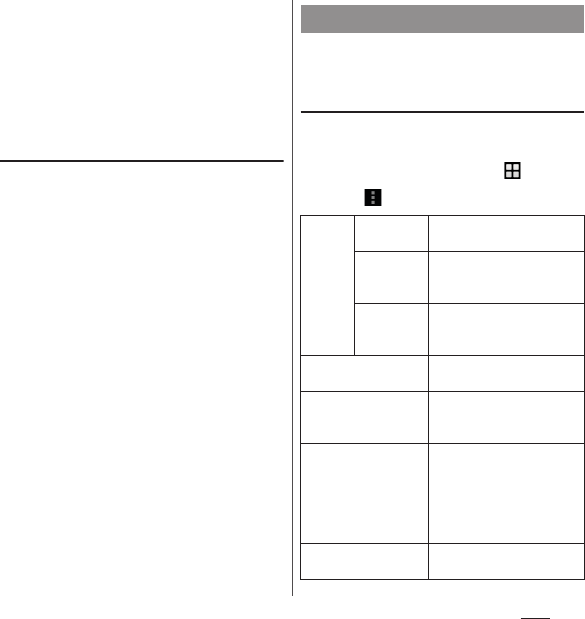
130
Apps
・
Answering an incoming call while watching TV
temporarily pauses the program. The program
resumes automatically after the call ends.
・
To watch data broadcasting, call charge or packet
communication charge is not required. If you use
additional services of data broadcasting, etc. via
packet communication, packet communication
charge is applied.
Exiting TV
1
On the TV watching screen,
b
.
❖
Information
・
You cannot exit TV even if you tap
h
to return to
the Home screen. If TV remains activated, the battery
may be consumed quickly.
You can set TV watching screen, data
broadcasting and channel settings.
Using optional menu
Reserve recording/viewing TV program or
make each setting.
1
From the Home screen,
u
[TV].
2
Tap .
Setting TV
Program Program
guide
Display the program guide.
Program
detail info
Display detailed information
of the program currently
watched.
Program
information
Display program information
of the channel currently
watched.
Recorded program list
Display recorded program
list (P.133).
Reserve Recording/
Viewing
Reserve programs to record/
view, or display the failed
reservation list.
TV link
Display TV link list screen.
For some data broadcasting
programs, TV links are
displayed, and by registering,
you can connect to related
websites.
* 1
Change area
Register or change
broadcasting area (P.131).
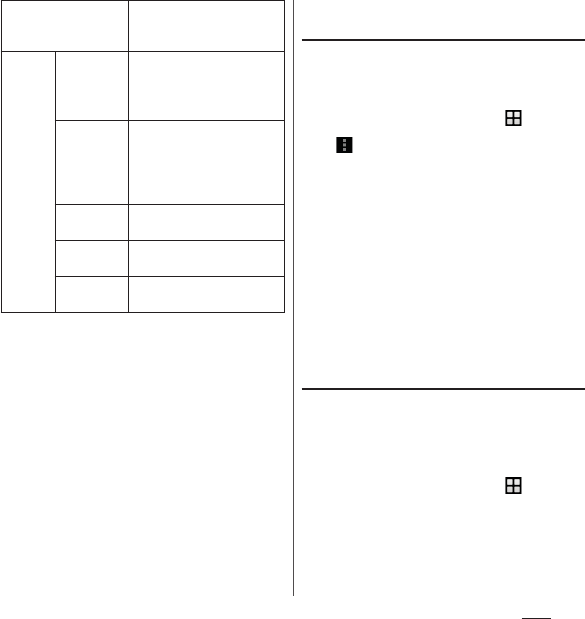
131
Apps
*1 Some TV links have period of validity.
*2 You can set subtitle position only in landscape view
in 1Seg. Also, you have a choice of audio channels
only when watching a program with a sub audio
channel.
Saving channels in the current
location
Available channels vary depending on the
area (broadcasting service area) you are
using in.
1
From the Home screen,
u
[TV].
2u
[Change area].
3
Touch and hold an unregistered
item.
4
[Area info setting]
u
Select region,
prefecture and locality.
5
[OK].
❖
Information
・
By touching and holding the area registered in Step
3, you can display details, set area information,
refresh channels, rename area, and deleting settings.
Changing numbers for TV remote
Change TV remote number assigned to each
broadcasting station. Each broadcasting
station can be called up via the
corresponding TV remote number.
1
From the Home screen,
u
[TV].
2
Touch and hold an image.
Subtitle/Sound/Video
setting
Turn subtitles on or off, set
their position, or select the
main or sub audio channel.
* 2
Settings
Superimpose
setting
Set whether to display
superimpose for Full seg or
select a superimpose
language.
Data
Broadcasting
settings
Set whether to use the
location information or the
terminal information, clear
the broadcasting station
memory, or postal code.
Auto Exit
Timer
Make a timer setting to end
TV watching.
Device ID of
receiver
Display device ID of receiver.
Notes
Display information before
use.

132
Apps
3
Tap the broadcasting station to
change the remote control
number
u
Touch and hold the
image.
4
Touch and hold the number of
remote control to set to.
5
[YES].
・
If you select a number of remote
control which is already assigned to
another broadcasting station,
[Overwrite registered channel]
u
Tap
[YES].
❖
Information
・
To delete set broadcasting stations, touch and hold a
broadcasting station in Step 3
u
[Delete channel]
u
Tap [ YES].
Record images, sound, captions or data
broadcasting while displaying.
・
Data broadcasts can be recorded only in 1Seg
mode.
1
From the Home screen,
u
[TV].
2
Tap to start recording.
3u
[Stop recording]/[Stop
recording as end of program].
・
To end the recording when the
program ends, tap [Stop recording as
end of program].
❖
Information
・
In Full seg, the maximum size of a single recording
file that can be saved is 198 GB, and the maximum
continuous recording time is about 1,440 minutes
(on a 200 GB microSD card).
In 1Seg, the maximum size of a single recording file
that can be saved is 2 GB, and the maximum
continuous recording time is about 640 minutes.
You can save up to 99 Full seg and 1Seg recordings.
・
Recorded data is saved on a microSD card. Recording
is not available if a microSD card is not attached.
・
When you use the microSD card from another
application while recording, recording may fail.
Recording TV
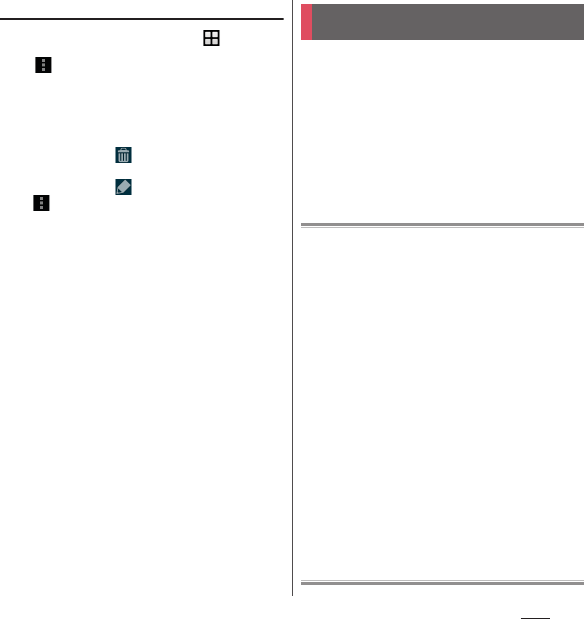
133
Apps
Playing a recorded program
1
From the Home screen,
u
[TV].
2u
[Recorded program list].
3
Tap a program to play.
❖
Information
・
To delete a recorded program, touch and hold the
program in Step 3
uu
Tap [ YES].
・
To change the title of a program, touch and hold the
program in Step 3
uu
Enter a title
u
Tap [OK ].
・
Tap in Step 3 to set the playback mode and see
and sort the amount of available memory.
・
All still pictures or videos that you capture on
the terminal are stored into the internal
storage or a microSD card.
・
To save still pictures and videos to a microSD
card, insert one and specify it as the
destination where you want to save them,
before using the camera (P.142).
・
When the terminal temperature becomes high,
the camera may not activate or may stop.
■
About the Copyright and Portrait rights
Movies, still images, and sounds recorded on the
terminal are prohibited by the copyright law from use
without consent of the copyright holders, unless
intended for personal use or any other purpose
permitted by law. Also, using or transformation of
other person’s portrait or name without his or her
permission may violate the portrait right. When you
post recorded images etc. on the Internet web pages
etc., make sure to be aware of the copyright and
portrait right. Note that some performances, shows,
and exhibitions may be restricted to record even for
personal use. Transmission of images related to
copyright or beyond the scope provided in the
copyright law is not available.
Shooting/sending images
Please be considerate of the privacy of
individuals around you when taking and sending
photos using camera-equipped mobile phones.
If you cause the public any trouble using the terminal,
you may be punished under law or regulations (for
example, nuisance prevention ordinance).
Camera
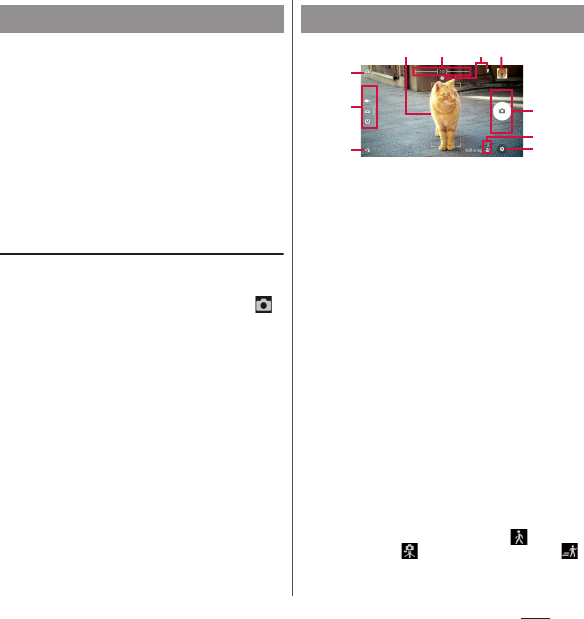
134
Apps
1
From the Home screen, [Camera].
・
A shooting screen appears.
❖
Information
・
When the camera is turned on via Quick launch, the
capturing mode is automatically set to "SUPERIOR
AUTO" or "VIDEO".
・
The camera turns off if you do not touch the
shooting screen for about 3 minutes (or about 30
seconds if you have turned on the camera in Quick
launch mode).
Using Quick launch
"Quick launch" refers to turning on the
camera by pressing and holding
k
for at
least 1 second or by swiping (or flicking)
on the lock screen.
・
Quick launch operations can be changed
(P.144).
a
Auto focus frame
b
Zooming indicator
・
An image is shot in magnification displayed with
the indicator.
c
Display area for status icons
・
When settings such as Smile Shutter and Save
location (Geotagging) are selected, their icons are
displayed here.
d
Thumbnail
・
Tap to display the play screen of shot photo or the
preview screen of video (P.146).
e
Switching to the front camera icon
f
Current capturing mode (P.135)
g
Flash setting icon
h
Shutter icon (still picture)
Start/stop/pause recording icon (video)
・
Depending on setting, an icon of Self-timer or
Touch capture is displayed.
i
Scene/conditions selection icon
・
When the capturing mode is "SUPERIOR AUTO" or
"VIDEO", the camera determines and detects the
scene and display the icon.
Also, this area displays an icon when your terminal
detects that the camera is moving ( ), your
camera is still ( ), or your subject is moving ( ).
j
Option menu
Activating the camera Shooting screen
e
g
d
h
a
i
j
cb
f
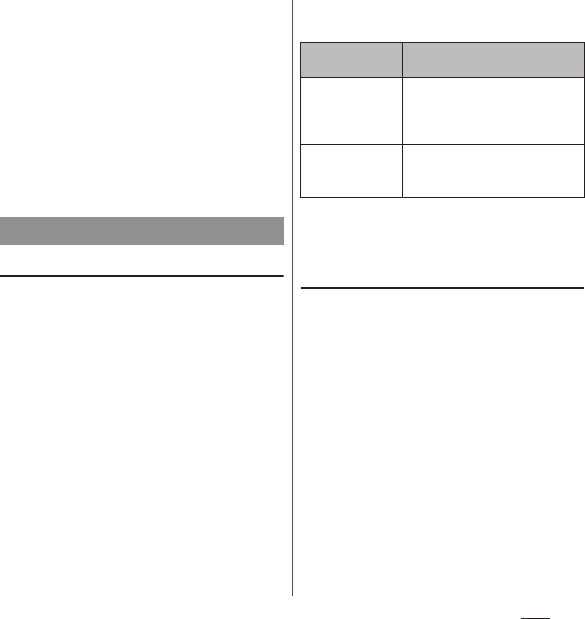
135
Apps
❖
Information
・
When using "AR effect" and other camera
applications, the display and operations are different.
・
To zoom in or out, set "Use Volume key as" (P.142) to
"Zoom" and operate with the volume key, or pinch in
or out on the screen.
・
Zooming is not available when "AR effect" or
"Panorama" is set or when shooting with the front
camera.
・
The scene mode in "SUPERIOR AUTO" or "VIDEO" may
not be recognized correctly depending on shooting
conditions.
Changing the capturing mode
You can switch between "SUPERIOR AUTO",
"MANUAL", "VIDEO" and "CAMERA APPS".
1
From the Home screen, [Camera].
2
Swipe (or flick) the screen.
・
Swipe (or flick) up or down in landscape
view, or right or left in portrait view.
・
About CAMERA APPS (P.135)
■
Capturing modes and resolution/
Video resolution
* "Super slow motion", "Super slow (one-shot)" and
"Slow motion" are shot in HD (30fps/960fps), HD
(960fps) and HD (120fps), respectively.
Using the camera apps
You can use the camera apps to shoot many
types of photos or videos.
1
From the Home screen, [Camera].
2
Swipe (or flick) the screen to
display the CAMERA APPS list.
・
Swipe (or flick) down in landscape view,
or left in portrait view.
3
Select an app.
・
To switch to the other camera app, tap
the camera app icon located in the
bottom right of the shooting screen
(bottom left for portrait view).
Capturing mode
Capturing mode Resolution (aspect ratio)/Video
resolution
"SUPERIOR AUTO"
"MANUAL"
19MP (4:3)
17MP (16:9)
12MP (4:3)
12MP (16:9)
"VIDEO"
Full HD (30 fps/60 fps)
HD
*
VGA

136
Apps
❖
Information
・
Themes downloaded via "AR effect" will be saved to
the internal storage.
・
Some applications may not be able to play back
sound from images taken using the "Sound Photo"
feature.
・
To save the next shot data to the microSD card, using
a microSD card (Speed Class 10 or UHS speed class 1)
which supports high-speed writing is
recommended.
-4K video
- Super slow motion
- Super slow (one-shot)
-Slow motion
・
For details on the features of the camera, refer to the
following website.
http://www.sonymobile.co.jp/myxperia/
howtoxperia/camera/ (in Japanese only)
■
Notes on shooting with Panorama
・
The following cases are not suitable for
shooting with Panorama.
- Shooting a moving object
- Shooting the main object that is too
close to the camera
- Shooting an object with repetition of
the same pattern such as a sky, beach,
grass, etc.
- Shooting a big object
- Shooting an object with constantly
changing pattern such as a wave,
waterfall, etc.
・
Because two or more images are joined
together, joints may not be recorded
smoothly.
・
Images may be blurred or may not be
taken in a dark scene.
・
Under the flickering light source such as a
fluorescent light, you may not be able to
shoot properly since brightness or color
balance of joined image may be unstable.
・
If the brightness, color balance, focus
point of whole image, etc. are extremely
different between the entire angle view of
Panorama shot and the focused angle
view, the image may not be shot properly.
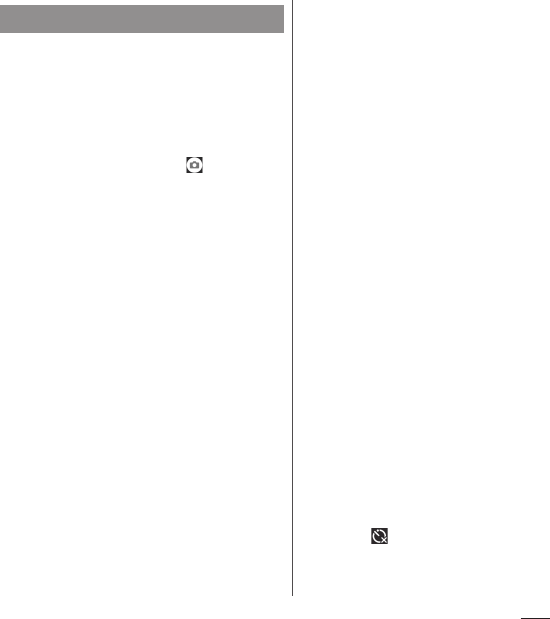
137
Apps
■
Shooting with the shutter icon
1
From the Home screen, [Camera].
2
Swipe (or flick) the screen to
display "SUPERIOR AUTO" or
"MANUAL" shooting screen.
3
Tap the shutter icon ( ).
■
Shooting with "Touch capture"
Set "Touch capture" (P.142) to "On".
1
From the Home screen, [Camera].
2
Swipe (or flick) the screen to
display "SUPERIOR AUTO" or
"MANUAL" shooting screen.
3
Tap the shooting screen.
❖
Information
・
To use "Touch capture" with the camera app, switch
to the camera app and then set "Touch capture" to
On.
■
Shooting with the camera key
1
From the Home screen, [Camera].
2
Swipe (or flick) the screen to
display "SUPERIOR AUTO" or
"MANUAL" shooting screen.
3
Press
k
.
・
When shooting with auto focus, press
k
halfway, and after the auto focus
frame turns blue, firmly press
k
the
rest of the way until it stops.
■
Shooting with Hand Shutter
When shooting with the front camera, turn
your palm toward the camera to shoot
automatically. You can take picture of
yourself without operations such as tapping
an icon etc.
・
Set "Auto capturing" (P.141) to "Hand
Shutter".
1
From the Home screen, [Camera].
2
Swipe (or flick) the screen to
display "SUPERIOR AUTO" or
"MANUAL" shooting screen.
3
Switch to the front camera and
then turn your palm toward the
camera.
・
Tap to set self-timer.
・
When a palm mark appears, a photo is
taken.
Shooting still pictures
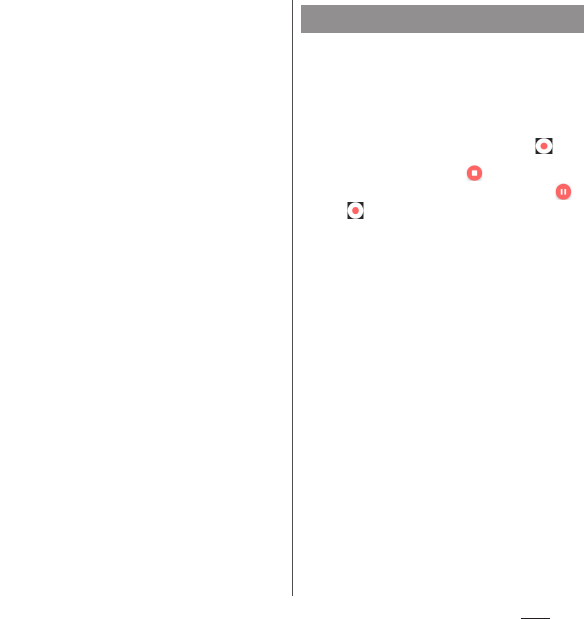
138
Apps
❖
Information
・
When the auto focus frame does not appear,
focusing may be failed.
・
When a face of subject is detected, an auto focus
frame is displayed at the position of the face (up to 5
frames). The frames around faces that the camera has
automatically focused on—autofocus frames—are
displayed in yellow.
To select the face you want to focus on, tap the frame
around that face.
・
When "Object tracking" (P.141) is turned on, tap the
subject on the shooting screen to display the object
tracking frame.
・
When you connect a commercially available
earphone or Bluetooth device, shutter sound may be
softer than usual.
■
Shooting with the start/stop icon
1
From the Home screen, [Camera].
2
Swipe (or flick) the screen to
display "VIDEO" shooting screen.
3
Tap the start shooting icon ( ).
4
Tap the stop icon ( ).
・
Tap the pause/start shooting icon ( /
) to pause/resume recording.
■
Shooting with "Touch capture"
Set "Touch capture" (P.142) to "On".
1
From the Home screen, [Camera].
2
Swipe (or flick) the screen to
display "VIDEO" shooting screen.
3
Tap the shooting screen.
・
Tap the shooting screen again to stop
recording.
❖
Information
・
To use "Touch capture" with the camera app, switch
to the camera app and then set "Touch capture" to
ON.
Recording videos
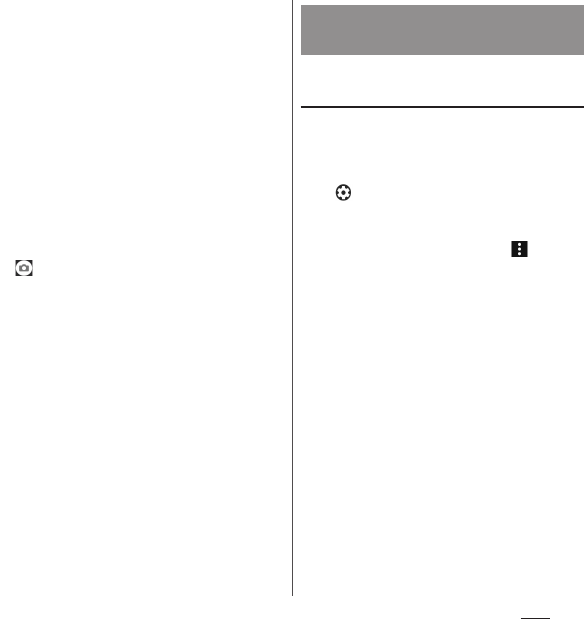
139
Apps
■
Shooting with the camera key
1
From the Home screen, [Camera].
2
Swipe (or flick) the screen to
display "VIDEO" shooting screen.
3
Press
k
.
・
Press
k
again to stop recording.
❖
Information
・
Do not cover the microphone with fingers etc. when
recording videos.
・
When you connect a commercially available
earphone or Bluetooth device, shooting start/stop
sound may be softer than usual.
・
When shooting video, you can tap the shutter icon
( ) to take a photo.
・
When you set "Auto capturing (video)" (P.141) to
"Smile Shutter", the terminal does not emit shutter
sound for shooting a still image by detecting smile
while recording video.
・
When shooting videos with "4K video", set
"SteadyShot™" to "Standard" to avoid image
distortion (P.142).
Changing settings in the option
menu
・
The displayed items vary by the capturing
mode and camera app.
1
From the Home screen, [Camera].
2u
Select a setting item.
・
Tap "More" to view additional settings
and share items.
・
For some camera apps, tap on the
shooting screen to change the settings.
3
Change the setting.
■
Self-timer (only for still pictures)
Set the number of seconds for the self-
timer.
The shutter icon changes into a timer icon.
Tap it to shoot after set period of time
(seconds) elapses.
You are recommended to use the self-timer
for avoiding camera shake.
Changing settings when
shooting
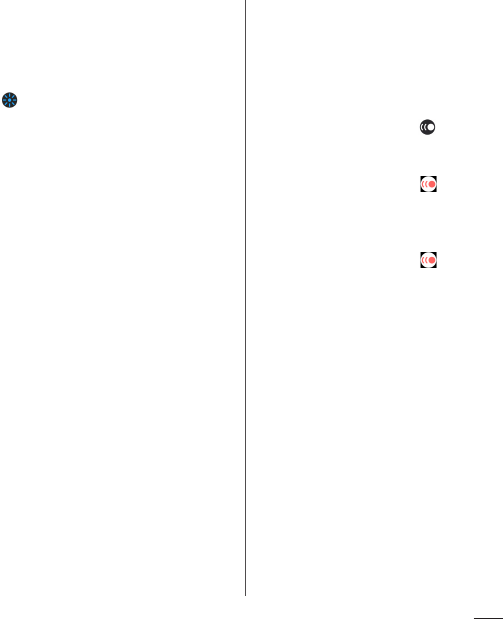
140
Apps
■
Color and brightness (when
"SUPERIOR AUTO" or "VIDEO" is set)
Adjust brightness and color. To make
adjustments, drag the marker on the bar
that appears on the shooting screen.
Tap on the shooting screen and then tap
the setting item [Reset Color and
brightness] to reset the settings.
■
ISO (only when "MANUAL" is set)
Set ISO sensitivity.
・
With ISO sensitivity up, you can shoot
clear picture reducing blur even in a place
where lightning is poor. However, noise
stands out.
・
With ISO sensitivity down, you can shoot
with noise kept low. However, images
may be dim and blurred when shot under
poor lighting condition.
■
HDR (only when "MANUAL" is set)
Take lifelike, natural-looking images even in
high-contrast scenes, for example when
shooting a picture against the sun.
・
When "HDR" is set to ON, "ISO" is
automatically set to "Auto".
■
Resolution (only for still picture)
Set the resolution for photos. The higher the
resolution of a photo, the larger its file size.
■
Video resolution (only when "VIDEO" is
set)
Set the resolution for video. The higher the
resolution of a video, the larger its file size.
■
Slow motion mode (only when
"VIDEO" is set)
To select the mode, tap on the shooting
screen to set the Slow motion mode.
Super slow motion
Shoot a moment when is tapped while
shooting a video with the Super slow
motion mode.
Super slow (one-shot)
Shoot a moment when is tapped with
the Super slow motion mode.
Slow motion
Shoot a video with 120fps and select a
moment to shoot in the Slow motion mode.
・
When Slow motion is set, setting the
video resolution is not available.
・
For shooting in Super slow motion or
Slow motion, sufficient brightness is
needed for shooting due to high- shutter
speed.
・
If you shoot in a place where the quantity
of light is lacked such as indoors or a dark
place, the quality of image may be rough
or the image may be darkened.

141
Apps
■
Predictive Capture (only when
"SUPERIOR AUTO" is set)
When the camera detects movement of a
subject, up to 4 photos are shot according
to the movement.
■
Object tracking
Tap your object on the shooting screen, and
the camera will keep focusing on the
subject as it moves.
■
Metering (only when "MANUAL" is set)
Measure the brightness on the shooting
screen to determine a well-balanced
exposure automatically.
Face
Detects faces, measures the brightness, and
adjusts exposure to set the appropriate
brightness level.
Multi
Divides the screen into multiple areas,
measures the brightness, and adjusts
exposure so that the overall brightness is
balanced.
Center
Put emphasis at the center of the shooting
screen and measure photometry at whole
view finder to adjust the exposure.
Spot
Measure photometry only at the center of
the shooting screen to adjust the exposure.
Touch
Measure photometry at a point where you
tapped in the shooting screen and adjust
the exposure.
■
Auto capturing/Auto capturing (video)
Set to shoot automatically without icon or
key operation.
Smile Shutter
Shoot at the moment of a subject smiled.
While video shooting, shoot a still image at
the moment of a subject smiled.
Hand Shutter (only when shooting with
Front camera)
Turn your palm toward the camera to shoot
automatically (P.137).
■
Touch to adjust (only when "SUPERIOR
AUTO" is set)
Set function for adjusting the screen with a
tapped point.
Focus only
Focus on a tapped point.
Focus and brightness
Focus on or adjust brightness with a tapped
point.
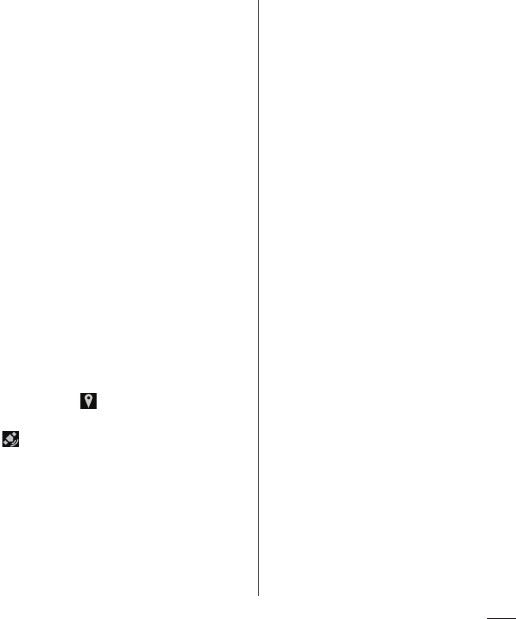
142
Apps
■
SteadyShot™ (only when "4K video",
"VIDEO" is set)
Set whether to decrease blur by hand shake
when shooting.
Intelligent active (only when "VIDEO" is
set)
Reduce camera shake blurring when
zooming, or when shooting while walking.
Standard
Reduce camera shake blurring when
shooting normally.
■
Soft skin effect (only for shooting with
Front camera)
Set whether to shoot a picture making
human skin look smoother.
■
Save location
Set whether to tag still pictures/videos
location information (geotag) for the
shooting spot.
・
When enabled, location information is
added when appears on the shooting
screen.
・
appears while acquiring location
information. To pictures shot while
acquiring location information, geotags
are not added.
■
Touch capture
Set whether to shoot by tapping the
shooting screen. If you set "Only front
camera", Touch capture turns to On
automatically when the camera is switched
to the front camera.
■
Grid lines
Set whether to show a gridline on the
shooting screen as a guide.
■
Auto photo preview
Set whether to display a preview right after
shooting.
If you set "Only front camera", a preview
appears only when you shoot with the front
camera.
■
Use Volume key as
Set function for assigning with the volume
key.
■
Data storage
Set the saving location for shot still pictures/
videos.
■
Quick launch
Set behavior when using Quick launch
(P.144).
■
Help
Display Help for the camera function.
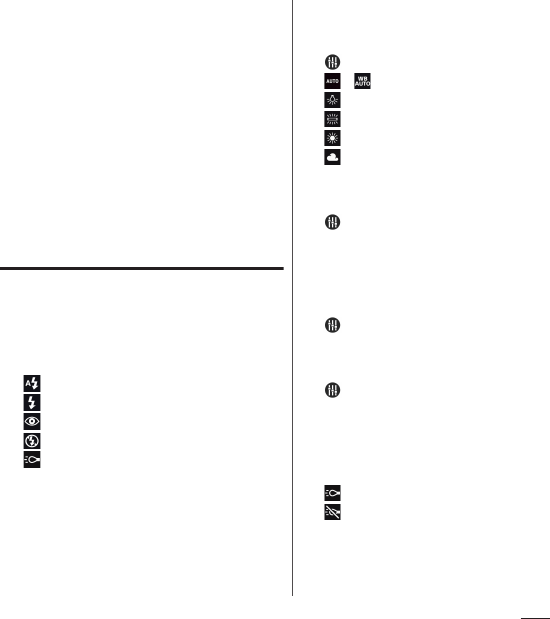
143
Apps
■
Preview (when "Creative effect" or
"Sound Photo" is set)
Set whether to display the preview screen
or the edit screen after a still image is shot.
■
Recording file type (only when "4K
video" is set)
Select the file type from "H.264" or "H.265".
❖
Information
・
Some settings cannot be used in combination with
one another.
・
The operation may differ depending on the
capturing mode or camera app.
Changing settings using icons
Tap the icon displayed on the shooting
screen to change the setting.
・
The displayed icons vary by the capturing
mode, camera apps, etc.
■
Flash
Auto
Fill flash
Red-eye reduction
Off
Flashlight
■
White balance (when "MANUAL" or "4K
video" is set)
Set according to the ambient light source.
u
Tap [WB] to set.
/
AUTO
Incandescent
Fluorescent
Daylight
Cloudy
■
Brightness (EV correction) (When
"MANUAL" or "4K video" is set)
u
[EV]
u
Tap a bar or drag a marker to set.
■
Shutter speed (only when "MANUAL" is
set)
Set a shutter speed according to a moving
speed of subject etc.
u
[SS]
u
Tap a bar or drag a marker to set.
■
Focus (only when "MANUAL" is set)
Set according to a distance from a subject.
u
[Focus]
u
Tap a bar or drag a marker to
set.
■
Flash
Set whether to use flash when shooting
video in a backlit or dark scene.
On
Off
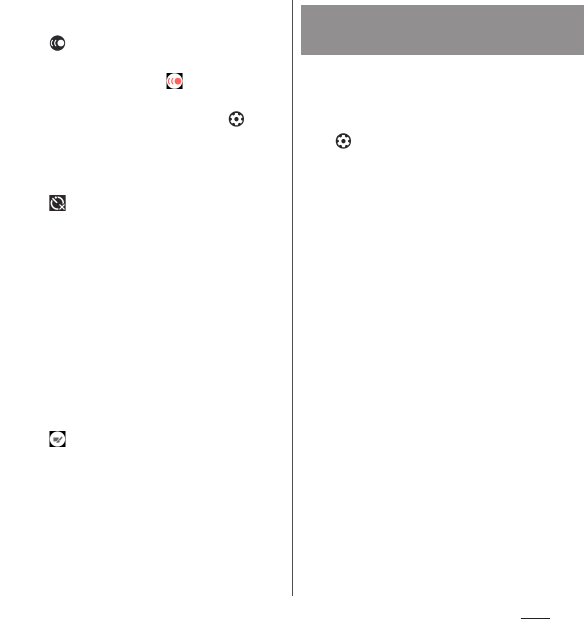
144
Apps
■
Slow motion shooting (only when
"VIDEO" is set)
Tap to switch to the capturing mode
with slow motion.
Shoot a moment when is tapped with
Super slow motion.
・
To change the capturing mode,
u
Tap
[Slow motion mode] (P.140).
■
Self-timer (only when shooting with
Front camera)
Tap to set a number of seconds for self-
timer. Each time you tap, it switches in the
order of 3 sec.
→
10 sec.
→
Off.
The shutter icon changes into a timer icon.
Tap it to shoot after set period of time
(seconds) elapses.
Use the self-timer to take a self-portrait or
group photo.
You are recommended to use the self-timer
for avoiding camera shake.
■
Switch creative effect (only when
"Creative effect" is set)
Tap to switch a type of effect.
❖
Information
・
Some settings cannot be used in combination with
one another.
・
The operation may differ depending on the
capturing mode or camera app.
You can change how the camera works when
it is turned on via Quick launch.
1
From the Home screen, [Camera].
2u
[More]
u
[Quick launch].
3
Tap any of [Launch only]/[Launch
and capture]/[Launch and record
video]/[Off].
❖
Information
・
When the camera is turned on via Quick launch, the
capturing mode is automatically set to "SUPERIOR
AUTO" or "VIDEO".
Changing the Quick launch
settings
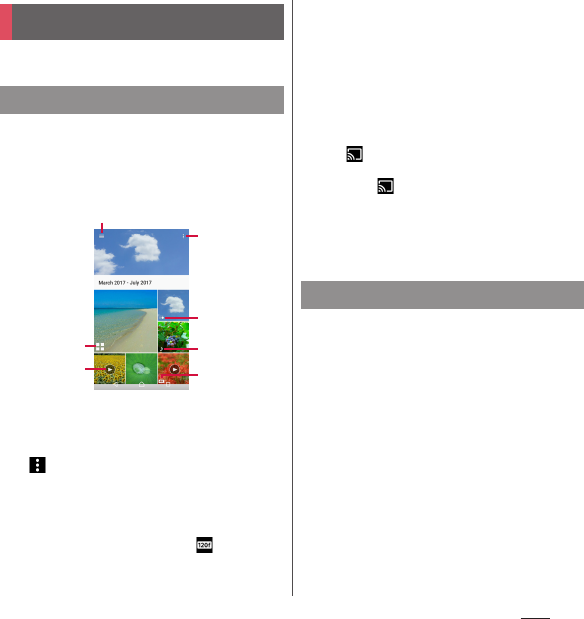
145
Apps
View/play photos or videos.
1
From the Home screen, [Album].
・
A list of images are displayed in
chronological order.
■
Image list screen
a
Display the menu
b
File shot with Predictive Capture
c
Video file
d
Option menu
・u
[Select items]
u
Tap an image to select for
displaying a menu of deletion, share, etc. Tap
images continuously to select multiple files.
e
File shot with Slow motion mode
・
Files shot with 120fps and not including slow
motion images are marked with .
f
Sound Photo file
g
4K video file
❖
Information
・
Depending on the number of saved images, it may
take some times to load images.
・
To zoom in/out an image, flick the image list screen
right/left or pinch out/in.
・
For some DRM protected contents or transfer
applications, sharing may be limited.
・
Touch and hold an image in the image list screen to
select the image.
・
When is displayed at the upper right of screen,
an image or video can be played with Google Cast
devices. Tap and then follow the onscreen
instructions to connect. To play with Google Cast
devices, connect the terminal to the Wi-Fi network
same with a Google Cast device connected to in
advance (P.159).
1
From the Home screen,
[Album]
u
Tap an image.
・
With Sound Photo files, audio is played
back with the image.
・
Tap the screen to display information
such as shooting date, option menu
icons, etc.
・
For the files shot with Predictive
Capture, tap [SELECT THE BEST] to
select the photo to save.
Album
Displaying photos/videos
b
c
d
f
e
g
a
Viewing a photo
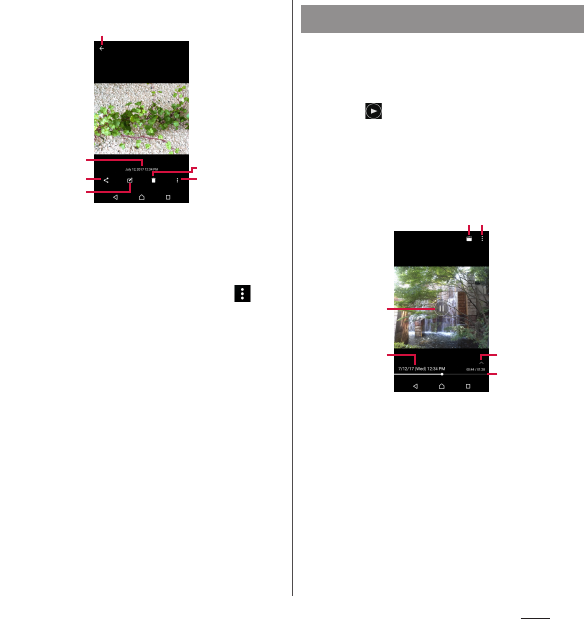
146
Apps
■
Photo viewing screen
a
Return to the image list
・
Alternatively, on the photo viewing screen, flick
up/down to return to the image list screen.
b
Shot date
・
When a location information is saved, its relevant
country or place name is displayed. Tap
u
[Show on map] to view the image on a map.
c
Sharing menu
・
Upload files to online services, send them via
Bluetooth or email.
d
Edit photos
e
Delete
f
Option menu
・
Add/remove to/from the favorites, play
slideshows, configure image settings, rotate
images, check detailed information, or add
geotags (location information).
❖
Information
・
To zoom in/out image display, pinch out/in on the
photo viewing screen or double-tap.
・
The menu displayed may differ depending on the
operation or selected file. Also, some files cannot be
operated.
1
From the Home screen, [Album]
u
Tap a video.
・
A preview screen appears.
2
Tap .
・
Tap the screen to display information
such as shooting date, option menu
icons, etc.
■
Video playback screen
a
Edit a video
b
Option menu
c
Play/Pause
d
Video file name/Recorded date
e
Show/Hide operation icons
・
Show/hide operation icon such as fast forward or
a setting icon for repeat play.
f
Progress bar
・
Tap on the bar or drag a marker left or right to
change a playback position.
a
b
d
cf
e
Playing a video
ab
c
d
f
e
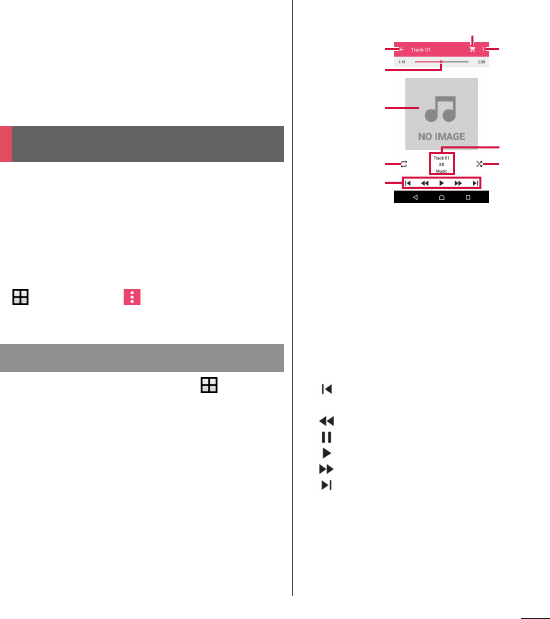
147
Apps
❖
Information
・
To zoom in/out a video display, pinch out/in on the
video playing screen.
・
The displayed menu may differ depending on the
operation or selected video file. Also, some files
cannot be operated.
Play back music and videos stored on the
internal storage or a microSD card using
Media Player.
・
File formats of playable data (P.232)
❖
Information
・
For details on Media Player, from the Home screen,
u
[Media Player]
uu
Tap [Help] to refer to the
manual of Media Player.
1
From the Home screen,
u
[Media
Player].
2
Tap the appropriate tab at the top
of the screen or flick left or right on
the screen.
3
Tap a song/video.
■
Music playback screen
a
Access dmarket
b
Back to song list
c
Playback point
d
Album art
・
Tap here to display the operation bar or the icons
to adjust the audio volume, post to SNS, display
the album information, etc.
Alternatively, on the playback screen, press the
volume key to adjust the volume.
e
Repeat is off/Repeat all songs/Repeat current song
f
Operate a song
: Go back to the beginning of the song or to the
previous song
: Fast rewind
: Pause
: Play
: Fast forward
: Skip to the next song
g
Option menu
h
Song information
i
Shuffle is off/Shuffle is on
Media Player
Playing music/video
b
d
e
c
a
h
g
f
i
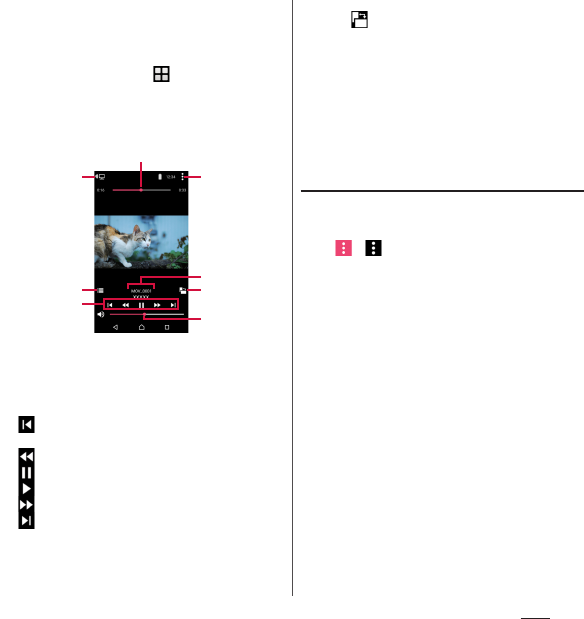
148
Apps
❖
Information
・
You can return to the Home screen to perform
another operation while listening to music in the
background. To return to the music playback screen,
from the Home screen, tap
u
[Media Player], or
drag the status bar downwards
u
Tap the name of
song that is being played.
■
Video playback screen
a
Playback point
b
Share a video between screen mirroring compatible
device and the terminal
c
Back to video list
d
Operate a video
: Go back to the beginning of the video or to the
previous video
: Fast rewind
: Pause
: Play
: Fast forward
: Skip to the next video
e
Option menu
f
Video information
g
Auto-rotate screen ON/OFF
・
Tap to turn red and disable Auto-rotate
screen.
h
Volume control
・
Alternatively, on the playback screen, press the
volume key to adjust the volume.
❖
Information
・
Tap the screen to display option menu icons and
other items.
Ending Media Player
1
On the Media Player screen/song
player screen/movie player screen,
/
u
[Exit].
a
d
b
g
c
e
f
h
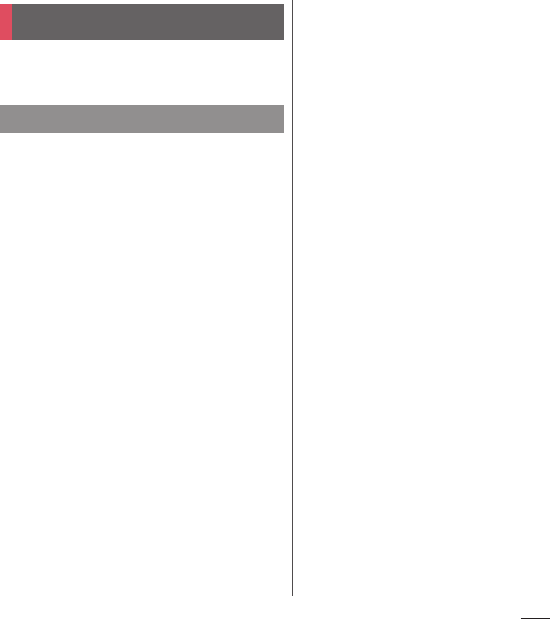
149
Apps
Your current location can be positioned using
GPS, Wi-Fi, or mobile network.
The terminal has a GPS receiver that uses
satellite signals to calculate your location.
Some GPS features use the Internet. Data
rates and charges may apply.
When you use GPS function to find your
location, make sure you have a clear view of
the sky. If GPS does not find your location
after several minutes, move to another
location. To help the search, stand still and do
not cover the GPS antenna section (P.30). The
first time you use the GPS, it may take a few
minutes to find your location.
・
Use the GPS system with great care. DOCOMO
is not liable for any damage caused by
abnormality of the system.
・
Note that DOCOMO shall have no liabilities for
any purely economic loss including those due
to missing a chance to check the
measurement (communication) results
because of external factors (including the
running out of the battery), such as a failure,
malfunction, or any other problems of the
terminal or the power failure.
・
You cannot use the terminal as a navigation
device for an aircraft, vehicle, and person.
Note that DOCOMO shall have no liabilities
whatsoever even if you suffer damage or loss
while performing a navigation using the
location information.
・
You cannot use the terminal as a high-
accuracy measurement GPS. Note that
DOCOMO shall have no liabilities whatsoever
even if you suffer damage or loss due to a
deviation of the location information.
・
Global Positioning System (GPS) is created
and managed by U.S. Department of Defense.
And the department is in charge of
controlling the accuracy and maintenance of
the system. Therefore, some changes made
by U.S. Department of Defence might affect
accuracy or functions of GPS system.
・
Some wireless communication products
(mobile phone, data detectors and some
others) block satellite signals and also causes
instability of signal reception.
・
Some map displays based on location
information (latitude/longitude information)
may be not accurate due to some countries'
or regions' regulations.
Location services
GPS function
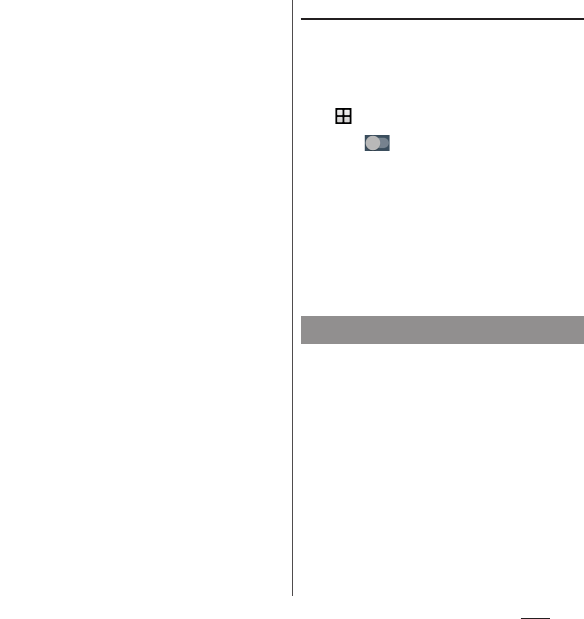
150
Apps
■
Where radio waves are difficult to
receive
Note that radio waves may not be received
or it may be difficult to receive radio waves
in the following conditions, since GPS uses
radio waves from a satellite.
・
Inside or immediately under a building
・
Inside a bag or box
・
Inside or under a thick covering of trees
・
In a car, inside a train compartment
・
When there are obstructions (people or
objects) near the terminal
・
Inside a basement or tunnel, and below
the ground or water
・
In buildings-clustered or residential area
・
Near a high-voltage cable
・
Bad weather such as heavy rain or snow
❖
Note
・
If you cannot use a part of or entire GPS function,
check that the use of internet is included in your
subscription and Wi-Fi (P.158) and Mobile data traffic
(P.162) is enabled.
・
NTT DOCOMO is not liable for navigation services or
for the accuracy of location services.
Activating GPS/Location services
You can position your current location using
GPS, Wi-Fi, and information sent from mobile
network base stations.
1
From the Home screen,
u
[Settings]
u
[Location].
2
Tap .
3
Read the notes on location
information and tap [AGREE].
❖
Information
・
Your location information is sent to Google without
specifying who you are. Your location information
may be sent even when the application is not
running.
The Google Maps application allows you to
view your current location, find other
locations and search routes.
・
To use Google Maps, enable Mobile data
traffic (LTE/3G/GPRS) or connect to Wi-Fi.
・
Google Maps does not cover the whole world.
Using Google Maps
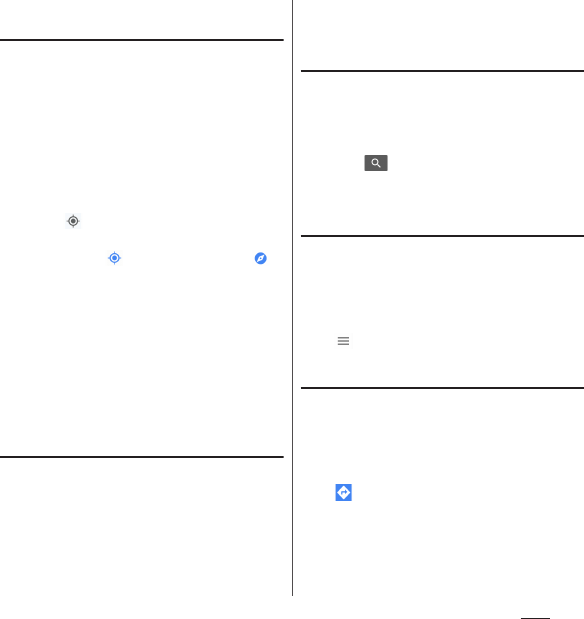
151
Apps
Finding the current location on the
map
You can detect your current location using
location information service.
・
To detect current location, enable "Location"
(P.150) beforehand.
1
From the Home screen, [Google]
u
[Maps].
・
When a message appears, follow the
onscreen instructions.
2
Tap .
・
Current location is shown by blue mark.
・
If you tap , the icon changes to ,
and then the terminal's geomagnetic
compass links the direction displayed
on the map.
・
To zoom in/out the map, pinch out/in
on the map screen, or double-tap/tap
the screen with two fingers.
・
If the confirmation screen etc. appears,
follow the onscreen instructions.
Viewing Street view
1
From the Home screen, [Google]
u
[Maps].
2
Touch and hold a point to show in
the street view.
3
Tap a photo displayed at the lower
left of screen.
Searching for a location
1
From the Home screen, [Google]
u
[Maps].
2
Fill out the search bar.
3
Tap on the software keyboard.
4
Tap a destination.
Displaying information
Display information such as traffic
information etc. on the map.
1
From the Home screen, [Google]
u
[Maps].
2u
Select information to display.
Navigating
You can receive detailed guides for your
destination.
1
From the Home screen, [Google]
u
[Maps].
2u
Select a transporting method.
3
Enter a start point in the upper
entry field
u
Enter an end point in
the lower entry field.
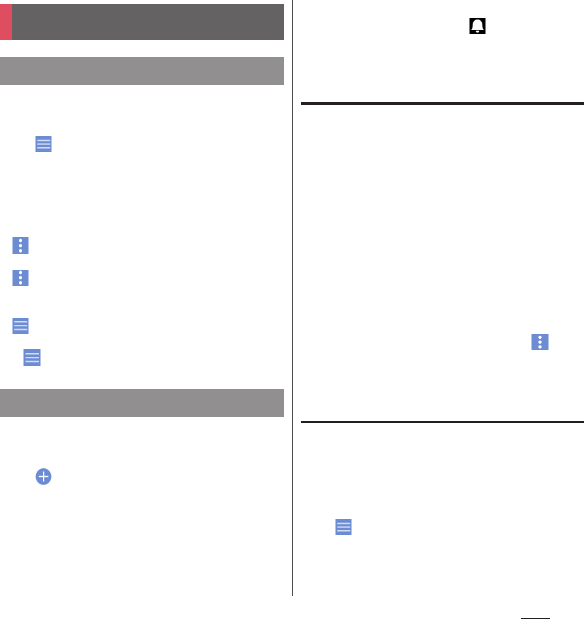
152
Apps
1
From the Home screen, [
ドコモクラ
ウド
(docomo cloud)]
u
[Schedule].
2u
Tap [Monthly]/[Week]/[Daily].
・
Flick the calendar left or right to display
the next or previous month/week/day.
❖
Information
・
To move the cursor to the current date, in Step 2, tap
u
[Jump to]
u
[TODAY].
To move the cursor to the desired date, in Step 2,
u
[Jump to]
u
Flick the calendar left or right to
select month and then tap a day
u
Tap [JUMP].
・
To display all registered schedules in a list, in Step 2,
u
[Schedule list].
・
To switch to the "Memo" application screen, in Step
2,
u
Tap [Memo list].
1
From the Home screen, [
ドコモクラ
ウド
(docomo cloud)]
u
[Schedule].
2u
Enter the item.
・
For setting alarms, tap [Display input
option].
3
[Save].
❖
Information
・
When an alarm of event is set, appears on the
status bar at the set time. Drag the status bar
u
Tap
[It's time] to display details of the event.
Displaying events of Schedule
1
From the Home screen, [
ドコモクラ
ウド
(docomo cloud)]
u
[Schedule]
u
Display a scheduled date/time.
・
In Monthly view or Week view, tap a
scheduled date.
2
Tap an event to view description.
・
To edit an event, tap [Edit].
❖
Information
・
To delete an event, touch and hold an event in Step
2
u
Tap [Delete one]
u
[DELETE].
・
To delete all events, from the Home screen, tap [
ドコ
モクラウド
(docomo cloud)]
u
[Schedule]
uu
[Delete all]
u
[DELETE].
Setting display conditions in
Schedule
When a search criteria is set, specified data
can be displayed.
1
From the Home screen, [
ドコモクラ
ウド
(docomo cloud)]
u
[Schedule].
2u
[Conditions].
3
Select the display condition
u
[OK]
ub
.
Schedule
Displaying schedule
Creating schedule event
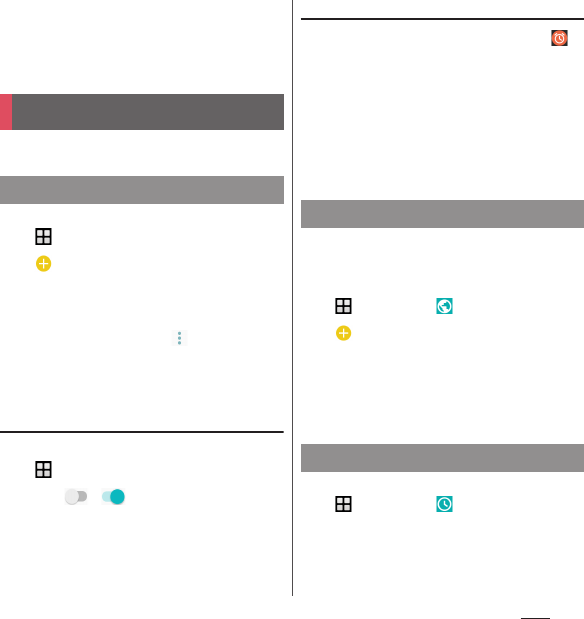
153
Apps
❖
Information
・
To search the contents entered in "title", "text" and
"Where?", in Step 3, [Free word search]
u
Enter a
search word
u
[OK]
u
[OK]
ub
.
Use alarm, world clock, stop watch and timer.
1
From the Home screen,
u
[Clock].
2u
Set the item such as time.
3
[SAVE].
❖
Information
・
To delete alarms, in Step 2, tap
u
[Delete alarms]
u
Mark alarms
u
[DELETE]
*
u
[YES].
* A number of marked alarm is displayed at the right
side of "DELETE".
Enabling/Disabling alarm
1
From the Home screen,
u
[Clock].
2
Tap / for the alarm you
want to turn on or off.
Stopping alarm
1
While alarm is sounding, drag
to the right.
❖
Information
・
If you tap [SNOOZE], the alarm sounds again when
the set time has passed.
・
If the screen backlight is on (except on the lock
screen), tap the notification at the top of the screen
to operate.
Display the date and time etc. in cities around
the world.
1
From the Home screen,
u
[Clock]
u
"" tab.
2u
Select a city.
❖
Information
・
Time display during day-light saving time may differ
from time difference displayed on the screen when
adding a city in Step 2.
1
From the Home screen,
u
[Clock]
u
"" tab.
2
[START].
3
[STOP].
Clock
Setting an alarm
Using World clock
Using Stopwatch
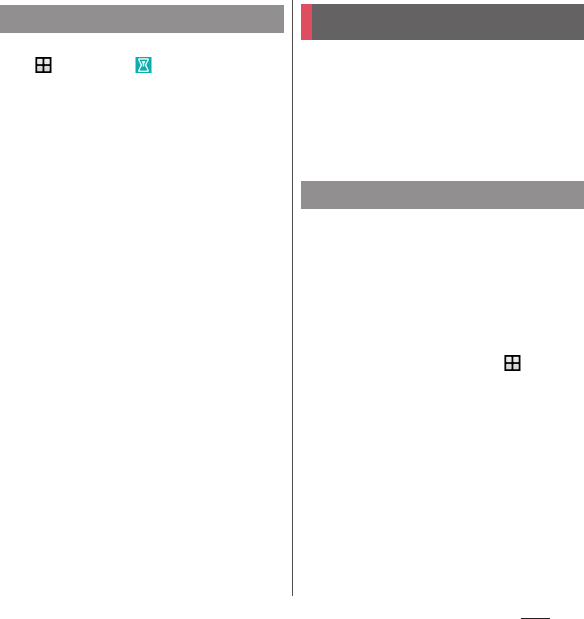
154
Apps
1
From the Home screen,
u
[Clock]
u
"" tab.
2
[SET TIME].
3
Drag the number up or down to set
time
u
[OK].
4
[START].
5
[STOP].
docomo Data Copy application allows you to
copy the data saved to the terminal to the
other terminal or back up/restore the data.
Use this application for transferring the data
when changing the model or for the regular
backup of important data.
You can copy the phonebook entries, images,
etc. directly to the destination device using
the one-to-one direct communication which
does not use the internet.
Activate "Data Copy" applications on both a
data sending terminal and a copy destination
terminal, then align the two terminals.
1
From the Home screen,
u
[Data
Copy]
u
[Data transfer].
・
After this step, follow the onscreen
instructions.
・
This application is needed for both a
data sending terminal and a copy
destination terminal. If it is not installed,
download from NTT DOCOMO website.
・
Communication method differ
depending on your model or the OS.
Using Timer
docomo Data Copy
Data transfer
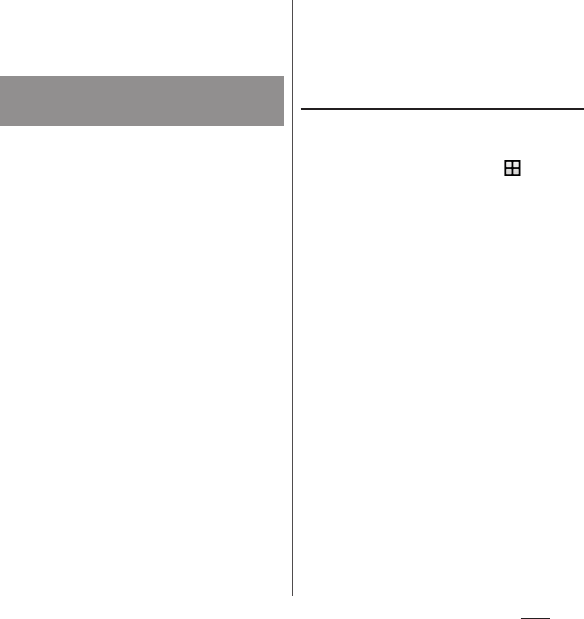
155
Apps
・
For the supported models or detailed
use method, refer to NTT DOCOMO
website.
You can transfer or back up the data such as
phonebook entries or images using a
microSD card.
・
Do not remove the microSD card of turn off
the terminal during backup or restoring. The
data may be damaged.
・
If phonebook item names (e.g. phone
number, etc.) of the other terminal are
different from ones of your terminal, the item
names may be changed or deleted. Also,
some text may be deleted in copied
destination, because savable characters in a
phonebook entry vary by terminal.
・
Contacts that can be backed up are the
registered contacts in the docomo account.
・
When backing up the phonebook entries to a
microSD card, the data without Name
registered cannot be copied.
・
If microSD card is low on memory, backup
may not be done. In that case, delete
unnecessary files to make available space.
・
If the battery is low, backup or restoration may
not be done. In that case, charge the terminal
and retry to back up or restore.
・
You can back up only the data such as still
images and movies stored in the internal
storage with this application. The data stored
in a microSD card cannot be backed up.
Backing up
Back up the data such as phonebook entries
or media files to a microSD card.
1
From the Home screen,
u
[Data
Copy]
u
[Backup & Restore].
2
[Backup].
3
Mark the data to back up.
4
[Start backup]
u
[BACKUP].
・
The selected data can be saved to the
microSD card.
5
[Back to top].
Backing up/Restoring to/from a
microSD card
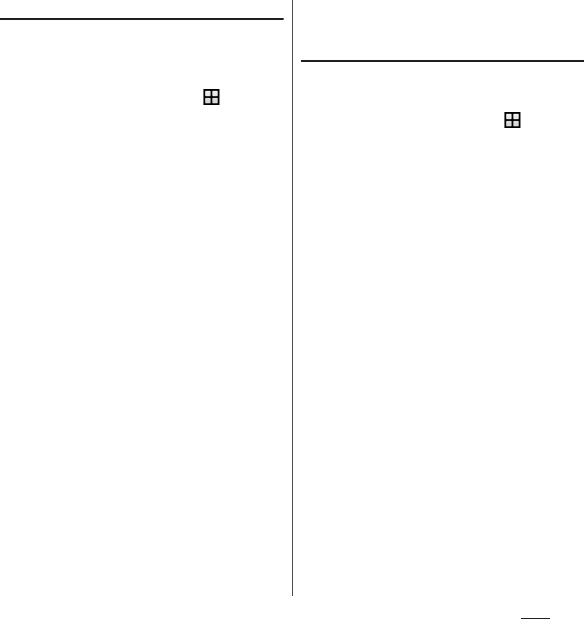
156
Apps
Restoring
Restore the data such as phonebook entries
or media files backed up to the microSD card
to the terminal.
1
From the Home screen,
u
[Data
Copy]
u
[Backup & Restore].
2
[Restore].
3
Tap [Select] on data type to restore
u
Mark data to restore
u
[Select].
・
Tap [Select latest data] to select the
latest data for each data type.
4
Select the restoration method
u
[Start restore]
u
[RESTORE].
・
For some data types, selecting the
restoration method is not necessary.
・
The selected data is restored to the
terminal.
5
[Back to top].
Copying phonebook entries
registered in Google account to
docomo account
You can copy the contacts data in your
Google account to the docomo account.
1
From the Home screen,
u
[Data
Copy]
u
[Backup & Restore].
2
[Phonebook account copy]
u
[Select] on Google account
contacts to copy
u
[Overwrite]/
[Add].
・
The copied contacts are saved to your
docomo account.
3
[OK].
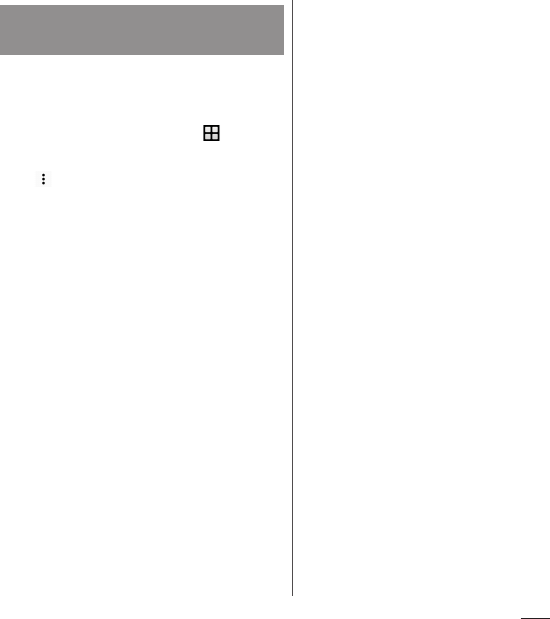
157
Apps
You can transfer or back up the data such as
call history or music using the Data Storage
BOX (Cloud).
1
From the Home screen,
u
[Data
Copy].
2u
[Backup/Restore to Cloud].
3
[Backup] or [Restore].
・
After this step, follow the onscreen
instructions.
・
When you do not log in to docomo
cloud, on the confirmation screen, tap
[Log in], then follow the onscreen
instructions to log in.
❖
Information
・
The periodical backup may not be executed at the
specified time while the screen lock is set or
"STAMINA mode" (P.177) is enabled. In the case, the
backup will be executed when the activation is
possible next time.
・
Note that use of Periodical backup with Data Storage
BOX (Cloud) may incur a high packet communication
charge.
Backing up/Restoring to/from
Data Storage BOX
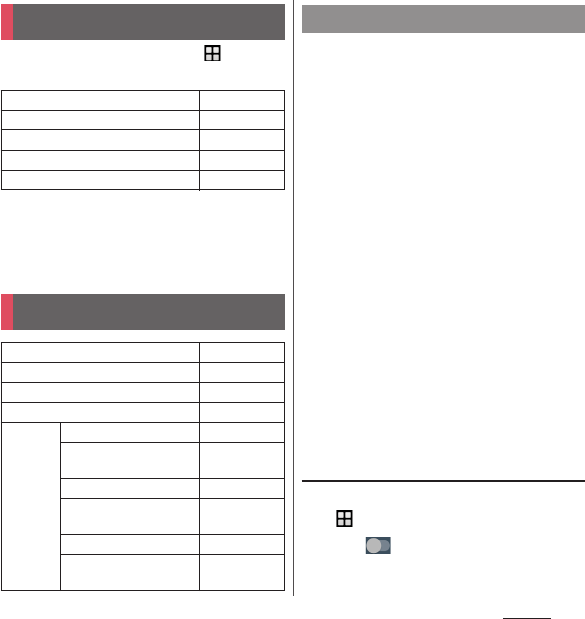
158
Settings
Settings
1
From the Home screen,
u
[Settings].
❖
Information
・
The item indicating the set function may be
displayed above the "Wireless & networks"
depending on the condition of usage of the terminal.
With Wi-Fi function, you can connect to an
access point for your home, company
network or public wireless LAN services to
use mail and Internet.
■
Reception interference caused by
Bluetooth devices
Wireless LAN (IEEE802.11b/g/n) devices and
the Bluetooth devices use the same
frequency band (2.4GHz). If you use the
terminal near Bluetooth devices, reception
interference may occur or the
communications speed may lower. Also,
you may hear noise or have a connection
problem. Communication may be
interrupted or sound may be lost when
playing back streaming data, etc. In these
cases, do the following:
・
Keep the terminal approximately 10 m or
more away from the Bluetooth device.
・
For using within approximately 10 m, turn
off the Bluetooth device.
Turning on Wi-Fi
1
From the Home screen,
u
[Settings]
u
[Wi-Fi].
2
Tap .
・
It may take a few seconds to turn on
the Wi-Fi.
Viewing the setting menu
Wireless & networks
P. 1 5 8
Themes & wallpaper
P. 1 6 8
Device
P. 1 6 8
Accounts & services
P. 1 8 6
System
P. 1 9 0
Wireless & networks
Wi-Fi
P. 1 5 8
Bluetooth
P. 1 9 7
Data usage
P. 1 6 1
Device connection
P. 1 6 3
More Airplane mode
P. 1 6 3
Tethering & portable
hotspot
P. 1 6 4
VPN
P. 1 6 6
Mobile networks
P.167, P.206,
P. 2 0 7
Network settings reset
P. 1 6 8
NFC / Osaifu-Keitai
settings
P.122, P.199
Wi-Fi
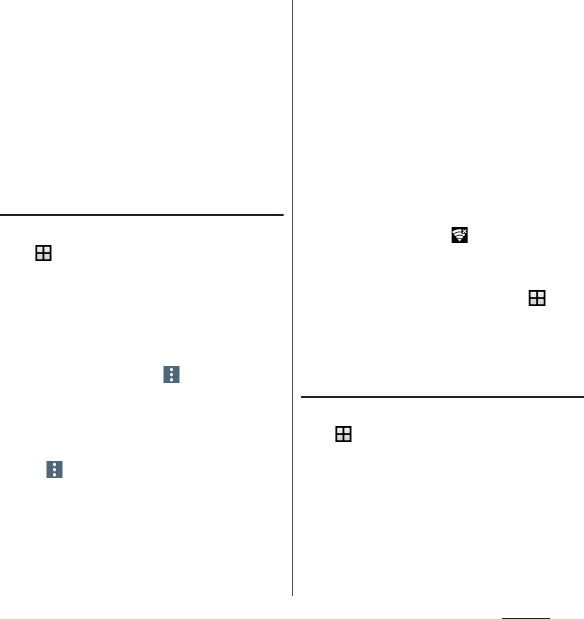
159
Settings
❖
Information
・
Even when Wi-Fi is on, packet communication is
available. When a Wi-Fi network is disconnected, the
connection is automatically switched to the LTE/3G/
GSM network mode. Note that packet
communication charge may be applied if the
network connection is kept switched.
・
Turn the Wi-Fi function to off when you do not use
Wi-Fi to cut battery power consumption.
・
Make sure to receive signal strong enough for using
Wi-Fi function.
Connecting to a Wi-Fi network
1
From the Home screen,
u
[Settings]
u
[Wi-Fi].
2
Select a Wi-Fi network to connect.
・
To connect to a protected Wi-Fi
network, enter the password
u
[CONNECT].
・
To connect a Wi-Fi network with WPS
compatible device,
u
[More features]
u
Tap [WPS Push Button]/[WPS PIN
Entry] and follow the onscreen
instructions.
・
To scan Wi-Fi networks manually,
u
[Refresh].
❖
Information
・
Depending on your environment, the connection
speed may be slow, or Wi-Fi may not be available.
・
When the terminal is connected to Wi-Fi network
successfully, "Connected" appears. When a different
message appears, make sure the password (security
key).
When the connection is not established even if you
enter a correct password (security key), the correct IP
address may not have been acquired. Check the
signal status and reconnect. It may take 5 minutes or
more to display the connection result after the
operation of the connecting to Wi-Fi network.
・
If you connect to an access point that is not
connected to the Internet, appears and
communication may be performed via mobile
network, not via Wi-Fi.
・
To use docomo services via Wi-Fi, you need to set up
your d ACCOUNT. From the Home screen,
u
[Settings]
u
[docomo service/cloud]
u
[d ACCOUNT
setting] to set.
Deleting connecting Wi-Fi network
setting
1
From the Home screen,
u
[Settings]
u
[Wi-Fi].
2
Tap the Wi-Fi network that is
currently connected.
3
[FORGET].
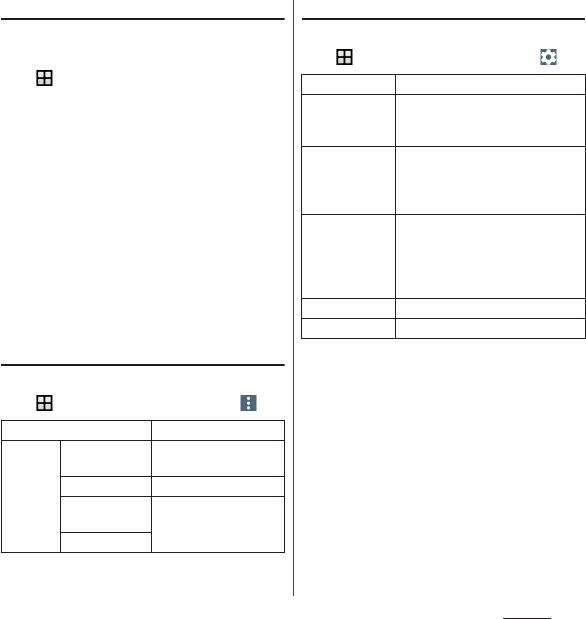
160
Settings
Adding a Wi-Fi network manually
・
Turn Wi-Fi on beforehand (P.158).
1
From the Home screen,
u
[Settings]
u
[Wi-Fi].
2
[Add network]
u
Enter the name
(SSID) of the Wi-Fi network.
3
Tap "Security" setting item
u
Tap a
security type of the Wi-Fi network
you want to add.
・
Select from the 4 options: "None",
"WEP", "WPA/WPA2 PSK", or "802.1x EAP"
4
If required, enter security
information for the Wi-Fi network
you want to add.
5
[SAVE].
Using optional menu
1
From the Home screen,
u
[Settings]
u
[Wi-Fi]
u
Tap .
Setting up Wi-Fi
1
From the Home screen,
u
[Settings]
u
[Wi-Fi]
u
Tap .
Refresh
P. 1 5 9
More
features
Install
certificates
Install certificates.
Wi-Fi Direct
P. 1 6 1
WPS Push
Button
P. 1 5 9
WPS PIN Entry
Saved networks
Display saved Wi-Fi networks.
Network
notification
Set whether to notify when Wi-Fi
open network is detected.
・
Turn Wi-Fi on beforehand (P.158).
Avoid poor
connections
Set whether to use the LTE/3G/GSM
network mode when Wi-Fi radio
waves are weak or communication
quality is bad.
Keep Wi-Fi on
during sleep
Set whether to disable the Wi-Fi
function when the screen backlight
turns off.
・
By default, "Only when plugged
in" is set.
MAC address
Check MAC address.
IP address
Check IP address.
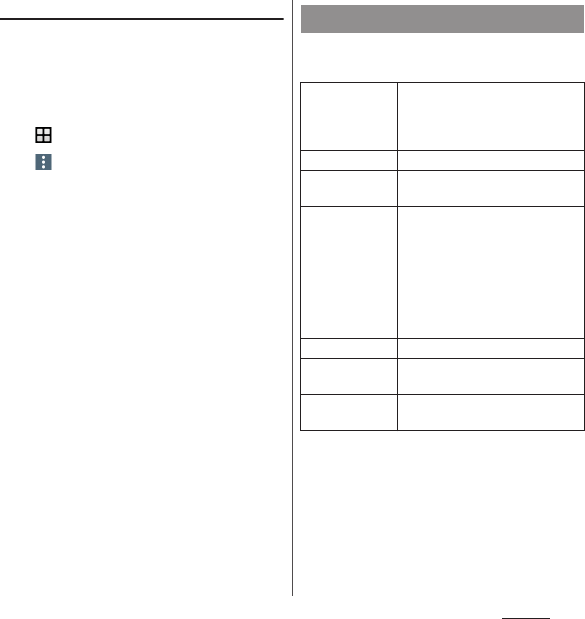
161
Settings
Using the Wi-Fi Direct function
You can connect among the devices
compatible with Wi-Fi Direct
®
via Wi-Fi even
without configuring access point.
・
Turn Wi-Fi on beforehand (P.158).
1
From the Home screen,
u
[Settings]
u
[Wi-Fi].
2u
[More features]
u
[Wi-Fi
Direct].
3
Select a Wi-Fi Direct compatible
device name to connect.
・
Tap [SEARCH FOR DEVICES] to refresh
the list of detected devices.
・
To change your terminal's name
displayed on the detected Wi-Fi Direct
compatible device, tap [RENAME
DEVICE].
❖
Information
・
Wi-Fi Direct function becomes available when you
install a compatible application.
Check the data usage or make settings for
mobile data communication.
Data usage
Usage
Displays the mobile data usage of
the period that is set to "Billing
cycle". Tap to set the warning
volume of data usage.
Data Saver
P. 1 6 2
Mobile data
traffic
P. 1 6 2
Cellular data
usage
The mobile data usage of the
period that is set to "Billing cycle"
can be checked with a graph.
・
To set the restriction of data
communication in the
background for each application,
select the application displayed
below the graph.
Billing cycle
P. 1 6 2
Wi-Fi data usage
Check the used volume of the Wi-Fi
data usage.
Network
restrictions
Set to restrict use of specified Wi-Fi
network.
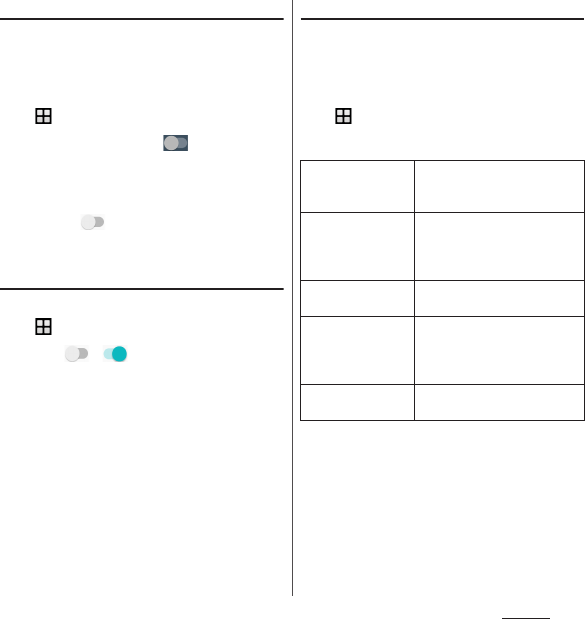
162
Settings
Enabling Data saver
Restrict the data communication in the
background by the applications to reduce
the data usage.
1
From the Home screen,
u
[Settings]
u
[Data usage].
2
[Data saver]
u
Tap .
❖
Information
・
To set the applications to be unrestricted in Data
saver, in Step 2, [Data saver]
u
[Unrestricted data
access]
u
Tap of the application.
Enabling/Disabling mobile data
communication
1
From the Home screen,
u
[Settings]
u
[Data usage].
2
Tap / for "Mobile data
traffic".
3
Read the note and tap [OK].
Setting Billing cycle
Set the billing period (measuring period) of
data communication, or the warning volume
or the upper limit of data usage amount.
1
From the Home screen,
u
[Settings]
u
[Data usage].
2
[Billing cycle].
❖
Information
・
Displayed data usage volume is an estimate. It may
be different from the actual one. You can check your
data usage volume at My docomo.
・
Note that mobile data communication will suspend
when data usage volume reaches to the set limit
volume.
To resume the mobile data communication, on the
pause screen, tap [RESUME], or drag the status bar
down
u
[Mobile data limit reached]
u
Tap [RESUME].
Billing cycle
Set the billing period
(measuring period) of data
communication.
Set data warning
Set whether to notify with a
warning when the data usage
reaches to the set warning
volume.
Data warning
Set a warning volume of data
usage.
Set data limit
Set whether to temporarily stop
the data communication when
the data usage reaches to the
limit volume.
Data limit
Set a limit volume of data
usage.
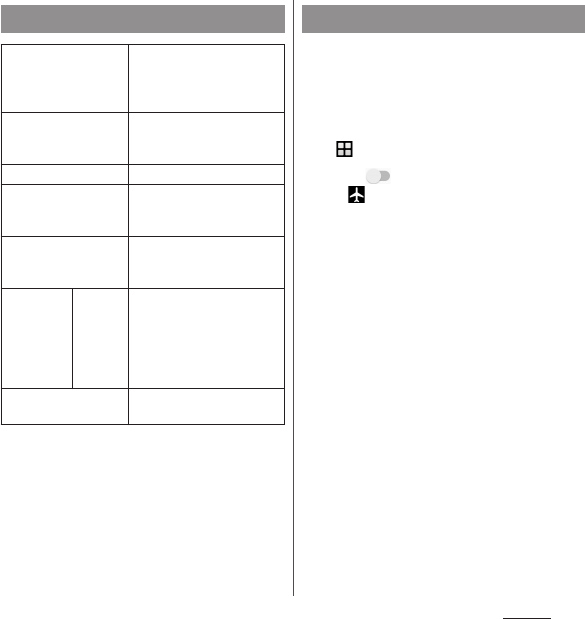
163
Settings
* Compatible with Wi-Fi CERTIFIED Miracast
™
Depending on usage environment, image or sound
may be interrupted or stopped.
Covering around the Wi-Fi antenna area with your
hand may affect the quality of transferring images.
In this mode, the functions of using radio
wave transmissions such as calling, accessing
to the Internet (including sending/receiving
mails), etc. are disabled.
1
From the Home screen,
u
[Settings]
u
[More].
2
Tap for "Airplane mode".
・
appears on the status bar.
❖
Information
・
Even if Airplane mode is ON, Wi-Fi, Bluetooth
function and NFC Reader/Writer, P2P function can be
turned on. Do not turn on these functions in a place
where the use of radio wave is prohibited.
Device connection
Screen mirroring
*
Connect to a TV or tablet
compatible with Screen
mirroring to display the
screen on the terminal.
Cast
Display the terminal's screen
on a device that supports
Google Cast.
Media server
P. 2 0 3
Keep your device's
screen on
Set whether to light the
terminal backlight while an
external device is connected.
DUALSHOCK
™
4
Set to allow a wireless
controller (DUALSHOCK
™
4)
to operate the terminal.
USB
Connectivity
Install
software
Set whether to display a
screen for installing software
that can manage the
contents of the terminal
from a PC when the terminal
is connected to a PC.
Printing
Install print service
applications.
Airplane mode

164
Settings
Use tethering function to enable the terminal
to use as modem to allow USB compatible
devices, wireless LAN devices or Bluetooth
devices to access the Internet.
❖
Information
・
If you want to use tethering, subscription to Packet
Pack/packet flat-rate service is strongly
recommended.
・
When the docomo nano UIM card is not inserted,
mobile data communication is disabled, or the
terminal is out of service area, USB tethering, the
portable hotspot and Bluetooth tethering that use
mobile network are not available.
Enabling USB tethering
1
Connect the terminal to a PC with
USB cable A to C 01 (optional) etc.
(P.41).
・
The "Use USB to" screen appears on the
terminal.
・
When a screen for installing driver
software appears, wait for a while until
the installation is complete.
・
When the "Install software" screen
appears on the terminal, tap [SKIP] or
[CANCEL].
2
[USB tethering].
3
Tap for "USB tethering".
・
When you use this function for the first
time, the driver software for the
terminal is installed to a PC. Wait for a
while until installation is complete.
❖
Information
・
System requirements (OS) for USB tethering are as
follows.
- Microsoft Windows 10
- Microsoft Windows 8.1
- Microsoft Windows 7
・
In USB tethering mode, you cannot access your
terminal's internal storage or microSD card from the
PC.
・
USB tethering can be used with the portable hotspot
or Bluetooth tethering at the same time.
Enabling Portable hotspot
You can use the terminal as a Wi-Fi access
point to connect up to 10 wireless LAN
devices to the Internet simultaneously.
1
From the Home screen,
u
[Settings]
u
[More]
u
[Tethering & portable hotspot].
2
Tap for "Portable hotspot".
Using tethering function

165
Settings
❖
Information
・
If the portable hotspot starts while connecting to Wi-
Fi network, Wi-Fi connection is disconnected. Wi-Fi
network is automatically connected when the
portable hotspot ends.
・
The portable hotspot can be used with USB
tethering or Bluetooth tethering at the same time.
・
To connect a wireless LAN device via NFC, tap [One-
touch portable hotspot] in Step 2.
・
If you operate from [Portable hotspot settings] in
Step 2
u
[Power save] to enable power saving, the
portable hotspot turns off automatically when the
specified time arrives without connecting to wireless
LAN devices.
Changing the portable hotspot
settings
You can change the network name (SSID),
security setting, or password set by default.
1
From the Home screen,
u
[Settings]
u
[More]
u
[Tethering & portable hotspot].
2
[Portable hotspot settings]
u
[Configure hotspot].
3
Enter the network name (SSID) of
the Wi-Fi access point you want to
set.
・
The device name of the terminal is set
by default.
4
Tap "Security" setting item
u
Tap a
security type of the Wi-Fi access
point you want to set.
5
Enter a password of the Wi-Fi
access point to set as required.
・
By default, a password is set in a
random manner.
6
[SAVE].
Enabling Bluetooth tethering
Up to 4 Bluetooth devices can be connected
to the Internet.
1
From the Home screen,
u
[Settings]
u
[More]
u
[Tethering & portable hotspot].
2
Tap for "Bluetooth tethering".
❖
Information
・
To connect the terminal from a Bluetooth device,
perform pairing (P.198) and operate the internet
access on the Bluetooth device. For operation on a
Bluetooth device, refer to the manuals of the
Bluetooth device.
・
Bluetooth tethering can be used with USB tethering
or the portable hotspot at the same time.
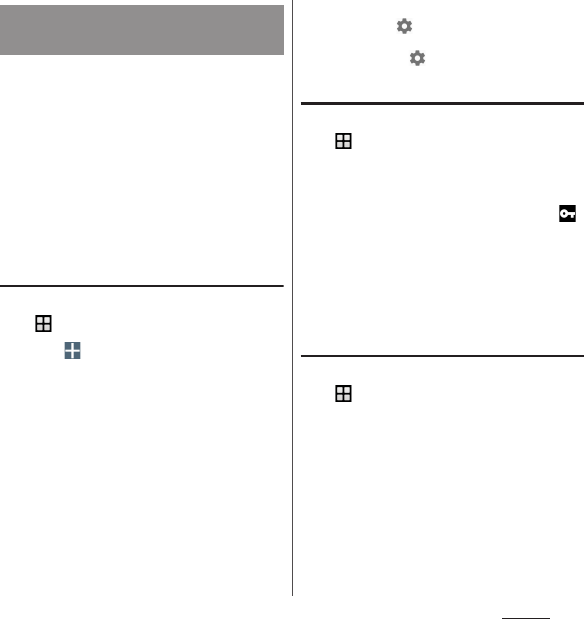
166
Settings
Use Virtual Private Network (VPN) to connect
to the information in a protected local
network such as companies, schools or other
facilities from outside.
・
To set up a VPN on the terminal, you need to
retrieve the information related to security
from your network administrator. For details,
see the following website.
http://www.sonymobile.co.jp/support/ (In
Japanese only)
Adding a VPN
1
From the Home screen,
u
[Settings]
u
[More]
u
[VPN].
2
Tap .
・
When the note appears, follow the
onscreen instructions to set unlocking
method of screen lock (P.181).
3
When an editing screen is
displayed, follow the instruction of
the network administrator to
enter/set required items of VPN
settings.
4
[SAVE].
❖
Information
・
To edit VPN, tap of VPN in Step 2
u
Enter or set
each item
u
[SAVE].
・
To delete VPN, tap of VPN in Step 2
u
[FORGET].
Connecting to a VPN
1
From the Home screen,
u
[Settings]
u
[More]
u
[VPN].
2
Tap a VPN to connect to.
3
[CONNECT].
・
When you are connected to a VPN,
appears in the status bar.
・
If the username or the password is not
entered when the VPN is added, enter
the necessary information
u
Tap
[CONNECT].
Disconnecting a VPN
1
From the Home screen,
u
[Settings]
u
[More]
u
[VPN].
2
Tap a connected VPN
u
[FORGET].
Connecting to a VPN (Virtual
Private Network)
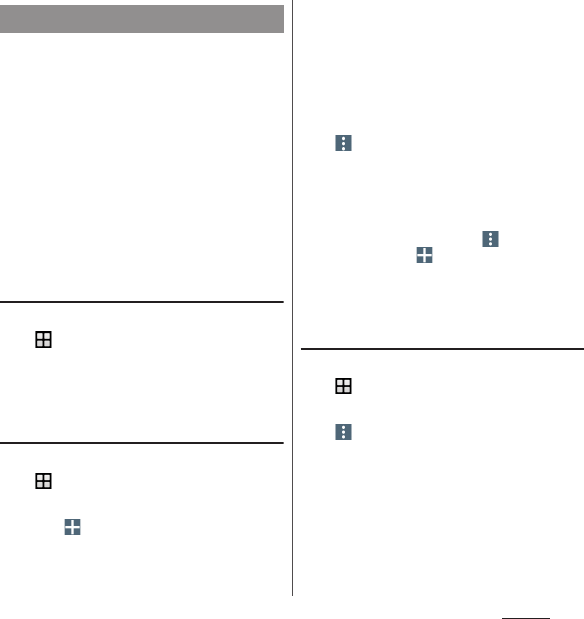
167
Settings
An access point for connecting to the
Internet (sp-mode) is already registered. You
can add or change it if necessary.
For details of sp-mode, refer to NTT DOCOMO
website.
https://www.nttdocomo.co.jp/service/
spmode/ (in Japanese only)
For using mopera U and Business mopera
Internet, add the access point manually.
For details on mopera U, refer to mopera U
website.
https://www.mopera.net/ (in Japanese only)
Checking the access point in use
1
From the Home screen,
u
[Settings]
u
[More]
u
[Mobile
networks]
u
[Access Point Names].
・
The radio button on the right of current
access point is marked.
Setting an access point additionally
1
From the Home screen,
u
[Settings]
u
[More]
u
[Mobile
networks]
u
[Access Point Names].
2
Tap .
・
To edit the access point, tap the access
point.
3
[Name]
u
Enter a name
u
[OK].
4
[APN]
u
Enter an access point name
u
[OK].
5
Tap and enter all other
information required by your
network operator.
6u
[Save].
❖
Information
・
Do not change the MCC/MNC. If you change them to
the values other than the default (440/10), the access
point will not be displayed on the APN screen. If the
set access point is not displayed, in Step 2
u
Tap
[Reset to default] or , then set the access point
again.
・
It is recommended that you use the access point that
is registered by default as it is.
Initializing an access point
1
From the Home screen,
u
[Settings]
u
[More]
u
[Mobile
networks]
u
[Access Point Names].
2u
[Reset to default].
Setting an access point
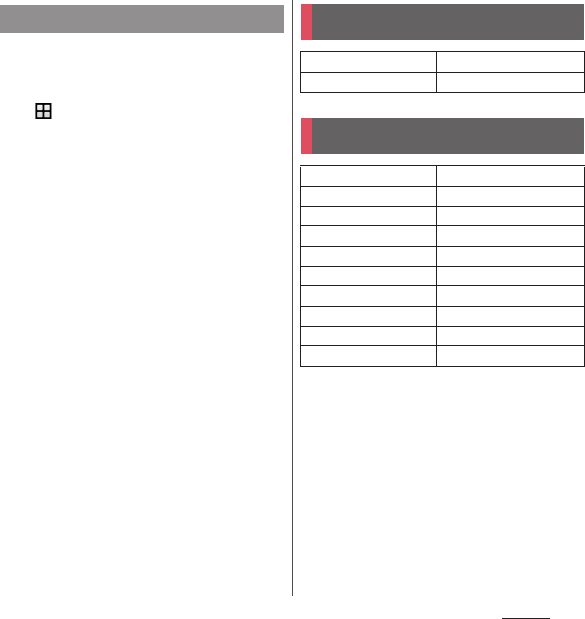
168
Settings
All network settings set to the terminal can
be reset.
1
From the Home screen,
u
[Settings]
u
[More]
u
[Network
settings reset].
2
[RESET SETTINGS]
u
[RESET
SETTINGS].
Resetting the network settings
Themes & wallpaper
Themes
P. 5 8
Wallpaper
P.57, P.82
Device
Display
P. 1 6 9
Notifications
P. 1 7 0
Sound
P. 1 7 1
Apps
P. 1 7 3
Storage & memory
P. 1 7 5
Battery
P. 1 7 7
Lock screen & security
P. 1 7 8
Users
P. 1 8 5
Call
P.97, P.210
Location
P. 1 8 6
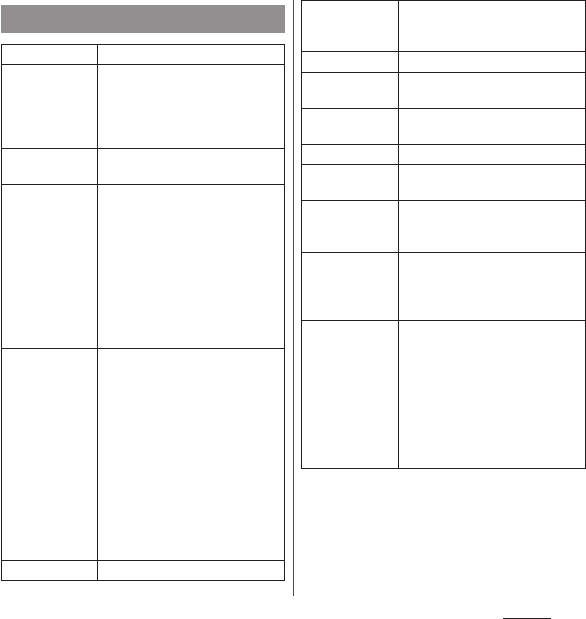
169
Settings
Display
Brightness level
P. 1 7 0
Adaptive
brightness
Adjust the screen brightness
automatically according to the
ambient brightness with reference
to the brightness set in "Brightness
level".
Sleep
Set a time for turning off of screen
backlight.
Smart backlight
control
Set the screen backlight not to turn
off when you use the terminal
holding with your hand even while
touch operation is not performed.
・
The screen backlight may turn
off if the terminal remains at rest
for a while even when you set
Smart backlight control to ON
and hold the terminal with your
hand.
Image
enhancement
Set the screen to display photos
and videos vividly and at high
resolution. Note that the image
quality of still images can only be
enhanced when viewing in the
"Album" application.
・
Select "X-Reality for mobile" to
enhance patterns and outlines
so that sharp images with
detailed textures are produced.
・
Select "Super-vivid mode" to
enhance colors so that sharp,
vivid images are produced.
White balance
P. 1 7 0
Change font
Change font.
・
Your terminal restarts when you
change the setting.
Font size
Set font size.
Display size
Enlarge/reduce of the size of the
icon etc. displayed in the screen.
System icons
Select icons to be displayed in the
status bar.
Screen saver
Set the screensaver.
When device is
rotated
P. 4 6
Jump to camera
Set whether to enable activation of
"Camera" application by pressing
O
twice.
Cover selection
Set to correct the screen
brightness or turn off the screen
backlight according to the cover
(commercially available) you use.
Glove mode
Increase touch sensitivity to enable
touch operation with gloved hand.
・
Touching screen with gloved
hand with Glove mode ON, a
ring appears where you touch
on the screen.
・
Depending on the material of
gloves, touch operation may be
difficult.
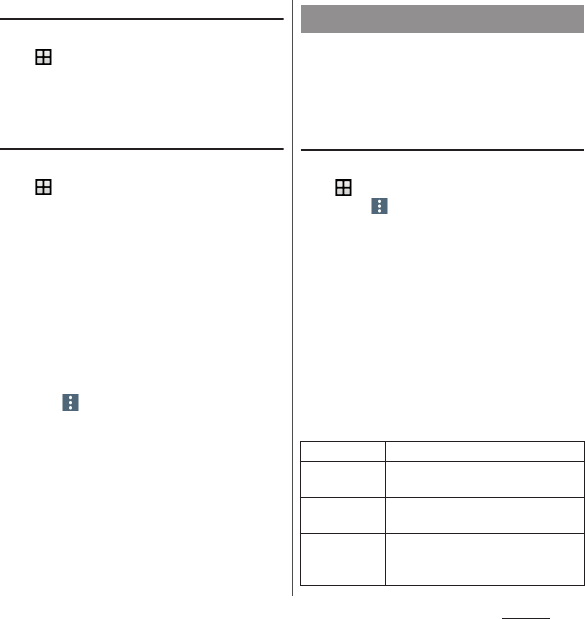
170
Settings
Adjusting the screen brightness
1
From the Home screen,
u
[Settings]
u
[Display]
u
[Brightness level].
2
Drag the slider to the right or left.
Adjusting the white balance
1
From the Home screen,
u
[Settings]
u
[Display]
u
[White
balance].
2
Tap the slider at the position to set
or drag it to the right or left.
・
Touch and hold the area displaying
"Press and hold here to see previous
setting" to check the setting before
adjusting.
3
[DONE].
❖
Information
・
In Step 2,
u
[Default values]
u
[DONE] to reset
back to the default status.
Set the notifications of each application or
function. Also, you can change the operation
of the notification LED or the setting of
notifications for the lock screen.
Setting the notification of application
1
From the Home screen,
u
[Settings]
u
[Notifications].
・
Tap
u
[Show system] to show all
applications.
・
To select the condition of displaying
applications, tap [All apps] in the upper
part of the screen.
2
Tap an application.
・
Drag the screen up or down to display
the scroll bar in the right end of the
screen, and then drag the scroll bar up
or down. The index character appears
in a pop-up and you can search the
application by the index character.
Notifications
Block all
Set to block the all notifications.
Sound and
vibrations off
Set to notify only with the display of
notifications.
On the lock
screen
*1
Set whether to display the
notifications on the lock screen.
Interrupts
Priority only
Set whether to notify with sound
when Do not disturb function
*2
is set
to "Priority only".
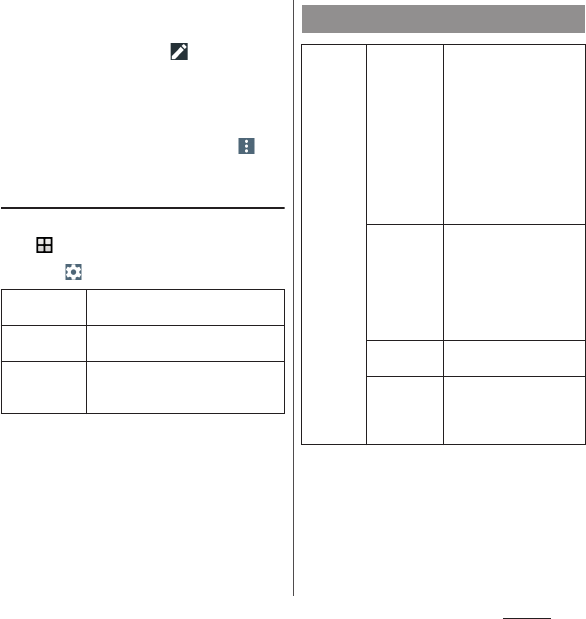
171
Settings
*1 Displayed when the screen lock unlocking method
is set to "Pattern"/"PIN"/"Password".
*2 Set from the quick setting tool of the quick settings
panel (P.54). Before using, tap and set "Do not
disturb" as an available quick setting tool.
❖
Information
・
The items that can be set vary depending on the
settings of the terminal or application/function.
・
To reset the settings for the application, tap in
Step 2
u
[Reset app references] (P.175).
Changing the notification settings
1
From the Home screen,
u
[Settings]
u
[Notifications].
2
Tap .
* Displayed items that are displayed vary depending
on the settings of "Screen lock" (P.181).
Notification
light
Set whether to notify missed calls etc.
with blinking notification LED (P.50).
On the lock
screen
Set whether to show notification
details on the lock screen.
*
Keep
notification on
lockscreen
Set whether to keep the notification
content displayed on the lock screen
when you have any notifications.
Sound
Audio
settings
DSEE HX
Set whether to reproduce
sound with the quality
equivalent to high-
resolution audio when
playing back compressed
music files. This feature
works only when the
headphone that support
high-resolution audio is
connected to the headset
jack.
ClearAudio+
The sound setting for
music recommended by
Sony. It helps optimize the
settings for digital signal
processing technology
with a one-touch
operation.
Sound
effects
Set sound effects.
Dynamic
normalizer
Set to play at a
comparable volume when
songs with different
volume levels are played.
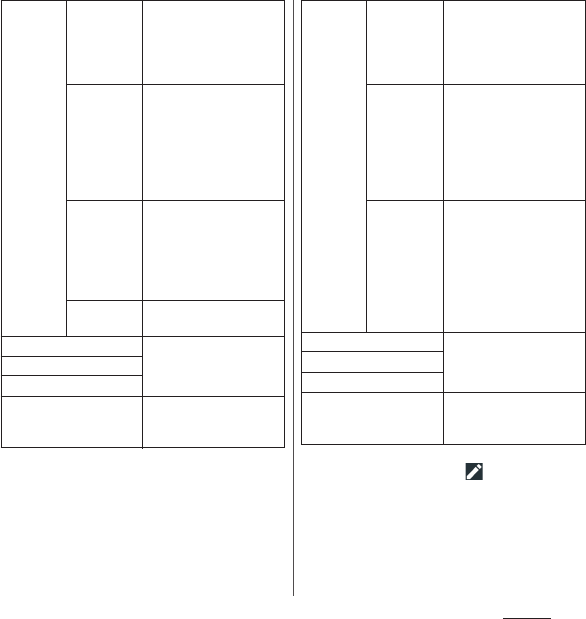
172
Settings
* Set from the quick setting tool of the Quick settings
panel (P.54). Before using, tap and set "Do not
disturb" to the available quick setting tool.
❖
Information
・
For silent mode, see "Setting silent mode" (P.46).
Accessory
settings
Automatic
optimization
Optimize sound quality by
analyzing characteristics
of a connected
headphone and acoustic
sense.
Noise
canceling
Reduce background noise
by turning on the noise-
canceling function. The
setting can be made
when the noise-canceling
headphones are
connected.
LDAC
playback
quality
Set to use LDAC
compatible device for
playback of high sound
quality audio. The setting
can be made when LDAC
device is connected.
Mic
sensitivity
Set the microphone
sensitivity.
Media volume
P. 1 7 3
Alarm volume
Ring volume
Also vibrate for calls
Set whether to vibrate the
terminal when receiving a
call.
Do not
disturb
Allowed in
Priority only
Set the type of
notification priority to
notify when Do not
disturb function
*
is set to
"Priority only".
Automatic
rules
Set rules to activate the
Do not disturb function
*
automatically at the
specified day of week and
time or the scheduled
date and time registered
in "Calendar" application.
Block visual
disturbances
Set whether to restrict the
notification operations
such as the pop-up,
turning on of the screen
backlight, or turning on/
off of the notification LED
when the Do not disturb
function
*
is set.
Phone ringtone
P. 1 7 3
Notification sound
Default alarm ringtone
Other sounds
Set Dialpad tones/Screen
locking sounds/Touch
sounds/Vibrate on touch.
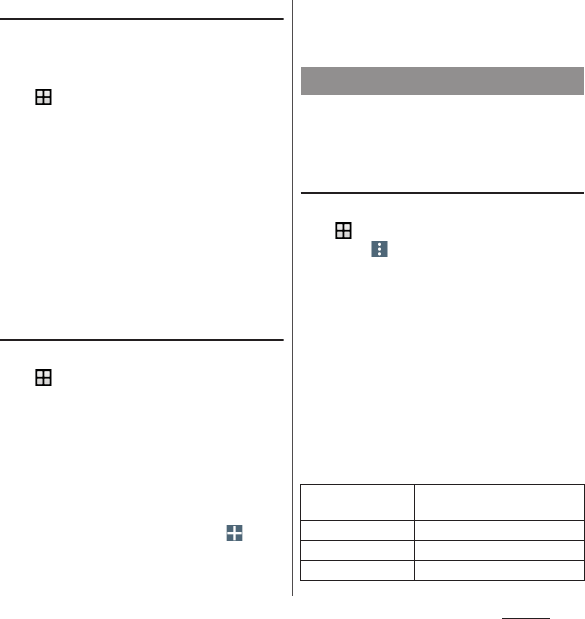
173
Settings
Adjusting sound volumes
Adjust the volumes for playing media, alarm,
ringtone and notification sounds.
1
From the Home screen,
u
[Settings]
u
[Sound].
2
Drag the slider of "Media volume"/
"Alarm volume"/"Ring volume" left
or right.
❖
Information
・
The alarm volume set via the "Clock" application has
precedence (P.153).
・
You can also press the volume key to adjust the
ringtone volume. Pressing the volume key or
O
mutes ringtone for incoming calls.
Setting the ringtone/notification
sound/alarm ringtone
1
From the Home screen,
u
[Settings]
u
[Sound].
2
Tap any of [Phone ringtone]/
[Notification sound]/[Default
alarm ringtone].
3
Select the sound
u
[DONE].
❖
Information
・
To set a ringtone, notification sound, alarm ringtone
other than the ones stored by default, tap in Step
3.
・
When the sound is selected in Step 3, it sounds with
the volume set in "Ring volume" or "Alarm volume".
However, if the volume is set to 0, it does not sound.
Manage and uninstall installed applications.
Also, show memory usage status or change
the settings.
Managing applications
1
From the Home screen,
u
[Settings]
u
[Apps].
・
Tap
u
[Show system] to show all
applications.
・
To select the condition of displaying
applications, tap [All apps] in the upper
part of the screen.
2
Tap an application.
・
Drag the screen up or down to display
the scroll bar in the right end of the
screen, and then drag the scroll bar up
or down. The index character appears
in a pop-up and you can search the
application by the index character.
Apps
UNINSTALL/
DISABLE
P.174, P.175
FORCE STOP
P. 1 7 4
Storage
Clear data or cache.
Data usage
Check data usage amount.
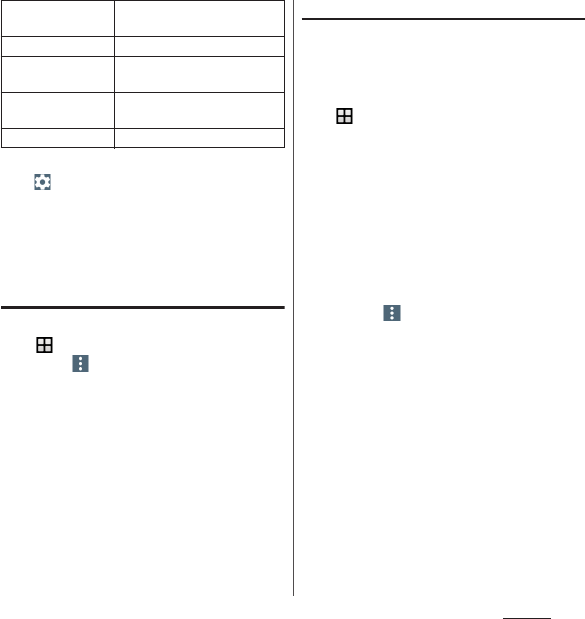
174
Settings
❖
Information
・
Tap in Step 2 to set Preferred apps settings, App
permissions, App links, default application setting,
etc.
・
The displayed items may differ or the item may not
be selected depending on application or usage
condition.
Force-quitting an application
1
From the Home screen,
u
[Settings]
u
[Apps].
・
Tap
u
[Show system] to show all
applications.
2
Tap the application to force-stop.
3
[FORCE STOP]
u
Read the notes and
tap [OK].
Uninstalling applications
・
Before uninstalling application, back up
contents you want to save including data
saved in the application.
1
From the Home screen,
u
[Settings]
u
[Apps].
2
Tap the application to uninstall.
3
[UNINSTALL]
u
[OK].
❖
Information
・
Some pre-installed applications may not be
uninstalled. For some applications which cannot be
uninstalled, disabling is possible (P.175).
・
Applications downloaded from Google Play are
recommended to be uninstalled from the Google
Play screen (P.121).
・
In Step 3, tap
u
If [UNINSTALL UPDATES] is
displayed, you can restore the application to the
default.
Permissions
Change access authorization
setting.
Notifications
Change notification setting.
Open by default
Clear the setting of default
application.
Battery
Check the battery use condition
after the previous full-charging.
Memory
Check memory usage amount.
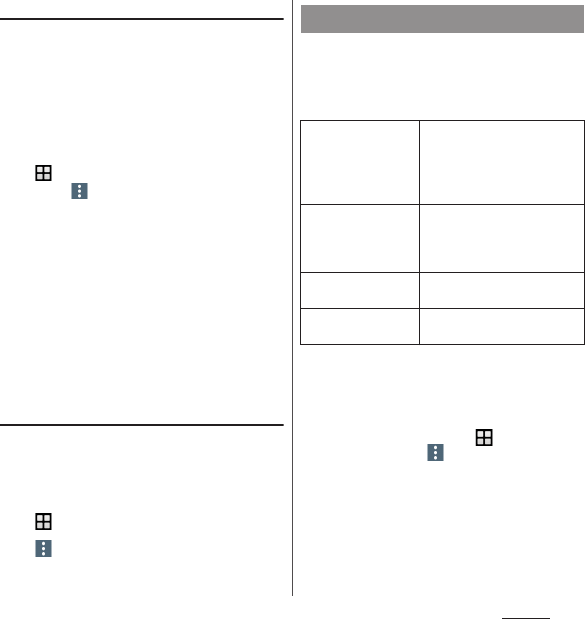
175
Settings
Disabling application
You can disable services or applications that
cannot be uninstalled.
・
Disabled applications are not displayed on
the Home screen or application screen and
you cannot execute them, but they are not
uninstalled.
1
From the Home screen,
u
[Settings]
u
[Apps].
・
Tap
u
[Show system] to show all
applications.
2
Tap the application to disable.
3
[DISABLE]
u
Read the notes and tap
[DISABLE APP].
❖
Information
・
When you disabled an application, some other
applications linked to the disabled application may
not be operated correctly. Enable the disabled
application again to operate them correctly.
Resetting applications
You can reset the disabled applications
(P.175), the default applications (P.173), and
the restriction of background data (P.161).
1
From the Home screen,
u
[Settings]
u
[Apps].
2u
[Reset app preferences].
3
[RESET APPS].
Optimize the storage and memory, transfer
data, or uninstall applications to improve
operations of the terminal or make available
memory space for the internal storage.
* Only data in specific folders stored in the internal
storage will be transferred to the microSD card.
❖
Information
・
To set applications for not clearing cache by Smart
cleaner, from the Home screen,
u
[Settings]
u
[Storage & memory]
uu
[Advanced]
u
[Keep
cache]
u
Tap "APPS" tab
u
Mark applications to be set.
Storage & memory
Storage usage
The storage usage is displayed.
Tap to check the details of the
storage usage, or initialize the
microSD card/USB storage
(formatting) (P.176).
Smart cleaner
Set whether to optimize the
storage and memory
automatically depending on
use frequency.
Transfer data
*
Transfer data in the internal
storage to the microSD card.
Free up space
Select files to delete or
applications to uninstall.
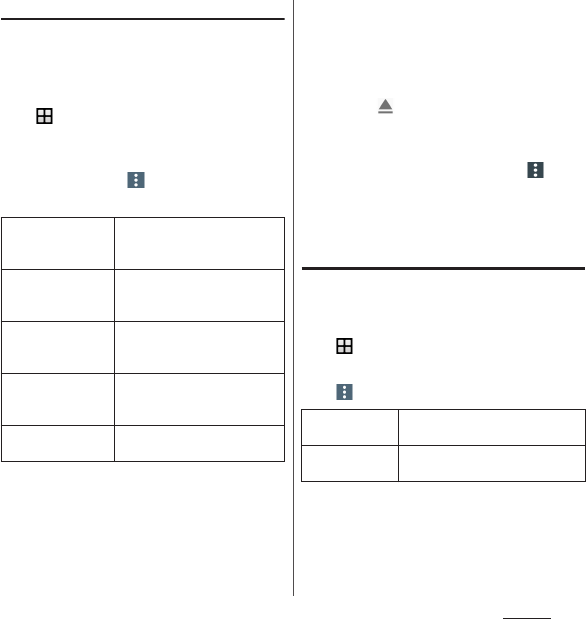
176
Settings
Viewing the storage use condition
Check memory volume of the internal
storage, microSD card, USB storage, or format
microSD card or USB storage.
1
From the Home screen,
u
[Settings]
u
[Storage &
memory].
2
[Storage usage].
・
Alternatively,
u
[Advanced]
u
[Storage].
*1 Displayed items vary depending on condition of
microSD card or USB storage recognition.
*2 Only data in specific folders stored in the internal
storage will be transferred to the microSD card.
❖
Information
・
After the operation in Step 2, [Internal shared
storage]
u
[Explore], or tap [SD Card]/[USB drive] to
display the data list, you can check the saved data or
copy/move/delete/share the data (P.195).
・
To release the recognition of microSD card/USB
storage, tap of "SD Card"/"USB drive" after the
operation in Step 2. To recognize again, tap [SD
Card]/[USB drive]
u
[MOUNT].
・
To format a microSD card/USB storage, tap [SD Card]/
[USB drive] after the operation in Step 2
uu
[Storage settings]
u
[Format]
u
[ERASE & FORMAT].
Be aware that formatting will erase all their data.
Checking the condition of memory
usage
Check the average memory use of the
applications installed to the terminal.
1
From the Home screen,
u
[Settings]
u
[Storage &
memory].
2u
[Advanced]
u
[Memory].
❖
Information
・
To change the period, tap any of [3 hours]/[6 hours]/
[12 hours]/[1 day] at the upper screen.
XX.XX GB (Total
used of 32.00 GB)
Used memory and total
memory of the internal storage
is displayed.
Internal shared
storage
*1
Total memory and used
memory of the internal storage
is displayed.
SD Card
*1
Total memory and used
memory of microSD card is
displayed.
USB drive
*1
Total memory and used
memory of USB storage is
displayed.
Transfer data to SD
card
*1*2
Transfer data in the internal
storage to the microSD card.
Average
memory use
Average memory use for a
specified period is displayed.
Memory used by
apps
Check memory use by application/
function for a specified period.
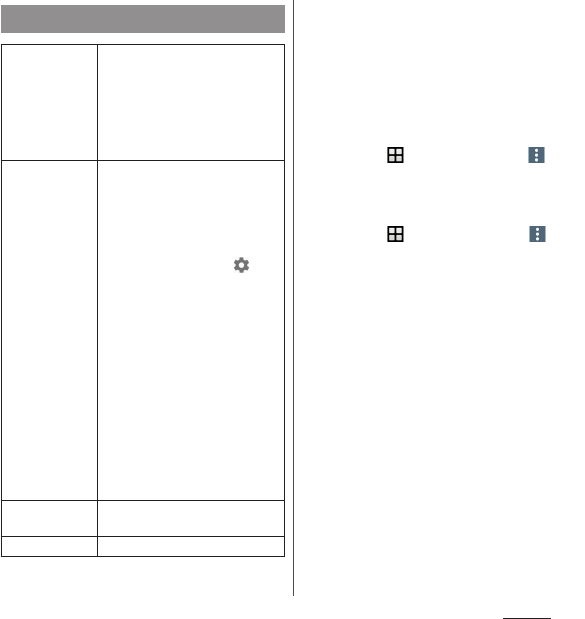
177
Settings
❖
Information
・
To reduce battery power for each application, disable
applications when the terminal is not used or the
applications are not used for several days (Battery
optimization).
To avoid the effect of the battery optimization against
the application, register the applications to "NOT
OPTIMIZED".
To change the battery optimization setting, from the
Home screen,
u
[Settings]
u
[Battery]
uu
[Battery optimization]
u
Tap "APPS"/"ALL OTHERS"
tab
u
Mark applications to set.
・
To manage the applications consuming the battery
to reduce the battery consumption, operate from the
Home screen,
u
[Settings]
u
[Battery]
uu
Tap
[App power consumption].
Battery
Battery level and
estimated
battery time
The battery level and remaining
standby time (estimate) are
displayed. Tap [SHOW BATTERY
USAGE] to check remaining battery
and applications/functions that
use the battery from the last full-
charging.
STAMINA mode
Restrict the operations and a part
of functions of the terminal to save
the battery power.
・
Select "Auto start at XX% battery"
to set to enable STAMINA mode
when the battery level becomes
to a specified level. Tap to
specify a battery level to enable
the function.
・
Tap [STAMINA level] to set
restriction level.
・
Turn on the "Smart STAMINA
notification" to notify you with
the notification when there is
not enough battery until the
next charging is predicted.
・
The remaining standby time is
displayed in "Battery level and
estimated battery time" linking
with the STAMINA mode
settings.
Emergency
mode
P. 4 8
Battery Care
P. 3 7
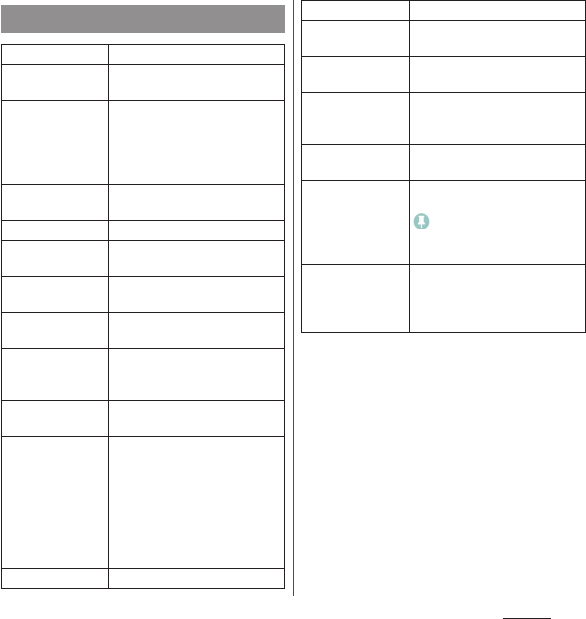
178
Settings
*1 Not displayed if a docomo nano UIM card is not
inserted.
*2 Save certificates and credential information in the
credential storage.
*3 VPN settings are also cleared.
Lock screen & security
Screen lock
P. 1 8 1
Fingerprint
Manager
P. 1 8 2
Smart Lock
Set to enable unlocking by the
On-body detection or registered
trusted places/devices/face/
voice when Screen lock is set to
"Pattern"/"PIN"/"Password".
Lock screen
message
Enter a message to be displayed
on the lock screen.
Clocks
Set a clock for the lock screen.
Configure
notifications
P. 1 7 1
Encrypt device
The internal storage is encrypted
by default.
Set up SIM card
lock
*1
P. 1 8 1
Make passwords
visible
Set whether to show the input
character before "
●
" appears on
the PIN/password entry screen.
Device
administrators
Set whether to enable device
administrating function.
Unknown sources
Set whether to permit installing
an application by unknown
source (provider) before
downloading.
To protect the terminal and
personal data, only download
applications from trusted
sources.
Storage type
Show type of credential storage.
Trusted credentials
Display trusted CA credentials.
User credentials
Manage the user credentials
saved in the terminal.
Install from device
memory/SD card
Install encrypted certificates.
Clear credentials
Clear all certificates or credential
information from the credential
storage.
*2* 3
Trust agents
Set whether to display trusted
agents.
Screen pinning
Set whether to enable screen
pinning. When this feature is on,
is displayed in a thumbnail of
the recently-used application
(P.70).
Apps with usage
access
Set whether to allow
applications which read usage
history to permit access to usage
history.

179
Settings
Security codes for the terminal
Some functions provided for convenient use
of the terminal require the security code to
use them. Besides the security code for
locking the terminal, the network security
code necessary for the network services etc.
are available. Make use of the terminal using
an appropriate security code according to
the purpose.
■
Notes on the security codes
・
Avoid using a number that is easy to
guess, such as "birth date", "part of your
phone number", "street address number
or room number", "1111", and "1234".
Make sure to make a note of the security
code you set lest you should forget it.
・
Be very careful not to let others know your
security code. If your security code is
known by anyone else, DOCOMO shall
have no liability for any loss due to any
unauthorized use of it.
・
If you forget your security codes, you must
bring your official identification (such as
driver's license), the terminal, and
docomo nano UIM card with you to the
nearest docomo Shop. For details, contact
the "General Inquiries" on the last page.
・
The PIN Unlock Key is written on the
subscription form (copy for customer)
handed at the subscription in the
docomo Shop. If you subscribed other
than docomo Shop, you must bring your
official identification (such as driver's
license), the docomo nano UIM card with
you to the nearest docomo Shop or
contact the "General Inquiries" on the last
page.
■
Network security code
The network security code is a 4-digit
number necessary for identification or using
the docomo network services at reception
of your request in docomo Shop, or at
docomo Information Center or "
お客様サ
ポート
(Customer support)". It can be set
any number at the subscription and also
changed later by yourself.
・
For details on network security code, refer
to NTT DOCOMO website.
https://www.nttdocomo.co.jp/english/
support/trouble/password/network/

180
Settings
■
PIN code
You can set up a security code called a PIN
code for your docomo nano UIM card. The
code is set to "0000" at the time of
subscription; however, you can change the
code by yourself.
PIN code is a 4- to 8-digit security number
(code) that must be entered for user
confirmation to prevent unauthorized use
of docomo nano UIM card by a third party
every time you insert the docomo nano UIM
card into the terminal or when the terminal
is powered on. Entering the PIN code
enables making/receiving calls and
terminal operation.
・
If you use a newly purchased terminal
with docomo nano UIM card you have
been using, use the PIN code set on the
former terminal. If you did not change the
setting, the code is "0000".
・
If you enter a wrong PIN code 3 times
consecutively, the PIN code is locked and
cannot be used anymore. In this case,
unlock with "PIN Unlock Key (PUK code)"
(P.180).
■
PIN Unlock Key (PUK code)
The PUK code is an 8-digit number for
canceling the locked PIN code. The PUK
code cannot be changed by yourself.
・
If you failed to enter PUK code 10 times
consecutively, the docomo nano UIM
card is locked. Please contact a docomo
Shop.
■
d ACCOUNT
d ACCOUNT is an ID/password to use
applications or services provided by
DOCOMO. With d ACCOUNT, you can use
various services more convenient
regardless of line type such as LTE, Wi-Fi,
etc., or device type such as smartphone,
tablet, PC.
・
For details on d ACCOUNT, from the
Home screen,
u
[Settings]
u
[docomo
service/cloud]
u
[d ACCOUNT setting]
u
u
[
ヘルプ
(Help)] to see the Help.
■
Google account
Google account is an ID/password to use
Google services. By setting Google account
to the terminal, you can use Gmail to send
Email, use Google Play to download
applications or contents such as games.
・
For setup of Google account, see "Setting
up a Google account" (P.187).
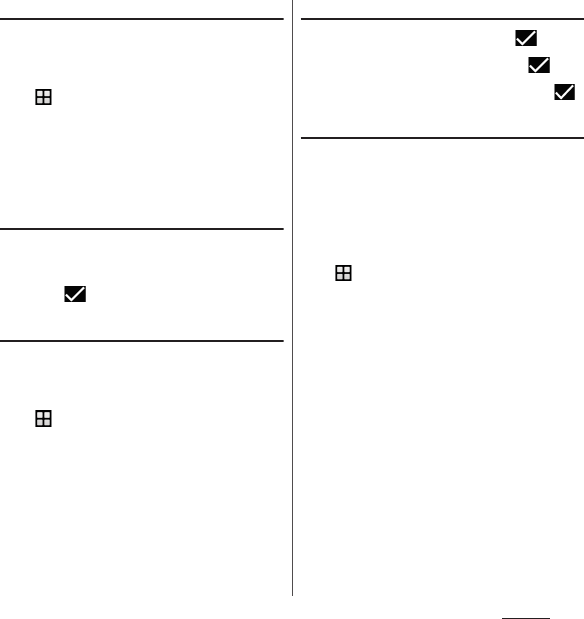
181
Settings
Enabling SIM card lock
By entering PIN code when powered on, you
can protect from improper use.
1
From the Home screen,
u
[Settings]
u
[Lock screen &
security]
u
[Set up SIM card lock]
u
[Lock SIM card].
2
Enter PIN code
u
[OK].
Entering the PIN code when powered
on
1
On the PIN code entry screen,
enter the PIN code.
2
Tap .
Changing the PIN code
・
You can change only when you activate the
SIM card lock.
1
From the Home screen,
u
[Settings]
u
[Lock screen &
security]
u
[Set up SIM card lock]
u
[Change SIM PIN].
2
Enter the current PIN code
u
[OK].
3
Enter a new PIN code
u
[OK].
4
Enter the new PIN code again
u
[OK].
Unlocking PIN lock
1
Enter the PUK code
u
Tap .
2
Enter a new PIN code
u
Tap .
3
Enter the PIN code again
u
Tap .
Setting screen unlock method
For reinforcing security, you can set the
terminal to require the entry of a pattern, PIN,
or password to cancel the screen lock every
time the terminal is turned on or woken from
sleep mode.
1
From the Home screen,
u
[Settings]
u
[Lock screen &
security]
u
[Screen lock].
2
Tap any of [Pattern]/[PIN]/
[Password].
3
Follow the onscreen instructions
to set.
・
Set whether to require entry of the
specified unlocking method every time
you turn on the power of the terminal.
・
When the setting is complete, "Lock
screen & security" menu screen
reappears.
・
If you select "PIN", enter 4- to 16-digit of
numeric characters. If you select
"Password", enter 4- to 16-digit
alphanumeric characters.
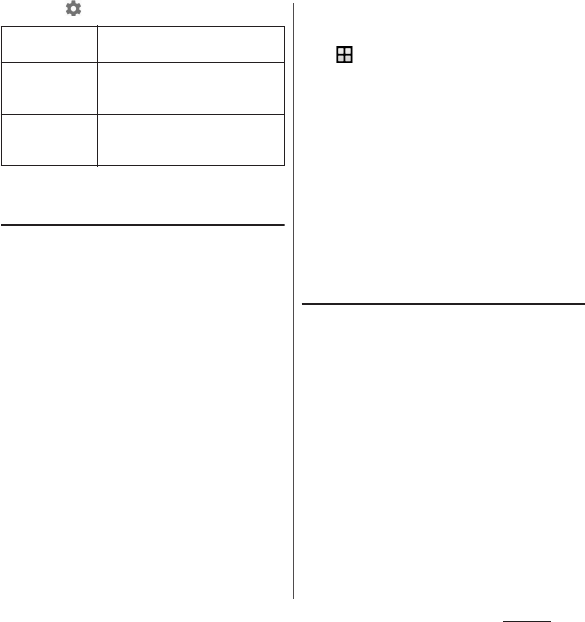
182
Settings
4
Tap of "Screen lock" as required.
* Appeared only when the "Pattern" is set.
Locking the screen
Once you specify the screen unlock method
(P.181), the screen is locked when you press
O
to put the terminal into sleep mode or
when the backlight turns off automatically.
■
To unlock the screen
1
When the screen is locked, press
O
to turn the backlight on
u
Swipe (or flick) up/left on the
screen
u
Enter the unlock PIN,
pattern, or password.
■
To turn off the screen lock
1
From the Home screen,
u
[Settings]
u
[Lock screen &
security]
u
[Screen lock]
u
Enter the
current unlock pattern, PIN, or
password
u
[None]
u
[YES,
REMOVE].
❖
Information
・
Entering incorrect pattern/PIN/password 5 times
consecutively disables canceling the screen lock.
Wait for approximately 30 seconds and then operate
the canceling of screen lock again.
・
If you forget unlocking pattern/PIN/Password,
contact a docomo Shop.
Setting up fingerprint authentication
Your terminal features a fingerprint sensor
(
O
). Once you register your fingerprint for
O
, you can touch the key with your finger
to unlock the screen (fingerprint
authentication).
■
Notes on using fingerprint
authentication
・
Your terminal recognizes a fingerprint
based on its unique characteristics. For
this reason, some users may not be able to
use fingerprint authentication if their
fingerprints are not sufficiently unique.
Make pattern
visible
*
Set whether to show pattern when
entering pattern.
Automatically
lock
Set the time from when the screen
backlight turns off to when the
screen automatically locks.
Power button
instantly locks
Set whether to instantly lock the
screen when the screen backlight
is turned off by pressing
O
.

183
Settings
・
Authentication performance—how
successfully your fingerprint can be
recognized when you touch the
fingerprint sensor (
O
) properly—
varies depending on the condition of your
fingers. Fingerprint registration may fail or
the authentication performance may
decrease if your fingers have any of the
conditions listed below. Note that you
may be able to improve the
authentication performance by wiping or
washing your hands, using a different
finger for authentication, or registering a
larger area of your fingerprint.
- Your fingers are: Wrinkled or wet (for
example, after you take a bath)
- Sweaty or greasy (with hand cream etc.)
- Dirty with mud, oil, or other
contamination
- Rough or injured (for example, cut or
inflamed)
- Extremely dry
- Different in size than before, so that the
fingerprint has changed
- Worn so much that the fingerprint is
unclear
- Totally different in texture than when
you registered your fingerprint
・
Fingerprint authentication technology
does not guarantee completely accurate
personal authentication or identification.
Please note that DOCOMO assumes no
responsibility for any damages resulting
from using the terminal by the third party,
or inability to use the terminal.
■
Precautions for using the fingerprint
sensor (
O
)
・
Do not hit the fingerprint sensor against
anything or subject it to any strong
impact. Also, do not scratch its surface or
poke it with a pointed object. Doing so
may damage the sensor or cause it to fail.
・
Do not put a sticker on the fingerprint
sensor or paint it with ink or something
similar.
・
A dirty sensor can make fingerprint
recognition difficult or reduce
authentication performance. Be sure to
clean the surface of the sensor as needed.

184
Settings
■
Registering your fingerprint
1
From the Home screen,
u
[Settings]
u
[Lock screen &
security]
u
[Fingerprint Manager].
・
If you have already registered
fingerprint, the entry screen for
unlocking the screen lock appears.
Enter the unlocking method to display
the fingerprint setting screen.
2
[NEXT].
・
After this step, follow the onscreen
instructions. When the registration is
complete, the screen that notifies the
fingerprint is added appears. Tap
[DONE] to end the registration or tap
[Add another] to register the other
fingerprint.
・
When the screen for setting the
unlocking method of the screen lock
appears, follow onscreen instructions to
set. Use the selected unlocking method
if fingerprint authentication does not
work.
・
When the entry screen for unlocking
the screen lock appears, enter the set
unlock method and then follow
onscreen instructions.
❖
Information
・
On the Fingerprint Manager screen, you can perform
the following actions:
- To rename a fingerprint, tap a registered
fingerprint
u
Enter a name
u
Tap [OK].
- To delete a fingerprint, tap a registered fingerprint
u
[DELETE]
u
[DELETE].
- To register the other fingerprint, tap [Add
fingerprint].
■
Using your fingerprint for
authentication
1
When the lock screen is displayed,
press
O
.
・
Touch
O
with your registered finger.
・
Swipe (or flick) up/left on the lock
screen to display a screen for entering
unlocking screen method you set.
❖
Information
・
If fingerprint authentication failed 5 times
consecutively, the fingerprint authentication is
disabled. Wait for a while and then perform
fingerprint authentication, or swipe (or flick) the
screen and then enter the unlocking screen method
that you set.
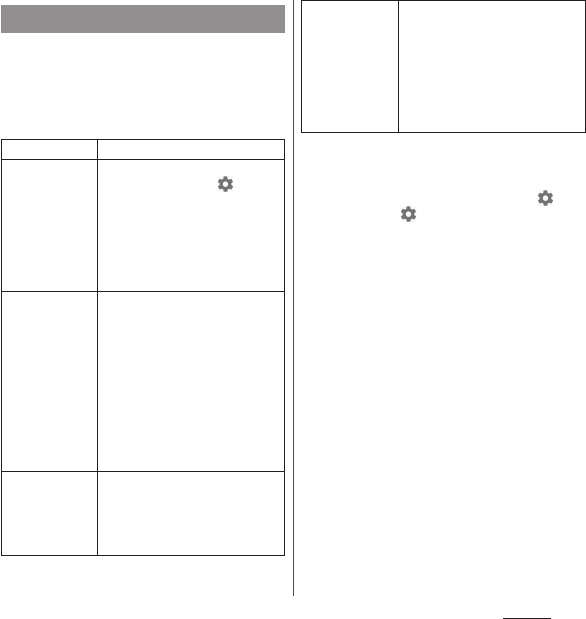
185
Settings
Add users to share the terminal with multiple
users (function that allows users and guests
to use the terminal).
To switch users or add a guest, operate from
the Quick settings panel (P.54).
❖
Information
・
You can add up to 5 users including an owner and
users.
・
When using the terminal by the owner, tap for
"(User Name)" or for "New user" to set whether to
permit use of phone and SMS, or remove the user.
・
When the owner is Users/Guest, displayed functions
are different, or use of applications or functions are
restricted.
Users
You (Owner)
Check or edit profile information.
Guest
Set whether to allow a guest to use
the phone by tapping while
the owner uses the terminal.
・
When a "guest" is using the
terminal, "Remove guest" is
displayed. You can tap it to
delete the applications and data
that the guest has used.
+ Add user
Select this to add users. You need
to configure initial settings for each
added user. Follow the onscreen
instructions.
・
When an added user is using the
terminal, "You (the name set for
the user's Google account)" is
displayed.
・
If you tap "NOT NOW" in the user
initial setting, "New user" is
added.
Add users
Set whether to add a guest or user
from the Quick settings panel (P.54)
when the unlocking method of the
screen lock is "Pattern"/"PIN"/
"Password".
Emergency
information
Register your blood type or the
other information that can be
useful for initial response in
emergency or the contacts for
emergency.
・
You can also register or check
the emergency information in
"Contacts" application.
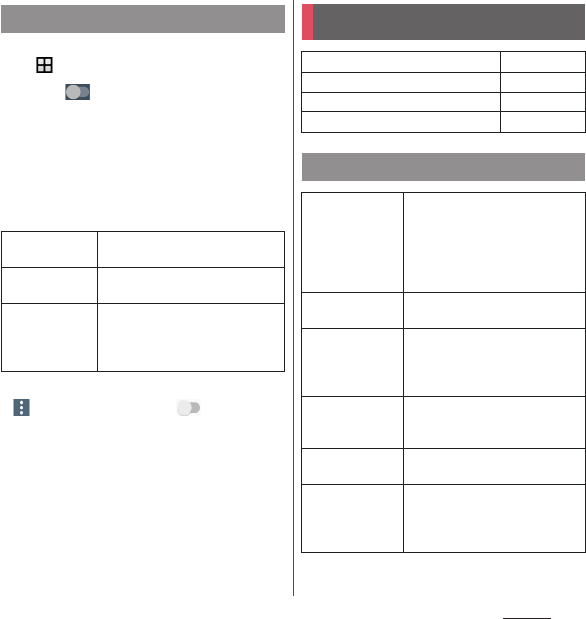
186
Settings
1
From the Home screen,
u
[Settings]
u
[Location].
2
Tap .
3
Read the notes on location
information and tap [AGREE].
・
When a screen for asking whether to
improve location information is
displayed, follow the onscreen
instructions to operate.
❖
Information
・
in Step 2
u
[Scanning]
u
Tap for "Wi-Fi
scanning"/"Bluetooth scanning" to allow the system
application or services to detect Wi-Fi network/
Bluetooth devices and then improve accuracy of
location information.
Location
Mode
Set a mode to identify location
information.
Recent location
requests
Display the application using the
recent location information data.
Location
services
Set or check Google Location
History.
・
You may need to set a Google
account.
Accounts & services
docomo service/cloud
P. 1 8 6
Accounts & sync
P. 1 8 7
Google
P. 1 8 8
Backup & reset
P. 1 8 9
docomo service/cloud
d ACCOUNT
setting
Set up your d ACCOUNT to use
docomo applications. You can
also use your biological
information (fingerprint)
registered on the terminal to set
up your d ACCOUNT.
docomo cloud
Make settings for docomo cloud
compatible service.
docomo apps
management
Manage to install applications
provided by DOCOMO and set to
check updates for applications
regularly.
Osusume hint
Set whether to display Osusume
hint, check hints displayed in the
past, etc.
AUTO-GPS
Set to use the services supporting
AUTO-GPS.
docomo location
information
Set location information function
for imadoco search, imadoco
kantan search and Keitai-Osagashi
Service.
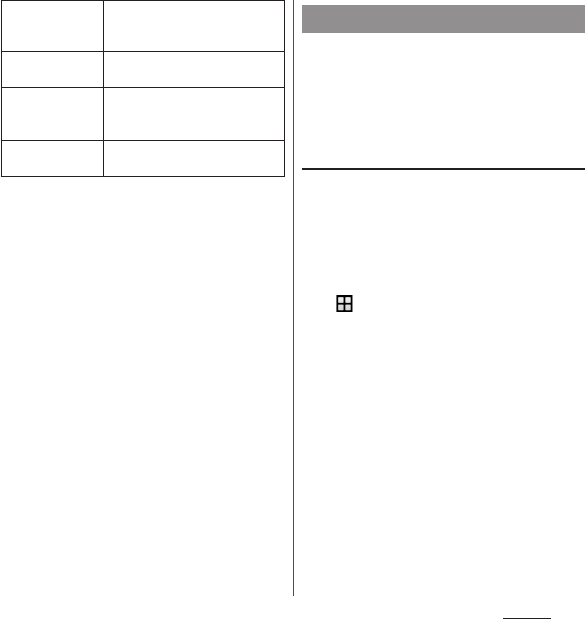
187
Settings
❖
Information
・
You can disable applications displayed in docomo
service/cloud. Disabled applications may not be
displayed in the list of docomo service. Also, if you
newly download an application provided by
DOCOMO, an item may be added in the list of
docomo service/cloud.
Manage (add or delete) online service
accounts or synchronize contacts, calendar,
etc. saved in online services with the
terminal.
・
Auto-sync data (P.188)
Setting up a Google account
You can set a Google account on your
terminal and use Google services such as
Gmail, Google Play, etc.
You can set multiple Google accounts on the
terminal.
1
From the Home screen,
u
[Settings]
u
[Account & sync]
u
[Add account]
u
[Google].
2
Follow the onscreen instructions
to set up a Google account.
❖
Information
・
If you turn on the item for backing up data to your
Google account on the "Google services" screen
when registering, the account is registered as a
backup account.
・
You can use the terminal without setting your
Google account, however the Google services such
as Gmail, Google Play, etc. are not available.
・
Tap a Google account to set ON/OFF of auto sync for
each item.
Profile setting
Check or change your profile
information used for docomo
services.
docomo service
initial settings
P. 4 3
Switch USB
debugging
Make the settings for using the
dedicated terminal at a docomo
Shop etc.
Open source
licenses
View open source licenses.
Account & sync
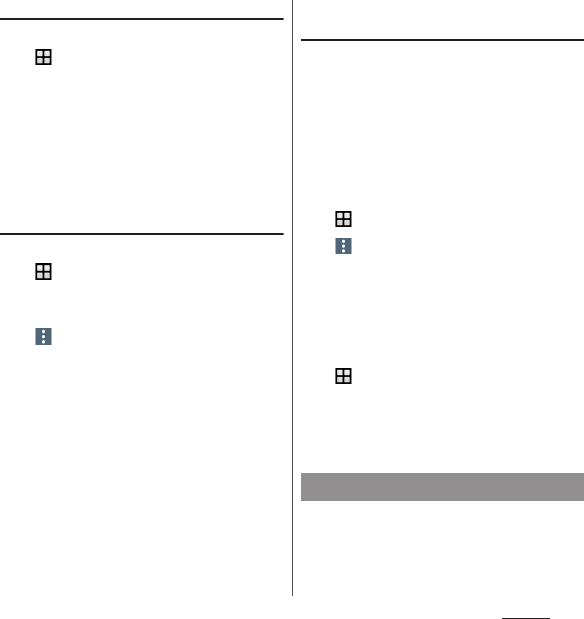
188
Settings
Setting other account
1
From the Home screen,
u
[Settings]
u
[Account & sync]
u
[Add account].
2
Tap an account type.
・
After this step, follow the onscreen
instructions.
❖
Information
・
docomo account is set by default.
Removing account
1
From the Home screen,
u
[Settings]
u
[Account & sync]
u
Select an account type
u
Select the
account as required.
2u
[Remove account]
u
[REMOVE
ACCOUNT].
❖
Information
・
You cannot remove the docomo account.
Configuring sync settings for your
accounts
■
To sync automatically
Synchronize information of online service
with the terminal. You can display and edit
information on the terminal or a PC.
・
Setting Auto-sync data, communication
occurs to synchronize and a packet
communication charge may be applied.
1
From the Home screen,
u
[Settings]
u
[Account & sync].
2u
[Auto-sync data]
u
[OK].
■
To sync manually
When the auto-sync function is off, you can
sync your registered account(s) manually.
1
From the Home screen,
u
[Settings]
u
[Account & sync].
2
Select the account type
u
Select an
account as required
u
Select items
to sync.
Check, change, or delete information or
settings related to your Google account and
the services.
Google
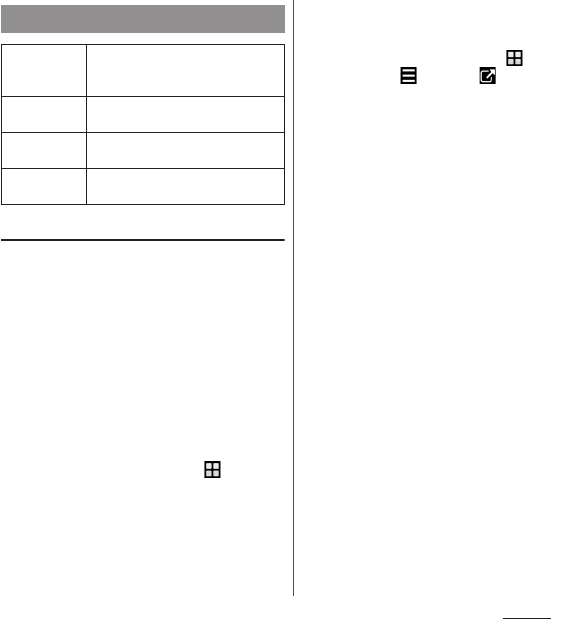
189
Settings
Resetting the terminal
Resetting the terminal deletes all data and
accounts, and resets the terminal back to the
initial (default) state.
・
The downloaded applications and data in the
internal storage (music, images, etc.) are
included to the data to be deleted.
・
Make sure to back up the important data you
have on the terminal before resetting.
・
Reset the terminal while charging the battery,
or when the battery is sufficiently charged.
・
Initial settings (P.43).
1
From the Home screen,
u
[Settings]
u
[Backup & reset]
u
[Factory data reset]
u
[RESET
PHONE].
2
[ERASE EVERYTHING].
❖
Information
・
Some pre-installed content can be re-downloaded,
even if it is deleted when you reset your terminal.
To download, from the Home screen,
u
[Xperia
™
Lounge Japan]
uu
[
サポート
(ブラウザで開き
ます)
(Support (Open the window by the browser))]
u
[
スマートフォン/タブレット関連(プリインストー
ルコンテンツなどの再ダウンロード)
(For smartphone/
tablet (For re-downloading preinstalled contents))]
u
[
ドコモ
(DOCOMO)] (in Japanese only) and then
select the terminal on the displayed screen.
Backup & reset
Back up my
data
Set whether to back up settings for
applications, data, etc. to Google
server.
Backup
account
Set an account for backup to Google
server.
Automatic
restore
Set to restore the backup settings or
data when re-installing application.
Factory data
reset
P. 1 8 9
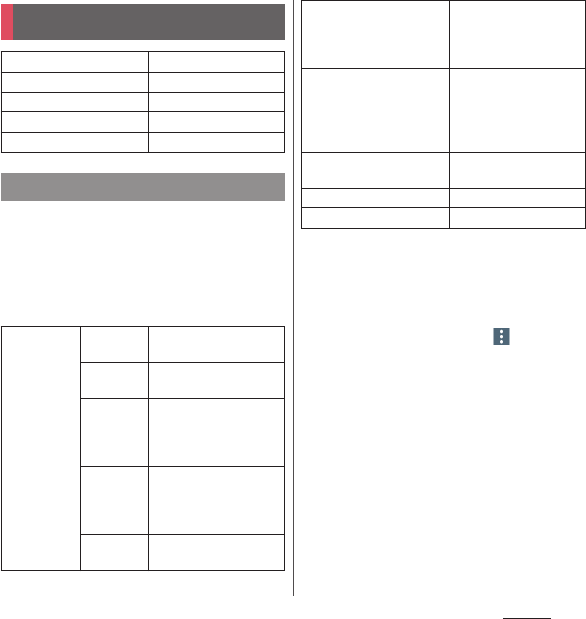
190
Settings
Check the introduction of the function of the
terminal, customize the terminal, set data
protection, etc. Also, you can make settings
for displaying the hints of the terminal, the
operations performed automatically by the
terminal and the battery or memory.
*1 If the screen for selecting the previous mobile
phone, select the type of the mobile phone. The
screen of the introduction of Xperia
™
appears and
you can select the item.
*2 The items vary depending on the selected previous
mobile phone. To change a mobile phone type, in
the Xperia
™
introduction screen,
u
Tap [Select
phone].
System
Assist
P. 1 9 0
Date & time
P. 1 9 1
Languages & input
P. 1 9 1
Accessibility
P. 1 9 3
About phone
P. 1 9 4
Assist
Introduction
to Xperia
™
*1
Essentials
*2
Check the latest
applications/functions.
Learn the
basics
*2
Check the basic function
of Android and Xperia
™
.
Make it
yours
Customize the theme or
wallpaper, lock screen
clock, ringtone,
notification sound.
Keep your
stuff secure
Set up fingerprint
function (P.182) or
Backup and restore
settings (P.189).
Xperia
™
services
Sign in for using Xperia
™
services.
Xperia
™
Tips
Set whether to notify you
of convenient functions
for the terminal with
notification.
Xperia
™
Actions
Set the operations that
the terminal can operate
automatically when you
are sleeping or want to
concentrate, or overseas.
STAMINA mode
Set STAMINA mode
(P.177).
Smart cleaner
Set Smart cleaner (P.175).
Battery Care
Set Battery Care (P.37).
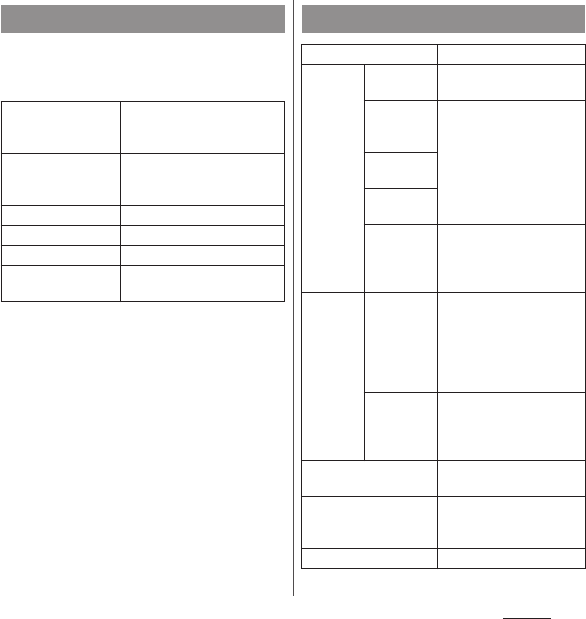
191
Settings
・
To set date/time or time zone manually, turn
off "Automatic date & time" or "Automatic
time zone" in advance.
❖
Information
・
Correction of the time differences may not be
performed correctly depending on the overseas
network operator. In that case, set time zone
manually.
Date & time
Automatic date &
time
Adjust date and time
automatically by using
network-provided information.
Automatic time zone
Adjust time zone
automatically by using
network-provided information.
Set date
Set date manually.
Set time
Set time manually.
Select time zone
Set time zone manually.
Use 24-hour format
Set whether to use 24-hours
format.
Languages & input
Languages
P. 1 9 2
On-screen
keyboard
SwiftKey
Keyboard
*1
Make settings of SwiftKey
Keyboard.
Xperia
™
Japanese
keyboard
P. 7 9
Google
voice typing
Moji-
Henshu
Manage
keyboard
Set the software keyboards
to display on the screen for
changing the software
keyboard (P.73).
Physical
keyboard
Show on-
screen
keyboard
Set whether to display the
software keyboard on the
terminal screen when
entering characters with a
peripheral keyboard
connected to the terminal.
Keyboard
shortcuts
helper
Display the available
shortcuts that can be used
on the peripheral keyboard
connected to the terminal.
Spell checker
*2
Set whether to run the
spell checker.
Personal dictionary
Add words used in the spell
checker and other
applications.
Text-to-speech output
P. 1 9 2
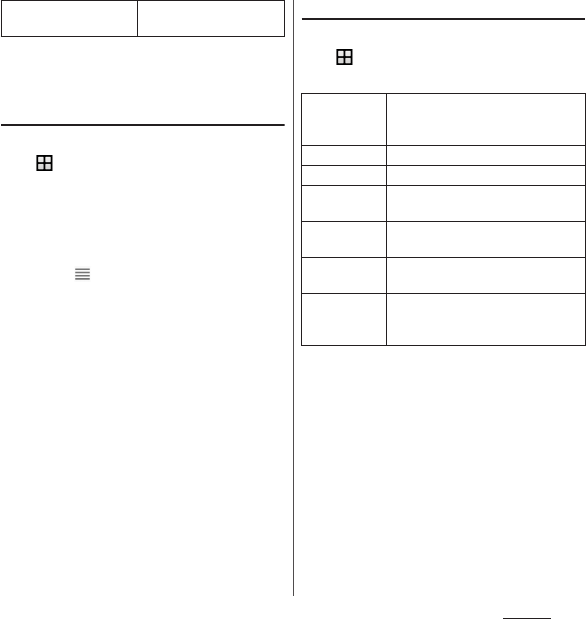
192
Settings
*1 Displayed when the language is set to English.
*2 Downloading a spell checker application is
required.
Changing the phone language
1
From the Home screen,
u
[Settings]
u
[Languages &
input]
u
[Languages].
2
[Add a language]
u
Select the
language
u
Select the country or
region as required.
3
Drag of the language to the top
layer ("1" position).
❖
Information
・
If you choose the wrong language and cannot read
the menu texts, see the FAQ of the following website.
http://www.sonymobile.co.jp/support/ (In Japanese
only)
Setting Text-to-speech output
1
From the Home screen,
u
[Settings]
u
[Languages &
input]
u
[Text-to-speech output].
Pointer speed
Set pointer speed when a
mouse or trackpad is used.
Google Text-
to-speech
Engine
Set the language or the Google Text-
to-speech engine, or install the voice
data.
Speech rate
Set speed at reading out text.
Pitch
Set the pitch of voice to read out text.
Reset speech
rate
Reset the setting of "Speech rate" to
the normal speed.
Reset speech
pitch
Reset the setting of "Pitch" to the
default pitch.
Listen to an
example
Playback sample of audio synthesis.
Default
language
status
Display the supporting status of the
language set for text-to-speech.
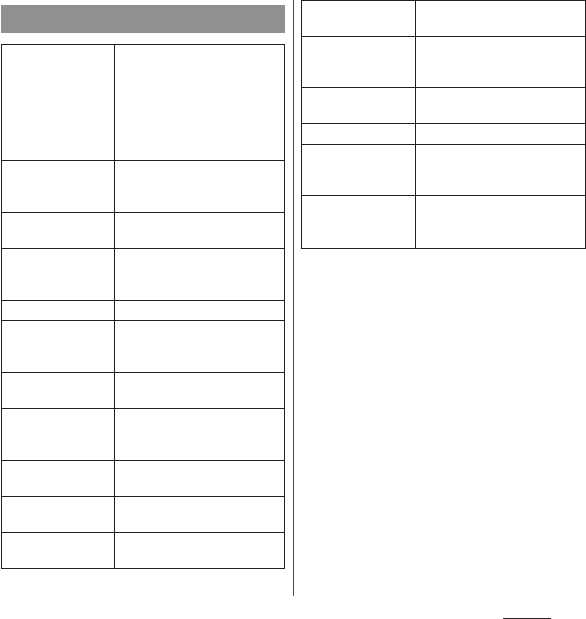
193
Settings
*1 It may not work correctly.
*2 If the terminal goes into sleep mode during a call
with "Power button ends call" turned on, you can
end the call by pressing
O
or the volume key to
wake the terminal and then pressing
O
again.
Accessibility
Osusume hint
Set whether to use Osusume
hint function that introduces
how to use the terminal
according to your operations or
usage conditions.
・
Use setting is required in
advance (P.186).
Captions
Set whether to display the
captions or set the language,
font size for captions.
Mono audio
Set whether to play sound with
monaural.
Magnification
gesture
Set whether to enable zooming
in/out by tapping the screen 3
times.
Font size
Set font size.
Display size
Enlarge/reduce of the size of
the icon etc. displayed in the
screen.
Large mouse
pointer
Set whether to enlarge the
pointer when using the mouse.
High contrast text
*1
Set whether to show font with
high contrast color against the
background color.
Color inversion
*1
Set whether to invert color of
screen.
Color correction
*1
Correct color when
distinguishing colors is difficult.
Speak passwords
Set whether to read out
passwords.
Text-to-speech
output
P. 1 9 2
Click after mouse
pointer stops
moving
Set whether to click when the
mouse pointer stops while
using a mouse.
Power button ends
call
*2
Set whether to end calls by
pressing
O
.
Auto-rotate screen
P. 4 6
Accessibility
shortcut
Set whether to enable
activation of accessibility
function using shortcuts.
Touch & hold delay
Set response time for operation
of touching and holding the
screen.
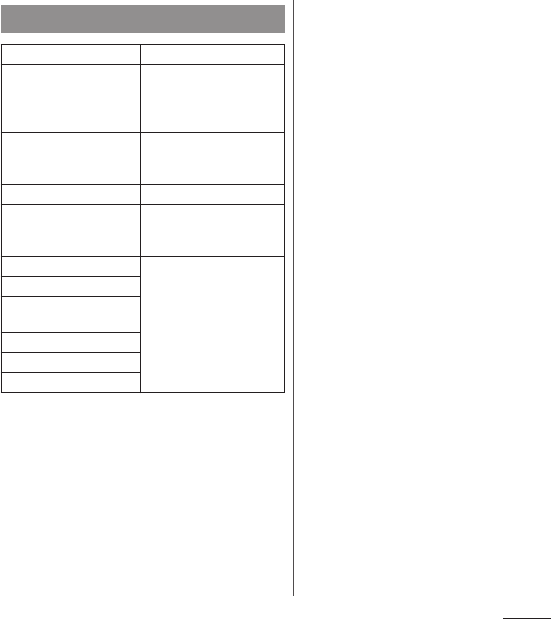
194
Settings
About phone
Software Update
P. 2 2 6
Status
Check own phone
number, battery status,
remaining battery, battery
performance, etc.
Legal information
Check open source license
or Google terms of use,
etc.
Certificates
P. 2 3 4
Usage info settings
Set whether to send usage
information for the
terminal.
Model
Check versions, numbers,
etc.
Android
™
version
Android security patch
level
Baseband version
Kernel version
Build number
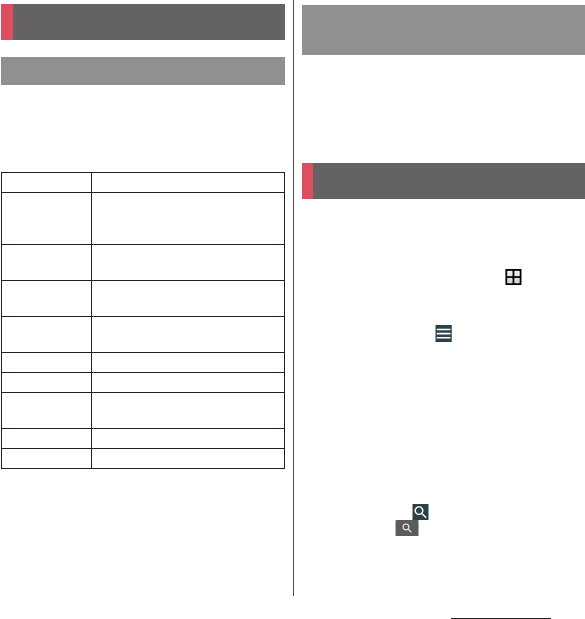
195
File management
File management
Folders in the internal storage (/storage/
emulated/0) by default are as follows.
・
Displayed folders may differ depending on
the terminal operations.
You can save data in the terminal to a
microSD card or import data from the
microSD card to the terminal.
・
For installing/removing a microSD card (P.34)
Use "File manager" application to operate
various data saved in the internal storage or
the microSD card.
1
From the Home screen,
u
[File
manager].
・
The internal storage of the terminal is
displayed. Tap to display the menu.
・
When a microSD card is installed, "SD
Card" appears in the menu.
2
Tap the folder as required.
3
Tap a file.
・
Data can be displayed with the
compatible application.
❖
Information
・
To search data, tap in Step 2 and enter a file
name, then tap of the software keyboard.
Storage structure
Phone (Internal storage)
Alarms
Stores alarm sounds etc.
Android
Stores setting data for system or
each application, temporary files,
etc.
DCIM
Stores still pictures/videos shot by
Camera.
Download
Stores downloaded data through
the web browser.
Movies
Stores videos (except shots by
Camera).
Music
Stores music data.
Notifications
Stores notification sounds etc.
Pictures
Stores still pictures (except shots by
Camera).
Podcasts
Stores Podcast files etc.
Ringtones
Stores ringtones etc.
microSD card (External
storage)
File operations
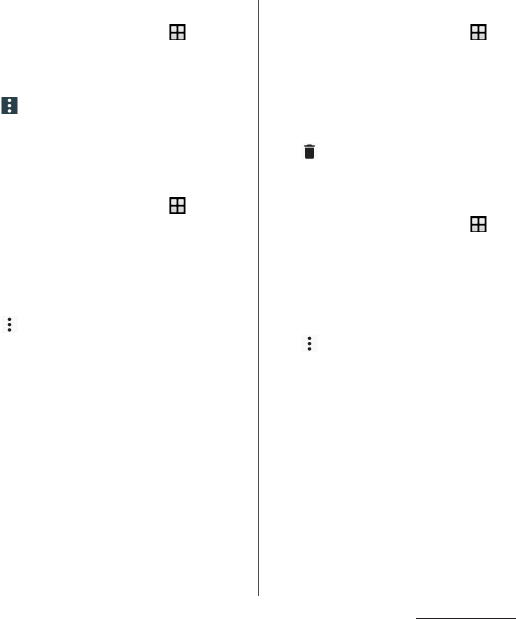
196
File management
■
Creating a folder
1
From the Home screen,
u
[File
manager].
2
Tap the folder as required.
3u
[New folder].
4
Enter a folder name
u
[OK].
■
Renaming folder or file
1
From the Home screen,
u
[File
manager].
2
Tap the folder as required.
3
Touch and hold a folder or file you
want to rename.
4u
[Rename]
u
Enter a name
u
[OK].
■
Deleting a folder or file
1
From the Home screen,
u
[File
manager].
2
Tap the folder as required.
3
Touch and hold a folder or file you
want to delete.
4u
[OK].
■
Copying/Moving a folder or file
1
From the Home screen,
u
[File
manager].
2
Tap the folder as required.
3
Touch and hold a folder or file you
want to copy/move.
4u
[Copy to...]/[Move to...].
5
In the desired location, [COPY]/
[MOVE].
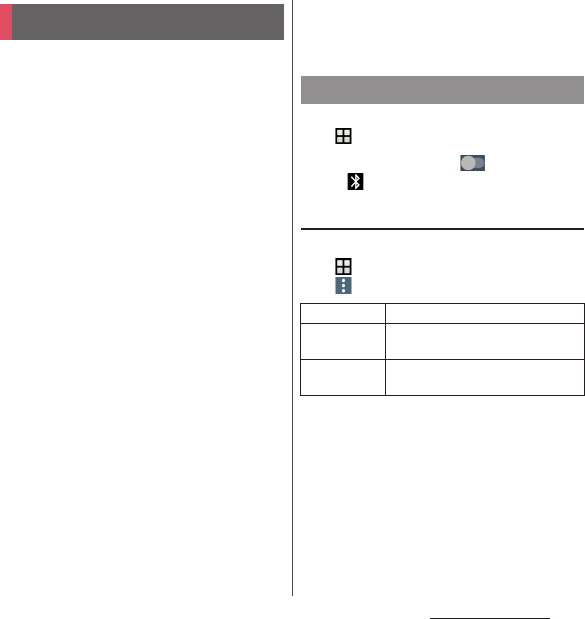
197
Data communication
Data communication
Bluetooth function is a technology which
enables to connect with Bluetooth device
such as PC, handsfree headset wirelessly.
・
The terminal does not communicate
wirelessly with all types of Bluetooth devices.
・
Supported Bluetooth profiles (P.230)
❖
Information
・
If you turn off the terminal with Bluetooth turned on,
Bluetooth function turns off. When you turn on the
terminal again, Bluetooth function turns on
automatically.
・
When you do not use Bluetooth function, turn it off
to save the battery.
■
Reception interference caused by
wireless LAN devices
The terminal's Bluetooth function and
wireless LAN devices use the same
frequency band (2.4GHz). If you use the
terminal near a wireless LAN device,
reception interference may occur or the
communications speed may lower. Also,
you may hear noise or have a connection
problem. In these cases, do the following:
・
Keep the Bluetooth device approximately
10 m or more away from a wireless LAN
device.
・
Within approximately 10 m, turn off either
the Bluetooth device or the wireless LAN
device.
1
From the Home screen,
u
[Settings].
2
[Bluetooth]
u
Tap .
・
appears on the status bar.
Using optional menu
1
From the Home screen,
u
[Settings]
u
[Bluetooth]
u
Tap
.
Bluetooth function
Making the terminal detectable
Refresh
Search available devices again.
Rename this
device
Rename the terminal which appears
on other Bluetooth devices.
Show received
files
Display transfer history with other
Bluetooth devices.
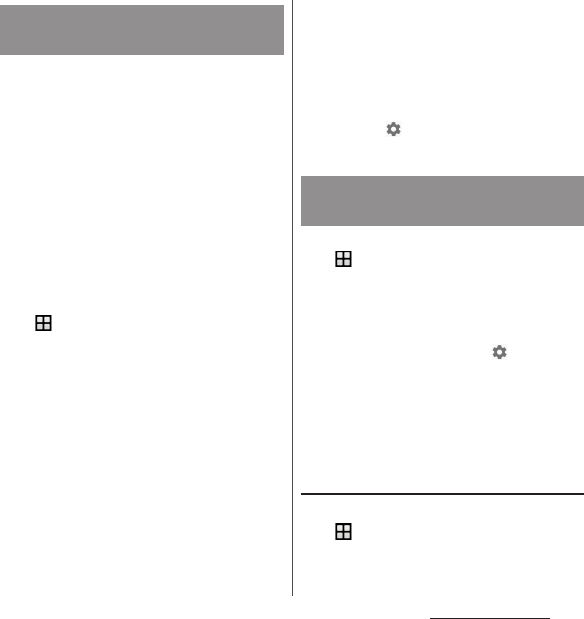
198
Data communication
To connect the terminal and Bluetooth
device, pair them first.
・
Once paired, the setting with the Bluetooth
device is saved.
・
For make pair setting, entering passcode (PIN)
may be required. Passcode (PIN) of the
terminal is "0000". If you cannot make pair
setting when you enter "0000", see the
documentation of your Bluetooth device.
・
Make sure that the Bluetooth function and
Bluetooth detection function of the target
device are on in advance.
1
From the Home screen,
u
[Settings]
u
[Bluetooth].
・
Detected Bluetooth devices are
displayed in "Available devices".
2
Tap a name of Bluetooth device for
pairing.
3
Confirm the Bluetooth pairing
code (pass code) on the
confirmation screen
u
[PAIR].
・
Paired Bluetooth devices are displayed
in "Paired devices".
■
When pairing request is sent from a
Bluetooth device
Confirm the Bluetooth pairing code (pass
code) on the confirmation screen and then
tap [PAIR].
❖
Information
・
To unpair, tap for the Bluetooth device to be
unpaired
u
[FORGET].
1
From the Home screen,
u
[Settings]
u
[Bluetooth].
2
Tap a name of Bluetooth device to
connect.
❖
Information
・
To rename a Bluetooth device, tap for Bluetooth
device you want to change the name
u
Enter a name
u
Tap [OK ].
・
Up to 7 devices can be connected at the same time.
Depending on profile, operation may not be correct
or number of devices that can be connected at the
same time may be different.
Disconnecting a Bluetooth device
1
From the Home screen,
u
[Settings]
u
[Bluetooth].
2
Tap a name of connected
Bluetooth device.
Making pair setting for the
terminal and Bluetooth device
Connecting the terminal with a
Bluetooth device
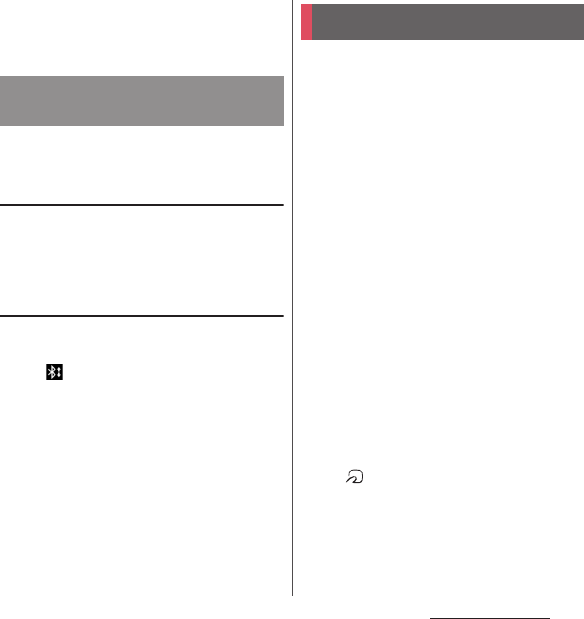
199
Data communication
3
[OK].
・
To reconnect, tap the Bluetooth device
name.
Turn on Bluetooth function in advance, then
pair with a target Bluetooth device.
Sending data via Bluetooth function
1
[Bluetooth] from the sharing menu
of each application.
2
Tap the other Bluetooth device.
Receiving data
1
Send data from the other
Bluetooth device.
・
appears on the status bar.
2
Drag the status bar downwards
u
[Incoming file]
u
[ACCEPT].
You can send/receive data to/from a device
with NFC such as a mobile phone.
・
To send/receive data, enable NFC Reader/
Writer, P2P function in advance (P.200).
・
Hold 2 terminals in parallel and place NFC /
Osaifu-Keitai position for holding over face to
face. Do not move them until sending/
receiving is complete.
・
NFC / Osaifu-Keitai position for holding over
differs depending on mobile phone.
Check NFC / Osaifu-Keitai position for holding
over ( mark) on each mobile phone.
・
Operations to send/receive and available data
to send/receive depend on the compatible
applications. Follow the onscreen
instructions.
Sending/Receiving data via
Bluetooth function
NFC communication
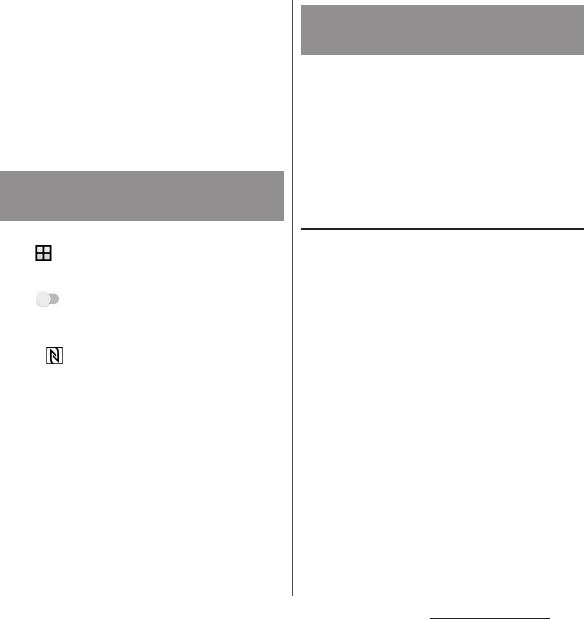
200
Data communication
・
Even if NFC / Osaifu-Keitai position for holding
over is placed face to face, sending/receiving
may fail. In such case, operate again to send/
receive.
・
The terminal does not communicate with all
NFC devices.
・
For notes when holding over the other device
(P.123).
1
From the Home screen,
u
[Settings]
u
[More].
2
[NFC / Osaifu-Keitai settings]
u
Tap
of "Reader/Writer, P2P"
u
[OK].
・
"Reader/Writer, P2P" and "Android
Beam" are turned on.
・
appears on the status bar.
❖
Information
・
While "NFC / Osaifu-Keitai lock" is set, the NFC
Reader/Writer, P2P function cannot be turned on.
By using the Android Beam with a NFC
compatible Android device, you can send or
receive images, music, photos or videos
taken with the terminal with simple
operations.
・
Turn on Reader/Writer, P2P function in
advance (P.200).
Sending data
1
Display data to send on the screen.
2
Place the NFC / Osaifu-Keitai
positions for holding over face to
face with a mobile phone for
receiving (P.123).
・
"Tap your screen to beam" appears.
3
Tap the shrunk screen.
Enabling NFC Reader/Writer,
P2P function
Sending/Receiving data by
one-touch function
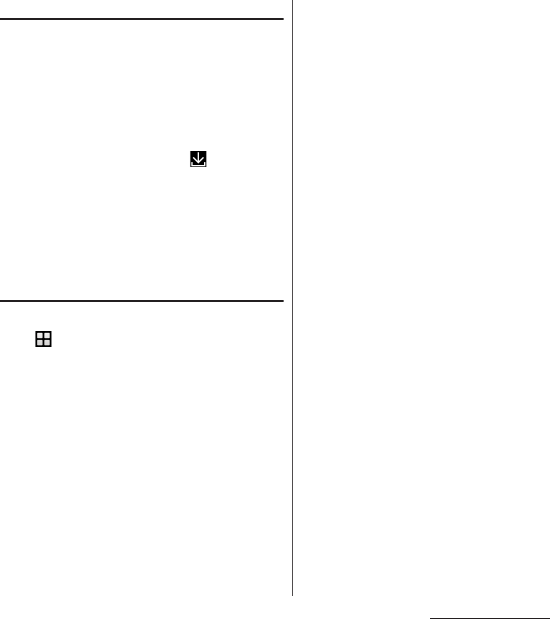
201
Data communication
Receiving data
1
Perform data sending operation
on a sender's terminal.
2
Place the NFC / Osaifu-Keitai
positions for holding over face to
face with a mobile phone for
sending (P.123).
・
When you receive data, appears on
the status bar. Drag the status bar
downwards
u
Tap [Beam complete] to
launch the application associated with
the received data. Follow the onscreen
instructions.
Selecting NFC Type
1
From the Home screen,
u
[Settings]
u
[More].
2
[NFC / Osaifu-Keitai settings]
u
[NFC Type].
3
Tap any of [FeliCa / Type A / Type B
(standard)]/[FeliCa / Type A]/
[FeliCa / Type B].

202
External device connection
External device connection
Connect to a PC to exchange data between
the internal storage or the microSD card and
a PC.
❖
Information
・
Appeared screen may vary depending on the
operating system (OS) of a PC.
・
You may not be able to operate copyrighted data of
images, music, etc.
・
The following operating systems (OS) are
supported.
- Microsoft Windows 10
- Microsoft Windows 8.1
- Microsoft Windows 7
・
To operate on Mac, downloading "Xperia
Companion" is required.
For details on compatible models or
recommended system, see the following
website.
http://www.sonymobile.co.jp/support/
software/xperia-companion/ (in Japanese
only)
1
Connect the terminal to a PC with
USB cable A to C 01 (optional) etc.
(P.41).
・
When a screen for installing driver
software appears, wait for a while until
the installation is complete.
・
When "Install software" screen appears
on the terminal, tap [SKIP] or [CANCEL].
・
The "Use USB to" screen appears on the
terminal.
❖
Information
・
To change the USB connection mode, drag the status
bar downwards
u
Tap the notification of USB
connection mode and then select a USB connection
mode.
Connecting to PC
Connecting to PC with USB
cable A to C
Charge this device
Only charging is performed.
Supply power
Charge a connected device.
・
It is required that the
connected device is
compatible with the function.
Transfer files
The terminal is displayed on the
PC screen as a portable device
and you can access the internal
storage and a microSD card in
the terminal.
Use device as MIDI
Use the terminal for MIDI input.
USB tethering
P. 1 6 4
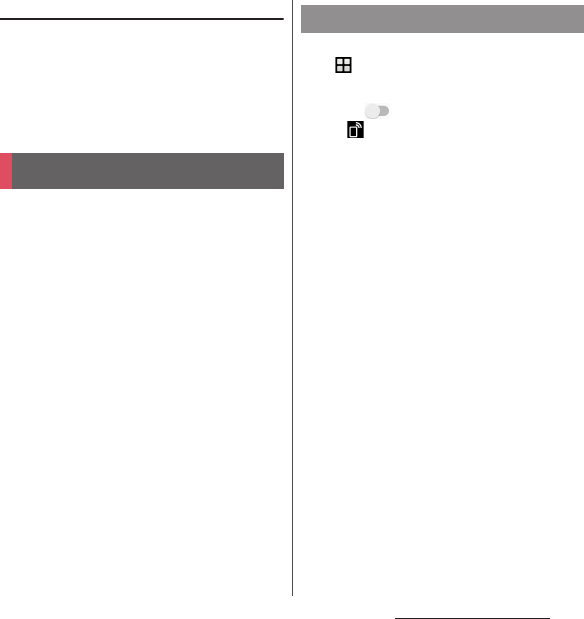
203
External device connection
Removing USB cable A to C safely
・
Do not remove the USB cable A to C during
while transferring data. Data may be
damaged.
1
Confirm that it is not transferring
data, remove the USB cable A to C.
Using Wi-Fi function, you can share media
files with other client (DLNA : Digital Living
Network Alliance) devices.
・
Connect the terminal to the Wi-Fi network
same with a DLNA device connected to in
advance (P.159).
1
From the Home screen,
u
[Settings]
u
[Device
connection]
u
[Media server].
2
Tap of "Share media".
・
appears on the status bar.
・
Tap [Change server name] to rename
the terminal (media server) displayed
on a DLNA device.
3
Connect the DLNA device to the
terminal using an application on
the DLNA device.
・
Access request for media server is
notified to the terminal.
4
On the Media server settings
screen of the terminal, tap the
pending DLNA device
u
Set the
access level.
・
The DLNA device is registered.
・
If you tapped [Allow this time], read the
message that appears
u
Tap [OK].
5
Select a media file on your
terminal using the DLNA device to
play it back.
Connecting DLNA device
Setting Media server
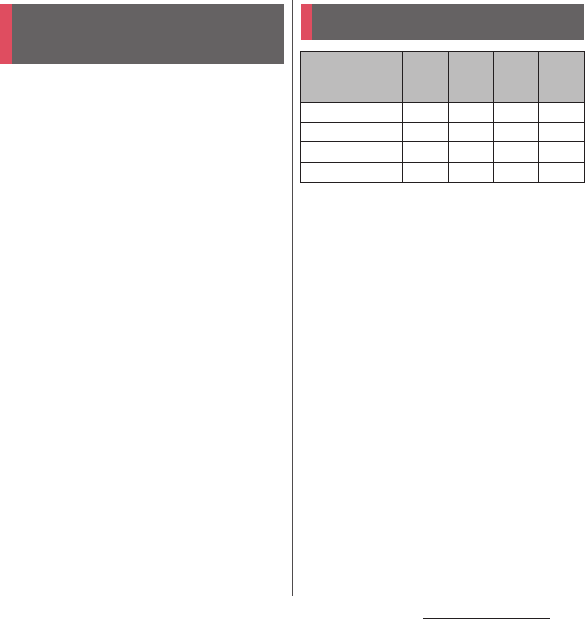
204
International roaming
International roaming
With the international roaming (WORLD
WING), you can use the terminal without
changing phone number or mail address in
the service area of the overseas network
operator affiliated with DOCOMO. You do not
need to change the settings of call and SMS.
For details of International Roaming Service
(WORLD WING), refer to NTT DOCOMO
website.
https://www.nttdocomo.co.jp/english/
service/world/roaming/
■
Supporting networks
You can use the terminal in the service area
for the LTE network, 3G network and GSM/
GPRS networks. Services are also available in
countries and areas supporting 3G
850MHz/GSM 850MHz.
❖
Information
・
For Country codes, International call access numbers,
Universal number international prefix, supported
countries/areas and network operators, refer to NTT
DOCOMO website.
* To use data communication during roaming, setting
"Data roaming" to ON in Mobile networks is required
(P.206).
❖
Information
・
Some services are not available depending on the
overseas network operator or network.
・
You can confirm the name of the connected network
operator on the Quick settings panel (P.54).
Overview of International
roaming (WORLD WING)
Available overseas service
Main
communication
services
LTE 3G 3G 850 GSM
(GPRS)
Phone
○○○○
Message (SMS)
○○○○
Mail
*
○○○○
Browser
*
○○○○

205
International roaming
To use the terminal overseas, check the
following in Japan.
■
Subscription
・
Check if you subscribe WORLD WING. For
details, contact "General Inquiries" on the
last page.
■
Charging
・
For charging, refer to NTT DOCOMO
website.
■
Usage charge
・
Overseas usage charges (call and packet
communication) differ from those in
Japan. For details, refer to NTT DOCOMO
website.
・
Some applications perform
communication automatically. Packet
communication charge may be higher.
For operations for each application, ask
the application provider.
Network service settings
If you subscribe to network services, you can
use network services such as Voice Mail
Service, Call Forwarding Service, Caller ID
Display Request Service, etc., even overseas.
However, some network services cannot be
used.
・
To use network services overseas, you need to
set "Remote operation settings" to "Activate
Remote operation" (P.98). You can set Remote
operation settings in the country you stay
(P.211).
・
Even if the setting/canceling operation is
available, some network services cannot be
used depending on overseas network
operators.
Before using overseas
Before leaving Japan
Advance preparation
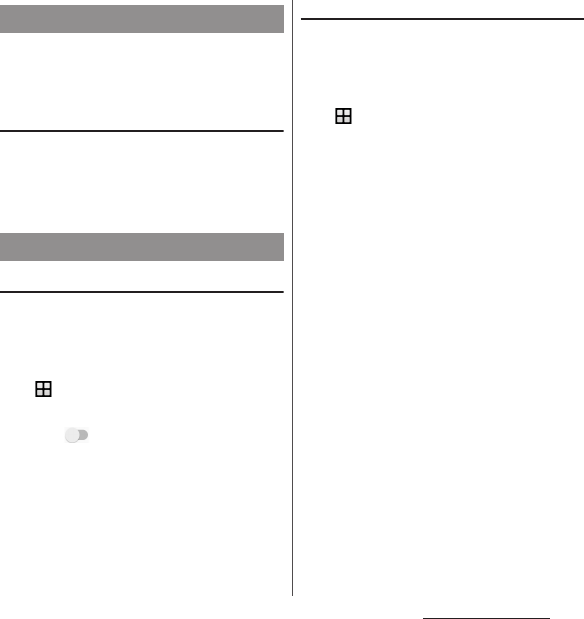
206
International roaming
When you arrive overseas and turn on the
terminal, an available network is
automatically set.
Connectivity
When you have set "Search mode" of "Service
providers" (P.206) in Mobile networks to
"Automatic", optimized network is
automatically selected.
Setting data roaming
To perform packet communication overseas,
setting "Data roaming" to ON in Mobile
networks is required.
1
From the Home screen,
u
[Settings]
u
[More]
u
[Mobile
networks].
2
Tap of "Data roaming"
u
Read
the notes and tap [OK].
Setting a network operator
By default, the terminal automatically
searches available network and connect to it.
To switch network manually, set as follows.
1
From the Home screen,
u
[Settings]
u
[More]
u
[Mobile
networks]
u
[Service providers].
・
If the note appears, tap [OK].
・
Perform network search.
2
[Search mode]
u
[Manual].
・
To display available networks, tap
[Search networks].
3
Tap a network to use from
"AVAILABLE NETWORKS".
❖
Information
・
If you set a network manually, the terminal is not
reconnected to another network automatically even
if you move out of the network area.
・
To return to "Automatic", tap [Search mode] in Step 2
u
[Automatic]
u
Tap [OK] if the Note appears.
After arriving overseas
Settings for overseas use
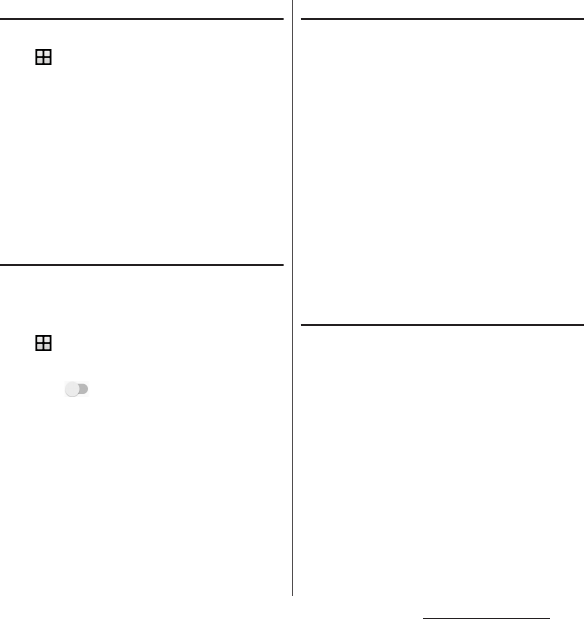
207
International roaming
Setting the preferred network type
1
From the Settings screen,
u
[Settings]
u
[More]
u
[Mobile
networks]
u
[Preferred network
type].
2
Tap any of [4G (preferred)/3G/
GSM]/[4G/3G]/[3G/GSM]/[GSM
only].
・
Select "4G (preferred)/3G/GSM" to
switch available network automatically.
Using VoLTE during international
roaming
Set to enable VoLTE when VoLTE is available
during international roaming.
1
From the Home screen,
u
[Settings]
u
[More]
u
[Mobile
networks].
2
Tap of "Enable VoLTE".
Date & time settings
When "Automatic date & time", "Automatic
time zone" in "Date & time" are ON, the date,
time and time differences of the terminal
clock are corrected by receiving the
information related to time and time
differences from the network of overseas
network operator you connect to.
・
Correction of the time/time differences may
not be performed correctly depending on the
network of overseas network operator. In that
case, set time zone manually.
・
Timing of correction varies by the overseas
network operator.
・
Setting Date & time (P.191)
About inquiries
・
For loss or theft of the terminal or docomo
nano UIM card, immediately contact
DOCOMO from the spot to take the necessary
steps for suspending the use. For inquiries,
refer to the last page. You can also suspend
the use from My docomo. Note that you are
still liable for the call and communication
charge incurred after the loss or theft
occurred.
・
For using from land-line phone, entering
"International call access number" or
"Universal number international prefix" for the
country is needed.
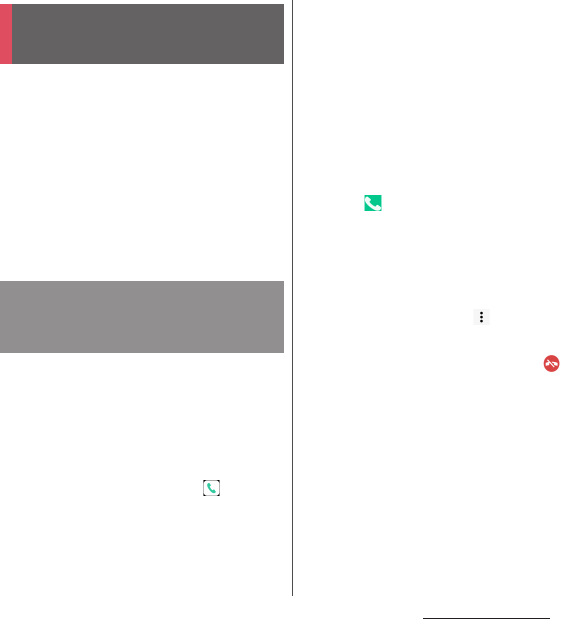
208
International roaming
When you arrive overseas and turn on the
terminal, an available network is
automatically set.
・
Check that the battery and signal levels are
high enough.
・
Depending on the network operator, even if
the Caller ID notification is active, the caller ID
may not be notified or appear properly.
In this case, calls cannot be made from the call
log.
You can make a call from overseas using the
international roaming service.
・
You can easily make international calls from
the country you stay to Japan or to other
countries by entering prefix "+" and then the
country code and phone number.
1
From the Home screen,
u
"Dial"
tab.
2
Dial + (touch and hold [0])
u
Enter
Country code, Area code (City
code), a phone number in the
order.
・
If the area code (city code) begins with
"0", omit "0". However, "0" may be
required to dial to some country or area
such as Italy.
・
To call an overseas "WORLD WING" user,
enter "81" (Japan) for the country code.
3
Tap .
・
When "Auto conversion" (P.211) in
International dial assist is turned on,
"International dial assist" screen appears
when sending. To make a call to Japan,
tap [CALL].
・
To make a video call,
u
Tap [ Video
call].
4
When the call is finished, tap .
❖
Information
・
For details on the Video call, see "Making/Receiving a
call" (P.88).
Making/Receiving a call in
the country you stay
Making a call to outside
country you stay (including
Japan)
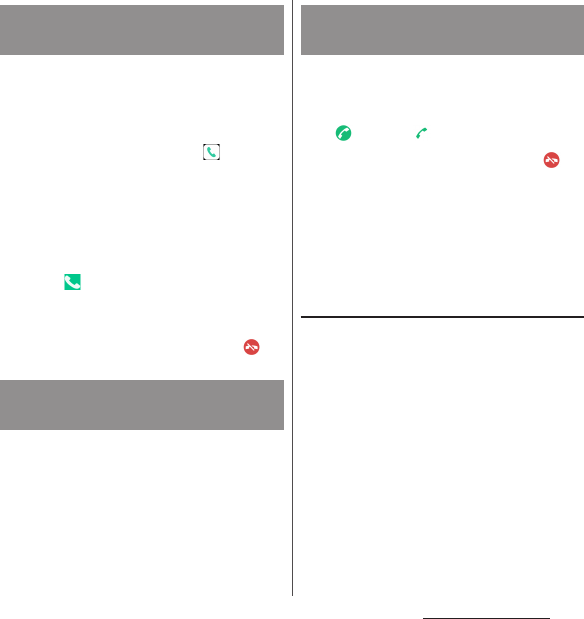
209
International roaming
You can make a call by entering the phone
number of the other party's land-line phone
or mobile phone in the same way you do in
Japan.
1
From the Home screen,
u
"Dial"
tab.
2
Enter a phone number.
・
To make a call to land-line phone, enter
the area code (city code), other party's
phone number in order.
3
Tap .
・
When "International dial assist" screen is
displayed, tap [CALL ORIGINAL].
4
When the call is finished, tap .
When the other party uses international
roaming service, make a call as an
international call to Japan even when you
stay in the same country as the other party.
You can receive a call using the international
roaming service.
1
On the incoming call screen, drag
(left) to (right).
2
When the call is finished, tap .
❖
Information
・
When you received a call during the international
roaming, regardless of which country the call is from,
it is forwarded internationally from Japan. A caller is
charged for a call fee to Japan, and the receiver is
charged for a reception fee.
Making a call from the other party
■
Having someone make a call from
Japan to the country you stay
To have the other party make a call from a
land-line phone or mobile phone in Japan
to the terminal in the country you stay, the
other party only needs to dial the phone
number as in Japan.
Making a call within the
country you stay
Making a call to WORLD WING
user overseas
Receiving a call in the country
you stay
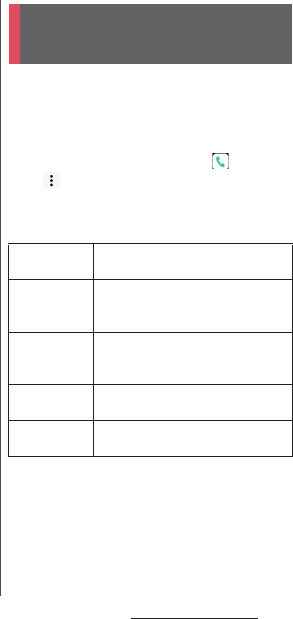
210
International roaming
■
Having someone make a call from
other than Japan to the country you
stay
You have to receive a call through Japan no
matter where you are; therefore, the other
party needs to enter the international call
access number and "81" (Country code of
Japan).
International access number - 81 - 90 (or
80, 70) - XXXX - XXXX
Make settings for using international
roaming services.
・
For some overseas network operators,
settings may not be made.
1
From the Home screen,
u
Tap
.
2
[Call settings]
u
[Roaming
settings].
International roaming
settings
Restricting
incoming calls
Set to restrict incoming calls during
international roaming.
Incoming calls
notification
Set to notify with SMS if you cannot
receive calls because of out of service
etc. during international roaming.
Roaming
guidance
Set to notify a caller of international
roaming with a guidance indicating it
is a call during international roaming.
International
dial assist
P. 2 1 1
Network
service
P. 2 1 1
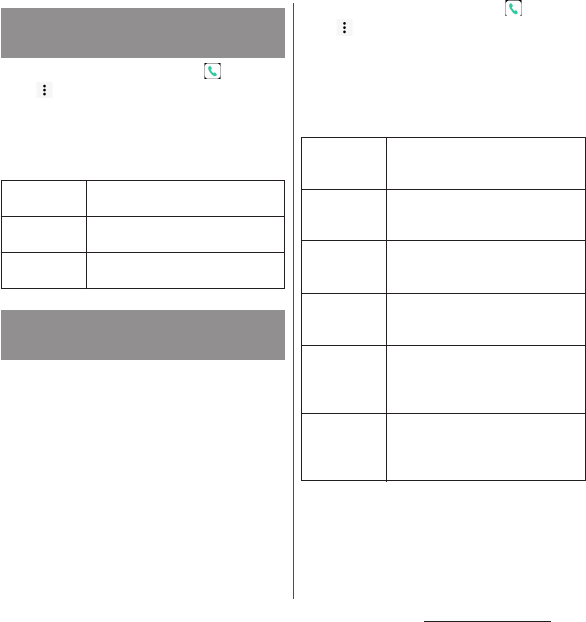
211
International roaming
1
From the Home screen,
u
Tap
.
2
[Call settings]
u
[Roaming
settings].
3
[International dial assist].
Set network service such as voice mail from
overseas.
・
You need to set "Remote operation settings"
(P.98) to "Activate Remote operation" in
advance.
・
If you make the settings overseas, you are
charged a call fee to Japan from the country
you stay.
・
For some overseas network operators,
settings may not be made.
1
From the Home screen,
u
Tap
.
2
[Call settings]
u
[Roaming
settings].
3
[Network service]
u
Select a target
service.
4
[OK]
u
Operate according to the
onscreen instructions or voice
guidance.
Setting International dialing
assist
Auto
conversion
Add international prefix or country
code automatically.
Country code
Select a country code used for auto
conversion.
International
prefix
Select an international prefix used for
auto conversion.
Setting Network service
(overseas)
Remote
operation
(charged)
Set whether to start Remote
operation.
Caller ID
request
(charged)
Play a guidance asking for notifying
caller ID when there is an incoming
call without caller ID.
Incoming call
notific.
(charged)
P. 2 1 0
Roaming
guidance
(charged)
P. 2 1 0
Voicemail
(charged)
Take messages from callers when you
are in a place the signal does not
reach or turn off the terminal.
Separate subscription is required.
Call
forwarding
(charged)
Forward incoming calls to another
mobile phone etc. that is registered
in advance.
Separate subscription is required.

212
International roaming
When you return to Japan, the terminal is
connected to DOCOMO network
automatically. If connection is failed, perform
the following operations.
・
Set "Preferred network type" (P.207) to "4G
(preferred)/3G/GSM".
・
Set "Search mode" to "Automatic" in "Service
providers" (P.206).
After returning to Japan

213
Appendix/Index
Appendix/Index
・
When you have a vague idea of
malfunctioning, you can perform diagnosis
by yourself.
For details, refer to NTT DOCOMO website.
https://www.nttdocomo.co.jp/support/
trouble/repair/ (in Japanese only)
・
Check if the software update is necessary for
the terminal. If necessary, perform the
software update (P.226, P.229).
・
When checking the following items not to
improve the state, contact the phone number
given in "Repairs (Inquiries/Request)" the last
page of this manual (in Japanese only) or
DOCOMO-specified repair office.
■
Power supply
Cannot power on the terminal.
・
Check if the battery is not run out.
→
P.36
Screen is frozen, the power cannot be
turned off.
・
When the screen freezes or the power
cannot be turned off, press and hold
O
and the volume up key at the same
time for approximately 8 seconds and
release it when the terminal vibrates 3
times consecutively to force stop.
* Note that some data and settings may be
erased due to force-quit operation.
■
Charging
Cannot charge (The notification LED does
not turn on, or the icon does not indicate
charging status.)
・
Check if the adapter's power plug is
correctly inserted to an outlet or
accessory socket.
・
Check if the adapter and the terminal are
set correctly.
→
P.40
・
When using an AC adapter (optional),
check if the Type-C plug of the AC adapter
is connected to the terminal correctly.
→
P.40
・
When using the USB cable A to C 01
(optional), check if a PC is turned on.
・
If you execute calls, communications or
other function operations for a long time
while charging, the terminal may become
hot and the notification LED turns off
(charging stops) or battery level may
become low. In this case, wait until the
temperature of the terminal drops and
charge again.
The notification LED blinks in red and the
terminal cannot be operated.
・
When the battery level is low, charge the
battery.
→
P.36
Troubleshooting
Troubleshooting
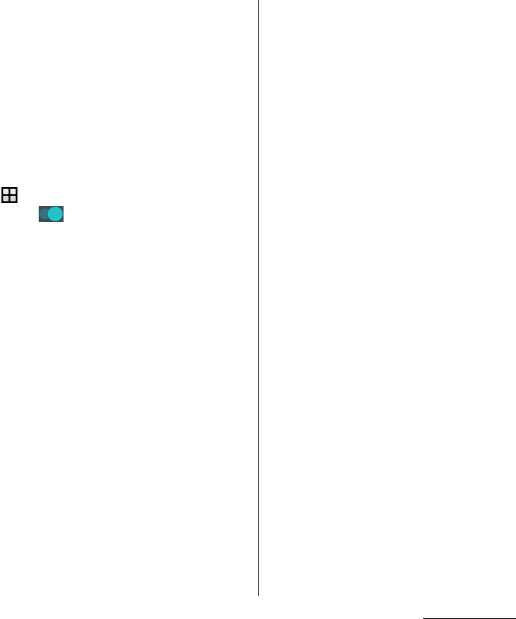
214
Appendix/Index
Battery Care charging does not start
・
Battery Care charging cannot start when
learning is not complete because
regularity in your charging habit has not
been found.
→
P.37
Cannot charge fully
・
If you remove charging equipment
during Battery Care charging, the terminal
may not be fully charged.
To charge fully, from the Home screen,
u
[Settings]
u
[Battery]
u
[Battery Care]
u
Tap to turn off Battery Care and
then switch to normal charge.
→
P.37
■
Terminal operation
Become hot while operating/charging.
・
While calling, depending on the radio
wave condition or call duration time, the
terminal may become hot around the
earpiece/speaker. This condition is not
abnormal.
・
While operating or charging, or if you use
application, watch TV, record video, etc.
for a long time while charging the battery,
the terminal, internal battery or adapter
may become hot. There is no problem
about operation and continue to use it.
・
When the temperature of the terminal is
raised, a message appears on the
Notification panel and some applications
or services may become unavailable.
In this case, wait until the temperature of
the terminal drops and use again.
The operation time provided by the
battery is short.
・
Is the terminal left for a long time under
the state of out of service area?
Out of service area, a lot of power is
consumed to search available radio
waves. If you are out of service area for a
long time, set Airplane mode or power off
the terminal.
→
P.42 , P.163
・
The operating time of the battery varies
depending on the operating
environment and the degradation level of
the internal battery.
→
P.36
・
The internal battery is a consumable part.
Each time the internal battery is
recharged, the battery usage time per one
charge gradually decreases.
If the operation time becomes too short
with fully charged state, contact "Repairs
(Inquiries/Request)" on the last page (in
Japanese only) or a DOCOMO-specified
repair office.
・
Check if multiple applications are
activated.
Exit the unused applications.
→
P.67

215
Appendix/Index
・
When the Wi-Fi function or Bluetooth
function is not used, turn off the setting.
→
P.158 , P.197
・
When STAMINA mode is set, the
operations and a part of functions of the
terminal are restricted so that the
consumption of the battery power can be
reduced.
→
P.177
Operations are not possible when tapping
or pressing keys.
・
Check if the power is turned off.
→
P.42
・
Check if you activate the screen lock.
→
P.181
・
When you touch the screen at a right
angle by gloved finger with "Glove mode"
ON, operation may not be performed
well. Use a ball of finger to touch the
screen for operation.
→
P.169
The screen reacts slowly when you tap or
press the keys.
・
When large amount of data is saved in the
terminal or transferring large-size data
between the terminal and microSD card,
the reactions on the screen may be
delayed.
The docomo nano UIM card is not
recognized.
・
Check if the docomo nano UIM card is
attached in the right direction.
→
P.32
The clock is not on time.
・
The clock time may become wrong when
the power is turned on for a long time.
Check if "Automatic date & time" and
"Automatic time zone" are ON and turn
the power off and on in a place with
strong radio wave conditions.
→
P.191
The terminal operation is unstable.
・
Instability may be caused by applications
that you installed after purchasing the
terminal. If the symptom is improved
when you boot the terminal in safe mode
(near default state), uninstalling the
installed application may improve the
symptom.
To boot the terminal in safe mode, press
and hold
O
for at least 1 second with
the terminal OFF until XPERIA logo
appears, and then press and hold the
volume down key for a while.
When the power is turned on, press and
hold
O
for at least 1 second
u
Touch
and hold [Power off]
u
Tap [OK] to restart
the terminal in Safe mode.
When safe mode is booted, "Safe mode" is
displayed at the lower left of the screen.
To exit from the safe mode, turn power
OFF and then ON.
* Back up necessary data before using safe
mode.
* Some applications or widgets may be erased.

216
Appendix/Index
* Safe mode is not a normal active state. To use
ordinarily, exit from the safe mode.
Applications cannot be operated properly
(applications cannot be activated, or
errors occur frequently).
・
Are there any applications being
disabled? Enable disabled applications,
then retry.
→
P.175
・
Are the permissions for the application
granted?
→
P.49 , P.174
■
Phone call
Cannot make a call even if you tap .
・
Check if you activate Airplane mode.
→
P.163
The ringtone does not sound.
・
Is "Ring volume" set to silent?
→
P.173
・
Check if the following functions are
activated.
-Silent mode
→
P.46
- Airplane mode
→
P.163
・
Is the ring time for Voicemail service or
Call forwarding service "0 sec"?
→
P.97
・
Check if Pick up after in Answering
Machine is set to "0 second".
→
P.96
・
Check if you set Call Blocking.
→
P.98
Cannot call (Even when moving, does
not disappear, or although radio waves
are enough, making/receiving calls is
unavailable.)
・
Turn the power OFF and ON, or remove
and attach docomo nano UIM card.
→
P.32, P.42
・
Due to the nature of radio waves, making/
receiving calls may be unavailable even
when "not out of service area" or "
appears on the display for the radio wave
condition". Move to the other place and
call again.
・
Check if you set Call Blocking.
→
P.98
・
Due to the crossing of radio waves, at the
crowded public places, calls/mails are
crossed and the connection status may
not be good. Move to other place or call
again at other time.
An application activates when dialing
・
If you dial to a phone number subject to
モバイルセレクト
(Mobile select),
モバイル
セレクト
(Mobile select) application
activates. Follow the onscreen
instructions.

217
Appendix/Index
■
Display
The display is dim.
・
Check if "Sleep" is set in short time period.
→
P.169
・
Check if the brightness of screen is
changed.
→
P.170
・
When "Adaptive brightness" is ON, screen
brightness is changed according to the
ambient brightness.
→
P.169
・
Check if you cover the Proximity/Light
sensor with a sticker etc.
→
P.30
・
When the temperature of the terminal
becomes high while using, the display
may become darker. It is not abnormal.
■
Sound
During a voice call, the distant party's
voice is hard to listen to or too loud.
・
Check if the listening volume is changed.
→
P.94
■
Mail
Mail is not received automatically.
・
Check if you set "Check frequency" in
Email account settings to "Manual".
→
P.113
■
Camera
Still pictures and video taken with the
camera are blurred.
・
Check if clouds, dirt or film attach to the
lens of camera.
・
Use "SUPERIOR AUTO" for the capturing
mode.
→
P.135
・
Set "SteadyShot™" and then shoot.
→
P.142
Photo or video shot with flash is whitish.
・
If there is your finger or cover around the
camera lens, flash light may reflect and
affect photo or video shooting.
■
TV
Unable to watching Full seg/1Seg
・
Are you out of terrestrial digital TV
broadcasting service area or in a place
where airwave is weak?
・
Check if channels in the current location
are saved.
→
P.131
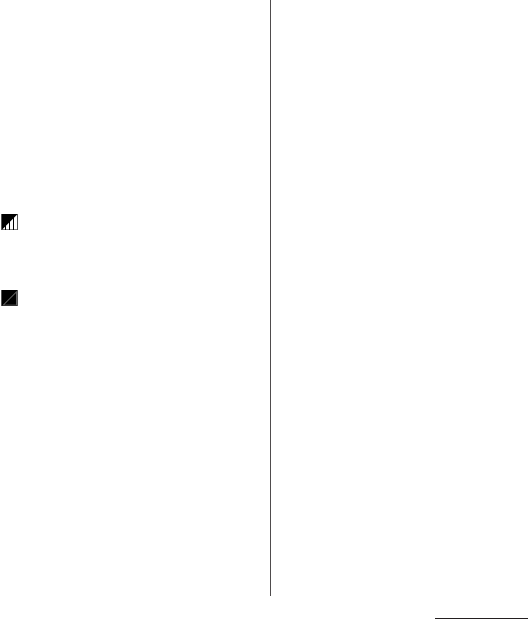
218
Appendix/Index
■
Osaifu-Keitai
Osaifu-Keitai function is unavailable.
・
When Omakase Lock is set, Osaifu-Keitai
functions are unavailable regardless of the
NFC / Osaifu-Keitai lock settings.
・
Check if NFC / Osaifu-Keitai lock setting is
set.
→
P.124
・
Check if you hold NFC / Osaifu-Keitai
position over an IC card reader?
→
P.123
■
International roaming
Cannot use the terminal overseas (when
is displayed)
・
Do you subscribe WORLD WING?
Check if you subscribe WORLD WING.
Cannot use the terminal overseas (when
is displayed)
・
Check if you are out of the international
roaming service area or in an area with
poor signal strength.
Check if the service area and network
operator are available or not, refer to NTT
DOCOMO website.
・
Change the network settings or overseas
network operator settings.
- Set "Preferred network type" to "4G
(preferred)/3G/GSM".
→
P.207
- Set "Search mode" to "Automatic" in
"Service providers".
→
P.206
・
Turning the power off and on may solve
the problem.
→
P.42
Cannot perform data communication
overseas.
・
Turn on "Data roaming".
→
P.206
The terminal suddenly became
unavailable while using overseas.
・
Check if usage amount exceeds the limit
of maximum charges for use.
For use of "International roaming (WORLD
WING)", the limit of maximum charges for
use is set in advance. If exceeding the limit
of maximum charges for use, pay the
charges.
Cannot receive calls overseas.
・
Is "Restricting incoming calls" set to
"Activate restriction"?
→
P.210
No caller ID is notified/a notified caller ID
is different from that of the caller/
functions for using contents saved in
phonebook or those using Caller ID
notification do not operate.
・
Even if a caller notifies its caller ID, it is not
displayed on the terminal unless the
network or network operator notifies it.
And a different caller ID may be notified
depending on the network or network
operator you use.
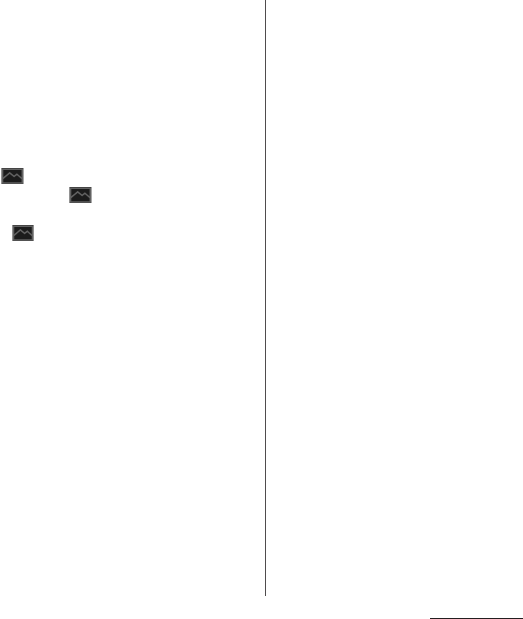
219
Appendix/Index
■
Data management
Data transfer is not performed.
・
Check if USB hub is used. If you use USB
hub, operations may not be performed
correctly.
Data saved in microSD card is not
displayed.
・
Remove and reinsert the microSD card.
→
P.34
"" or "
u
" appears when displaying
images, or " " or "
u
" appears for the
demo play or the preview function.
・
""/"
u
" may appear instead of
destroyed image data.
■
Bluetooth function
The terminal cannot be connected to a
Bluetooth communication device/A
Bluetooth communication device cannot
be found by search.
・
Make Bluetooth communication device
(commercial item) registering stand-by
state and then register the device on the
terminal. If you delete already registered
device and register the device again as a
new device, delete the registrations on
both Bluetooth communication device
(commercial item) and the terminal and
then perform registration of the devices.
→
P.198
Calls cannot be made from the terminal
connecting to external device such as car
navigation or handsfree device.
・
If calls are made several times when the
other party does not answer or is out of
service, the call to this number may be
disabled. In this case, turn terminal off and
on.
■
External device connection
An external device connected using USB
cable A to C etc. is not recognized.
・
Reconnect the external device.
However, some devices may not be
detected.
■
Map/GPS
Cannot set AUTO-GPS service
information.
・
Check if the battery level is low and AUTO-
GPS function stops.
If AUTO-GPS stops due to "Low-power
operation settings", AUTO-GPS service
information cannot be set. In this case, set
"Low-power operation settings" to "Not
suspend" or charge the battery.
→
P.36,
P.186
・
Check if "AUTO-GPS operation settings" is
marked.
→
P.186

220
Appendix/Index
●
No service
・
The terminal is out of service area, or the
received signal is too weak. Move to a
location where radio signal can be
reached.
・
The docomo nano UIM card is not
working properly.
Removing and inserting docomo nano
UIM card may solve the problem.
If the problem persists, try inserting the
docomo nano UIM card into another
terminal. If this works, it is probably the
terminal that is causing the problem. In
this case, contact "Repairs (Inquiries/
Request)" on the last page of this manual
(in Japanese only).
●
Mobile network not available
Install docomo nano UIM card correctly
(P.32), then move to a location where radio
signal reaches.
●
Unknown error. Could not switch to video
call.
This appears when switching to video call is
not available. If the other party's phone is
not compatible with video call or the other
party uses Call waiting, or during voice
guidance play, switching is not available.
●
Call not sent
This appears when making a voice call or
video call is not available. During a video
call, making a voice call to another party is
not available. Also, if the other party's phone
is not compatible with video call, or during
a voice call, making a video call is not
available.
●
Normal calls are restricted by access
control.
Appears when normal voice call service is
hard to receive because communication
lines are busy.
●
All calls are restricted by access control.
Appears when normal/emergency voice
call service is hard to receive because
communication lines are busy.
●
Restricted access changed
Appears when the voice service or data
service is not received.
●
SIM card is locked
Enter your PIN code (P.180) correctly.
●
SIM card is PUK-locked
Enter your PUK (PIN Unlock Key) (P.180)
correctly.
●
PIN lock disable code is locked.
PIN Unlock Key is locked. Please contact a
docomo Shop.
Error messages

221
Appendix/Index
●
Memory is getting low
Available memory space in the terminal is
low. If you continue to use the terminal,
some functions or applications may not
work. Activate the setting menu and select
unnecessary applications, then tap
[UNINSTALL] to uninstall the applications
(P.174).
●
Memory full.
There is no memory space in the microSD
card. Delete unnecessary data (P.196) to
save the memory space.
By sharing screens of your terminal with NTT
DOCOMO, you can receive technical support
to make settings, use applications, or connect
peripheral devices such as PC. (in Japanese
only).
・
This service is not available when your
docomo nano UIM card is not inserted, during
international roaming, or in Airplane mode.
・
Anshin Enkaku Support is a paid service
requiring subscription.
・
Some operations and settings are not
supported.
・
For details on Anshin Enkaku Support, refer to
NTT DOCOMO website.
1
Call
あんしん遠隔サポートセンター
(Anshin Enkaku Support center).
From DOCOMO mobile phones
(No prefix) 15710 (toll free)
From land-line phones
0120-783-360
Business hours: 9:00 a.m. to 8:00 p.m., open
all year round
あんしん遠隔サポート
(Anshin
Enkaku Support)
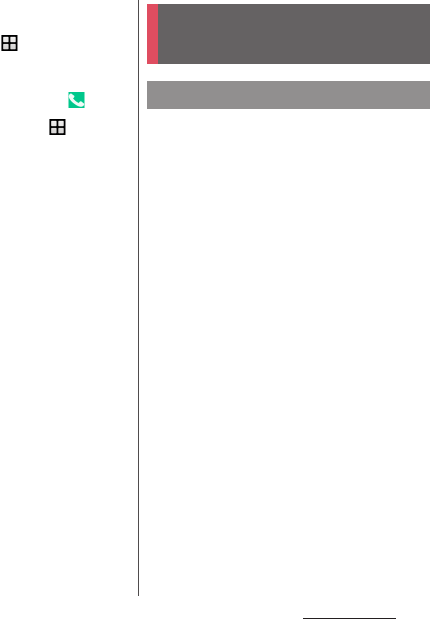
222
Appendix/Index
・
To make a call to the Anshin Enkaku
Support center from the terminal, from
the Home screen,
u
[
遠隔サポート
(Enkaku support)]
u
[
この
スマートフォンから発信する
(Make a call
from this smartphone)]
u
Tap .
2
From the Home screen,
u
[
遠隔サポート
(Enkaku support)].
3
[
遠隔サポートの接続画面に進む
(Go to
Enkaku support connection
screen)]
u
[
同意する
(Agree)].
4
Enter the connection number
notified by DOCOMO
u
[
開始
(Start)].
5
Enkaku support starts when you
are connected.
・
Make sure that the warranty is received with
the terminal upon purchase. Check to be sure
that "
販売店名・お買い上げ日
(the name of the
retailer, date of purchase)", and other items
have been filled out on the warranty before
storing it in a safe place. If any necessary
information is not provided, immediately
contact the retailer and request to complete
the warranty. The terminal comes with a year's
warranty starting from the date of purchase.
* TV antenna cable SO01 is not covered by the
cost-free repair warranty.
・
The specifications and the outer appearance
of the terminal including the accessories are
subject to change for improvement without
prior notice.
・
Data saved in the Contacts etc. may be
changed/lost due to the trouble/repairs or
handling of the terminal. DOCOMO
recommends making a copy of the
Phonebook data etc., in case.
* You can save Phonebook data in a microSD
card inserted to the terminal.
* Data such as phonebook entries can be
backed up by using docomo cloud.
Warranty and After Sales
Services
Warranty

223
Appendix/Index
If you have problems with the
terminal
Before asking repair, see "Troubleshooting"
(P.213) in this manual to check the problem. If
the problem still persists, contact "Repairs
(Inquiries/Request)" on the last page (in
Japanese only).
If repair is required resultingly
Bring the terminal to the DOCOMO-specified
repair office. However, it must be taken
during business hours of the repair office.
Make sure to bring a warranty card with the
product when you visit the shop. Note that
repair may take some days depending on the
problem.
* Recycled parts which meets DOCOMO
quality standard may be used for repairs.
■
Within the warranty period
・
We repair the terminal free of charge
based on the terms documented in the
warranty.
・
When requesting a repair, make sure to
bring the warranty card with the terminal.
Repair requests that are not accompanied
by the warranty, that involve malfunction
and damage due to incorrect handling by
the owner (damage of external
connection jack, display, etc.), or for the
terminal once repaired in a repair office
other than one specified by DOCOMO will
only be repaired at the owner's expense,
even if the warranty period is still effective.
・
Malfunction due to use of devices and
consumable parts other than those
specified by DOCOMO will only be
repaired at the owner's expense, even if
the warranty period is still effective.
■
Note that repair may be refused in the
following cases:
・
When the terminal has corrosion due to
wet by liquid, condensation, perspiration,
etc. or the internal circuit board is
damaged or deformed (we may not be
able to repair when the external
connection jack, display, etc. is damaged
or the frame itself is cracked) based on the
result of our examination.
After Sales Services

224
Appendix/Index
・
The terminal has been repaired by a repair
office other than the DOCOMO specified
one.
* Even if repair is possible, it will be done at
the owner's expense, as this type of
corrosion or damage is not covered by
the warranty.
■
If the warranty period expires
We will repair the terminal at the owner's
expense.
■
Parts stock period
The functional parts necessary to repair the
terminal will be basically available for a
minimum of 4 years after the manufacture is
discontinued.
For repair acceptance conditions, refer to
NTT DOCOMO website.
https://www.nttdocomo.co.jp/support/
trouble/repair/shop/compatible/
index.html (in Japanese only)
However, depending on the defective
portion, repair may not be possible because
of a shortage of repair parts. For details,
contact DOCOMO-specified repair office.
Precautions
●
Never modify the terminal or accessories.
・
Doing so may result in fire, injuries or
malfunctions.
・
The modified terminal may be repaired
only if the owner agrees on that all the
modified parts are restored to the original
conditions.
However, repairs may be refused
depending on the modifications.
The following cases may be considered as
modifications.
- Put a seal etc. on the display or key part
- Glued decorations on the terminal using
adhesion bond, etc.
- Change the parts such as exterior to
other than DOCOMO standard parts
・
Malfunction and damage due to
modifications will be repaired at the
owner's expense, even if the warranty
period is still effective.
●
Do not remove the inscription sticker on
the terminal.
・
Note that if the inscription sticker is
removed or is replaced with a different
sticker, it may disqualify the terminal from
repairs.

225
Appendix/Index
●
Note that the settings and other
information may be reset (cleared) as a
result of malfunction, repair or other
handling. In this case, make the settings
again. In that case, packet communication
charge may incur depending on the
settings.
●
After the repair, Wi-Fi MAC address or
Bluetooth address may be changed
regardless of the repaired parts.
●
Take care not to let an object that is easily
affected by magnetism, such as a cash card
near the terminal because the card may
become unavailable.
●
The terminal is waterproof. If inside of the
terminal gets wet or moist, however, turn
the power off, then bring the terminal to a
repair office as soon as possible. Note that
repair may not be possible depending on
the condition of the terminal.
Created data and download
information
Note that data you created or data you
retrieved or downloaded from sources other
than your terminal may be changed or lost
when you change the model or have repairs
done to the terminal. DOCOMO shall have no
liability for any change or loss of any kind.
DOCOMO shall have no liability for packet
communication charge for re-downloading
data. Under some circumstances, DOCOMO
may replace your terminal with its equivalent
instead of repairing it. In that case, such data
cannot be transferred to the replaced
product except for a part.
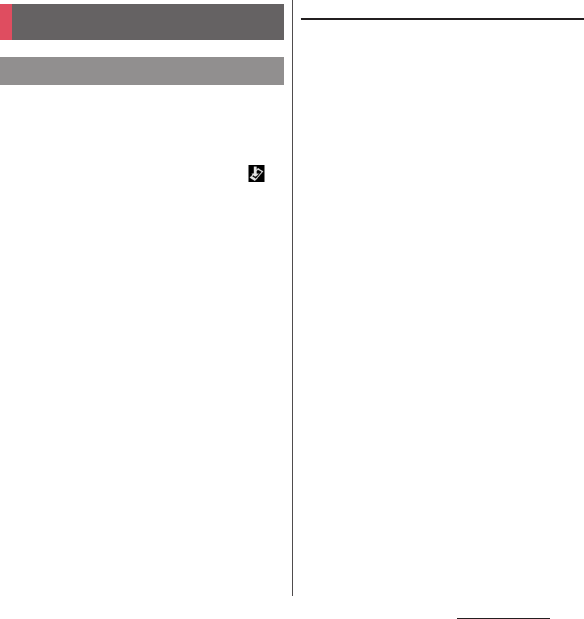
226
Appendix/Index
Software update is a function to connect to
the network to check if software update is
required, then download the update file and
install it as required.
When update is needed, you can check
(Software Update) in the status bar or
information on the NTT DOCOMO website.
Software update includes the following, etc.
To use the terminal in safety and more
comfortably, be sure to update to the latest
version.
・
Improving and adding functions
・
Operability enhancement
・
Improving quality
・
Security patch update
❖
Information
・
Updating can be done with data saved to the
terminal; note that data may not be always safe
depending on the conditions of your terminal (such
as malfunction, damage, or water leak). DOCOMO
recommends backing up necessary data in advance.
However some data may not be backed up.
Notes
・
When the software is updated, restoring the
previous software is not possible.
・
When performing update, the private
information concerning the terminal (model,
serial number, etc.) is automatically sent to the
server of DOCOMO. DOCOMO does not use
the sent information for purposes except
software update.
・
For using packet communication via Xi/
FOMA, communication charge is not applied
for downloading.
・
For the update using packet communication,
docomo nano UIM card provided at
subscription to DOCOMO is required. For
some updates, subscription to sp-mode may
be required to use packet communication.
・
Making/Receiving calls, communication
functions and other functions are disabled
while installing.
・
All key operations are disabled while installing
and the installation cannot be stopped on the
way.
・
When the update is complete, the terminal
restarts.
・
When the update is performed, some settings
are initialized. Make the settings again.
・
If PIN code is set, PIN code entry screen
appears while the terminal is restarting after
the rewriting process. Enter PIN code.
Software Update
Software Update
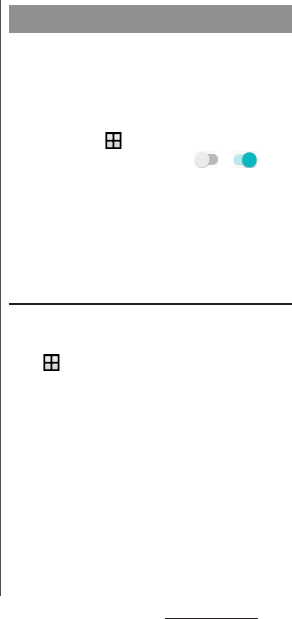
227
Appendix/Index
・
If the update failed and all operations become
disabled, please contact a DOCOMO-
specified repair office.
・
Messages (SMS) sent while updating are
stored in the SMS center.
・
Performing update may take time.
・
Updating is unavailable in the following cases.
-During a call
- When
圏外
(out of service area) is displayed
- Tethering in use as an access point
- When date and time are not set correctly
- When the remaining battery is not sufficient
- When the remaining memory is not
sufficient
- When the basic software is altered illegally.
・
Exit from all applications before installing.
・
Update the software with the battery fully
charged.
・
Do not turn off the terminal while updating.
・
Stay in a place with strong radio wave
condition when downloading. The update
may be canceled if the radio wave condition
is not good enough.
・
If an update is not needed, "No upgrade is
needed. Use it as it is." appears.
・
For update available period, refer to NTT
DOCOMO website.
・
You need to perform the installation by
yourself for updating software. Drag the
status bar down
u
Tap a notification
u
Tap
[install].
・
To change the auto-update setting, from the
Home screen,
u
[Settings]
u
[About phone]
u
[Software Update]
u
Tap of / of
"Auto download".
・
When "Auto download" is OFF, perform
operation of "When the icon does not appear
in the status bar" (P.227).
When the icon does not appear in the
status bar
Perform the update as follows.
1
From the Home screen,
u
[Settings]
u
[About phone]
u
[Software Update]
u
[Update now].
・
Download starts.
2
After a message for installation
start appears
u
[INSTALL].
・
Installation starts.
Updating software
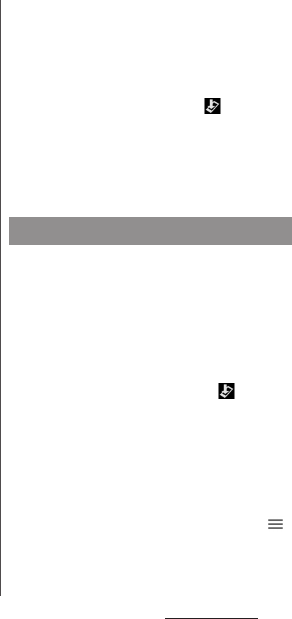
228
Appendix/Index
■
When the confirmation screen for
update appears
Depending on update, a confirmation
screen for performing update appears after
[Update now] is tapped.
1
Select a updating method.
・
"Perform now (only via Wi-Fi)" :
Immediately download the update file
via Wi-Fi connection.
・
"Perform at scheduled time (via Wi-Fi/
Xi)"
*
: Download the update file via
Wi-Fi connection or Xi/FOMA at the
time that is reserved automatically.
* If downloading via Xi/FOMA is not available,
"Perform at scheduled time (only via Wi-Fi)"
appears. If you does not set sp
モード
(sp-
mode), the update cannot be performed
even if [Perform at scheduled time (only via
Wi-Fi)] is tapped. Use Wi-Fi connection.
2
[Download and install]/
[Download].
・
"Download and install" : After
downloading is complete, the
installation is performed automatically.
Installation is performed after
approximately 10 seconds even if you
do not tap [OK].
・
"Download" : Even when downloading
update file is complete, the installation
is not performed automatically. To
install, perform installation by yourself.
❖
Information
・
When the latest software is already applied to the
terminal, "No upgrade is needed. Use it as it is."
appears.
・
If downloading stops halfway, data downloaded
before interruption is retained for up to 14 days. To
resume downloading, resume from (Download
stopped) on the Notification panel.
・
When "Perform at scheduled time (via Wi-Fi/Xi)" is
selected, time for downloading is automatically set.
Tap [BACK]
u
[Perform at scheduled time (via Wi-Fi/
Xi)] to set time for downloading again automatically.
After the update is done, check if updates for
applications are available. Without updating
applications, operations may become
unstable or functions may not work properly.
Be sure to update to the latest version.
・
Updating from the notification icon
When the update is complete, the terminal
restarts and the notification icon (Update
completed) appears.
Drag the status bar down
u
[Update
completed]
u
Follow the onscreen
instructions to update applications in the
update list.
・
Updating from Play Store
From the Home screen, tap [Play Store]
u
u
Tap [My apps & games] to update each
application.
Updating applications
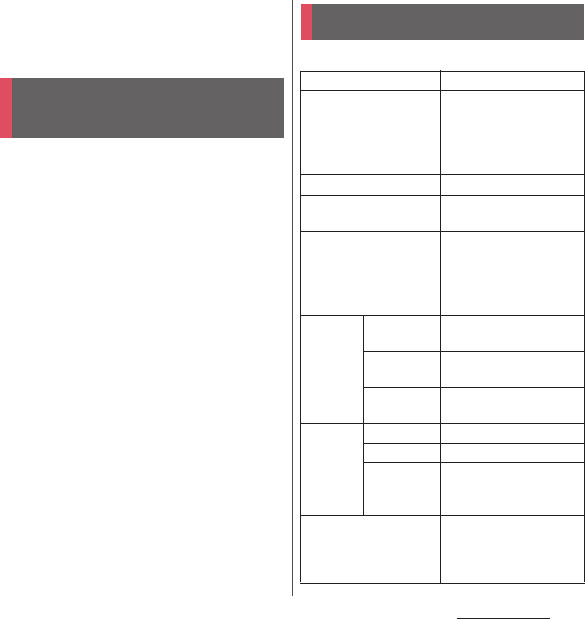
229
Appendix/Index
❖
Information
・
For OS version support information on each
application, contact the application provider.
Install a software for "Software update"
beforehand.
For methods of software installation, refer to
the following website.
http://www.sonymobile.co.jp/support/ (In
Japanese only)
■
The terminal
Connecting to a PC to
update
Main specification
Product name
SO-01K
Size
Approx. 146 mm (H)
u
approx. 72 mm (W)
u
approx. 8.1 mm (T)
(Thickest part: Approx. 8.7
mm)
Weight
Approx. 161g
Internal memory
ROM : 32GB
*1
RAM : 4GB
External memory
compatible
microSD card of up to 2GB
microSDHC card of up to
32GB
microSDXC card of up to
256GB (as of May, 2017)
Continuous
stand-by
time
FOMA/3G
Stationary (Auto) : Approx.
650 hours
GSM
Stationary (Auto) : Approx.
480 hours
LTE
Stationary (Auto) : Approx.
590 hours
Continuous
call time
FOMA/3G
Approx. 850 min.
GSM
Approx. 740 min.
VoLTE call
(voice)
VoLTE : Approx. 1,220 min.
VoLTE (HD+) : Approx.
1,070 min.
Charging time
AC Adapter 06 : Approx.
160 min.
DC Adapter 04 : Approx.
180 min.
*2
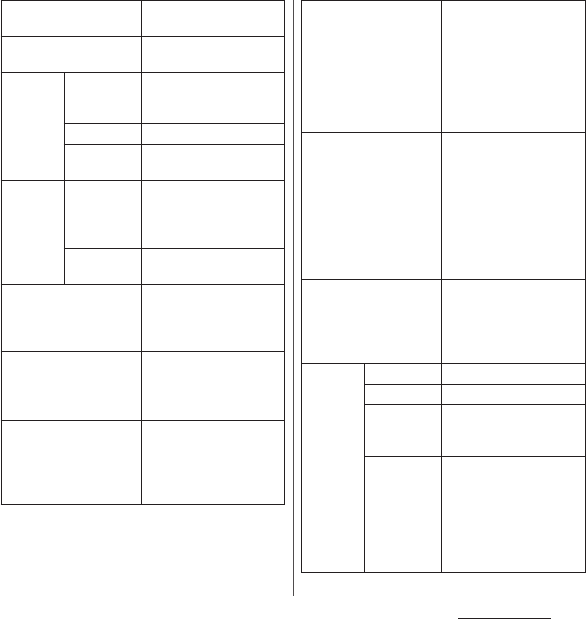
230
Appendix/Index
Continuous Full seg
watching time
Approx. 470 min.
Continuous 1Seg
watching time
Approx. 550 min.
Display Type/
Colors
TFT (Triluminos
®
Display
for Mobile)
16,777,216 colors
Size
Approx. 5.2 inches
Resolution
1,080 (H)
u
1,920 (V) pixels
(Full HD)
Image
pickup
device
Type
Camera : Backside-
illumination layered CMOS
Front camera : Backside-
illumination layered CMOS
Size
Camera : 1/2.3 inches
Front camera : 1/3.0 inches
Camera effective pixels
Camera : Approx.
19,200,000 pixels
Front camera : Approx.
13,200,000 pixels
Camera recorded pixels
(Max.)
Camera : Approx.
19,200,000 pixels
Front camera : Approx.
13,200,000 pixels
Zoom
Camera : (Still picture) Max.
approx. 8.0x (121 levels),
(Video) Max. approx. 8.0x
(121 levels)
Front camera :
―
Still picture recording
size
Camera :
5056
u
3792 (19MP 4:3)
5504
u
3096 (17MP 16:9)
4000
u
3000 (12MP 4:3)
4608
u
2592 (12MP 16:9)
Front camera :
4160
u
3120 (13MP 4:3)
4192
u
2358 (10MP 16:9)
Video recording size
Video camera :
3840
u
2160 (4K 16:9)
1920
u
1080 (Full HD 16:9)
1280
u
720 (HD 16:9)
640
u
480 (VGA 4:3)
Front video camera :
1920
u
1080 (Full HD 16:9)
1280
u
720 (HD 16:9)
640
u
480 (VGA 4:3)
Wireless LAN
Compliant with
IEEE802.11a/b/g/n
*3
/ac
*3
(Corresponding frequency
band to IEEE802.11n :
2.4GHz/5GHz)
Bluetooth Version
4.2
*4
Radio power
power class 1
Available
communication
distance
*5
Within approx. 10 m
Supported
profile/
codec
*6
(version)
HFP (1.7) (mSBC : 16kHz),
HSP (1.2), OPP (1.2), SPP
(1.2), HID (1.0), A2DP (1.2)
(LDAC/aptX/SBC), AVRCP
(1.6), PBAP (1.2), PAN (PAN-
NAP (1.0)/PANU (1.0)),
HOGP (1.0), MAP (1.2)

231
Appendix/Index
*1 It is not the actual storage capacity because the
memory is also used for the Android OS and
preinstalled applications.
For available memory, see "Viewing the storage use
condition" (P.176).
*2 It is a charging time when the microUSB conversion
adapter B to C 01 (optional) is used for charging.
*3 It supports MIMO.
*4 It is confirmed that the terminal and all Bluetooth
devices are compliant with Bluetooth standards
designated by Bluetooth SIG, and they are
authenticated. However, procedures may differ or
data transfer may not be possible depending on the
device's characteristics or specifications.
*5 May vary by the signal status and/or whether there
is an interference between communication devices.
*6 Bluetooth standards for Bluetooth device
connection procedure according to the product's
applications.
*7 As for 4-pole headset, complied with CTIA
standards.
・
Continuous stand-by time is an estimate of
the stand-by time when radio signal
reception is normal. Stationary continuous
stand-by time is the estimated average
operation time when radio signal reception is
normal.
In certain circumstances, the stand-by time
may drop to as low as half the time shown
due to the battery charge, function settings,
temperature, or radio signal reception in the
area (no reception or weak).
・
Continuous call time is an estimate of the
operation time for calling when radio signal
reception is normal.
・
A use of the Internet reduces the actual call
(communication)/stand-by time.
Composing messages or activating the
camera or applications also reduces call
(communication)/stand-by time even if you
do not call or use the Internet.
・
Charging time is an estimate of the time
required to charge a completely empty
internal battery. Under low temperature,
charging may require longer time.
■
Internal battery
* It is a battery capacity for providing an indication of
continuous usage time etc.
■
TV antenna cable SO01
Headset
jack
Size
Diameter 3.5 mm
Pole
*7
5-pole
Battery type
Lithium Ion Battery
Voltage
3.8V DC
Nominal
battery
capacity
*
2900mAh
Size
Length : approx. 148 mm
Weight
Approx. 5 g
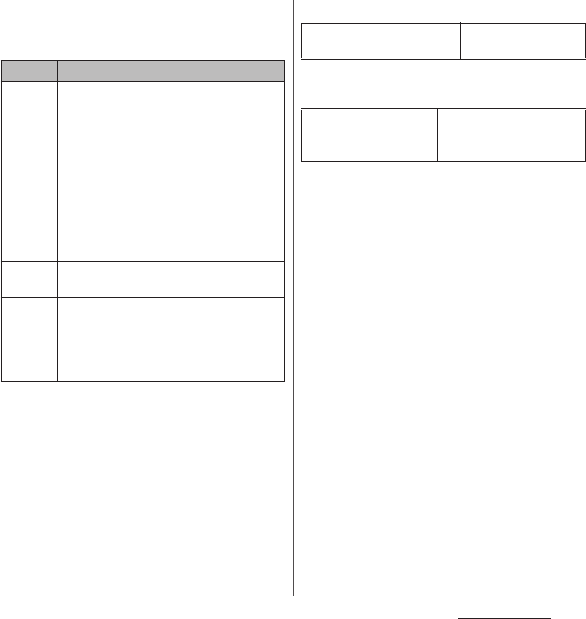
232
Appendix/Index
■
File format (media)
The terminal supports the display or
playback of the following file formats:
* Still images are saved in JPEG format when shot with
Camera in the terminal.
■
Recording time for 1Seg (Estimation)
■
Time length of shooting video
(Estimation)
* Time of recording with Video resolution of
1920
u
1080 (Full HD).
Type File format
Sound
AAC-LC (.mp4, .m4v, .3gp, .3gpp, .ts, .avi,
.aac, .m4a), AAC+ (.mp4, .3gp, .3gpp, .ts, .avi,
.aac), eAAC+ (.mp4, .3gp, .3gpp, .ts, .avi,
.aac), AAC-ELD (.mp4, .3gp, .3gpp), AMR-NB
(.3gp, .3gpp, .amr), AMR-WB (.3gp, .3gpp,
.awb), FLAC (.flac), MP3 (.mp3), MIDI (.mid,
.xmf, .mxmf, .rtttl, .rtx, .ota, .imy), Vorbis
(.mkv, .webm, .mka, .ogg), PCM (.avi, .wav,
.aiff, .aif, .aifc), Opus (.mkv, .webm, .mka,
.ogg), ALAC (.m4a), WMA (.wma), DSD (.dsf,
.dff )
Still
image
*
JPEG (.jpg, .jpeg), GIF (.gif), PNG (.png), BMP
(.bmp), WebP (.webp)
Video
H.263 (.mp4, .3gp, .3gpp), H.264 (.mp4,
.m4v, .3gp, .3gpp, .ts, .avi, .mkv), H.265
(.mp4, .mkv), MPEG-2 Video (.ts), MPEG-4
Video (.mp4, .m4v, .3gp, .3gpp), VP8 (.mkv,
.webm), VP9 (.mkv, .webm), Xvid (.avi)
Recordable time to save to a
microSD card (1GB)
Approx. 320 min.
Savable time of
recording to the
internal storage
Per video : Up to approx.
100 min.

233
Appendix/Index
■
Display language
Azerbaijani language (Latin)/Malaysian/
Bosanski jezik/Catalan language/Czech/
Danish/German/Estonian/English/Spanish/
Basque/Filipino/French/A lingua galega/
Croatian/Indonesian/Icelandic/Italian/
Javanese/Latvian/Lithuanian/Hungarian/
Dutch/Norwegian (language for books)/
Polish/Portuguese/Romanian/Albanian/
Slovakian/Slovenian/Serbian/Sundanese/
Finnish/Swedish/Vietnamese/Turkish/
Greek/Belarusian/Bulgarian/Kazakh
language/Macedonian language/Russian/
Tatar language/Ukrainian language/
Georgian/Armenian/Hebrew/Arabic/
Persian (Dari language)/Marathi/Hindi/
Bengali/Punjabi/Tamil/Telugu/Kannada/
Malayalam/Thai/Korean/Japanese/Chinese
(Simplified)/Chinese (Traditional)
■
Text language (Character entry)
Afrikaans/Albanian/Arabic/Aragonese/
Armenian/Asturian language/Assamese/
Azerbaijani/Basque/Belarusian/Bengali/
Bodo language/Bosanski jezik/Breton/
Bulgarian/Burmese/Catalan/Chinese (Hong
Kong)/Chinese (Simplified)/Chinese
(Taiwan)/Croatian/Czech/Danish/Maldivian
language/Dogri/Dutch /English/Esperanto/
Estonian/Faroese/Persian/Finnish/French/
Frisian/A lingua galega/Georgian/German/
Greek/Gujarati/Hausa/Hebrew/Hindi/
Indian English/Hungarian/Icelandic/Igbo/
Indonesian/Irish/Italian/Japanese/
Javanese/Kannada/Kashmiri/Kazakh
language/Khmer/Konkani/Korean/Kurdish/
Kyrgyz language/Lao language/Latvian/
Lithuanian/Luxembourgish language/
Macedonian language/Maithili language/
Malagasy/Malaysian/Malayalam/Maltese/
Meithei language/Marathi/Mongolian/
Nepali/Norwegian/Langue d'oc/Oriya/
Polish/Portuguese/Punjabi/Romanian/
Russian/Sanskrit/Santali language/Serbian/
Sindhi/Sinhalese/Slovakian/Slovenian/
Spanish/Sundanese/Swahili/Swedish/
Tagalog/Tajik language/Tamil/Tatar
language/Telugu/Thai/Turkish/Turkmen
language/Ukrainian language/Urdu/
Uzbek/Vietnamese/Welsh/Xhosa/Yoruba/
Zulu
■
Text language (Voice input)
By Google voice typing
Language

234
Appendix/Index
You can check details of certificate and
compliance mark specific to the terminal
(including certificate number/compliance
number).
1
From the Home screen,
u
[Settings].
2
[About phone]
u
[Certificates].
■
VCCI
The terminal complies with a technical
standards based on VCCI RULES FOR
VOLUNTARY CONTROL MEASURES and the
mark of conformity is depicted
electronically on the screen.
Software delivered with this device and its
media is owned by Sony Mobile
Communications Inc., and/or its affiliated
companies and its suppliers and licensors.
Sony Mobile grants you a non-exclusive
limited license to use the Software solely in
conjunction with the Device on which it is
installed or delivered.
Ownership of the Software is not sold,
transferred or otherwise conveyed.
Do not use any means to discover the source
code or any component of the Software,
reproduce and distribute the Software, or
modify the Software.
You are entitled to transfer rights and
obligations to the Software to a third party,
solely together with the Device with which
you received the Software, provided the third
party agrees in writing to be bound by the
terms of this Licence.
This licence exists throughout the useful life
of this Device.
It can be terminated by transferring your
rights to the Device to a third party in writing.
Failure to comply with any of these terms and
conditions will terminate the licence
immediately.
Certificate and compliance End User Licence
Agreement

235
Appendix/Index
Sony Mobile and its third party suppliers and
licensors retain all rights, title and interest in
and to the Software.
To the extent that the Software contains
material or code of a third party, such third
parties shall be beneficiaries of these terms.
This license is governed by the laws of Japan.
When applicable, the foregoing applies to
statutory consumer rights.
In the event Software accompanying or
provided in conjunction with your device is
provided with additional terms and
conditions, such provisions shall also govern
your possession and usage of the Software.
This product and its accessories may be
covered and controlled by Japans export
control regulations ("Foreign Exchange and
Foreign Trade Law" and related laws and
regulations) And, they are also under
coverage of Export Administration
Regulations of the U.S. When exporting and
reexporting this product and its accessories,
take necessary procedures on your
responsibility and expense. For details,
contact Ministry of Economy, Trade and
Industry of Japan or US Department of
Commerce.
Export Controls and
Regulations
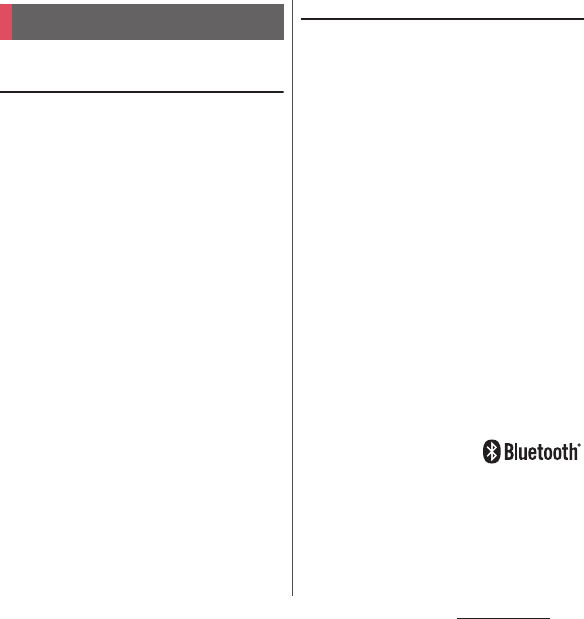
236
Appendix/Index
About the Copyright and Portrait
rights
Copyrighted contents you recorded or
obtained from sites or Internet home pages
using this product by downloading or other
means, such as documents, images, music
data, software, are prohibited from
reproduction, transformation and
transmission over public lines without
consent of the copyright holders, unless
intended for personal use or any other
purpose permitted by law.
Note that some performances, shows, and
exhibitions may not allow photography,
movie shooting, or sound recording even for
personal use.
You should also refrain from taking a picture
of other people and disclosing it by such
means as posting it on a site on the Internet
without their consent because of possible
infringement of their right of portrait.
Trademarks
The company names and product names
appearing in this manual are trademarks or
registered trademarks of their respective
holders.
・
"FOMA", "i-mode", "i-
α
ppli", "sp-mode",
"mopera U", "WORLD WING", "WORLD CALL",
"ToruCa", "iD", "Xi", "LIVE UX", logo of "ToruCa",
logo of "Osaifu-Keitai", logo of "iD", logo of
"Area Mail", logo of "i-concier", logo of
"Instruction Manual", logo of "dmenu", logo of
dmarket, logo of "Anshin Enkaku Support",
logo of "Anshin Scan", logo of "Shabette
concier", logo of "Photo collection", logo of
"Hanashite Hon'yaku", logo of "My Magazine",
logo of "docomo phonebook", logo of
"docomo Data Copy", and logo of "Data
Storage BOX" are trademarks or registered
trademarks of NTT DOCOMO, INC.
・
"Bluetooth" is a registered trademark of
Bluetooth SIG, Inc. and any use of such marks
by Sony Mobile Communications, Inc. is
under license.
・
iWnn
©
OMRON SOFTWARE Co., Ltd. 2008-
2017 All Rights Reserved.
Intellectual Property Right
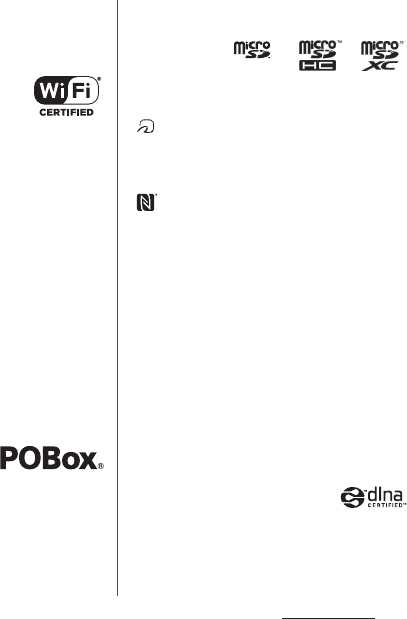
237
Appendix/Index
・
Wi-Fi, Wi-Fi Protected Setup, Wi-Fi Protected
Setup logo, WPA2
™
, Wi-Fi Direct and Wi-Fi
CERTIFIED Miracast are registered trademarks
of Wi-Fi Alliance.
・
"Catch Phone (Call waiting service)" is a
registered trademark of Nippon Telegraph
and Telephone Corporation.
・
Xperia and Xperia Lounge are trademarks or
registered trademarks of Sony Mobile
Communications Inc.
・
PlayStation and DUALSHOCK are trademarks
or registered trademarks or Sony Interactive
Entertainment Inc.
・
Sony, X-Reality, FeliCa, Reader, Triluminos,
STAMINA and TV SideView are trademarks or
registered trademarks of Sony Corporation.
・
SmartAR
®
is an augmented reality technology
developed by Sony Corporation and it is a
registered trademark or trademark in Japan
and other countries.
・
POBox and POBox logo
are registered trademarks
of Sony Computer
Science Laboratories, Inc.
POBox is a co-developed technology of Sony
Computer Science Laboratories, Inc. and Sony
Mobile Communications, Inc.
・
microSD logo, microSDHC logo and
microSDXC logo are trademarks of SD-3C, LLC.
・
USB Type-C
™
is a trademark of USB
Implementers Forum.
・
is a registered trademark of FeliCa
Networks, Inc.
・
FeliCa is a contactless IC card technology
developed by Sony Corporation.
・
is a trademark or registered trademark of
NFC Forum, Inc. in the US and other countries.
・
"Twitter" is a trademark or registered
trademark of Twitter, Inc.
・
"Google" and "Google" logo, "Android",
"Google Play" and "Google Play" logo, "Gmail"
and "Gmail" logo, "Google Maps" and "Google
Maps" logo, "Google Calendar" and "Google
Calendar" logo, "YouTube" and "YouTube"
logo, "Google Docs" and "Google Docs" logo,
"Google Chrome" and "Google Chrome" logo
are trademarks or registered trademarks of
Google, Inc.
・
Facebook and Facebook logo are trademarks
or registered trademarks of Facebook, Inc.
・
"DLNA" and "DLNA" logo are
trademarks or registered
trademarks of the Digital Living Network
Alliance.

238
Appendix/Index
・
"Microsoft", "Windows", "Microsoft Excel",
"Microsoft PowerPoint", "PlayReady" and
"Microsoft Exchange ActiveSync" are
trademarks or registered trademarks of
Microsoft Corporation in the United States
and other countries.
・
"Microsoft Word" is a product name of
Microsoft Corporation in the United States.
・
This product contains technology subject to
certain intellectual property rights of
Microsoft. Use or distribution of this
technology outside of this product is
prohibited without the appropriate license(s)
from Microsoft.
・
Content owners use Microsoft PlayReady
content access technology to protect their
intellectual property, including copyrighted
content. This device uses PlayReady
technology to access PlayReady-protected
content and/or WMDRM-protected content.
If the device fails to properly enforce
restrictions on content usage, content owners
may require Microsoft to revoke the device's
ability to consume PlayReady-protected
content. Revocation should not affect
unprotected content or content protected by
other content access technologies. Content
owners may require you to upgrade
PlayReady to access their content. If you
decline an upgrade, you will not be able to
access content that requires the upgrade.
・
This product is licensed under the MPEG-4
visual and AVC patent portfolio license for the
personal and non-commercial use of a
consumer for (i) encoding video in
compliance with the MPEG-4 visual standard
("MPEG-4 video") or the AVC standard ("AVC
video") and/or (ii) decoding MPEG-4 or AVC
video that was encoded by a consumer
engaged in a personal and non-commercial
activity and/or was obtained from a video
provider licensed by MPEG LA to provide
MPEG-4 and/or AVC video. No license is
granted or shall be implied for any other use.
Additional information including that relating
to promotional, internal and commercial uses
and licensing may be obtained MPEG LA,
L.L.C. (See http://www.mpegla.com ). MPEG
Layer-3 audio decoding technology licensed
from Fraunhofer IIS and Thomson.
・
Other product and company names
mentioned herein may be the trademarks of
their respective owners.
In context, TM and
®
mark are omitted.
・
Any rights not expressly granted herein are
reserved. All other trademarks are property of
their respective owners.

239
Appendix/Index
This terminal supports SIM unlock. If you
release SIM lock, you can use SIM by a carrier
other than NTT DOCOMO.
・
Available services and functions may be
limited. DOCOMO is not liable to any failures
or malfunctions.
・
For details of SIM unlock procedure, refer to
NTT DOCOMO website.
1
Insert SIM card provided by other
company.
2
Power on the terminal.
3
Enter the SIM unlock code
u
[UNLOCK].
SIM unlock

240
Appendix/Index
A
About phone
・・・・・・・・・・・・・・・・・・・・・・・・ 194
Access point
Initializing
・・・・・・・・・・・・・・・・・・・・・・・・・ 167
Setting
・・・・・・・・・・・・・・・・・・・・・・・・・・・・ 167
Accessibility
・・・・・・・・・・・・・・・・・・・・・・・・・ 193
Account & sync
・・・・・・・・・・・・・・・・・・・・・・・ 187
Removing
・・・・・・・・・・・・・・・・・・・・・・・・・ 188
Accounts & services
・・・・・・・・・・・・・・・・・・・ 186
Adjusting sound volume
・・・・・・・・・・・・・・・ 173
Airplane mode
・・・・・・・・・・・・・・・・・・・・・・・ 163
Alarm
・・・・・・・・・・・・・・・・・・・・・・・・・・・・・・・ 153
Alarm ringtone
・・・・・・・・・・・・・・・・・・・・・・・ 173
Alarm volume
・・・・・・・・・・・・・・・・・・・・・・・・ 173
Album
・・・・・・・・・・・・・・・・・・・・・・・・・・・・・・ 145
Amazon Kindle
・・・・・・・・・・・・・・・・・・・・・・・・ 65
Amazon Shopping
・・・・・・・・・・・・・・・・・・・・・ 65
Anshin Scan
・・・・・・・・・・・・・・・・・・・・・・・・・・ 62
Answering Machine
・・・・・・・・・・・・・・・・・・・・ 96
App permissions
・・・・・・・・・・・・・・・・・・・・・・・ 49
Application
Adding to Home screen (Xperia Home)
・・ 68
docomo LIVE UX
・・・・・・・・・・・・・・・・・・・・・ 83
List
・・・・・・・・・・・・・・・・・・・・・・・・・・・・・・・・ 62
Moving
・・・・・・・・・・・・・・・・・・・・・・・・・・・・ 84
Moving to Home screen (docomo LIVE UX)
・・・・・・・・・・・・・・・・・・・・・・・・・・・・・・・・・・・ 83
Resetting
・・・・・・・・・・・・・・・・・・・・・・・・・・ 175
Search
・・・・・・・・・・・・・・・・・・・・・・・・・・・・・ 85
Uninstalling (application screen)
・・・・・・・・ 84
Uninstalling (docomo LIVE UX)
・・・・・・・・・ 81
Uninstalling (Play Store)
・・・・・・・・・・・・・・ 121
Uninstalling (Xperia Home)
・・・・・・・・・・・・ 68
Xperia Home
・・・・・・・・・・・・・・・・・・・・・・・・ 62
Application screen
Adding
・・・・・・・・・・・・・・・・・・・・・・・・・・・・ 69
docomo LIVE UX
・・・・・・・・・・・・・・・・・・・・・ 83
Folder
・・・・・・・・・・・・・・・・・・・・・・・・・・・・・ 69
Rearranging
・・・・・・・・・・・・・・・・・・・・・・・・ 69
Recommends
・・・・・・・・・・・・・・・・・・・・・・・ 84
Switching
・・・・・・・・・・・・・・・・・・・・・・・・・・ 83
Switching (Xperia Home)
・・・・・・・・・・・・・・ 62
Xperia Home
・・・・・・・・・・・・・・・・・・・・・・・・ 62
Application selection screen
・・・・・・・・・・・・・ 48
Apps
Managing
・・・・・・・・・・・・・・・・・・・・・・・・・ 173
Apps button
docomo LIVE UX
・・・・・・・・・・・・・・・・・・・・・ 80
Xperia Home
・・・・・・・・・・・・・・・・・・・・・・・・ 55
Area Mail
・・・・・・・・・・・・・・・・・・・・・・・・・・・・ 115
Assist
・・・・・・・・・・・・・・・・・・・・・・・・・・・・・・・ 190
AUTO-GPS
・・・・・・・・・・・・・・・・・・・・・・・・・・・ 186
B
Backlight
・・・・・・・・・・・・・・・・・・・・・・・・・・・・・ 42
Backup & reset
・・・・・・・・・・・・・・・・・・・・・・・ 189
Battery
・・・・・・・・・・・・・・・・・・・・・・・・・・・・・・ 177
Battery Care
・・・・・・・・・・・・・・・・・・・・・・・・・・ 37
Battery level
・・・・・・・・・・・・・・・・・・・・・・・・・・ 37
Battery optimization
・・・・・・・・・・・・・・・・・・ 177
Bluetooth
・・・・・・・・・・・・・・・・・・・・・・・・・・・ 197
Device name
・・・・・・・・・・・・・・・・・・・・・・・ 197
Index

241
Appendix/Index
Pair setting
・・・・・・・・・・・・・・・・・・・・・・・・ 198
Receiving
・・・・・・・・・・・・・・・・・・・・・・・・・ 199
Sending
・・・・・・・・・・・・・・・・・・・・・・・・・・・ 199
Bookmarks
・・・・・・・・・・・・・・・・・・・・・・・・・・ 119
Brightness level
・・・・・・・・・・・・・・・・・・・・・・ 170
C
Calculator
・・・・・・・・・・・・・・・・・・・・・・・・・・・・ 64
Calendar
・・・・・・・・・・・・・・・・・・・・・・・・・・・・・ 63
Call
・・・・・・・・・・・・・・・・・・・・・・・・・・・・・・・・・・ 88
Answering with Answering Machine
・・・・ 91
Calling screen
・・・・・・・・・・・・・・・・・・・・・・・ 93
Declining a call
・・・・・・・・・・・・・・・・・・・・・・ 92
Ending
・・・・・・・・・・・・・・・・・・・・・・・・・・・・・ 93
Making a call
・・・・・・・・・・・・・・・・・・・・・・・・ 88
Mute
・・・・・・・・・・・・・・・・・・・・・・・・・・・・・・ 93
Receiving
・・・・・・・・・・・・・・・・・・・・・・・・・・ 91
Call Blocking
・・・・・・・・・・・・・・・・・・・・・・・・・・ 98
Call forwarding service
・・・・・・・・・・・・・・・・・・ 97
Call history
・・・・・・・・・・・・・・・・・・・・・・・・・・・ 95
Adding to Phonebook
・・・・・・・・・・・・・・・・ 95
Deleting
・・・・・・・・・・・・・・・・・・・・・・・・・・・ 96
Call notification
・・・・・・・・・・・・・・・・・・・・・・・・ 98
Call settings
・・・・・・・・・・・・・・・・・・・・・・・・・・・ 97
Call Waiting
・・・・・・・・・・・・・・・・・・・・・・・・・・・ 97
Caller ID display request service
・・・・・・・・・・ 98
Caller ID notification
・・・・・・・・・・・・・・・・・・・・ 97
Calling
Holding a call
・・・・・・・・・・・・・・・・・・・・・・・ 94
Camera
・・・・・・・・・・・・・・・・・・・・・・・・・・・・・ 133
Activating
・・・・・・・・・・・・・・・・・・・・・・・・・ 134
Camera apps
・・・・・・・・・・・・・・・・・・・・・・・ 135
Capturing mode
・・・・・・・・・・・・・・・・・・・・ 135
Quick launch
・・・・・・・・・・・・・・・・・・・・・・・ 134
Recording videos
・・・・・・・・・・・・・・・・・・・ 138
Resolution
・・・・・・・・・・・・・・・・・・・・・・・・・ 135
Settings
・・・・・・・・・・・・・・・・・・・・・・・・・・・ 139
Shooting screen
・・・・・・・・・・・・・・・・・・・・ 134
Shooting still pictures
・・・・・・・・・・・・・・・ 137
Character entry
・・・・・・・・・・・・・・・・・・・・・・・・ 73
Edit
・・・・・・・・・・・・・・・・・・・・・・・・・・・・・・・ 77
Input method
・・・・・・・・・・・・・・・・・・・・・・・ 75
Settings
・・・・・・・・・・・・・・・・・・・・・・・・・・・・ 79
Charging
・・・・・・・・・・・・・・・・・・・・・・・・・・・・・ 36
Desktop holder
・・・・・・・・・・・・・・・・・・・・・・ 38
Using a PC
・・・・・・・・・・・・・・・・・・・・・・・・・・ 41
Using AC adapter
・・・・・・・・・・・・・・・・・・・・ 40
Using DC adapter
・・・・・・・・・・・・・・・・・・・・ 40
Chrome
・・・・・・・・・・・・・・・・・・・・・・・・・・・・・ 117
Adding tab
・・・・・・・・・・・・・・・・・・・・・・・・ 117
Bookmarks
・・・・・・・・・・・・・・・・・・・・・・・・ 119
History
・・・・・・・・・・・・・・・・・・・・・・・・・・・・ 119
Incognito tab
・・・・・・・・・・・・・・・・・・・・・・ 117
Link
・・・・・・・・・・・・・・・・・・・・・・・・・・・・・・ 119
Searching text
・・・・・・・・・・・・・・・・・・・・・・ 118
Settings
・・・・・・・・・・・・・・・・・・・・・・・・・・・ 118
Clock
・・・・・・・・・・・・・・・・・・・・・・・・・・・・・・・ 153
Connecting DLNA device
・・・・・・・・・・・・・・・ 203
Media server
・・・・・・・・・・・・・・・・・・・・・・・ 203
Contact docomo
・・・・・・・・・・・・・・・・・・・・・・・ 98
Contact Picker 2.3
・・・・・・・・・・・・・・・・・・・・・・ 78
Contacts
・・・・・・・・・・・・・・・・・・・・・・・・・・・・・ 65
D
d ACCOUNT
・・・・・・・・・・・・・・・・・・・・・・・・・・ 180
d POINT
・・・・・・・・・・・・・・・・・・・・・・・・・・・・・・ 65
Data Storage Box
・・・・・・・・・・・・・・・・・・・・・・ 64
Data usage
・・・・・・・・・・・・・・・・・・・・・・・・・・ 161

242
Appendix/Index
Date & time
・・・・・・・・・・・・・・・・・・・・・・・・・・ 191
Device
・・・・・・・・・・・・・・・・・・・・・・・・・・・・・・ 168
Device connection
・・・・・・・・・・・・・・・・・・・・ 163
Dial
・・・・・・・・・・・・・・・・・・・・・・・・・・・・・・・・・ 63
Disaster kit
・・・・・・・・・・・・・・・・・・・・・・・・・・・ 63
Display
・・・・・・・・・・・・・・・・・・・・・・・・・・・・・・ 169
dmarket
・・・・・・・・・・・・・・・・・・・・・・・・・・・・・ 120
dmenu
・・・・・・・・・・・・・・・・・・・・・・・・・・・・・・ 120
docomo Data Copy
・・・・・・・・・・・・・・・・・・・・ 154
docomo mail
・・・・・・・・・・・・・・・・・・・・・・・・・ 107
docomo nano UIM card
・・・・・・・・・・・・・・・・・ 31
Precautions
・・・・・・・・・・・・・・・・・・・・・・・・・ 20
docomo service/cloud
・・・・・・・・・・・・・・・・・ 186
docomo voice input
・・・・・・・・・・・・・・・・・・・・ 74
Docs
・・・・・・・・・・・・・・・・・・・・・・・・・・・・・・・・ 64
Drive
・・・・・・・・・・・・・・・・・・・・・・・・・・・・・・・・ 64
E
Early Warning "Area Mail"
・・・・・・・・・・・・・・・ 115
Earpiece volume
・・・・・・・・・・・・・・・・・・・・・・・ 94
e-books Reader by Sony
・・・・・・・・・・・・・・・・・ 64
Email
・・・・・・・・・・・・・・・・・・・・・・・・・・・・・・・ 110
Deleting
・・・・・・・・・・・・・・・・・・・・・・・・・・ 112
Forwarding
・・・・・・・・・・・・・・・・・・・・・・・・ 112
Initial settings
・・・・・・・・・・・・・・・・・・・・・・ 110
Receiving
・・・・・・・・・・・・・・・・・・・・・・・・・ 111
Replying
・・・・・・・・・・・・・・・・・・・・・・・・・・ 112
Saving attachment file
・・・・・・・・・・・・・・・ 112
Sending
・・・・・・・・・・・・・・・・・・・・・・・・・・・ 111
Email account
Changing
・・・・・・・・・・・・・・・・・・・・・・・・・ 113
Settings
・・・・・・・・・・・・・・・・・・・・・・・・・・・ 110
Emergency call
・・・・・・・・・・・・・・・・・・・・・・・・ 89
Emergency mode
・・・・・・・・・・・・・・・・・・・・・・ 48
Enable VoLTE
・・・・・・・・・・・・・・・・・・・・・・・・・ 207
English guidance
・・・・・・・・・・・・・・・・・・・・・・ 98
Enkaku support
・・・・・・・・・・・・・・・・・・・・・・ 221
F
Facebook
・・・・・・・・・・・・・・・・・・・・・・・・・・・・・ 66
File manager
・・・・・・・・・・・・・・・・・・・・・・・・・ 195
Fingerprint authentication
・・・・・・・・・・・・・・ 182
Authentication
・・・・・・・・・・・・・・・・・・・・・ 184
Registration
・・・・・・・・・・・・・・・・・・・・・・・ 184
Flick input
・・・・・・・・・・・・・・・・・・・・・・・・・・・・ 76
Full seg
・・・・・・・・・・・・・・・・・・・・・・・・・・・・・ 127
Function that allows users and guests to use the
terminal
・・・・・・・・・・・・・・・・・・・・・・・・・・・・・ 185
G
Gmail
・・・・・・・・・・・・・・・・・・・・・・・・・・・・・・・ 114
Google
・・・・・・・・・・・・・・・・・・・・・・・・・・・・・・ 188
Google account
・・・・・・・・・・・・・・・・・・・・・・ 187
Google Maps
・・・・・・・・・・・・・・・・・・・・・・・・・ 150
Current location
・・・・・・・・・・・・・・・・・・・・ 151
Displaying information
・・・・・・・・・・・・・・ 151
Getting direction
・・・・・・・・・・・・・・・・・・・ 151
Search
・・・・・・・・・・・・・・・・・・・・・・・・・・・・ 151
Street View
・・・・・・・・・・・・・・・・・・・・・・・・ 151
Google Search
・・・・・・・・・・・・・・・・・・・・・・・・ 72
Google Voice Search
・・・・・・・・・・・・・・・・・・・・ 72
Google voice typing
・・・・・・・・・・・・・・・・・・・・ 74
GPS
Activate
・・・・・・・・・・・・・・・・・・・・・・・・・・・ 150
GPS function
・・・・・・・・・・・・・・・・・・・・・・・・・ 149
H
Hanashite Hon'yaku
・・・・・・・・・・・・・・・・・・・・ 65

243
Appendix/Index
Handwriting
・・・・・・・・・・・・・・・・・・・・・・・・・・ 75
Home application
docomo
・・・・・・・・・・・・・・・・・・・・・・・・・・・・ 80
Switching
・・・・・・・・・・・・・・・・・・・・・・・・・・ 71
Xperia
・・・・・・・・・・・・・・・・・・・・・・・・・・・・・ 55
Home screen
・・・・・・・・・・・・・・・・・・・・・・・・・・ 55
Adding (docomo LIVE UX)
・・・・・・・・・・・・・ 82
Adding (Xperia Home)
・・・・・・・・・・・・・・・・ 56
Backup
・・・・・・・・・・・・・・・・・・・・・・・・・・・・ 85
Deleting (docomo LIVE UX)
・・・・・・・・・・・・ 82
Deleting (Xperia Home)
・・・・・・・・・・・・・・・ 56
docomo LIVE UX
・・・・・・・・・・・・・・・・・・・・・ 80
Folder (docomo LIVE UX)
・・・・・・・・・・・・・・ 80
Folder (Xperia Home)
・・・・・・・・・・・・・・・・・ 57
Kisekae
・・・・・・・・・・・・・・・・・・・・・・・・・・・・ 81
Restore
・・・・・・・・・・・・・・・・・・・・・・・・・・・・ 85
Shortcut
・・・・・・・・・・・・・・・・・・・・・・・・・・・ 57
Simple Home
・・・・・・・・・・・・・・・・・・・・・・・ 59
Theme
・・・・・・・・・・・・・・・・・・・・・・・・・・・・・ 58
Wallpaper (docomo LIVE UX)
・・・・・・・・・・・ 82
Wallpaper (Xperia Home)
・・・・・・・・・・・・・・ 57
Widget (docomo LIVE UX)
・・・・・・・・・・・・・ 80
Widget (Xperia Home)
・・・・・・・・・・・・・・・・ 56
Xperia Home
・・・・・・・・・・・・・・・・・・・・・・・・ 55
Home Settings
・・・・・・・・・・・・・・・・・・・・・・・・ 58
I
i-concier
・・・・・・・・・・・・・・・・・・・・・・・・・・・・・ 66
iD application
・・・・・・・・・・・・・・・・・・・・・・・・ 125
Initial settings
・・・・・・・・・・・・・・・・・・・・・・・・・ 43
Instagram
・・・・・・・・・・・・・・・・・・・・・・・・・・・・ 66
International call
Making a call from Japan
・・・・・・・・・・・・・・ 90
Making a call in the country you stay
・・・ 208
International roaming service
・・・・・・・・・・・ 204
K
Key icons
・・・・・・・・・・・・・・・・・・・・・・・・・・・・・ 45
Keypad
・・・・・・・・・・・・・・・・・・・・・・・・・・・・・・ 75
Kisekae
・・・・・・・・・・・・・・・・・・・・・・・・・・・・・・ 81
L
Landscape view
・・・・・・・・・・・・・・・・・・・・・・・ 46
Languages & input
・・・・・・・・・・・・・・・・・・・・ 191
LAWSON
・・・・・・・・・・・・・・・・・・・・・・・・・・・・・ 66
Lifelog
・・・・・・・・・・・・・・・・・・・・・・・・・・・・・・・ 66
Location
・・・・・・・・・・・・・・・・・・・・・・・・・・・・ 186
Location services
・・・・・・・・・・・・・・・・・・・・・ 149
Activate
・・・・・・・・・・・・・・・・・・・・・・・・・・・ 150
Lock screen & security
・・・・・・・・・・・・・・・・・ 178
M
Manereko
・・・・・・・・・・・・・・・・・・・・・・・・・・・・ 65
McDonald's
・・・・・・・・・・・・・・・・・・・・・・・・・・・ 67
Media Player
・・・・・・・・・・・・・・・・・・・・・・・・・ 147
Playing
・・・・・・・・・・・・・・・・・・・・・・・・・・・ 147
Media volume
・・・・・・・・・・・・・・・・・・・・・・・・ 173
Memo
・・・・・・・・・・・・・・・・・・・・・・・・・・・・・・・ 65
Memory
・・・・・・・・・・・・・・・・・・・・・・・・・・・・・ 176
Message (SMS)
・・・・・・・・・・・・・・・・・・・・・・・ 107
Deleting message
・・・・・・・・・・・・・・・・・・・ 109
Deleting messages (SMS) by sender/recipient
・・・・・・・・・・・・・・・・・・・・・・・・・・・・・・・・・・ 109
Receiving
・・・・・・・・・・・・・・・・・・・・・・・・・ 108
Registering contact
・・・・・・・・・・・・・・・・・ 108
Sending
・・・・・・・・・・・・・・・・・・・・・・・・・・・ 107
Setting
・・・・・・・・・・・・・・・・・・・・・・・・・・・・ 109
Messenger
・・・・・・・・・・・・・・・・・・・・・・・・・・・ 67

244
Appendix/Index
microSD card
・・・・・・・・・・・・・・・・・・・・・・・・・ 33
Formatting
・・・・・・・・・・・・・・・・・・・・・・・・ 176
Unmounting
・・・・・・・・・・・・・・・・・・・・・・・ 176
Missed call
・・・・・・・・・・・・・・・・・・・・・・・・・・・・ 96
Moji-Henshu
・・・・・・・・・・・・・・・・・・・・・・・・・ 191
Movie Creator
・・・・・・・・・・・・・・・・・・・・・・・・・ 67
Multi-tap input
・・・・・・・・・・・・・・・・・・・・・・・・ 77
Music
・・・・・・・・・・・・・・・・・・・・・・・・・・・・・・・・ 65
My Magazine
・・・・・・・・・・・・・・・・・・・・・・・・・ 86
My profile
Display
・・・・・・・・・・・・・・・・・・・・・・・・・・・ 102
Editing
・・・・・・・・・・・・・・・・・・・・・・・・・・・・ 106
My Words
・・・・・・・・・・・・・・・・・・・・・・・・・・・・ 78
N
Network service
・・・・・・・・・・・・・・・・・・・・・・・ 97
Network settings reset
・・・・・・・・・・・・・・・・・ 168
News
・・・・・・・・・・・・・・・・・・・・・・・・・・・・・・・・ 64
NFC
・・・・・・・・・・・・・・・・・・・・・・・・・・・・・・・・ 199
NFC / Osaifu-Keitai lock
・・・・・・・・・・・・・・ 124
One-touch function
・・・・・・・・・・・・・・・・・ 200
Notification icon
・・・・・・・・・・・・・・・・・・・・・・・ 51
Notification LED
・・・・・・・・・・・・・・・・・・・・・・・ 50
Notification panel
・・・・・・・・・・・・・・・・・・・・・・ 53
Notification sound
・・・・・・・・・・・・・・・・・・・・ 173
Notifications
・・・・・・・・・・・・・・・・・・・・・・・・・ 170
Nuisance call blocking service
・・・・・・・・・・・・ 97
O
Osaifu-Keitai
・・・・・・・・・・・・・・・・・・・・・・・・・ 122
Kazashite-Link compatible service
・・・・・ 124
NFC / Osaifu-Keitai lock
・・・・・・・・・・・・・・ 124
Osaifu-Keitai compatible service
・・・・・・・ 123
Tap & pay
・・・・・・・・・・・・・・・・・・・・・・・・・・ 125
Own number
・・・・・・・・・・・・・・・・・・・・・・・・・・・6
My profile
・・・・・・・・・・・・・・・・・・・・・・・・・ 102
P
Phone
Audio output
・・・・・・・・・・・・・・・・・・・・・・・ 93
Ringtone volume
・・・・・・・・・・・・・・・・・・・・ 92
Speaker
・・・・・・・・・・・・・・・・・・・・・・・・・・・・ 93
When an application is running
・・・・・・・・・ 92
Phonebook
・・・・・・・・・・・・・・・・・・・・・・・・・・ 102
Adding a new entry
・・・・・・・・・・・・・・・・・ 103
cloud (Contacts list)
・・・・・・・・・・・・・・・・・ 102
cloud (option menu)
・・・・・・・・・・・・・・・・ 104
Creating group
・・・・・・・・・・・・・・・・・・・・・ 105
Delete contact
・・・・・・・・・・・・・・・・・・・・・ 104
Editing
・・・・・・・・・・・・・・・・・・・・・・・・・・・・ 103
Exporting
・・・・・・・・・・・・・・・・・・・・・・・・・ 106
Favorites
・・・・・・・・・・・・・・・・・・・・・・・・・・ 104
Group setting
・・・・・・・・・・・・・・・・・・・・・・ 105
Importing
・・・・・・・・・・・・・・・・・・・・・・・・・ 106
Join
・・・・・・・・・・・・・・・・・・・・・・・・・・・・・・ 105
Making a call
・・・・・・・・・・・・・・・・・・・・・・・ 103
Making a video call
・・・・・・・・・・・・・・・・・・ 103
My profile (display)
・・・・・・・・・・・・・・・・・・ 102
My profile (editing)
・・・・・・・・・・・・・・・・・・ 106
Ringtone
・・・・・・・・・・・・・・・・・・・・・・・・・・ 105
Send My profile
・・・・・・・・・・・・・・・・・・・・・ 105
Share
・・・・・・・・・・・・・・・・・・・・・・・・・・・・・ 105
Sharing
・・・・・・・・・・・・・・・・・・・・・・・・・・・ 106
Phonebook list screen
・・・・・・・・・・・・・・・・・ 102
Photo collection
・・・・・・・・・・・・・・・・・・・・・・・ 65
Photos
・・・・・・・・・・・・・・・・・・・・・・・・・・・・・・・ 65
PIN code
・・・・・・・・・・・・・・・・・・・・・・・・・・・・ 180
PIN Unlock Key (PUK code)
・・・・・・・・・・・・・ 180

245
Appendix/Index
Play Movies & TV
・・・・・・・・・・・・・・・・・・・・・・・ 67
Play Music
・・・・・・・・・・・・・・・・・・・・・・・・・・・・ 67
Play Store
・・・・・・・・・・・・・・・・・・・・・・・・・・・ 121
Installing
・・・・・・・・・・・・・・・・・・・・・・・・・・ 121
Uninstalling
・・・・・・・・・・・・・・・・・・・・・・・・ 121
Playing video
・・・・・・・・・・・・・・・・・・・・・・・・ 146
PlayStation
・・・・・・・・・・・・・・・・・・・・・・・・・・・ 67
Portrait view
・・・・・・・・・・・・・・・・・・・・・・・・・・ 46
Preferred network type
・・・・・・・・・・・・・・・・ 207
Proximity/light sensor
・・・・・・・・・・・・・・・・・・ 30
Public mode (power OFF) setting
・・・・・・・・・ 98
Q
Quick settings panel
・・・・・・・・・・・・・・・・・・・・ 54
QWERTY
・・・・・・・・・・・・・・・・・・・・・・・・・・・・・ 75
R
Recent calls screen
・・・・・・・・・・・・・・・・・・・・・ 95
Recommended apps
・・・・・・・・・・・・・・・・・・・ 63
Recording videos
・・・・・・・・・・・・・・・・・・・・・ 138
Reject call with message
・・・・・・・・・・・・・・・・ 92
Remote operation settings
・・・・・・・・・・・・・・ 98
Reset
・・・・・・・・・・・・・・・・・・・・・・・・・・・・・・・ 189
Ring volume
・・・・・・・・・・・・・・・・・・・・・・・・・ 173
Ringtone
・・・・・・・・・・・・・・・・・・・・・・・・・・・・ 173
Roaming settings
・・・・・・・・・・・・・・・・・・・・・ 210
S
Schedule
Creating
・・・・・・・・・・・・・・・・・・・・・・・・・・ 152
Display
・・・・・・・・・・・・・・・・・・・・・・・・・・・ 152
Screen lock
・・・・・・・・・・・・・・・・・・・・・・・・・・ 182
Canceling
・・・・・・・・・・・・・・・・・・・・・・・・・・ 43
Setting
・・・・・・・・・・・・・・・・・・・・・・・・・・・・ 181
Searching
・・・・・・・・・・・・・・・・・・・・・・・・・・・・ 72
Security code
Network security code
・・・・・・・・・・・・・・・ 179
PIN code
・・・・・・・・・・・・・・・・・・・・・・・・・・ 180
PIN Unlock Key (PUK code)
・・・・・・・・・・・ 180
Setting menu
・・・・・・・・・・・・・・・・・・・・・・・・ 158
Shabette concier
・・・・・・・・・・・・・・・・・・・・・・・ 63
Sheets
・・・・・・・・・・・・・・・・・・・・・・・・・・・・・・・ 63
Shooting still pictures
・・・・・・・・・・・・・・・・・ 137
Silent mode
・・・・・・・・・・・・・・・・・・・・・・・・・・・ 46
SIM card lock
・・・・・・・・・・・・・・・・・・・・・・・・・ 181
SIM unlock
・・・・・・・・・・・・・・・・・・・・・・・・・・ 239
Simple Home
・・・・・・・・・・・・・・・・・・・・・・・・・ 59
Sketch
・・・・・・・・・・・・・・・・・・・・・・・・・・・・・・・ 63
Sleep mode
・・・・・・・・・・・・・・・・・・・・・・・・・・・ 42
Slides
・・・・・・・・・・・・・・・・・・・・・・・・・・・・・・・・ 63
SMS
・・・・・・・・・・・・・・・・・・・・・・・・・・・・・・・・ 107
Software keyboard
・・・・・・・・・・・・・・・・・・・・・ 74
Switching
・・・・・・・・・・・・・・・・・・・・・・・・・・ 74
Software Update
・・・・・・・・・・・・・・・・・・・・・・ 226
Sound
・・・・・・・・・・・・・・・・・・・・・・・・・・・・・・ 171
Specification
・・・・・・・・・・・・・・・・・・・・・・・・・ 229
Split screen
・・・・・・・・・・・・・・・・・・・・・・・・・・・ 70
STAMINA mode
・・・・・・・・・・・・・・・・・・・・・・・ 177
Status bar
・・・・・・・・・・・・・・・・・・・・・・・・・・・・ 50
Status icon
・・・・・・・・・・・・・・・・・・・・・・・・・・・ 50
Stopwatch
・・・・・・・・・・・・・・・・・・・・・・・・・・・ 153
Storage
External storage
・・・・・・・・・・・・・・・・・・・・・ 33
Internal storage
・・・・・・・・・・・・・・・・・・・・ 195
Storage & memory
・・・・・・・・・・・・・・・・・・・・ 175
Memory
・・・・・・・・・・・・・・・・・・・・・・・・・・・ 176
Storage
・・・・・・・・・・・・・・・・・・・・・・・・・・・ 176
Suguden
Suguden setting
・・・・・・・・・・・・・・・・・・・・・ 99

246
Appendix/Index
System
・・・・・・・・・・・・・・・・・・・・・・・・・・・・・・ 190
T
Take screenshot
・・・・・・・・・・・・・・・・・・・・・・・ 47
Task manager
・・・・・・・・・・・・・・・・・・・・・・・・・ 70
Tethering
・・・・・・・・・・・・・・・・・・・・・・・・・・・・ 164
Bluetooth tethering
・・・・・・・・・・・・・・・・・ 165
Portable hotspot
・・・・・・・・・・・・・・・・・・・・ 164
USB tethering
・・・・・・・・・・・・・・・・・・・・・・ 164
Text editing
・・・・・・・・・・・・・・・・・・・・・・・・・・・ 77
Theme
・・・・・・・・・・・・・・・・・・・・・・・・・・・・・・・ 58
Themes & wallpaper
・・・・・・・・・・・・・・・・・・・ 168
Timer
・・・・・・・・・・・・・・・・・・・・・・・・・・・・・・・ 154
ToruCa
・・・・・・・・・・・・・・・・・・・・・・・・・・・・・・ 126
Touch screen
・・・・・・・・・・・・・・・・・・・・・・・・・・ 44
Drag
・・・・・・・・・・・・・・・・・・・・・・・・・・・・・・・ 45
Flick
・・・・・・・・・・・・・・・・・・・・・・・・・・・・・・・ 45
Pinch
・・・・・・・・・・・・・・・・・・・・・・・・・・・・・・ 45
Scroll
・・・・・・・・・・・・・・・・・・・・・・・・・・・・・・ 45
Swipe
・・・・・・・・・・・・・・・・・・・・・・・・・・・・・・ 45
Tap
・・・・・・・・・・・・・・・・・・・・・・・・・・・・・・・・ 44
Touch and hold
・・・・・・・・・・・・・・・・・・・・・・ 44
Troubleshooting
・・・・・・・・・・・・・・・・・・・・・・ 213
Turning power on/off
・・・・・・・・・・・・・・・・・・・ 42
TV
・・・・・・・・・・・・・・・・・・・・・・・・・・・・・・・・・ 127
Program guide
・・・・・・・・・・・・・・・・・・・・・ 130
Recording
・・・・・・・・・・・・・・・・・・・・・・・・・ 132
Reserve Recording/Viewing
・・・・・・・・・・・ 130
Settings
・・・・・・・・・・・・・・・・・・・・・・・・・・・ 130
TV antenna cable
・・・・・・・・・・・・・・・・・・・ 128
TV link
・・・・・・・・・・・・・・・・・・・・・・・・・・・・ 130
Watching TV
・・・・・・・・・・・・・・・・・・・・・・・ 129
Twitter
・・・・・・・・・・・・・・・・・・・・・・・・・・・・・・・ 67
U
USB connection
・・・・・・・・・・・・・・・・・・・・・・ 202
USB Storage
・・・・・・・・・・・・・・・・・・・・・・・・・ 176
Users
・・・・・・・・・・・・・・・・・・・・・・・・・・・・・・・ 185
V
Vibrate
Settings
・・・・・・・・・・・・・・・・・・・・・・・・・・・ 172
Vibration
Silent mode
・・・・・・・・・・・・・・・・・・・・・・・・・ 46
SMS
・・・・・・・・・・・・・・・・・・・・・・・・・・・・・・ 109
Video call
・・・・・・・・・・・・・・・・・・・・・・・・・・・・・ 88
Answer without video
・・・・・・・・・・・・・・・・ 91
Declining a call
・・・・・・・・・・・・・・・・・・・・・・ 92
Making a call
・・・・・・・・・・・・・・・・・・・・・・・・ 88
Receiving a call
・・・・・・・・・・・・・・・・・・・・・・ 91
When an application is running
・・・・・・・・・ 92
Videos
・・・・・・・・・・・・・・・・・・・・・・・・・・・・・・・ 65
Viewing photos
・・・・・・・・・・・・・・・・・・・・・・ 145
Voice search
・・・・・・・・・・・・・・・・・・・・・・・・・・ 72
Voicemail service
・・・・・・・・・・・・・・・・・・・・・・ 97
VPN
・・・・・・・・・・・・・・・・・・・・・・・・・・・・・・・・ 166
W
Wallpaper
docomo LIVE UX
・・・・・・・・・・・・・・・・・・・・・ 82
Xperia Home
・・・・・・・・・・・・・・・・・・・・・・・・ 57
Waterproofness/Dustproofness
・・・・・・・・・・・ 24
What's New
・・・・・・・・・・・・・・・・・・・・・・・・・・・ 67
When device is rotated
・・・・・・・・・・・・・・・・・・ 46
White balance
・・・・・・・・・・・・・・・・・・・・・・・・ 170
Wi-Fi
・・・・・・・・・・・・・・・・・・・・・・・・・・・・・・・ 158
Wi-Fi Direct
・・・・・・・・・・・・・・・・・・・・・・・・・・ 161
Wireless & networks
・・・・・・・・・・・・・・・・・・・ 158

247
Appendix/Index
WORLD CALL
・・・・・・・・・・・・・・・・・・・・・・・・・ 90
World clock
・・・・・・・・・・・・・・・・・・・・・・・・・・ 153
WORLD WING
・・・・・・・・・・・・・・・・・・・・・・・・ 204
X
Xperia Japanese keyboard
・・・・・・・・・・・・・・ 191
Online help
・・・・・・・・・・・・・・・・・・・・・・・・・ 73
Xperia Lounge Japan
・・・・・・・・・・・・・・・・・・・ 67
Y
YouTube
・・・・・・・・・・・・・・・・・・・・・・・・・・・・・ 67
Numerics
1Seg
・・・・・・・・・・・・・・・・・・・・・・・・・・・・・・・ 127
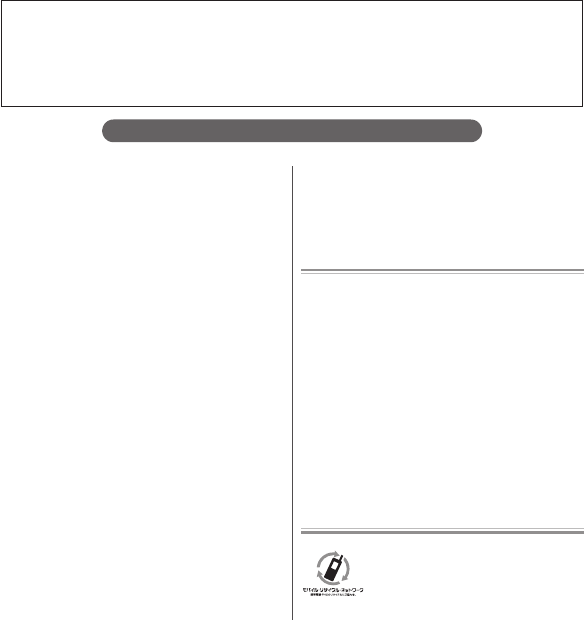
Don't forget your mobile phone ... or your manners!
Remember to be courteous to others when you use your terminal.
Turn the power off when you are:
■
In places where use is prohibited
Follow the instructions of each airline or medical
facility for the use of mobile phones on their
premises. Power off the terminal in a place where
the use is prohibited.
Always set to public mode in case below
■
Driving
Use of the terminal holding with your hand while
driving will result in a penalty.
However, absolutely necessary cases such as
rescue of a sick person or maintaining public's
safety are exempted.
■
In places such as theaters, cinemas, and art
galleries
Using the terminal in a public place, where you
need to be quiet, annoys people around you.
Keep your voice and ring tone down
■
Keep your voice down in quiet places like
restaurants and hotel lobbies.
■
If you are in an outdoor public place, make sure
you do not disturb others.
Respect privacy
■
Please be considerate of the privacy of individuals
around you when taking and sending photos
using camera-equipped terminals.
Do not use smartphone while walking
■
Use of smartphone while walking on station
platform or road makes your eyesight extremely
narrow. It may cause accident.
■
Stop and stay in a safe place and then use
smartphone.
Have good manners
【
Silent mode
】
(P.46
)
Mutes the terminal ringtone or operation sounds.
* Shutter sound cannot be muted.
【
Public mode (power OFF)
】
(P.98)
Informs the caller that you are required to turn off
the terminal and ends the call automatically.
【
Vibrate
】
(P.172)
Vibrates when there is an incoming call.
【
Answering Machine
】
(P.96)
When you cannot answer a call, the terminal
records a message from the caller.
You can also use optional services such as the
Voice Mail Service (P.97) and Call Forwarding
Service (P.97).
Make various applications, check your subscription, and more online
The terminal:
dメニュー (dmenu) u[My docomo(お客様サポート)
(My docomo (Customer support))]u[ドコモオンライン手続き
(docomo online procedures)]
PC: My docomo (https://www.nttdocomo.co.jp/mydocomo/ ) u Select the item in "
ドコモオンライン手続き
(docomo
online procedures)" (in Japanese only)
* There are cases where the site may not be available due to system maintenance, etc.
*
When using "ドコモオンライン手続き (docomo online procedures)", "Network security code" and "ID/password of d ACCOUNT" are required.
We collect old phones, etc. regardless of brands and
manufacturers. Bring them to your nearest docomo Shop.
* Items to be collected: mobile phones, PHS, battery packs,
chargers, desktop holders (regardless of brands and
manufacturers)
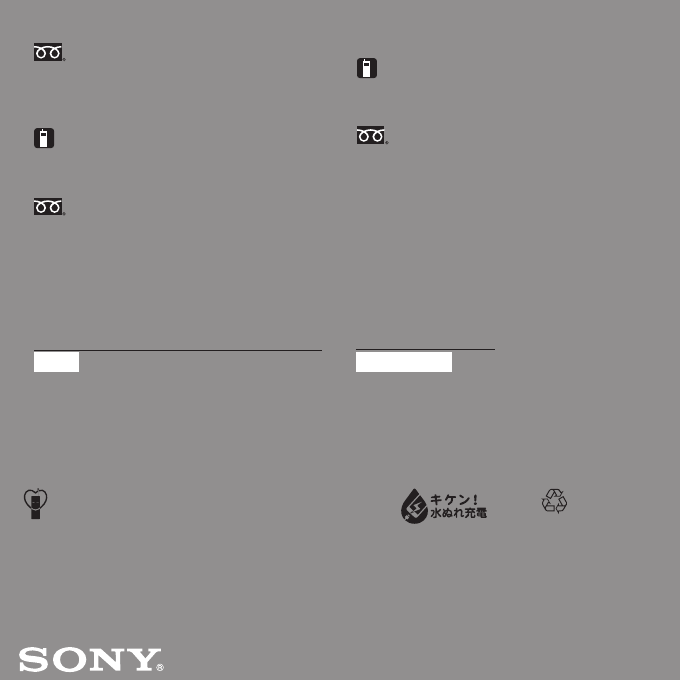
Sales: NTT DOCOMO, INC.
Manufacturer: Sony Mobile Communications, Inc.
’17.4 (1st Edition) 1308-7707.1
General Inquiries
<docomo Information Center>
0120-005-250 (toll free)
*Service available in: English, Portuguese, Chinese, Spanish.
*Unavailable from part of IP phones.
(Business hours: 9:00 a.m. to 8:00 p.m.)
■From DOCOMO mobile phones (In Japanese only)
(No prefix) 151 (toll free)
*Unavailable from land-line phones, etc.
■From land-line phones (In Japanese only)
0120-800-000 (toll free)
*Unavailable from part of IP phones.
(Business hours: 9:00 a.m. to 8:00 p.m. (open all year round))
●Please confirm the phone number before you dial.
●For Applications or Repairs and After-Sales Service, please contact the above-mentioned information center or the docomo
Shop etc. near you on the NTT DOCOMO website.
NTT DOCOMO website https://www.nttdocomo.co.jp/english/
Inquiries while overseas (For loss, theft, phone malfunctions, etc.)
Display "+"
-81-3-6832-6600
(toll free)
Repairs (Inquiries/Request)
■From DOCOMO mobile phones (In Japanese only)
(No prefix) 113 (toll free)
*Unavailable from land-line phones, etc.
■From land-line phones (In Japanese only)
0120-800-000 (toll free)
*Unavailable from part of IP phones.
(Business hours: 24 hours (open all year round))
From land-line phones
International call access
number of your country of stay
-81-3-6832-6600
(charges apply)
*Voice communication charges to Japan apply.
*For international call access number, refer to DOCOMO website.
●Please confirm the phone number before you dial.
●If you lose your terminal or have it stolen, immediately take the steps necessary for suspending the use of the terminal.
●
If the terminal you purchased is damaged, bring your terminal to a repair counter specified by DOCOMO after returning to Japan.
From DOCOMO mobile phones
(In Japanese only)
*You can also call using the international call access number instead
of using "+".
(Business hours: 24 hours (open all year round)) (Business hours: 24 hours (open all year round))
(Touch and hold “0” to enter "+".)
Don’t forget your mobile phone...or your manners!
٧When using your mobile phone in a public place, don’t forget to
show common courtesy and consideration for others around you. Li-ion 00